This document is the first chapter of a physics textbook on electric charges and fields. It introduces the topic of electrostatics and discusses how objects can acquire electric charges through rubbing. It describes early experiments showing that there are two types of charges (positive and negative) which attract if opposite but repel if like. Conductors and insulators are introduced, with conductors able to distribute charge easily over their surface. The chapter establishes the basics of electric charge and sets up further discussion of electric fields and forces.
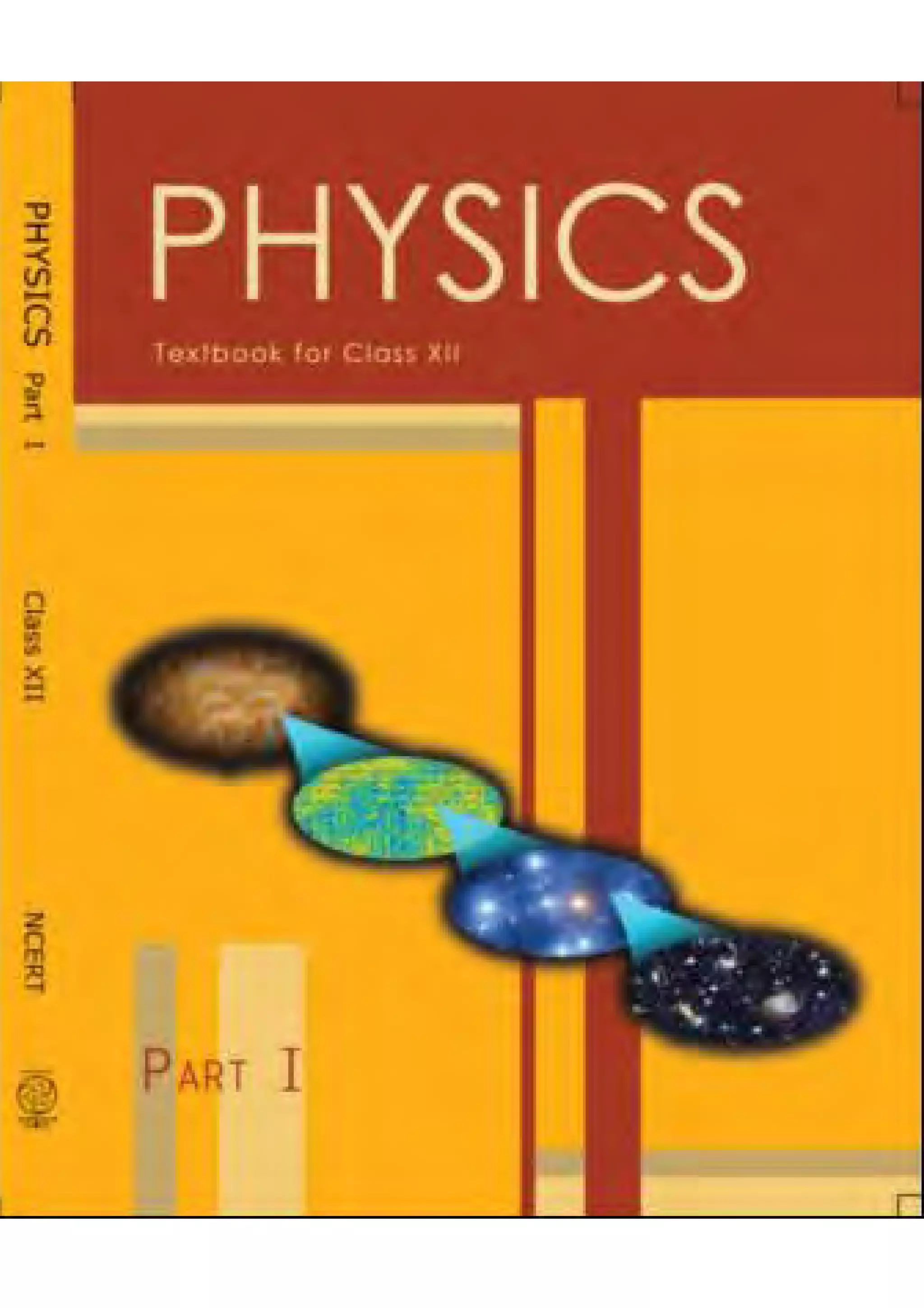
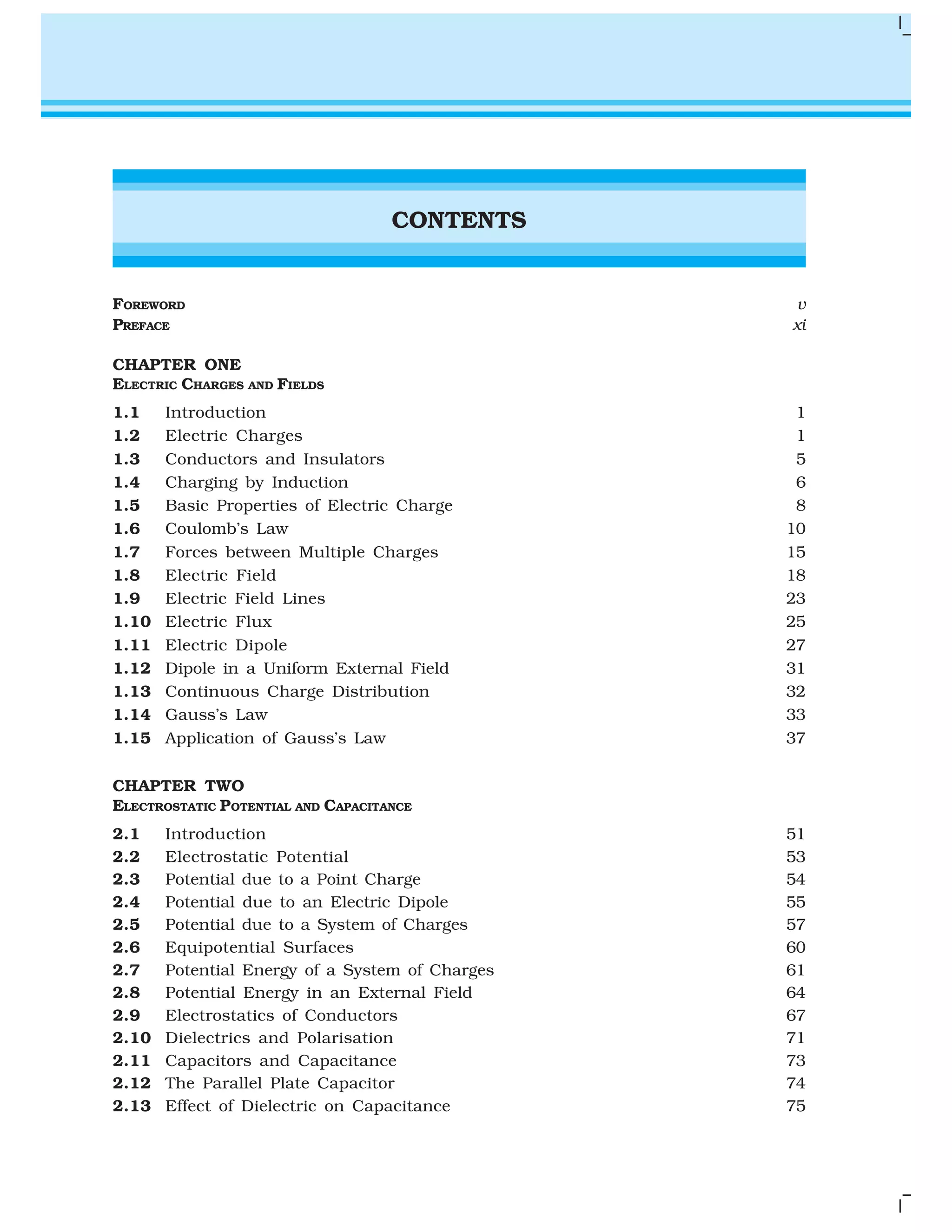

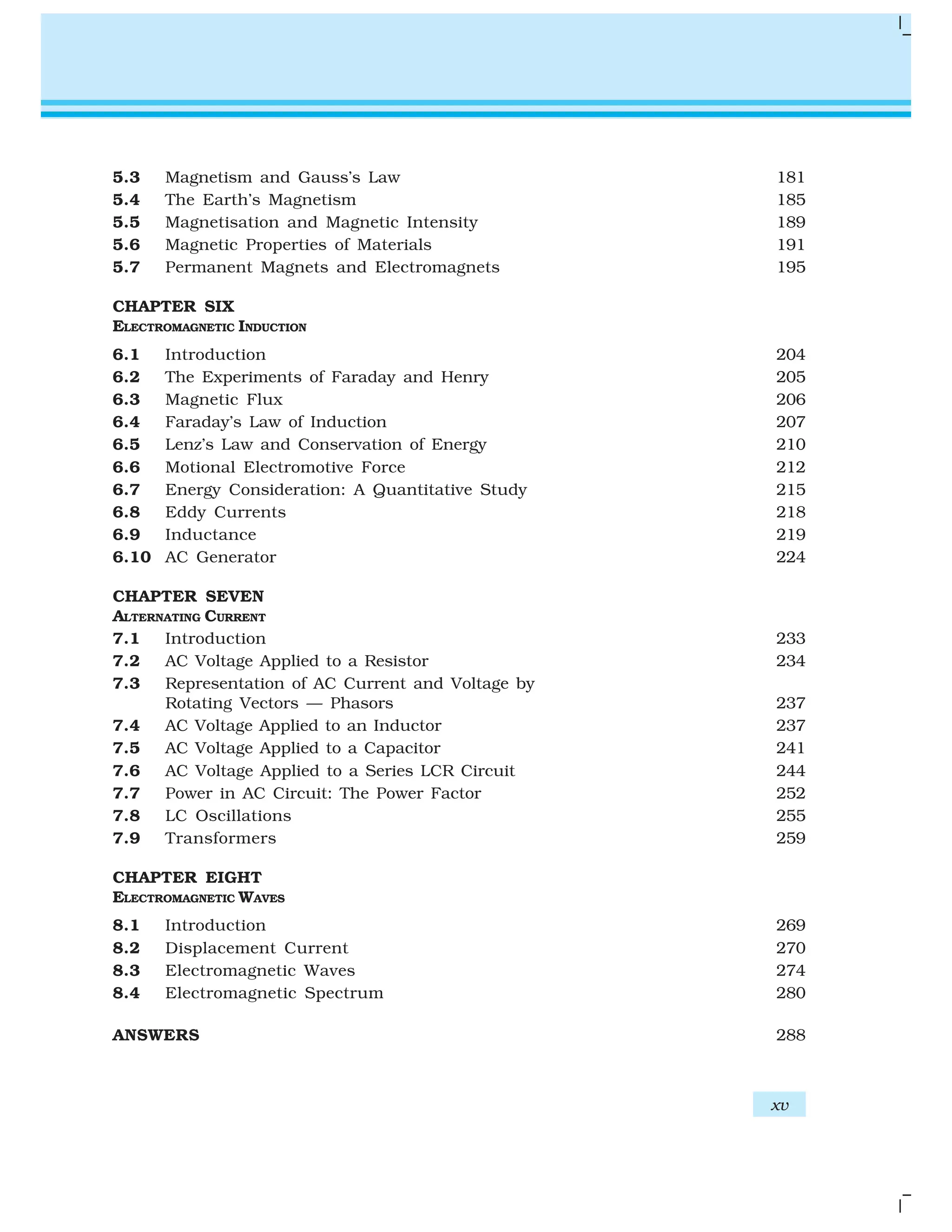

![2
Physics
on rubbing could attract light objects
like straw, pith balls and bits of papers.
You can perform the following activity
at home to experience such an effect.
Cut out long thin strips of white paper
and lightly iron them. Take them near a
TV screen or computer monitor. You will
see that the strips get attracted to the
screen. In fact they remain stuck to the
screen for a while.
It was observed that if two glass rods
rubbed with wool or silk cloth are
brought close to each other, they repel
each other [Fig. 1.1(a)]. The two strands
of wool or two pieces of silk cloth, with
which the rods were rubbed, also repel
each other. However, the glass rod and
wool attracted each other. Similarly, two plastic rods rubbed with cat’s
fur repelled each other [Fig. 1.1(b)] but attracted the fur. On the other
hand, the plastic rod attracts the glass rod [Fig. 1.1(c)] and repel the silk
or wool with which the glass rod is rubbed. The glass rod repels the fur.
If a plastic rod rubbed with fur is made to touch two small pith balls
(now-a-days we can use polystyrene balls) suspended by silk or nylon
thread, then the balls repel each other [Fig. 1.1(d)] and are also repelled
by the rod. A similar effect is found if the pith balls are touched with a
glass rod rubbed with silk [Fig. 1.1(e)]. A dramatic observation is that a
pith ball touched with glass rod attracts another pith ball touched with
plastic rod [Fig. 1.1(f )].
These seemingly simple facts were established from years of efforts
and careful experiments and their analyses. It was concluded, after many
careful studies by different scientists, that there were only two kinds of
an entity which is called the electric charge. We say that the bodies like
glass or plastic rods, silk, fur and pith balls are electrified. They acquire
an electric charge on rubbing. The experiments on pith balls suggested
that there are two kinds of electrification and we find that (i) like charges
repel and (ii) unlike charges attract each other. The experiments also
demonstrated that the charges are transferred from the rods to the pith
balls on contact. It is said that the pith balls are electrified or are charged
by contact. The property which differentiates the two kinds of charges is
called the polarity of charge.
When a glass rod is rubbed with silk, the rod acquires one kind of
charge and the silk acquires the second kind of charge. This is true for
any pair of objects that are rubbed to be electrified. Now if the electrified
glass rod is brought in contact with silk, with which it was rubbed, they
no longer attract each other. They also do not attract or repel other light
objects as they did on being electrified.
Thus, the charges acquired after rubbing are lost when the charged
bodies are brought in contact. What can you conclude from these
observations? It just tells us that unlike charges acquired by the objects
FIGURE 1.1 Rods and pith balls: like charges repel and
unlike charges attract each other.
Interactiveanimationonsimpleelectrostaticexperiments:
http://ephysics.physics.ucla.edu/travoltage/HTML/](https://image.slidesharecdn.com/ncert-class-12-physics-part-1-161112171109/75/Ncert-class-12-physics-part-1-6-2048.jpg)
![Electric Charges
and Fields
3
neutralise or nullify each other’s effect. Therefore the charges were named
as positive and negative by the American scientist Benjamin Franklin.
We know that when we add a positive number to a negative number of
the same magnitude, the sum is zero. This might have been the
philosophy in naming the charges as positive and negative. By convention,
the charge on glass rod or cat’s fur is called positive and that on plastic
rod or silk is termed negative. If an object possesses an electric charge, it
is said to be electrified or charged. When it has no charge it is said to be
neutral.
UNIFICATION OF ELECTRICITY AND MAGNETISM
In olden days, electricity and magnetism were treated as separate subjects. Electricity
dealt with charges on glass rods, cat’s fur, batteries, lightning, etc., while magnetism
described interactions of magnets, iron filings, compass needles, etc. In 1820 Danish
scientist Oersted found that a compass needle is deflected by passing an electric current
through a wire placed near the needle. Ampere and Faraday supported this observation
by saying that electric charges in motion produce magnetic fields and moving magnets
generate electricity. The unification was achieved when the Scottish physicist Maxwell
and the Dutch physicist Lorentz put forward a theory where they showed the
interdependence of these two subjects. This field is called electromagnetism. Most of the
phenomena occurring around us can be described under electromagnetism. Virtually
every force that we can think of like friction, chemical force between atoms holding the
matter together, and even the forces describing processes occurring in cells of living
organisms, have its origin in electromagnetic force. Electromagnetic force is one of the
fundamental forces of nature.
Maxwell put forth four equations that play the same role in classical electromagnetism
as Newton’s equations of motion and gravitation law play in mechanics. He also argued
that light is electromagnetic in nature and its speed can be found by making purely
electric and magnetic measurements. He claimed that the science of optics is intimately
related to that of electricity and magnetism.
The science of electricity and magnetism is the foundation for the modern technological
civilisation. Electric power, telecommunication, radio and television, and a wide variety
of the practical appliances used in daily life are based on the principles of this science.
Although charged particles in motion exert both electric and magnetic forces, in the
frame of reference where all the charges are at rest, the forces are purely electrical. You
know that gravitational force is a long-range force. Its effect is felt even when the distance
between the interacting particles is very large because the force decreases inversely as
the square of the distance between the interacting bodies. We will learn in this chapter
that electric force is also as pervasive and is in fact stronger than the gravitational force
by several orders of magnitude (refer to Chapter 1 of Class XI Physics Textbook).
A simple apparatus to detect charge on a body is the gold-leaf
electroscope [Fig. 1.2(a)]. It consists of a vertical metal rod housed in a
box, with two thin gold leaves attached to its bottom end. When a charged
object touches the metal knob at the top of the rod, charge flows on to
the leaves and they diverge. The degree of divergance is an indicator of
the amount of charge.](https://image.slidesharecdn.com/ncert-class-12-physics-part-1-161112171109/75/Ncert-class-12-physics-part-1-7-2048.jpg)
![4
Physics
Students can make a simple electroscope as
follows [Fig. 1.2(b)]: Take a thin aluminium curtain
rod with ball ends fitted for hanging the curtain. Cut
out a piece of length about 20 cm with the ball at
one end and flatten the cut end. Take a large bottle
that can hold this rod and a cork which will fit in the
opening of the bottle. Make a hole in the cork
sufficient to hold the curtain rod snugly. Slide the
rod through the hole in the cork with the cut end on
the lower side and ball end projecting above the cork.
Fold a small, thin aluminium foil (about 6 cm in
length) in the middle and attach it to the flattened
end of the rod by cellulose tape. This forms the leaves
of your electroscope. Fit the cork in the bottle with
about 5 cm of the ball end projecting above the cork.
A paper scale may be put inside the bottle in advance
to measure the separation of leaves. The separation
is a rough measure of the amount of charge on the
electroscope.
To understand how the electroscope works, use
the white paper strips we used for seeing the
attraction of charged bodies. Fold the strips into half
so that you make a mark of fold. Open the strip and
iron it lightly with the mountain fold up, as shown
in Fig. 1.3. Hold the strip by pinching it at the fold.
You would notice that the two halves move apart.
This shows that the strip has acquired charge on ironing. When you fold
it into half, both the halves have the same charge. Hence they repel each
other. The same effect is seen in the leaf electroscope. On charging the
curtain rod by touching the ball end with an electrified body, charge is
transferred to the curtain rod and the attached aluminium foil. Both the
halves of the foil get similar charge and therefore repel each other. The
divergence in the leaves depends on the amount of charge on them. Let
us first try to understand why material bodies acquire charge.
You know that all matter is made up of atoms and/or molecules.
Although normally the materials are electrically neutral, they do contain
charges; but their charges are exactly balanced. Forces that hold the
molecules together, forces that hold atoms together in a solid, the adhesive
force of glue, forces associated with surface tension, all are basically
electrical in nature, arising from the forces between charged particles.
Thus the electric force is all pervasive and it encompasses almost each
and every field associated with our life. It is therefore essential that we
learn more about such a force.
To electrify a neutral body, we need to add or remove one kind of
charge. When we say that a body is charged, we always refer to this
excess charge or deficit of charge. In solids, some of the electrons, being
less tightly bound in the atom, are the charges which are transferred
from one body to the other. A body can thus be charged positively by
losing some of its electrons. Similarly, a body can be charged negatively
FIGURE 1.2 Electroscopes: (a) The gold leaf
electroscope, (b) Schematics of a simple
electroscope.
FIGURE 1.3 Paper strip
experiment.](https://image.slidesharecdn.com/ncert-class-12-physics-part-1-161112171109/75/Ncert-class-12-physics-part-1-8-2048.jpg)
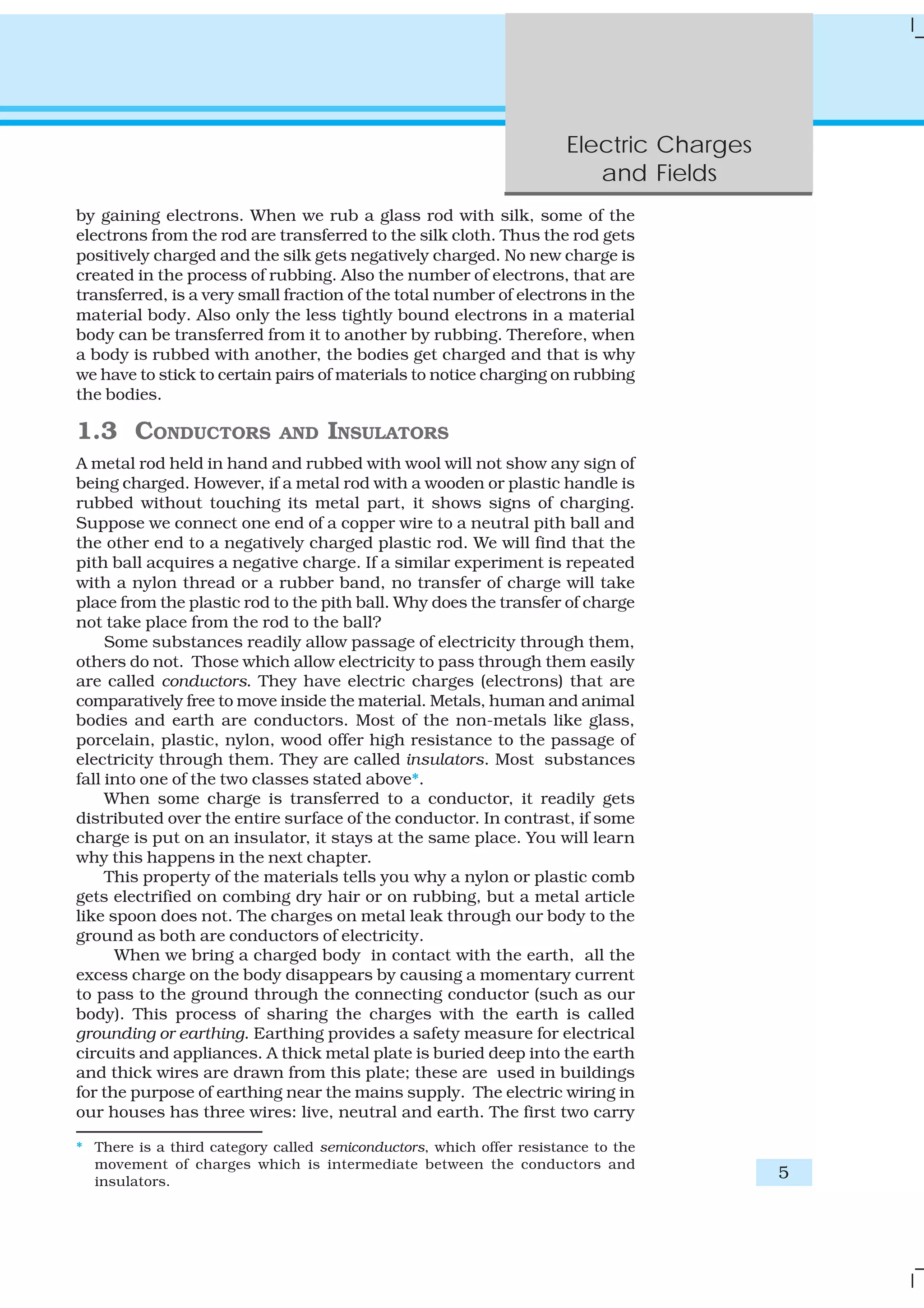
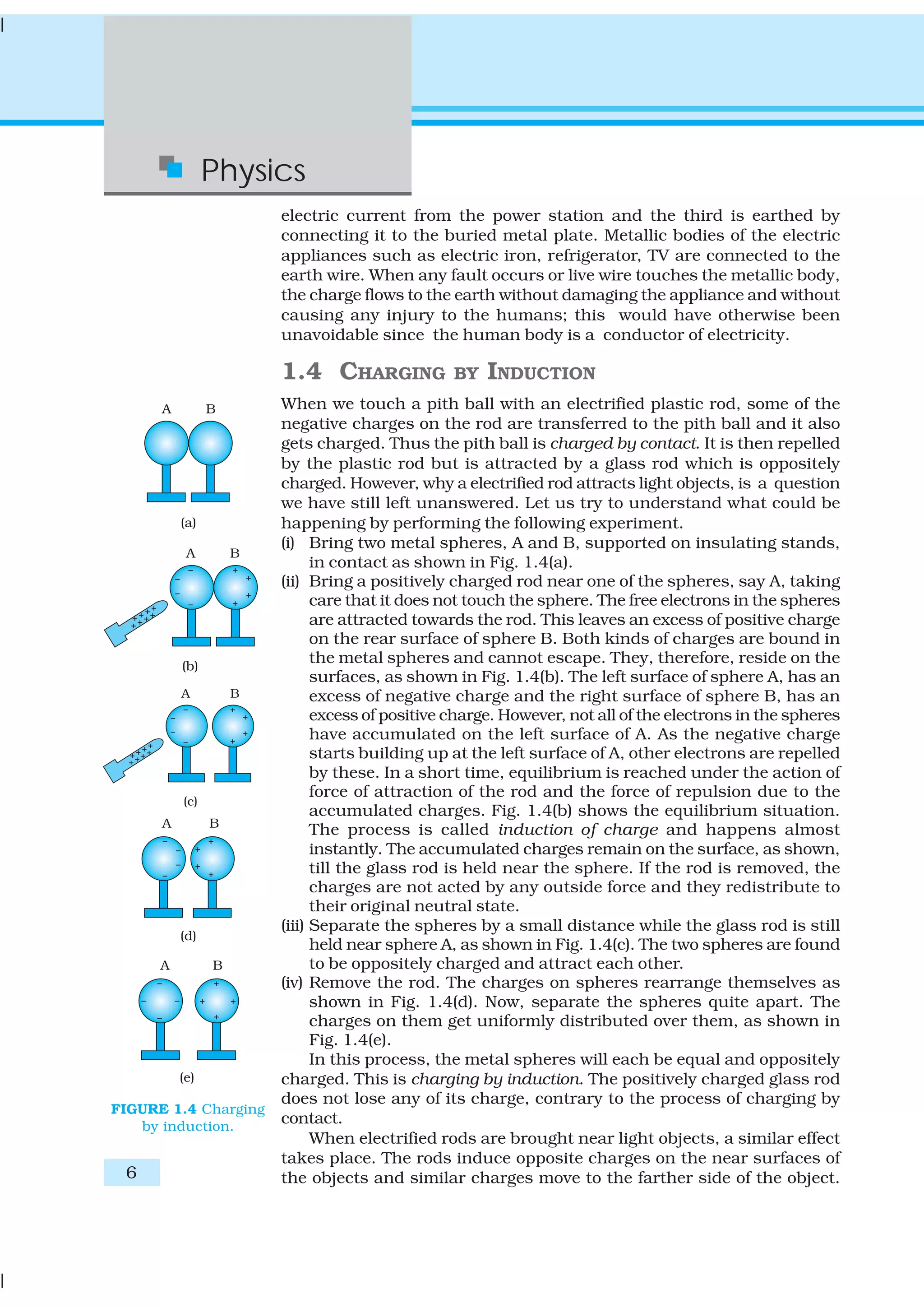
![Electric Charges
and Fields
7
EXAMPLE1.1
[This happens even when the light object is not a conductor. The
mechanism for how this happens is explained later in Sections 1.10 and
2.10.] The centres of the two types of charges are slightly separated. We
know that opposite charges attract while similar charges repel. However,
the magnitude of force depends on the distance between the charges
and in this case the force of attraction overweighs the force of repulsion.
As a result the particles like bits of paper or pith balls, being light, are
pulled towards the rods.
Example 1.1 How can you charge a metal sphere positively without
touching it?
Solution Figure 1.5(a) shows an uncharged metallic sphere on an
insulating metal stand. Bring a negatively charged rod close to the
metallic sphere, as shown in Fig. 1.5(b). As the rod is brought close
to the sphere, the free electrons in the sphere move away due to
repulsion and start piling up at the farther end. The near end becomes
positively charged due to deficit of electrons. This process of charge
distribution stops when the net force on the free electrons inside the
metal is zero. Connect the sphere to the ground by a conducting
wire. The electrons will flow to the ground while the positive charges
at the near end will remain held there due to the attractive force of
the negative charges on the rod, as shown in Fig. 1.5(c). Disconnect
the sphere from the ground. The positive charge continues to be
held at the near end [Fig. 1.5(d)]. Remove the electrified rod. The
positive charge will spread uniformly over the sphere as shown in
Fig. 1.5(e).
FIGURE 1.5
In this experiment, the metal sphere gets charged by the process
of induction and the rod does not lose any of its charge.
Similar steps are involved in charging a metal sphere negatively
by induction, by bringing a positively charged rod near it. In this
case the electrons will flow from the ground to the sphere when the
sphere is connected to the ground with a wire. Can you explain why?
Interactiveanimationonchargingatwo-spheresystembyinduction:
http://www.physicsclassroom.com/mmedia/estatics/estaticTOC.html](https://image.slidesharecdn.com/ncert-class-12-physics-part-1-161112171109/75/Ncert-class-12-physics-part-1-11-2048.jpg)
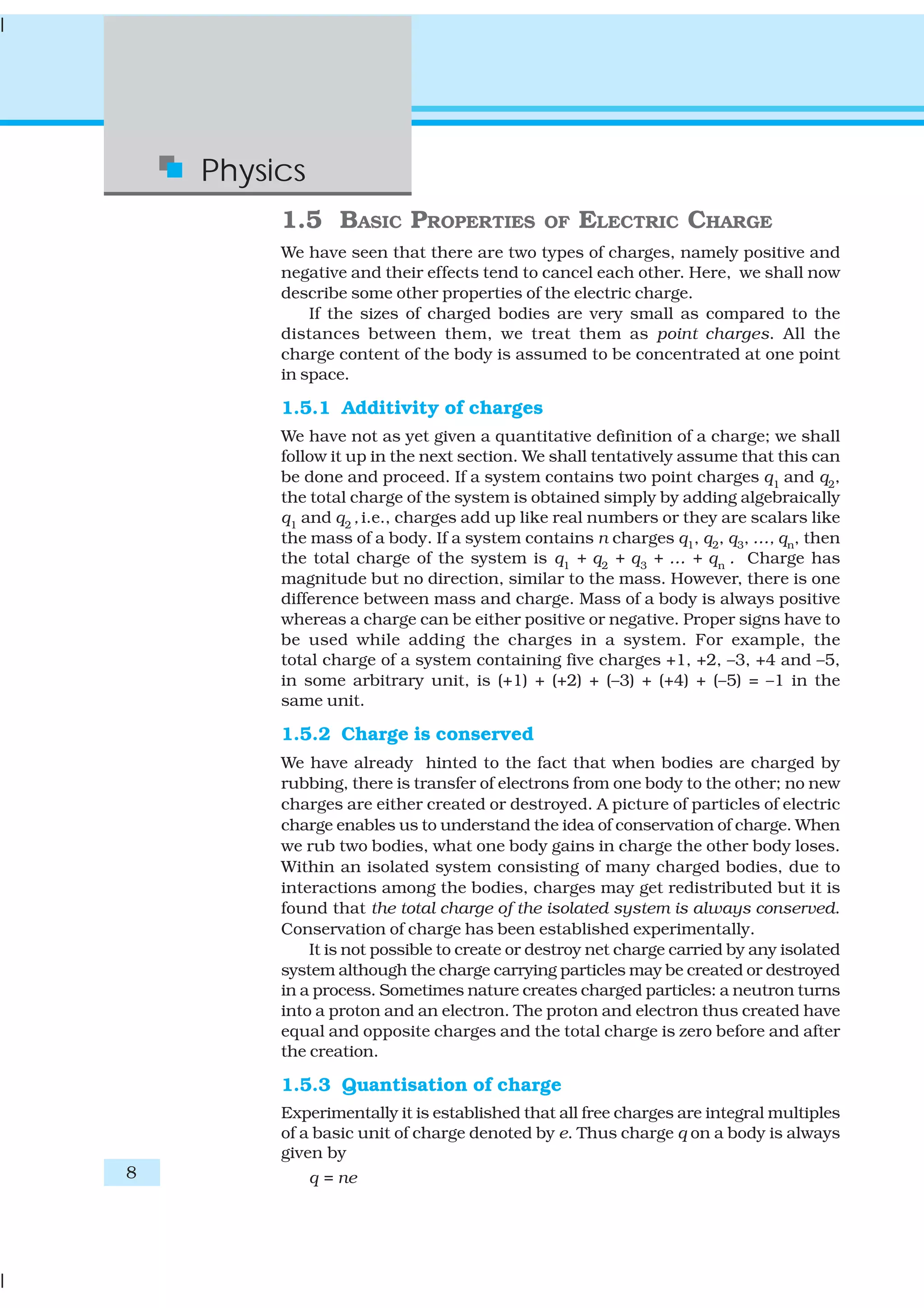

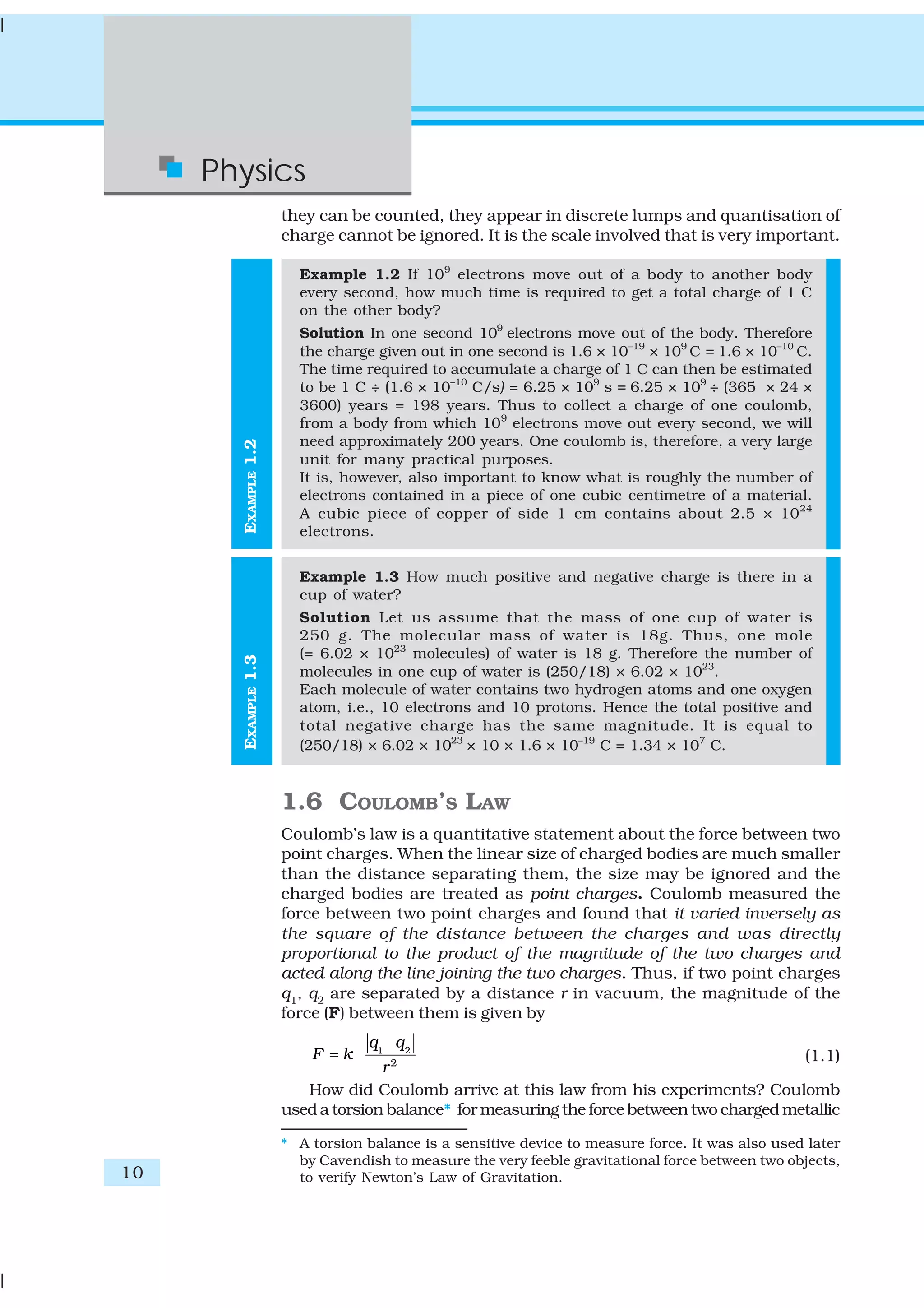
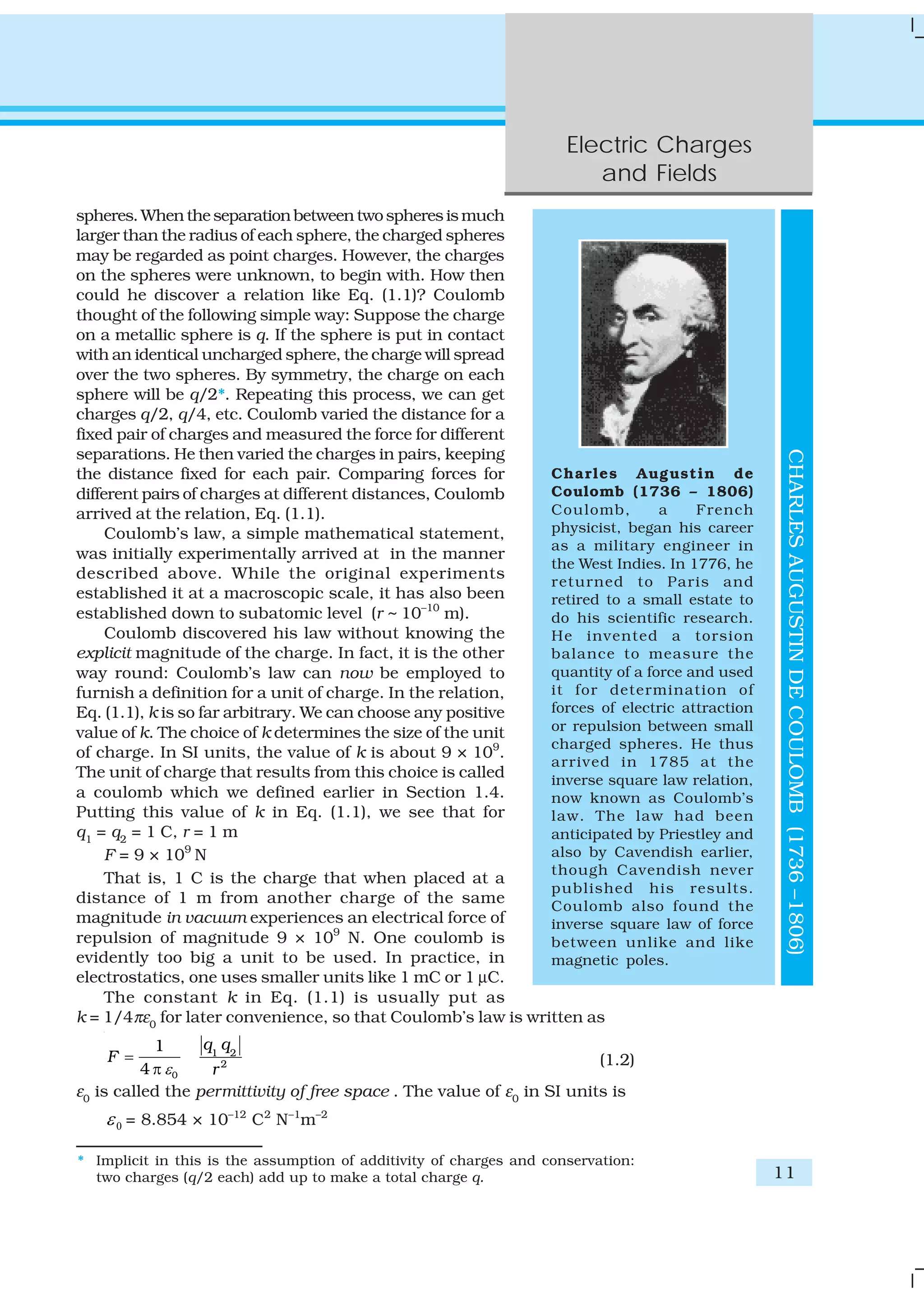
![12
Physics
Since force is a vector, it is better to write
Coulomb’s law in the vector notation. Let the
position vectors of charges q1
and q2
be r1
and r2
respectively [see Fig.1.6(a)]. We denote force on
q1
due to q2
by F12
and force on q2
due to q1
by
F21
. The two point charges q1
and q2
have been
numbered 1 and 2 for convenience and the vector
leading from 1 to 2 is denoted by r21
:
r21
= r2
– r1
In the same way, the vector leading from 2 to
1 is denoted by r12
:
r12
= r1
– r2
= – r21
The magnitude of the vectors r21
and r12
is
denoted by r21
and r12
, respectively (r12
= r21
). The
direction of a vector is specified by a unit vector
along the vector. To denote the direction from 1
to 2 (or from 2 to 1), we define the unit vectors:
21
21
21
ˆ
r
=
r
r ,
12
12 21 12
12
ˆ ˆ ˆ,
r
= =
r
r r r
Coulomb’s force law between two point charges q1 and q2 located at
r1 and r2 is then expressed as
1 2
21 212
21
1
ˆ
4 o
q q
rε
=
π
F r (1.3)
Some remarks on Eq. (1.3) are relevant:
• Equation (1.3) is valid for any sign of q1
and q2
whether positive or
negative. If q1 and q2 are of the same sign (either both positive or both
negative), F21
is along ˆr 21
, which denotes repulsion, as it should be for
like charges. If q1
and q2
are of opposite signs, F21
is along – ˆr 21
(= ˆr 12
),
which denotes attraction, as expected for unlike charges. Thus, we do
not have to write separate equations for the cases of like and unlike
charges. Equation (1.3) takes care of both cases correctly [Fig. 1.6(b)].
• The force F12 on charge q1 due to charge q2, is obtained from Eq. (1.3),
by simply interchanging 1 and 2, i.e.,
1 2
12 12 212
0 12
1
ˆ
4
q q
rε
= = −
π
F r F
Thus, Coulomb’s law agrees with the Newton’s third law.
• Coulomb’s law [Eq. (1.3)] gives the force between two charges q1
and
q2 in vacuum. If the charges are placed in matter or the intervening
space has matter, the situation gets complicated due to the presence
of charged constituents of matter. We shall consider electrostatics in
matter in the next chapter.
FIGURE 1.6 (a) Geometry and
(b) Forces between charges.](https://image.slidesharecdn.com/ncert-class-12-physics-part-1-161112171109/75/Ncert-class-12-physics-part-1-16-2048.jpg)
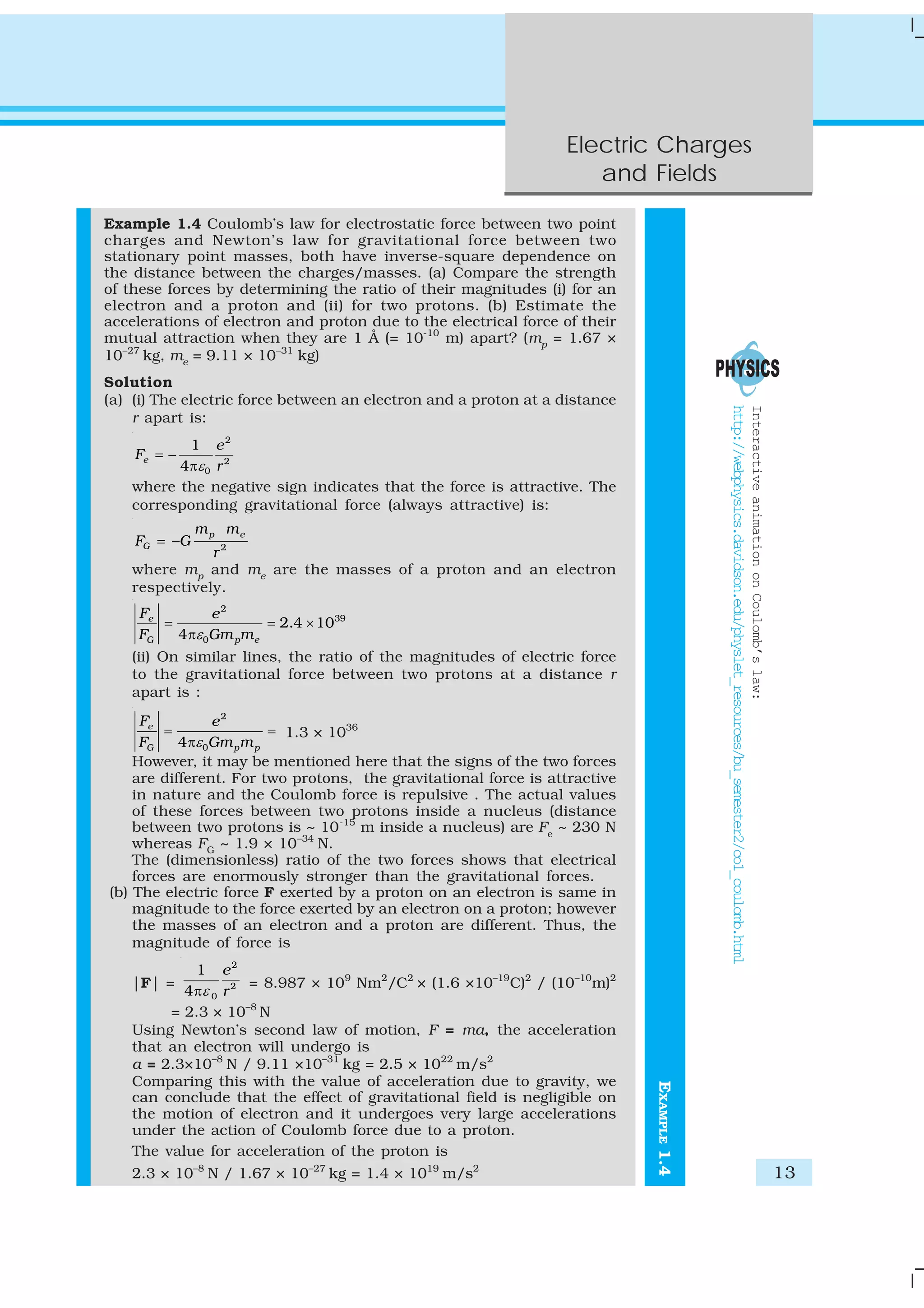
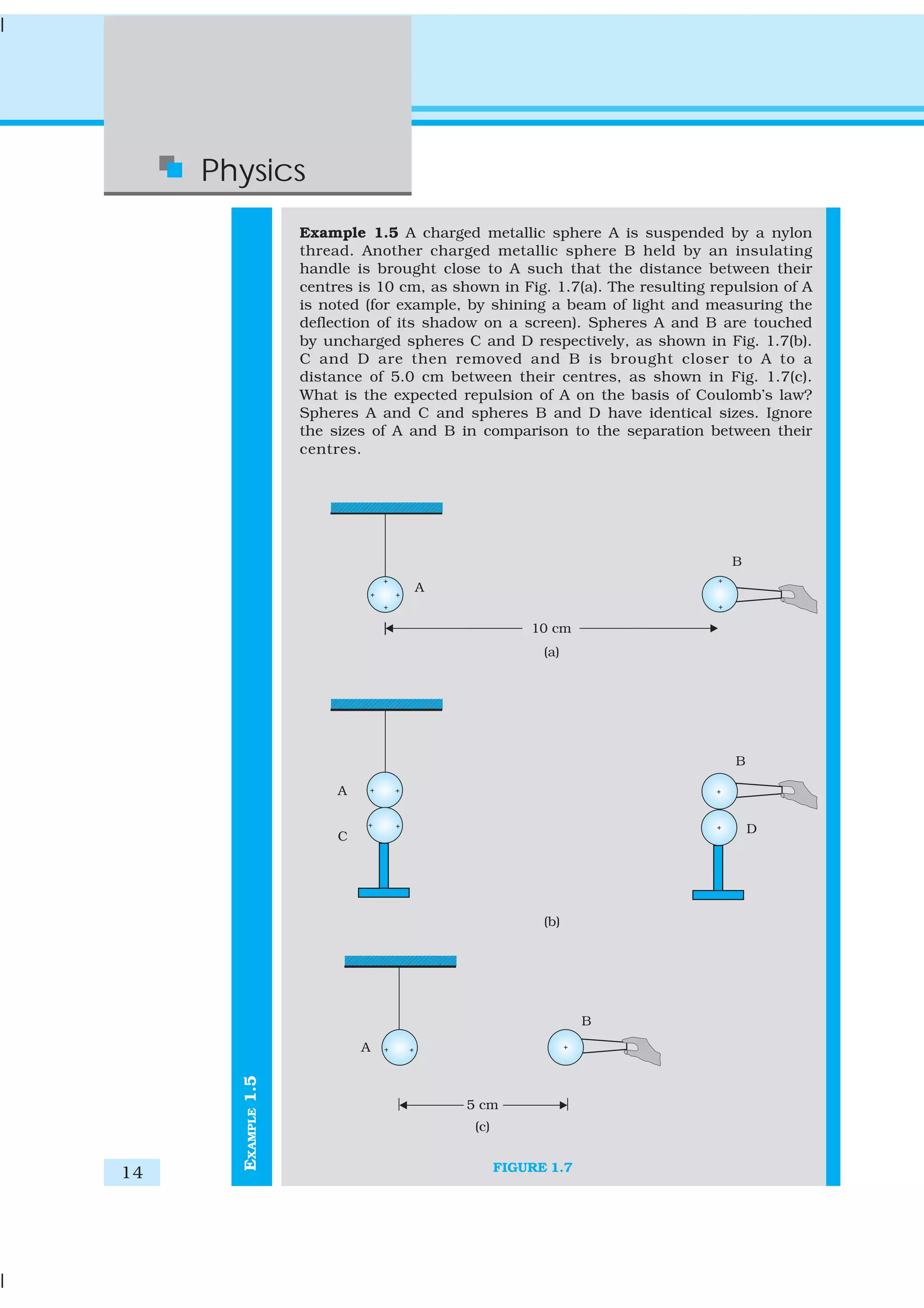
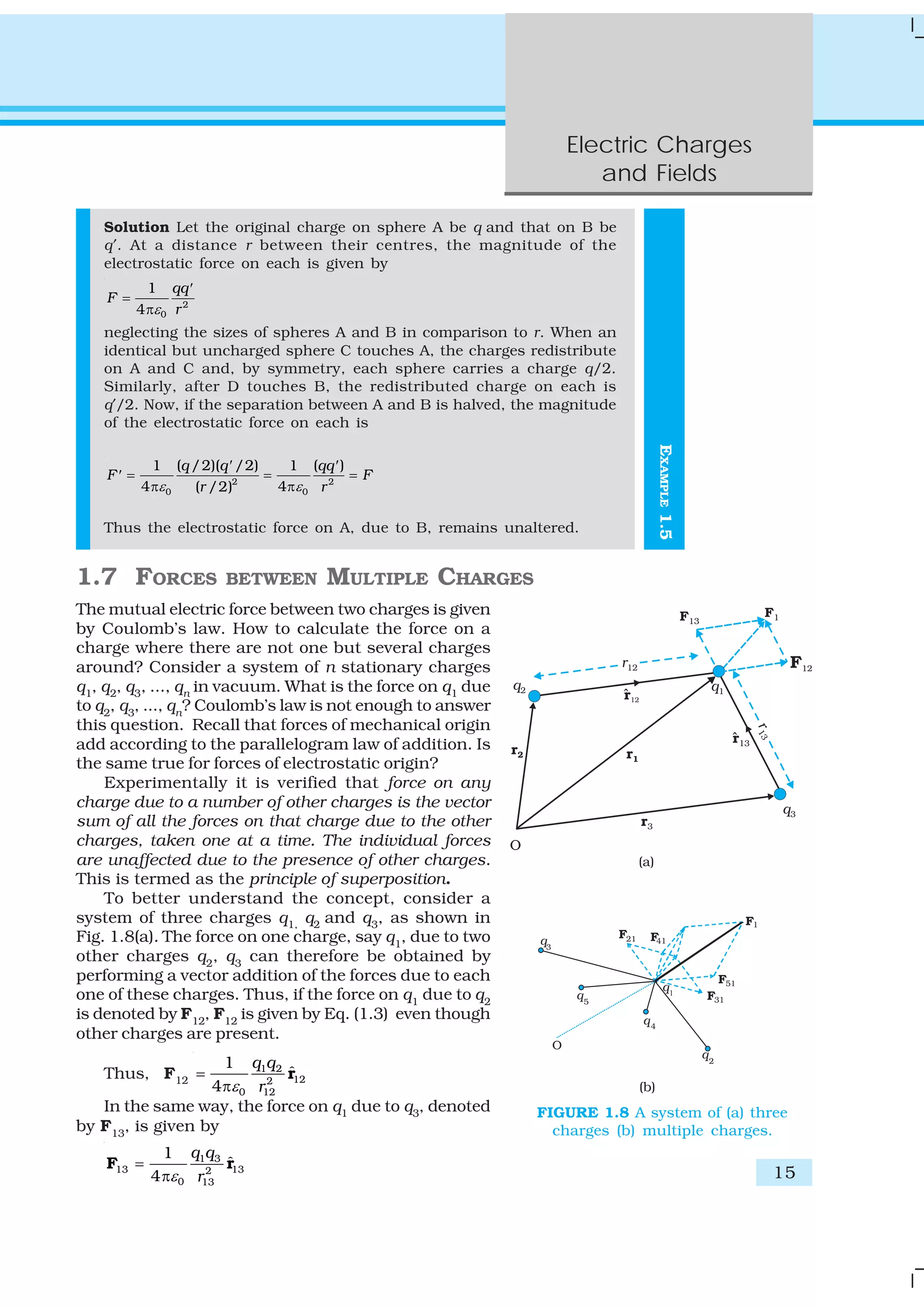
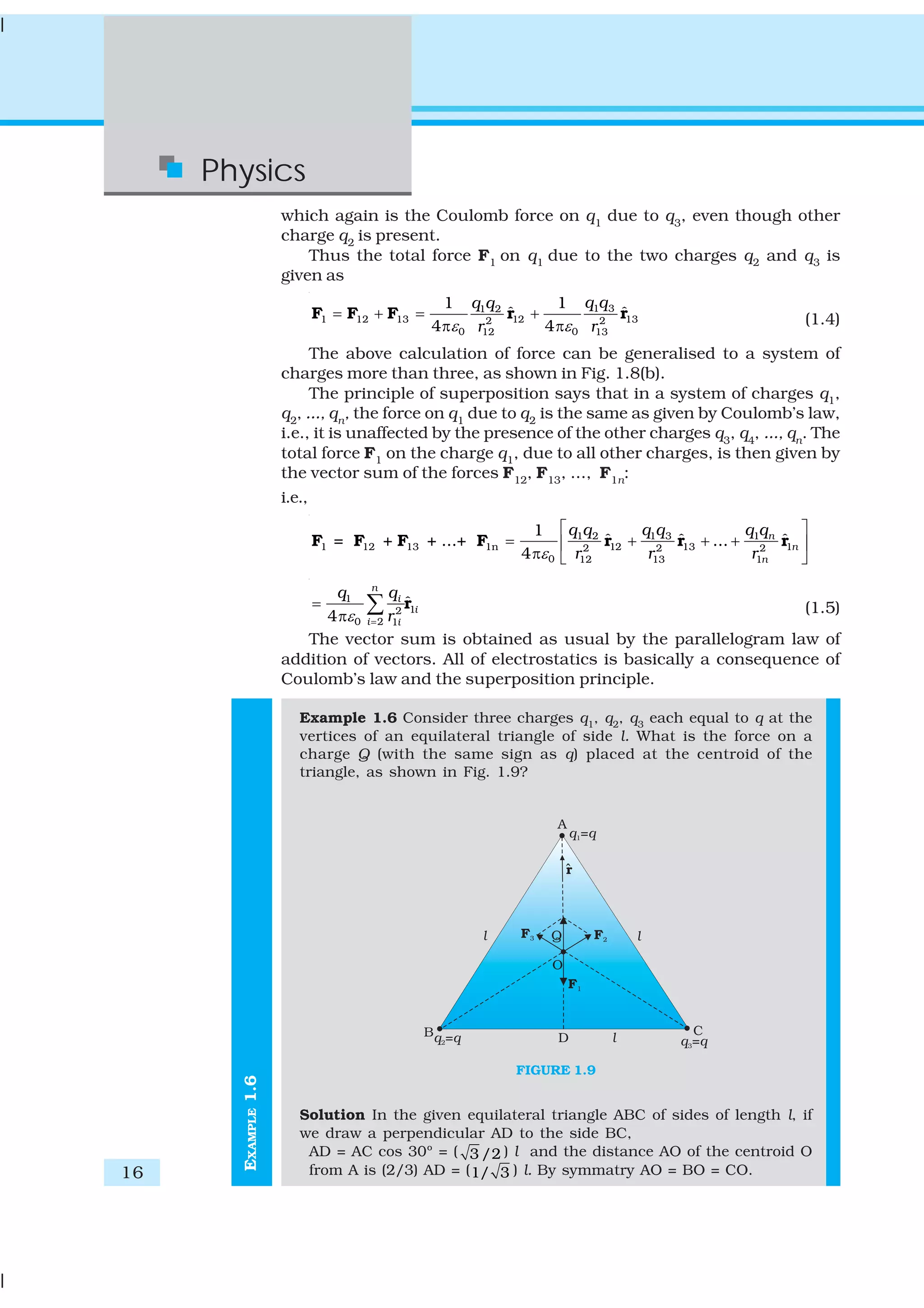

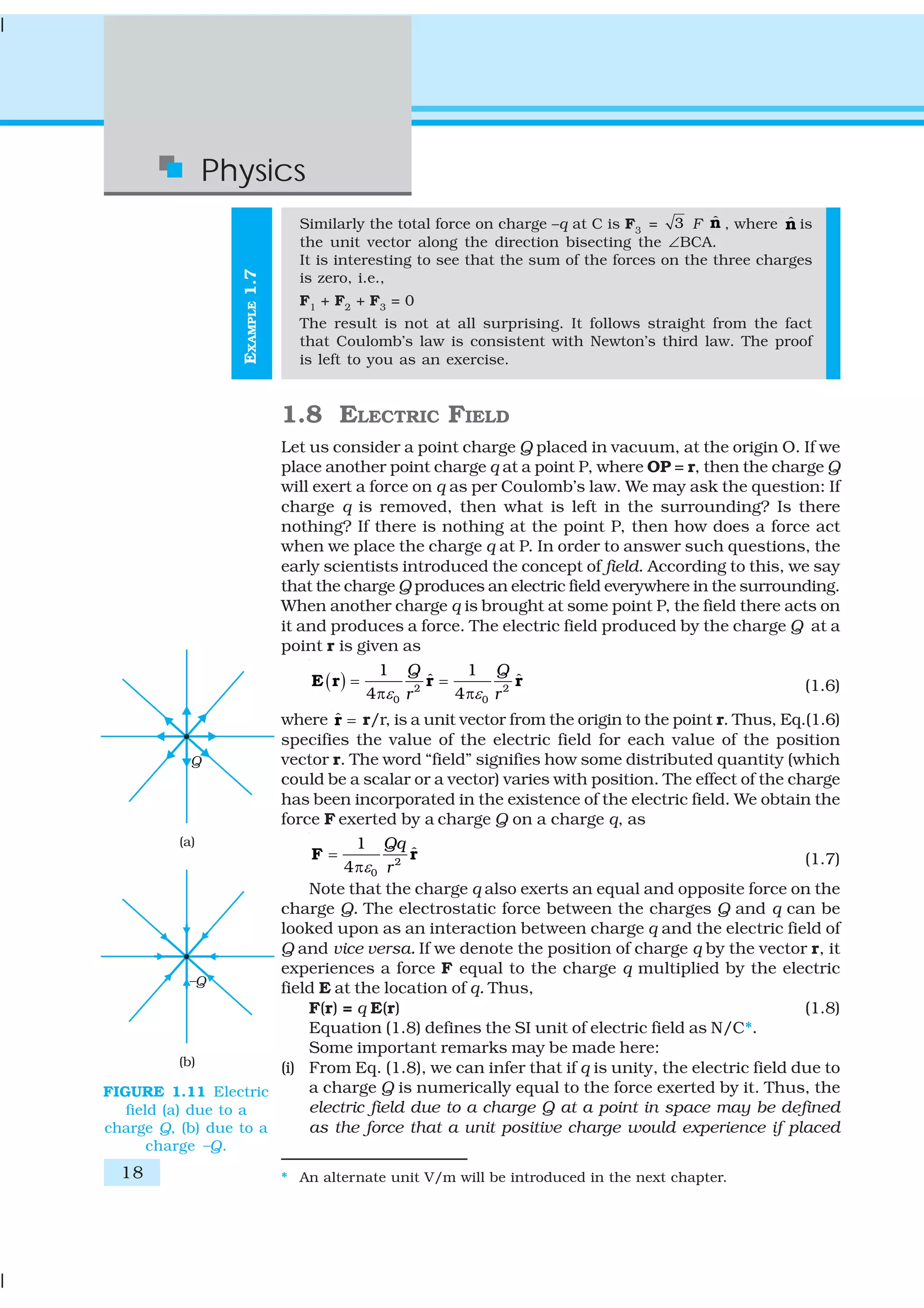
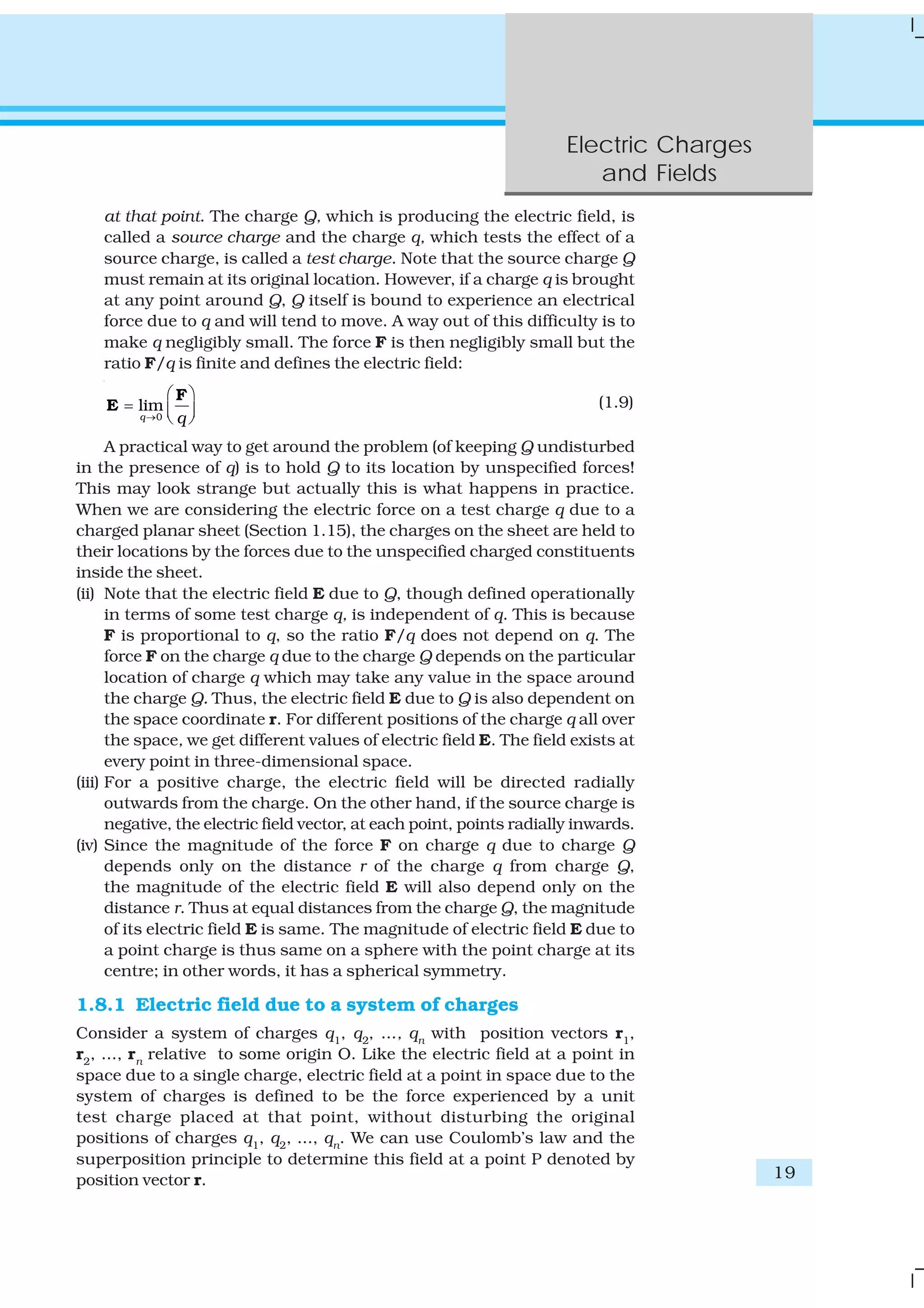
![20
Physics
Electric field E1
at r due to q1
at r1
is given by
E1
= 1
1P2
0 1P
1
ˆ
4
q
rπε
r
where 1P
ˆr is a unit vector in the direction from q1 to P,
and r1P
is the distance between q1
and P.
In the same manner, electric field E2 at r due to q2 at
r2 is
E2
=
2
2P2
0 2P
1
ˆ
4
q
rπε
r
where 2P
ˆr is a unit vector in the direction from q2 to P
and r2P
is the distance between q2
and P. Similar
expressions hold good for fields E3
, E4
, ..., En
due to
charges q3, q4, ..., qn.
By the superposition principle, the electric field E at r
due to the system of charges is (as shown in Fig. 1.12)
E(r) = E1 (r) + E2 (r) + … + En(r)
= 1 2
1P 2P P2 2 2
0 0 01P 2P P
1 1 1
ˆ ˆ ˆ...
4 4 4
n
n
n
qq q
r r rε ε ε
+ + +
π π π
r r r
E(r) i P2
10 P
1
ˆ
4
n
i
i i
q
rε =
=
π
∑ r (1.10)
E is a vector quantity that varies from one point to another point in space
and is determined from the positions of the source charges.
1.8.2 Physical significance of electric field
You may wonder why the notion of electric field has been introduced
here at all. After all, for any system of charges, the measurable quantity
is the force on a charge which can be directly determined using Coulomb’s
law and the superposition principle [Eq. (1.5)]. Why then introduce this
intermediate quantity called the electric field?
For electrostatics, the concept of electric field is convenient, but not
really necessary. Electric field is an elegant way of characterising the
electrical environment of a system of charges. Electric field at a point in
the space around a system of charges tells you the force a unit positive
test charge would experience if placed at that point (without disturbing
the system). Electric field is a characteristic of the system of charges and
is independent of the test charge that you place at a point to determine
the field. The term field in physics generally refers to a quantity that is
defined at every point in space and may vary from point to point. Electric
field is a vector field, since force is a vector quantity.
The true physical significance of the concept of electric field, however,
emerges only when we go beyond electrostatics and deal with time-
dependent electromagnetic phenomena. Suppose we consider the force
between two distant charges q1, q2 in accelerated motion. Now the greatest
speed with which a signal or information can go from one point to another
is c, the speed of light. Thus, the effect of any motion of q1
on q2
cannot
FIGURE 1.12 Electric field at a
point due to a system of charges is
the vector sum of the electric fields
at the point due to individual
charges.](https://image.slidesharecdn.com/ncert-class-12-physics-part-1-161112171109/75/Ncert-class-12-physics-part-1-24-2048.jpg)
![Electric Charges
and Fields
21
arise instantaneously. There will be some time delay between the effect
(force on q2
) and the cause (motion of q1
). It is precisely here that the
notion of electric field (strictly, electromagnetic field) is natural and very
useful. The field picture is this: the accelerated motion of charge q1
produces electromagnetic waves, which then propagate with the speed
c, reach q2 and cause a force on q2. The notion of field elegantly accounts
for the time delay. Thus, even though electric and magnetic fields can be
detected only by their effects (forces) on charges, they are regarded as
physical entities, not merely mathematical constructs. They have an
independent dynamics of their own, i.e., they evolve according to laws
of their own. They can also transport energy. Thus, a source of time-
dependent electromagnetic fields, turned on briefly and switched off, leaves
behind propagating electromagnetic fields transporting energy. The
concept of field was first introduced by Faraday and is now among the
central concepts in physics.
Example 1.8 An electron falls through a distance of 1.5 cm in a
uniform electric field of magnitude 2.0 × 104
N C–1
[Fig. 1.13(a)]. The
direction of the field is reversed keeping its magnitude unchanged
and a proton falls through the same distance [Fig. 1.13(b)]. Compute
the time of fall in each case. Contrast the situation with that of ‘free
fall under gravity’.
FIGURE 1.13
Solution In Fig. 1.13(a) the field is upward, so the negatively charged
electron experiences a downward force of magnitude eE where E is
the magnitude of the electric field. The acceleration of the electron is
ae
= eE/me
where me
is the mass of the electron.
Starting from rest, the time required by the electron to fall through a
distance h is given by
22
e
e
e
h mh
t
a e E
= =
For e = 1.6 × 10–19
C, me
= 9.11 × 10–31
kg,
E = 2.0 × 104
N C–1
, h = 1.5 × 10–2
m,
te
= 2.9 × 10–9
s
In Fig. 1.13 (b), the field is downward, and the positively charged
proton experiences a downward force of magnitude eE. The
acceleration of the proton is
ap
= eE/mp
where mp
is the mass of the proton; mp
= 1.67 × 10–27
kg. The time of
fall for the proton is
EXAMPLE1.8](https://image.slidesharecdn.com/ncert-class-12-physics-part-1-161112171109/75/Ncert-class-12-physics-part-1-25-2048.jpg)
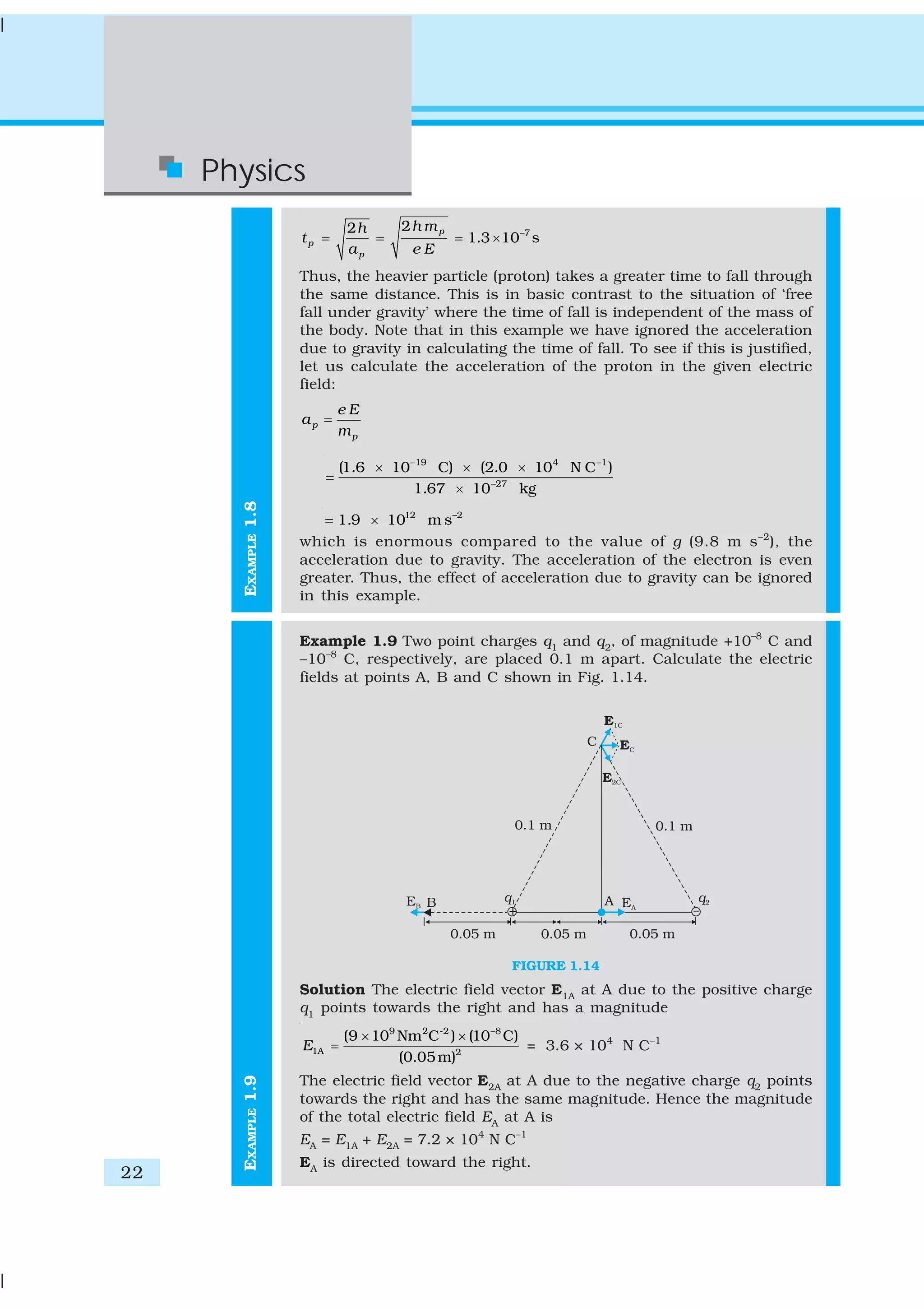
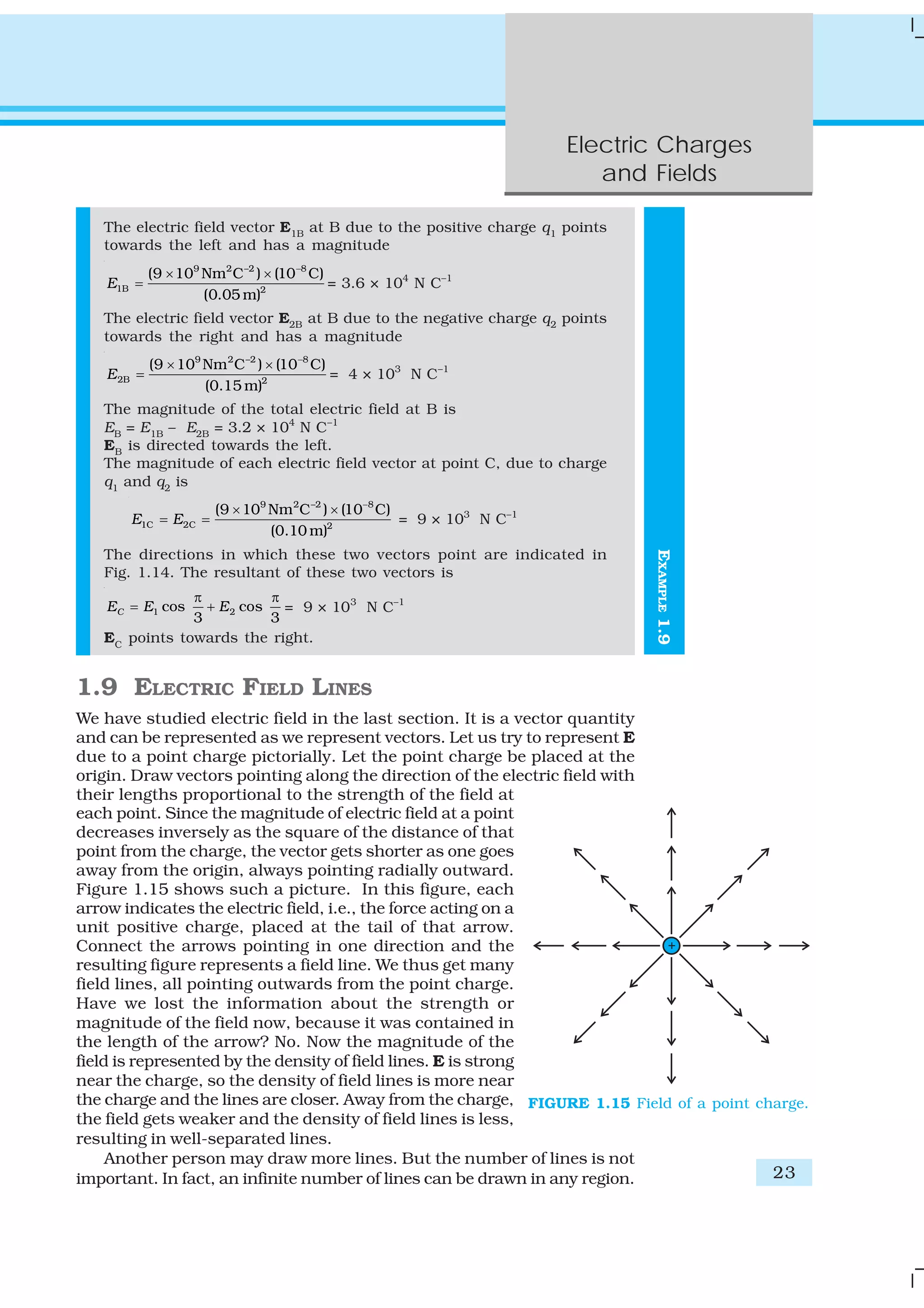


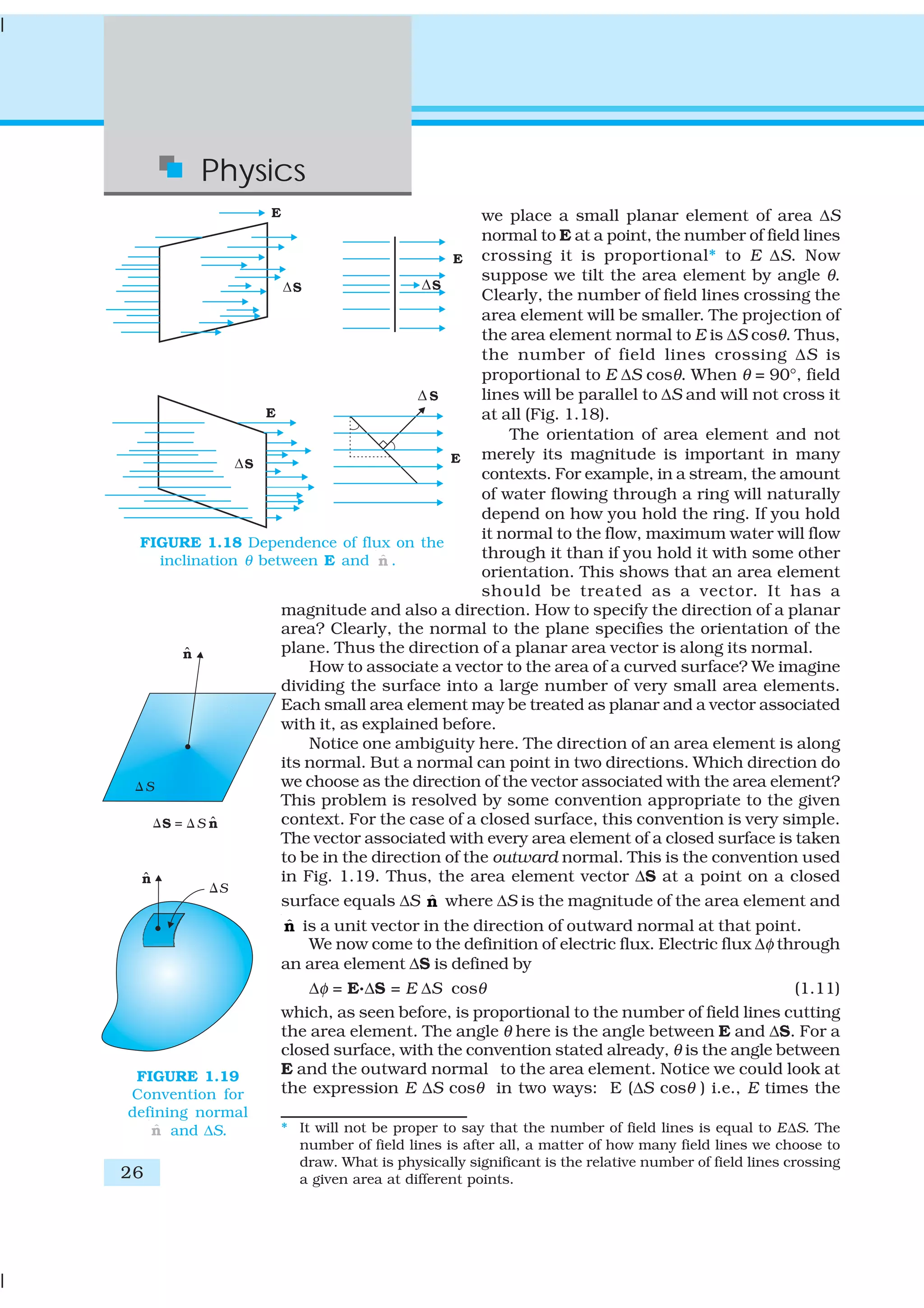
![Electric Charges
and Fields
27
projection of area normal to E, or E⊥
ΔS, i.e., component of E along the
normal to the area element times the magnitude of the area element. The
unit of electric flux is N C–1
m2
.
The basic definition of electric flux given by Eq. (1.11) can be used, in
principle, to calculate the total flux through any given surface. All we
have to do is to divide the surface into small area elements, calculate the
flux at each element and add them up. Thus, the total flux φ through a
surface S is
φ ~ Σ E.ΔS (1.12)
The approximation sign is put because the electric field E is taken to
be constant over the small area element. This is mathematically exact
only when you take the limit ΔS → 0 and the sum in Eq. (1.12) is written
as an integral.
1.11 ELECTRIC DIPOLE
An electric dipole is a pair of equal and opposite point charges q and –q,
separated by a distance 2a. The line connecting the two charges defines
a direction in space. By convention, the direction from –q to q is said to
be the direction of the dipole. The mid-point of locations of –q and q is
called the centre of the dipole.
The total charge of the electric dipole is obviously zero. This does not
mean that the field of the electric dipole is zero. Since the charge q and
–q are separated by some distance, the electric fields due to them, when
added, do not exactly cancel out. However, at distances much larger than
the separation of the two charges forming a dipole (r >> 2a), the fields
due to q and –q nearly cancel out. The electric field due to a dipole
therefore falls off, at large distance, faster than like 1/r2
(the dependence
on r of the field due to a single charge q). These qualitative ideas are
borne out by the explicit calculation as follows:
1.11.1 The field of an electric dipole
The electric field of the pair of charges (–q and q) at any point in space
can be found out from Coulomb’s law and the superposition principle.
The results are simple for the following two cases: (i) when the point is on
the dipole axis, and (ii) when it is in the equatorial plane of the dipole,
i.e., on a plane perpendicular to the dipole axis through its centre. The
electric field at any general point P is obtained by adding the electric
fields E–q due to the charge –q and E+q due to the charge q, by the
parallelogram law of vectors.
(i) For points on the axis
Let the point P be at distance r from the centre of the dipole on the side of
the charge q, as shown in Fig. 1.20(a). Then
2
0
ˆ
4 ( )
q
q
r aε
− = −
π +
E p [1.13(a)]
where ˆp is the unit vector along the dipole axis (from –q to q). Also
2
0
ˆ
4 ( )
q
q
r aε
+ =
π −
E p [1.13(b)]](https://image.slidesharecdn.com/ncert-class-12-physics-part-1-161112171109/75/Ncert-class-12-physics-part-1-31-2048.jpg)
![28
Physics
The total field at P is
2 2
0
1 1
ˆ
4 ( ) ( )
q q
q
r a r aε+ −
⎡ ⎤
= + = −⎢ ⎥
π − +⎣ ⎦
E E E p
2 2 2
4
ˆ
4 ( )o
a rq
r aε
=
π −
p (1.14)
For r >> a
3
0
4
ˆ
4
q a
rε
=
π
E p (r >> a) (1.15)
(ii) For points on the equatorial plane
The magnitudes of the electric fields due to the two
charges +q and –q are given by
2 2
0
1
4
q
q
E
r aε+ =
π + [1.16(a)]
– 2 2
0
1
4
q
q
E
r aε
=
π +
[1.16(b)]
and are equal.
The directions of E+q and E–q are as shown in
Fig. 1.20(b). Clearly, the components normal to the dipole
axis cancel away. The components along the dipole axis
add up. The total electric field is opposite to ˆp. We have
E = – (E +q + E –q ) cosθ ˆp
2 2 3/2
2
ˆ
4 ( )o
q a
r aε
= −
π +
p (1.17)
At large distances (r >> a), this reduces to
3
2
ˆ ( )
4 o
q a
r a
rε
= − >>
π
E p (1.18)
From Eqs. (1.15) and (1.18), it is clear that the dipole field at large
distances does not involve q and a separately; it depends on the product
qa. This suggests the definition of dipole moment. The dipole moment
vector p of an electric dipole is defined by
p = q × 2a ˆp (1.19)
that is, it is a vector whose magnitude is charge q times the separation
2a (between the pair of charges q, –q) and the direction is along the line
from –q to q. In terms of p, the electric field of a dipole at large distances
takes simple forms:
At a point on the dipole axis
3
2
4 orε
=
π
p
E (r >> a) (1.20)
At a point on the equatorial plane
3
4 orε
= −
π
p
E (r >> a) (1.21)
FIGURE 1.20 Electric field of a dipole
at (a) a point on the axis, (b) a point
on the equatorial plane of the dipole.
p is the dipole moment vector of
magnitude p = q × 2a and
directed from –q to q.](https://image.slidesharecdn.com/ncert-class-12-physics-part-1-161112171109/75/Ncert-class-12-physics-part-1-32-2048.jpg)
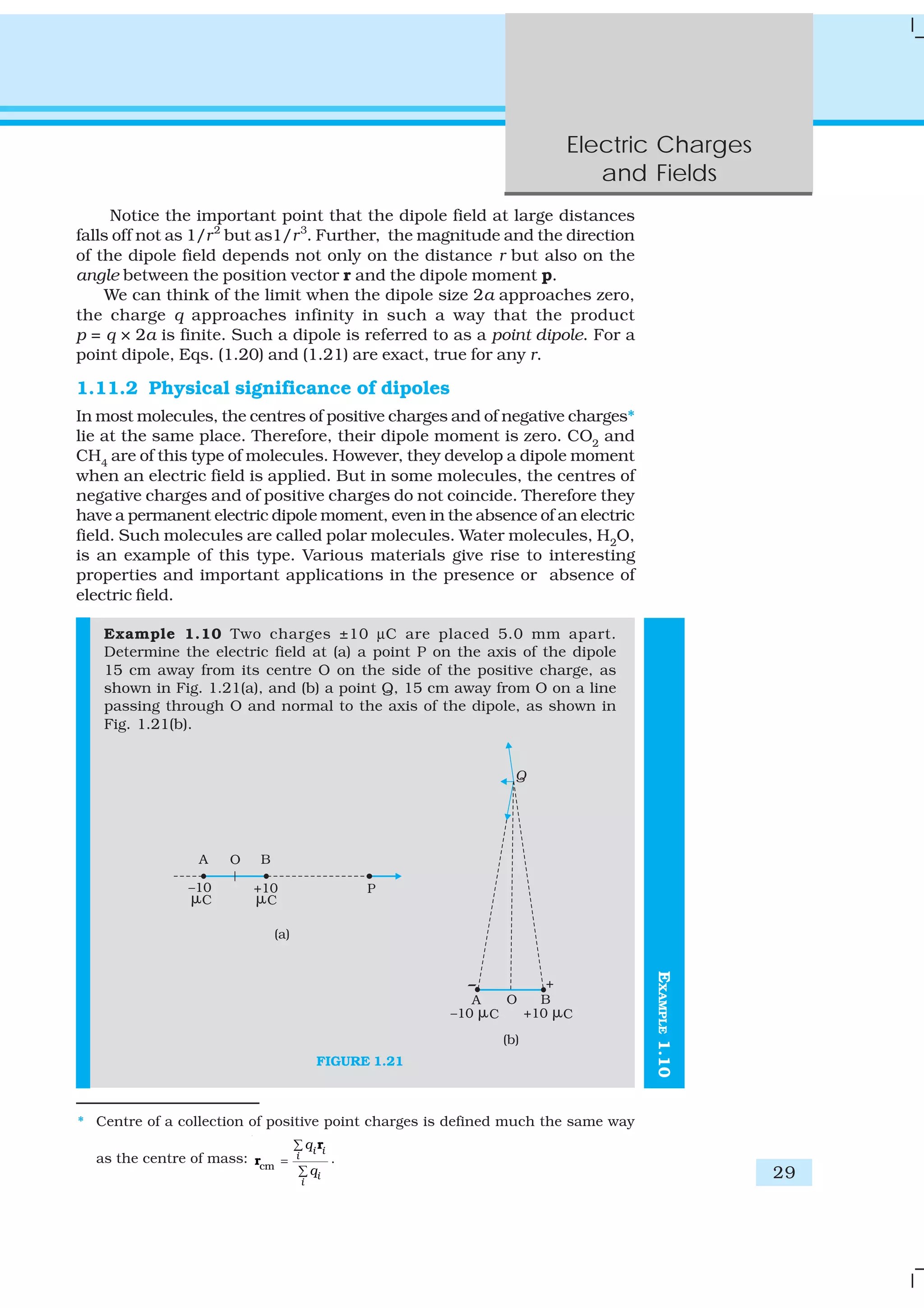
![30
Physics
EXAMPLE1.10
Solution (a) Field at P due to charge +10 μC
=
5
12 2 1 2
10 C
4 (8.854 10 C N m )
−
− − −
π ×
2 4 2
1
(15 0.25) 10 m−
×
− ×
= 4.13 × 106
N C–1
along BP
Field at P due to charge –10 μC
–5
12 2 1 2
10 C
4 (8.854 10 C N m )− − −
=
π ×
2 4 2
1
(15 0.25) 10 m−
×
+ ×
= 3.86 × 106
N C–1
along PA
The resultant electric field at P due to the two charges at A and B is
= 2.7 × 105
N C–1
along BP.
In this example, the ratio OP/OB is quite large (= 60). Thus, we can
expect to get approximately the same result as above by directly using
the formula for electric field at a far-away point on the axis of a dipole.
For a dipole consisting of charges ± q, 2a distance apart, the electric
field at a distance r from the centre on the axis of the dipole has a
magnitude
3
0
2
4
p
E
rε
=
π
(r/a >> 1)
where p = 2a q is the magnitude of the dipole moment.
The direction of electric field on the dipole axis is always along the
direction of the dipole moment vector (i.e., from –q to q). Here,
p =10–5
C × 5 × 10–3
m = 5 × 10–8
C m
Therefore,
E =
8
12 2 1 2
2 5 10 C m
4 (8.854 10 C N m )
−
− − −
× ×
π ×
3 6 3
1
(15) 10 m−
×
×
= 2.6 × 105
N C–1
along the dipole moment direction AB, which is close to the result
obtained earlier.
(b) Field at Q due to charge + 10 μC at B
=
5
12 2 1 2
10 C
4 (8.854 10 C N m )
−
− − −
π × 2 2 4 2
1
[15 (0.25) ] 10 m−
+ ×
×
= 3.99 × 106
N C–1
along BQ
Field at Q due to charge –10 μC at A
=
5
12 2 1 2
10 C
4 (8.854 10 C N m )
−
− − −
π ×
2 2 4 2
1
[15 (0.25) ] 10 m−
+ ×
×
= 3.99 × 106
N C–1
along QA.
Clearly, the components of these two forces with equal magnitudes
cancel along the direction OQ but add up along the direction parallel
to BA. Therefore, the resultant electric field at Q due to the two
charges at A and B is
= 2 ×
6 –1
2 2
0.25
3.99 10 N C
15 (0.25)
× ×
+
along BA
= 1.33 × 105
N C–1
along BA.
As in (a), we can expect to get approximately the same result by
directly using the formula for dipole field at a point on the normal to
the axis of the dipole:](https://image.slidesharecdn.com/ncert-class-12-physics-part-1-161112171109/75/Ncert-class-12-physics-part-1-34-2048.jpg)
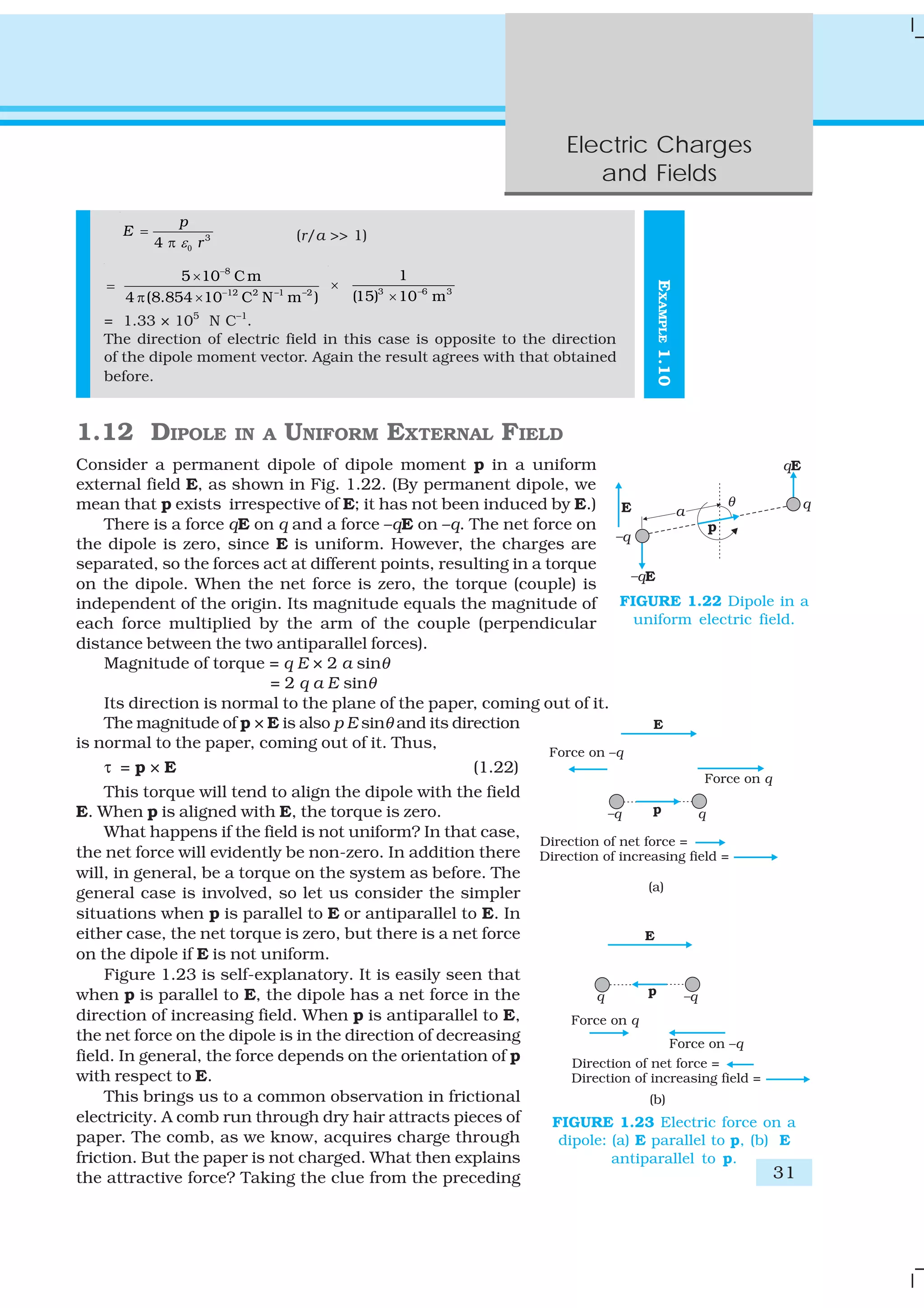
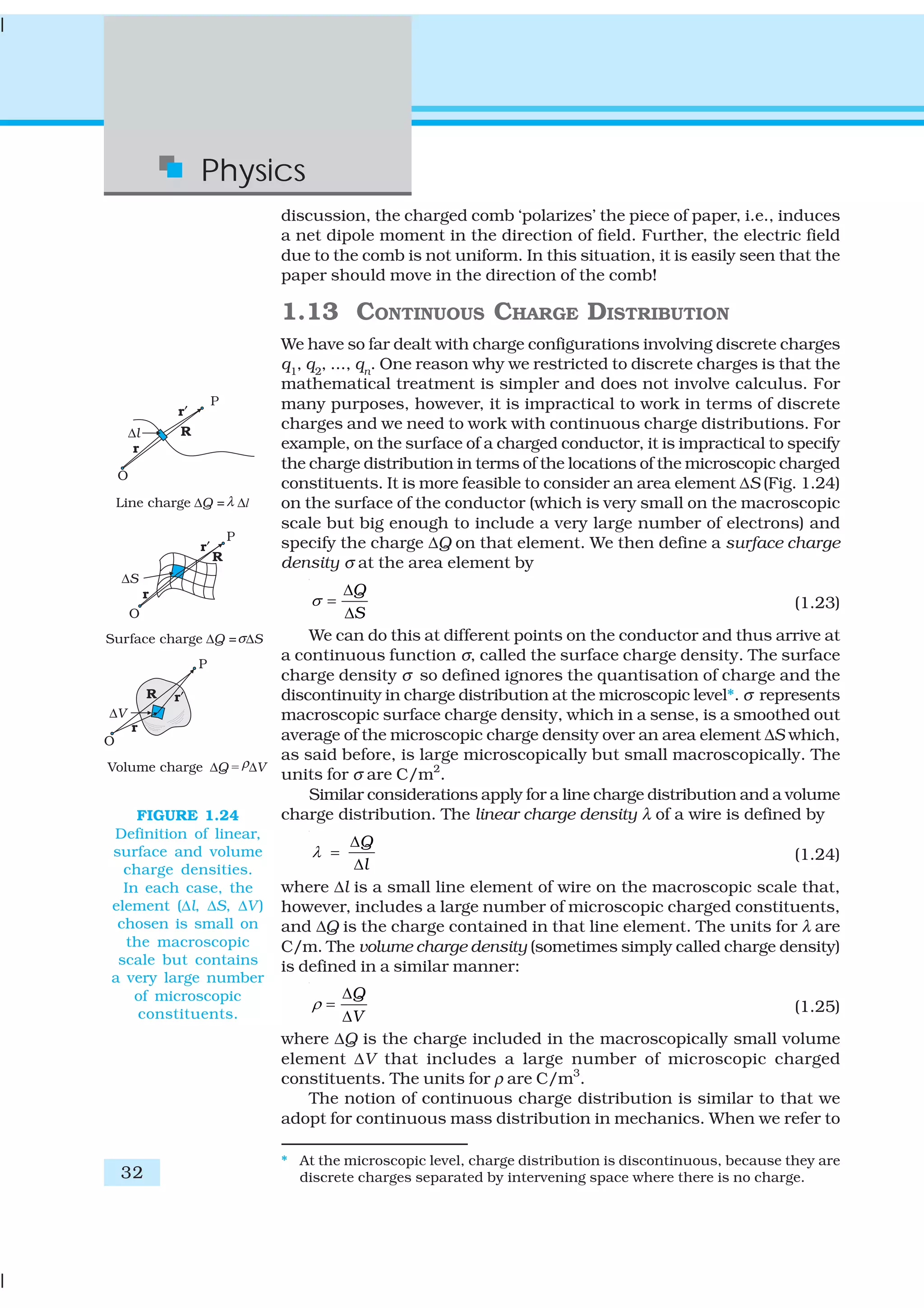
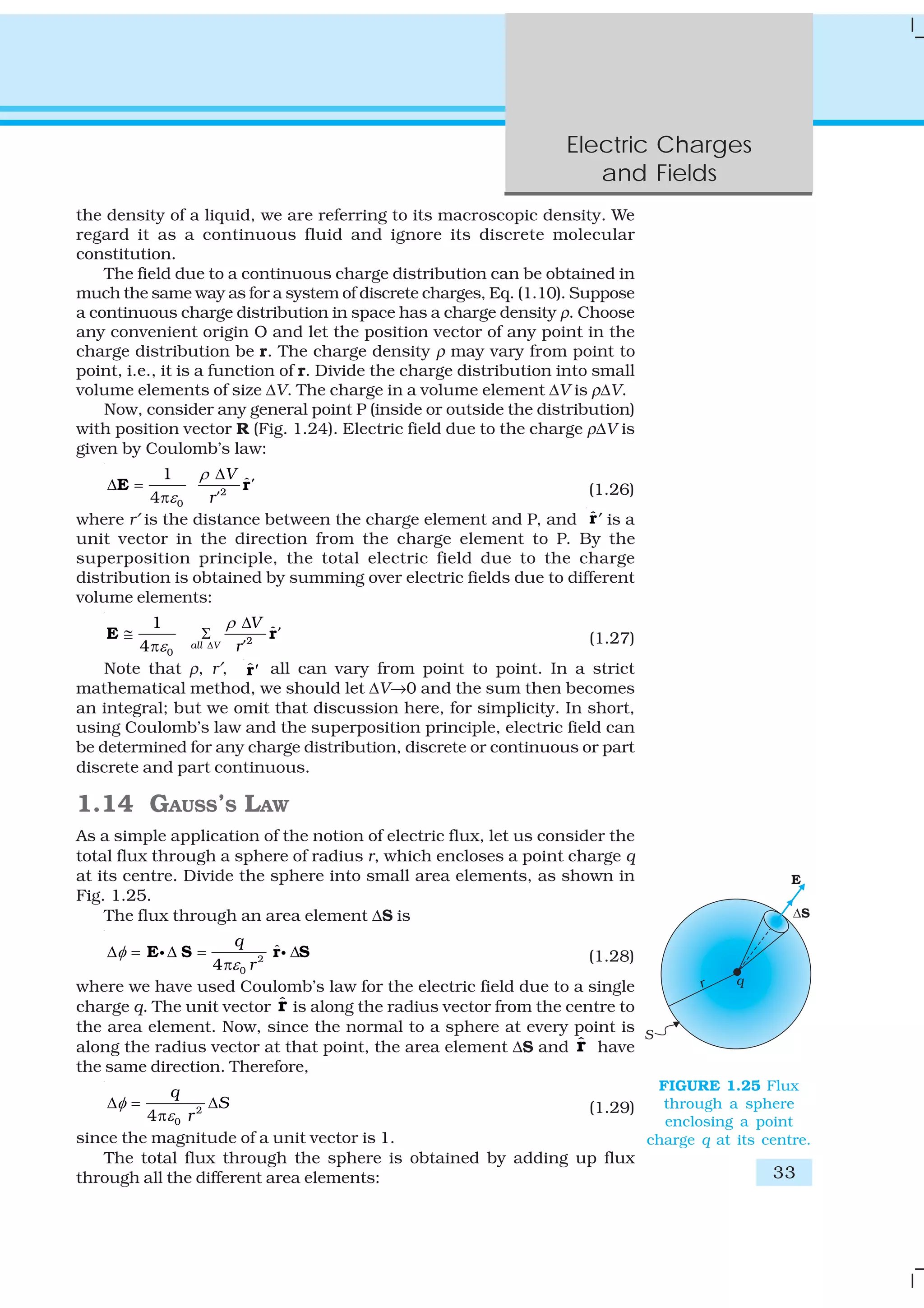
![34
Physics
2
04all S
q
S
r
φ
εΔ
= Σ Δ
π
Since each area element of the sphere is at the same
distance r from the charge,
2 2
04 4all S
o
q q
S S
r r
φ
ε εΔ
= Σ Δ =
π π
Now S, the total area of the sphere, equals 4πr2
. Thus,
2
2
00
4
4
q q
r
r
φ
εε
= × π =
π (1.30)
Equation (1.30) is a simple illustration of a general result of
electrostatics called Gauss’s law.
We state Gauss’s law without proof:
Electric flux through a closed surface S
= q/ε0
(1.31)
q = total charge enclosed by S.
The law implies that the total electric flux through a closed surface is
zero if no charge is enclosed by the surface. We can see that explicitly in
the simple situation of Fig. 1.26.
Here the electric field is uniform and we are considering a closed
cylindrical surface, with its axis parallel to the uniform field E. The total
flux φ through the surface is φ = φ1
+ φ2
+ φ3
, where φ1
and φ2
represent
the flux through the surfaces 1 and 2 (of circular cross-section) of the
cylinder and φ3
is the flux through the curved cylindrical part of the
closed surface. Now the normal to the surface 3 at every point is
perpendicular to E, so by definition of flux, φ3 = 0. Further, the outward
normal to 2 is along E while the outward normal to 1 is opposite to E.
Therefore,
φ1
= –E S1
, φ2
= +E S2
S1
= S2
= S
where S is the area of circular cross-section. Thus, the total flux is zero,
as expected by Gauss’s law. Thus, whenever you find that the net electric
flux through a closed surface is zero, we conclude that the total charge
contained in the closed surface is zero.
The great significance of Gauss’s law Eq. (1.31), is that it is true in
general, and not only for the simple cases we have considered above. Let
us note some important points regarding this law:
(i) Gauss’s law is true for any closed surface, no matter what its shape
or size.
(ii) The term q on the right side of Gauss’s law, Eq. (1.31), includes the
sum of all charges enclosed by the surface. The charges may be located
anywhere inside the surface.
(iii) In the situation when the surface is so chosen that there are some
charges inside and some outside, the electric field [whose flux appears
on the left side of Eq. (1.31)] is due to all the charges, both inside and
outside S. The term q on the right side of Gauss’s law, however,
represents only the total charge inside S.
FIGURE 1.26 Calculation of the
flux of uniform electric field
through the surface of a cylinder.](https://image.slidesharecdn.com/ncert-class-12-physics-part-1-161112171109/75/Ncert-class-12-physics-part-1-38-2048.jpg)
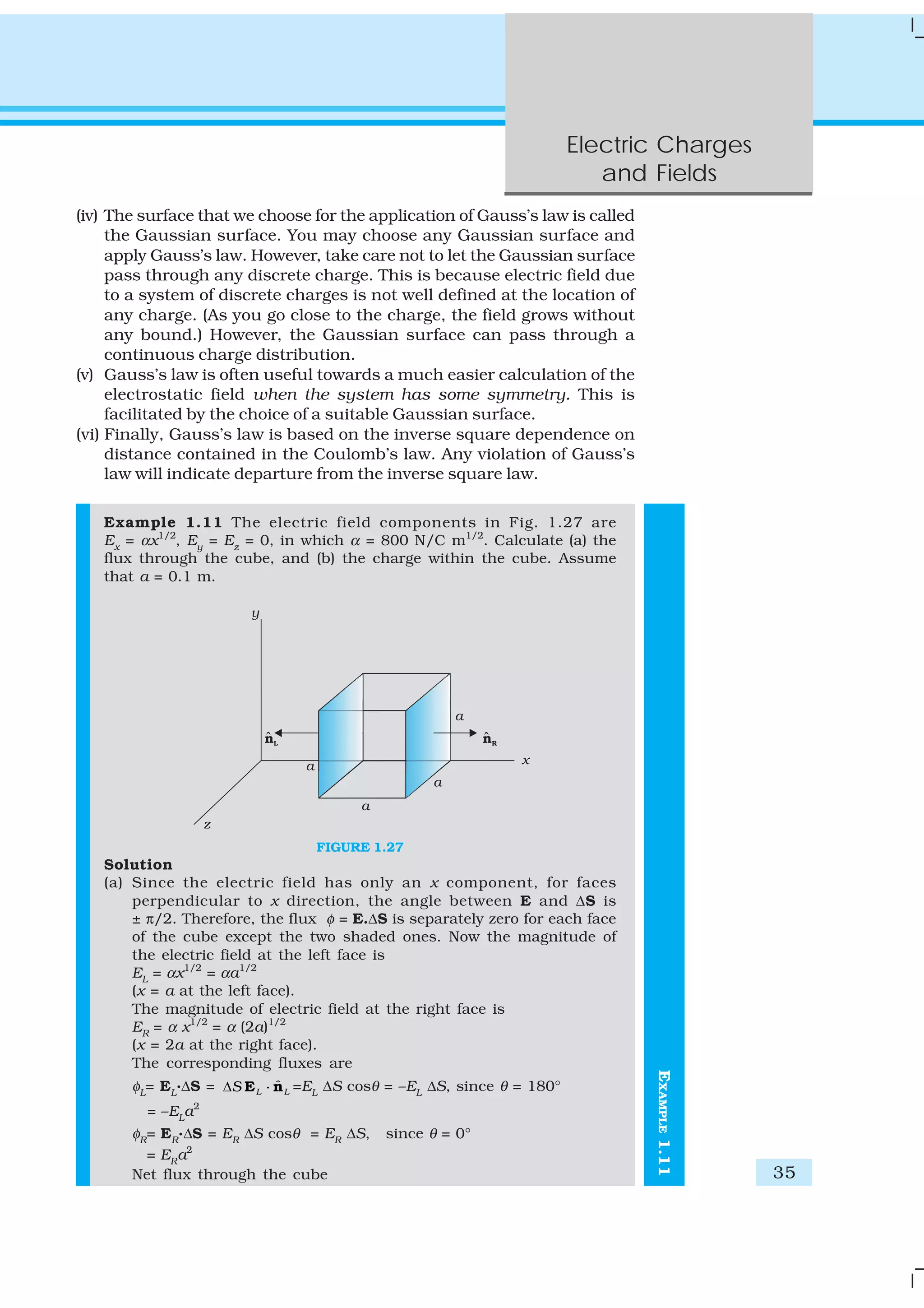
![36
Physics
EXAMPLE1.12EXAMPLE1.11
= φR
+ φL
= ER
a2
– EL
a2
= a2
(ER
– EL
) = αa2
[(2a)1/2
– a1/2
]
= αa5/2
( )2 – 1
= 800 (0.1)5/2
( )2 – 1
= 1.05 N m2
C–1
(b) We can use Gauss’s law to find the total charge q inside the cube.
We have φ = q/ε0
or q = φε0
. Therefore,
q = 1.05 × 8.854 × 10–12
C = 9.27 × 10–12
C.
Example 1.12 An electric field is uniform, and in the positive x
direction for positive x, and uniform with the same magnitude but in
the negative x direction for negative x. It is given that E = 200 ˆi N/C
for x > 0 and E = –200 ˆi N/C for x < 0. A right circular cylinder of
length 20 cm and radius 5 cm has its centre at the origin and its axis
along the x-axis so that one face is at x = +10 cm and the other is at
x = –10 cm (Fig. 1.28). (a) What is the net outward flux through each
flat face? (b) What is the flux through the side of the cylinder?
(c) What is the net outward flux through the cylinder? (d) What is the
net charge inside the cylinder?
Solution
(a) We can see from the figure that on the left face E and ΔS are
parallel. Therefore, the outward flux is
φL
= E.ΔS = – 200 ˆ Δi Si
= + 200 ΔS, since ˆ Δi Si = – ΔS
= + 200 × π (0.05)2
= + 1.57 N m2
C–1
On the right face, E and ΔS are parallel and therefore
φR
= E.ΔS = + 1.57 N m2
C–1
.
(b) For any point on the side of the cylinder E is perpendicular to
ΔS and hence E.ΔS = 0. Therefore, the flux out of the side of the
cylinder is zero.
(c) Net outward flux through the cylinder
φ = 1.57 + 1.57 + 0 = 3.14 N m2
C–1
FIGURE 1.28
(d) The net charge within the cylinder can be found by using Gauss’s
law which gives
q = ε0
φ
= 3.14 × 8.854 × 10–12
C
= 2.78 × 10–11
C](https://image.slidesharecdn.com/ncert-class-12-physics-part-1-161112171109/75/Ncert-class-12-physics-part-1-40-2048.jpg)

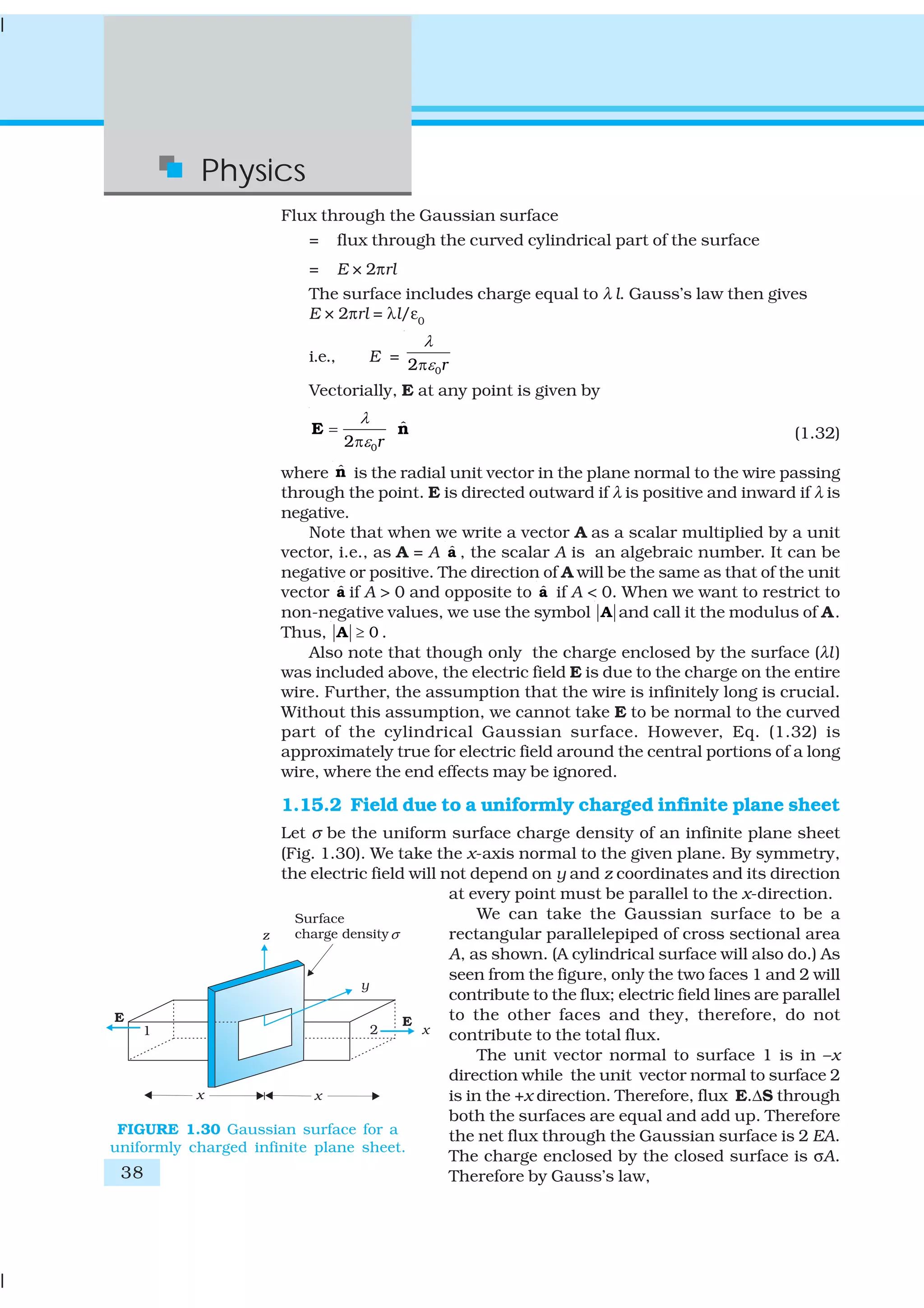


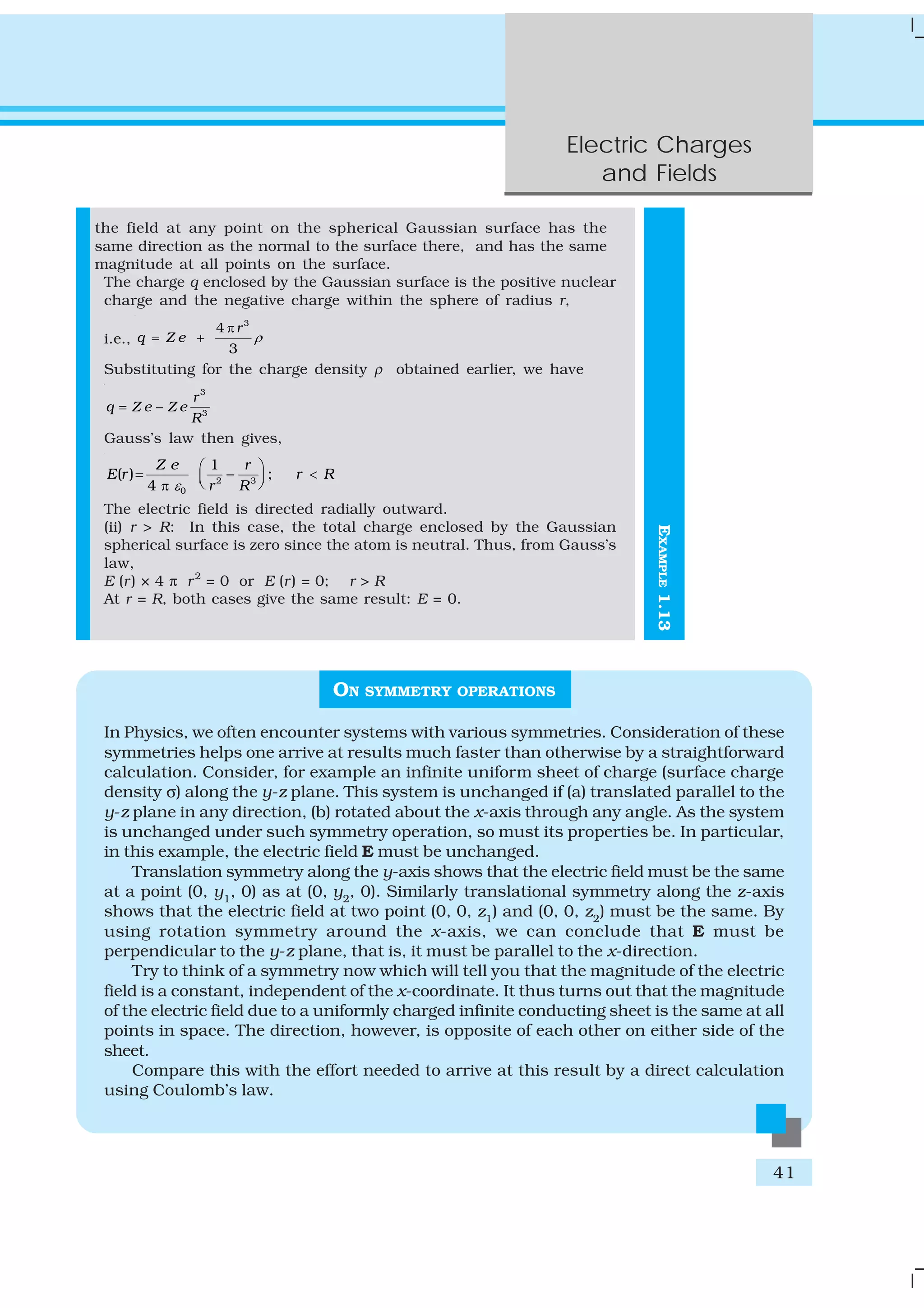
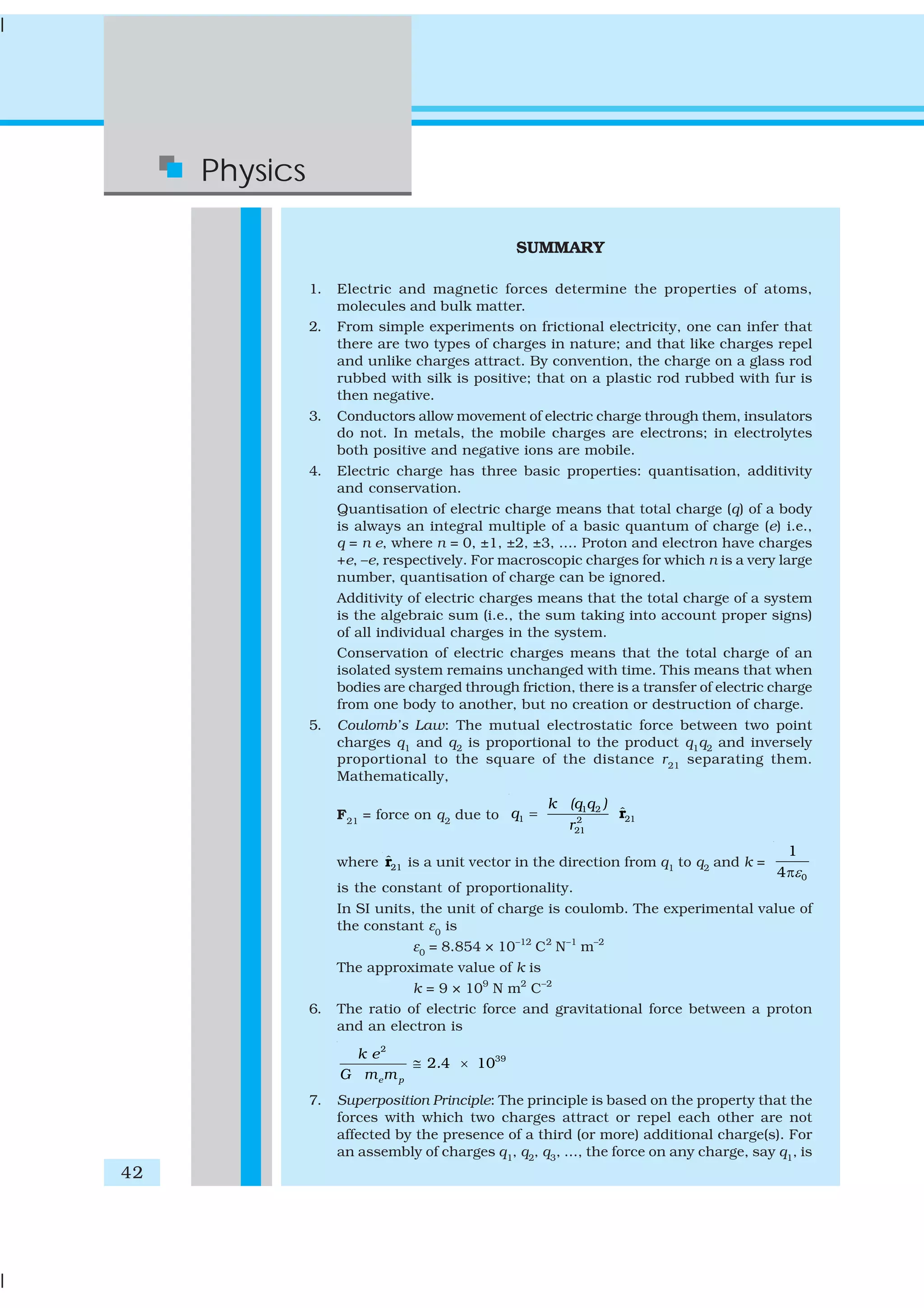

![44
Physics
For an area element of a closed surface, ˆn is taken to be the direction
of outward normal, by convention.
15. Gauss’s law: The flux of electric field through any closed surface S is
1/ε0
times the total charge enclosed by S. The law is especially useful
in determining electric field E, when the source distribution has simple
symmetry:
(i) Thin infinitely long straight wire of uniform linear charge density λ
0
ˆ
2 r
λ
ε
=
π
E n
where r is the perpendicular distance of the point from the wire and
ˆn is the radial unit vector in the plane normal to the wire passing
through the point.
(ii) Infinite thin plane sheet of uniform surface charge density σ
0
ˆ
2
σ
ε
=E n
where ˆn is a unit vector normal to the plane, outward on either side.
(iii) Thin spherical shell of uniform surface charge density σ
2
0
ˆ ( )
4
q
r R
rε
= ≥
π
E r
E = 0 (r < R)
where r is the distance of the point from the centre of the shell and R
the radius of the shell. q is the total charge of the shell: q = 4πR2
σ.
The electric field outside the shell is as though the total charge is
concentrated at the centre. The same result is true for a solid sphere
of uniform volume charge density. The field is zero at all points inside
the shell
Physical quantity Symbol Dimensions Unit Remarks
Vector area element Δ S [L2
] m2
ΔS = ΔS ˆn
Electric field E [MLT–3
A–1
] V m–1
Electric flux φ [ML3
T–3
A–1
] V m Δφ = E.ΔS
Dipole moment p [LTA] C m Vector directed
from negative to
positive charge
Charge density
linear λ [L–1
TA] C m–1
Charge/length
surface σ [L–2
TA] C m–2
Charge/area
volume ρ [L–3
TA] C m–3
Charge/volume](https://image.slidesharecdn.com/ncert-class-12-physics-part-1-161112171109/75/Ncert-class-12-physics-part-1-48-2048.jpg)
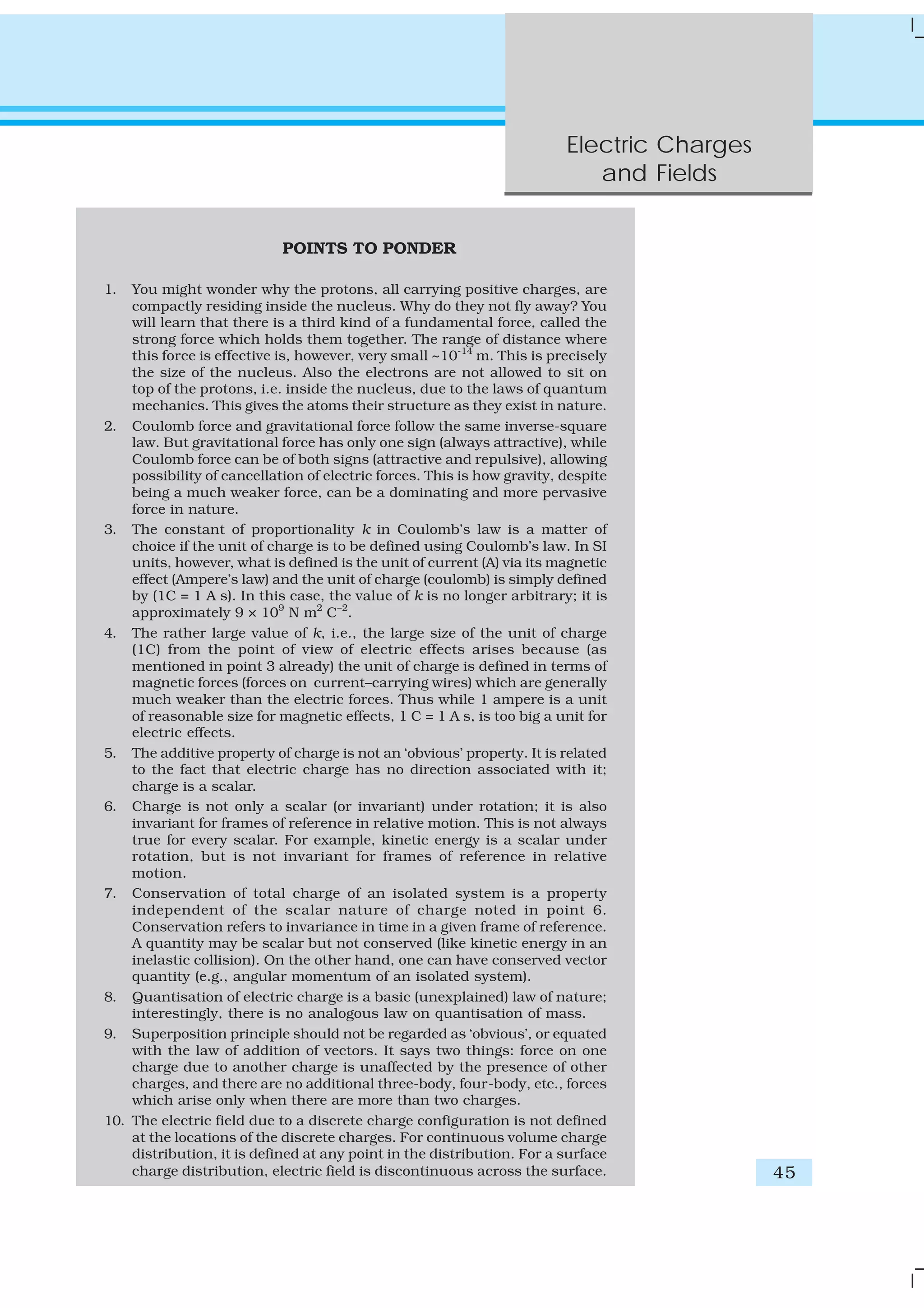

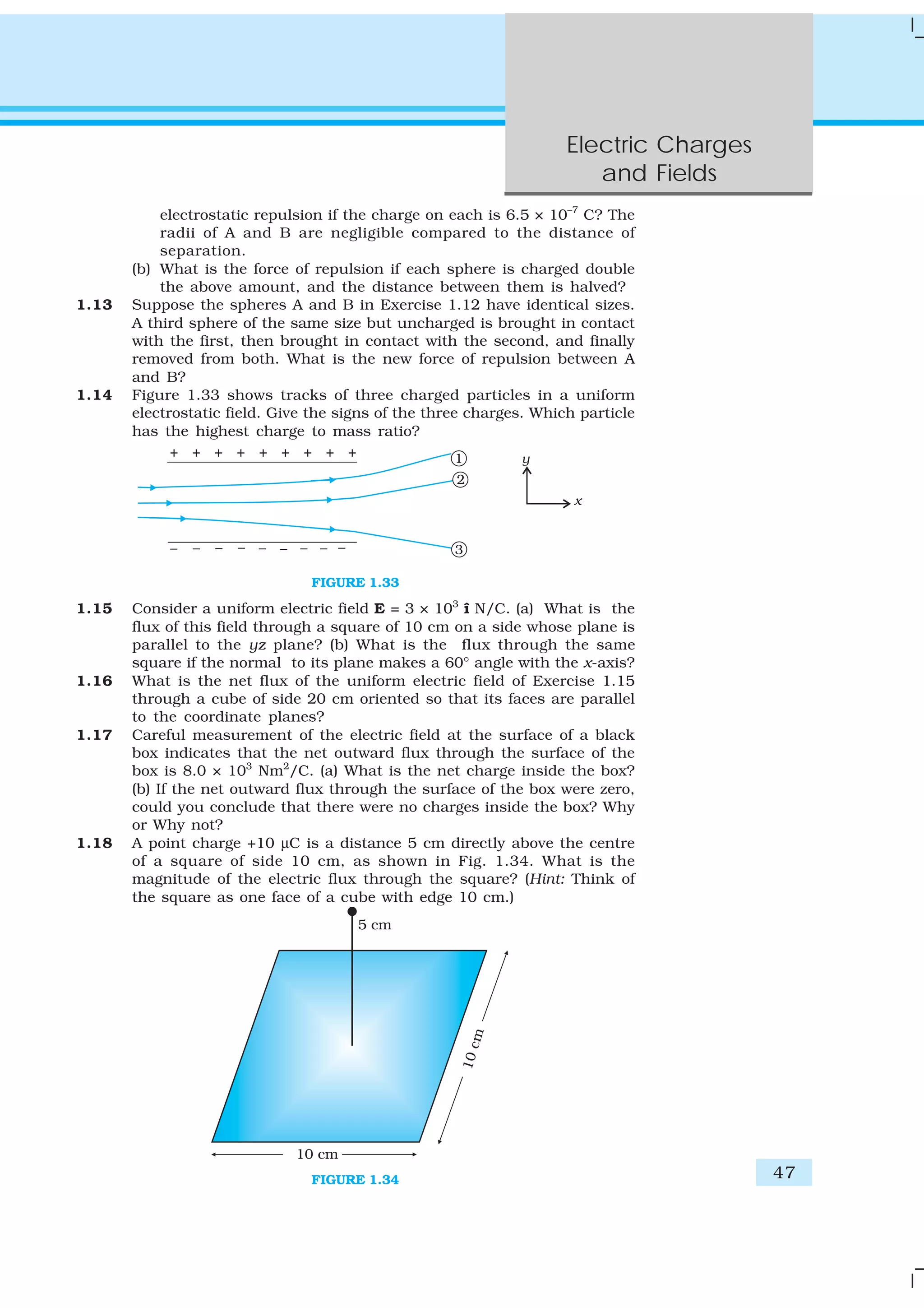

![Electric Charges
and Fields
49
FIGURE 1.35
1.27 In a certain region of space, electric field is along the z-direction
throughout. The magnitude of electric field is, however, not constant
but increases uniformly along the positive z-direction, at the rate of
105
NC–1
per metre. What are the force and torque experienced by a
system having a total dipole moment equal to 10–7
Cm in the negative
z-direction ?
1.28 (a) A conductor A with a cavity as shown in Fig. 1.36(a) is given a
charge Q. Show that the entire charge must appear on the outer
surface of the conductor. (b) Another conductor B with charge q is
inserted into the cavity keeping B insulated from A. Show that the
total charge on the outside surface of A is Q + q [Fig. 1.36(b)]. (c) A
sensitive instrument is to be shielded from the strong electrostatic
fields in its environment. Suggest a possible way.
FIGURE 1.36
1.29 A hollow charged conductor has a tiny hole cut into its surface.
Show that the electric field in the hole is (σ/2ε0
) ˆn , where ˆn is the
unit vector in the outward normal direction, and σ is the surface
charge density near the hole.
1.30 Obtain the formula for the electric field due to a long thin wire of
uniform linear charge density λ without using Gauss’s law. [Hint:
Use Coulomb’s law directly and evaluate the necessary integral.]
1.31 It is now believed that protons and neutrons (which constitute nuclei
of ordinary matter) are themselves built out of more elementary units
called quarks. A proton and a neutron consist of three quarks each.
Two types of quarks, the so called ‘up’ quark (denoted by u) of charge
+ (2/3) e, and the ‘down’ quark (denoted by d) of charge (–1/3) e,
together with electrons build up ordinary matter. (Quarks of other
types have also been found which give rise to different unusual
varieties of matter.) Suggest a possible quark composition of a
proton and neutron.](https://image.slidesharecdn.com/ncert-class-12-physics-part-1-161112171109/75/Ncert-class-12-physics-part-1-53-2048.jpg)
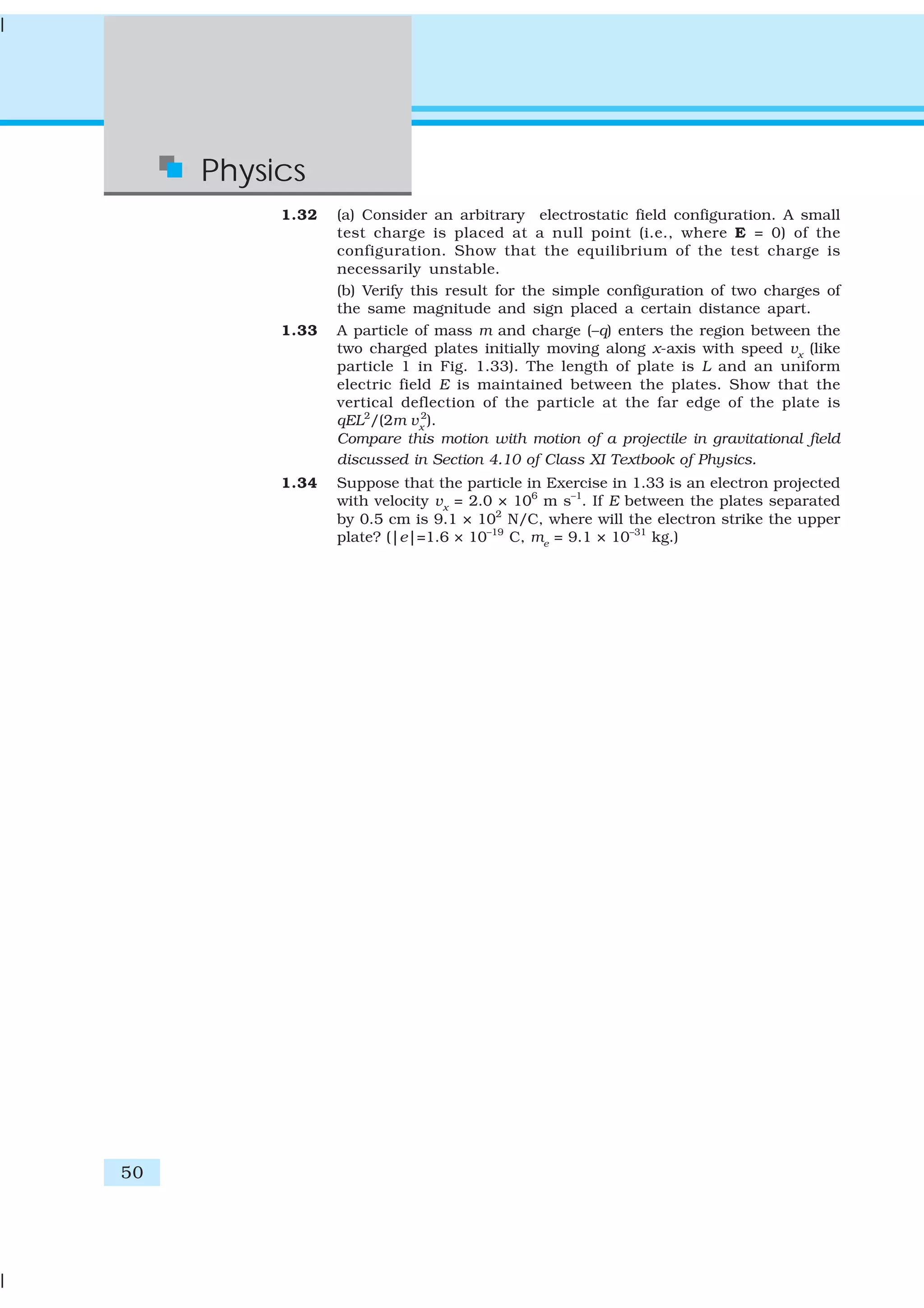
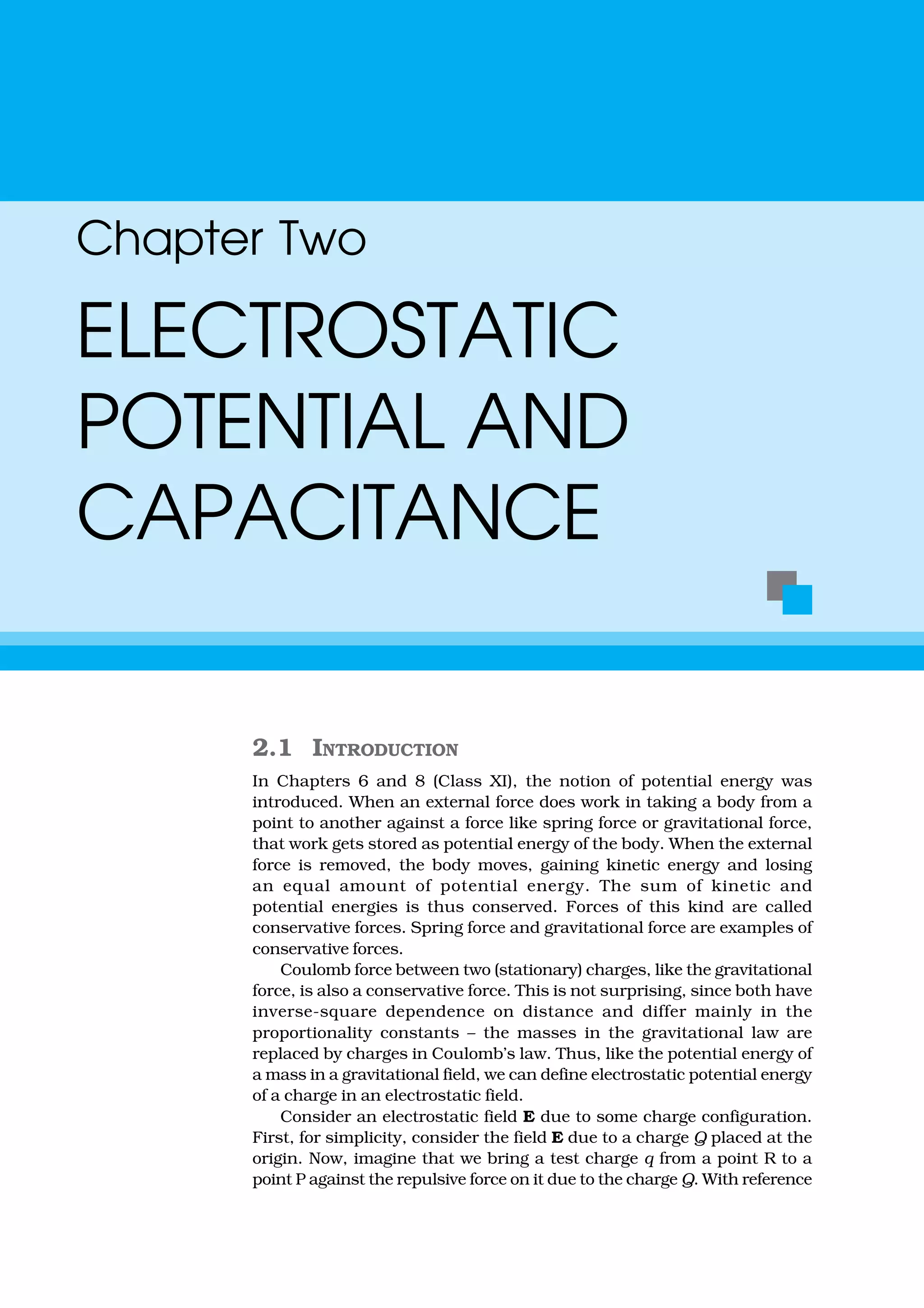
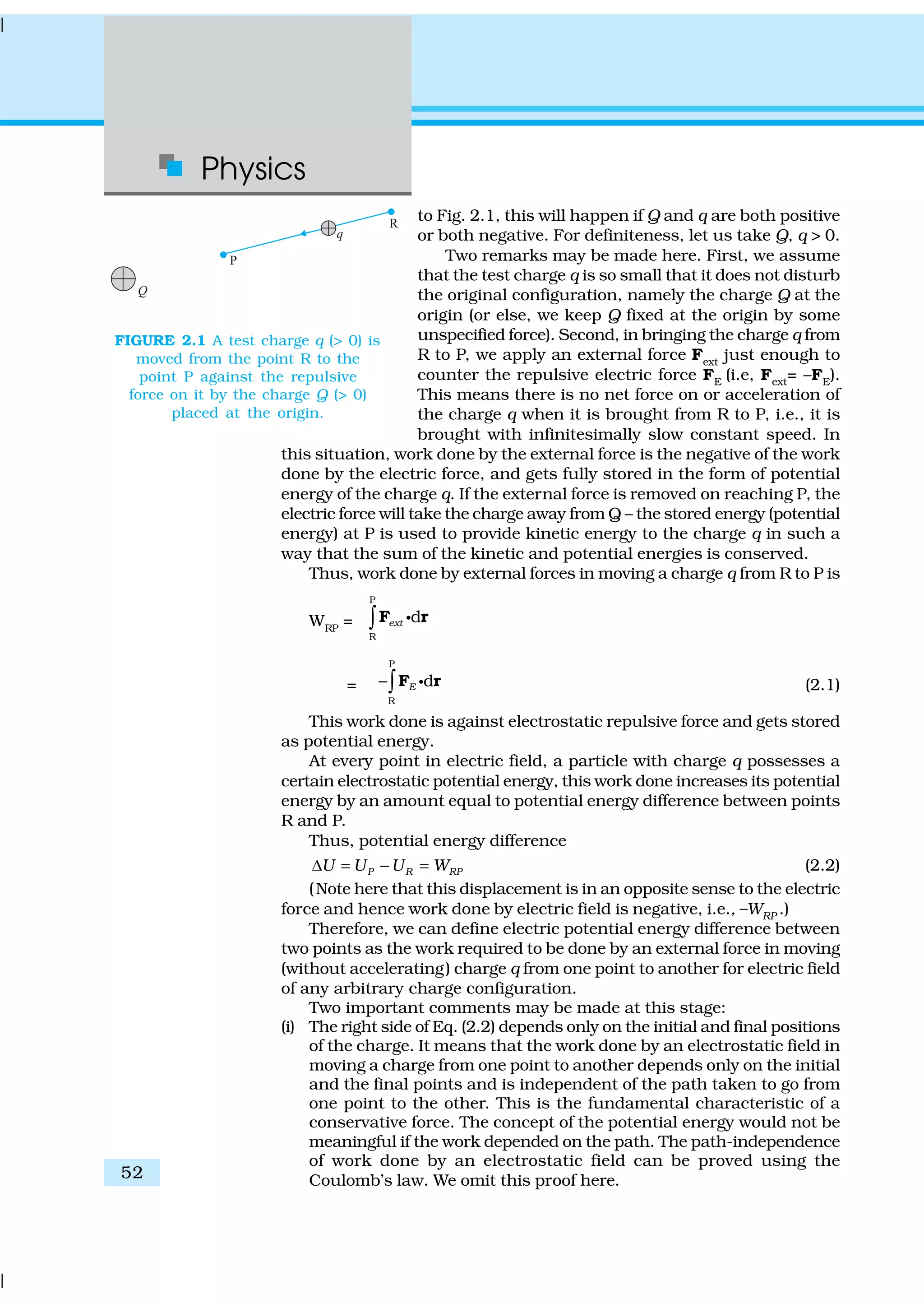
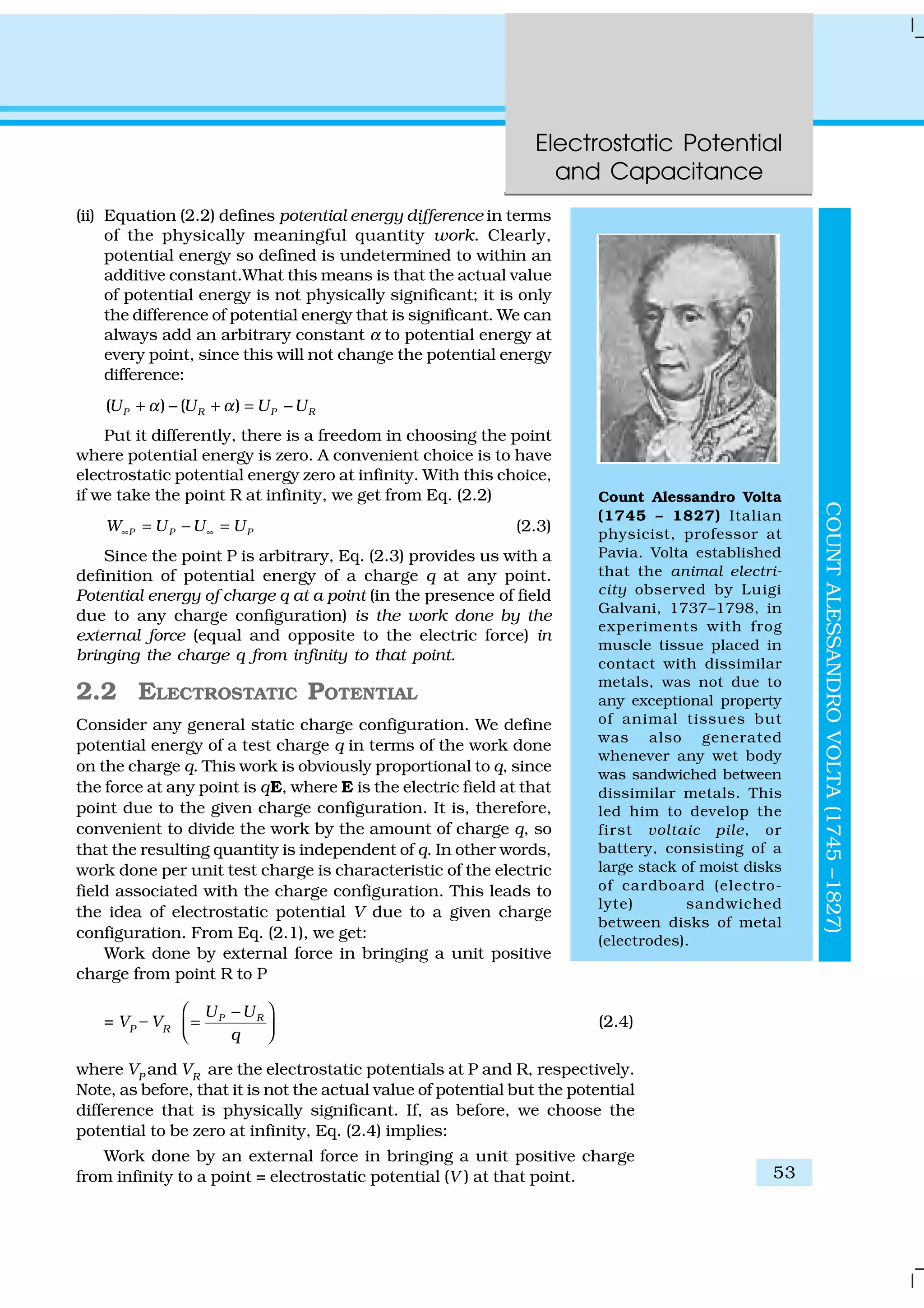
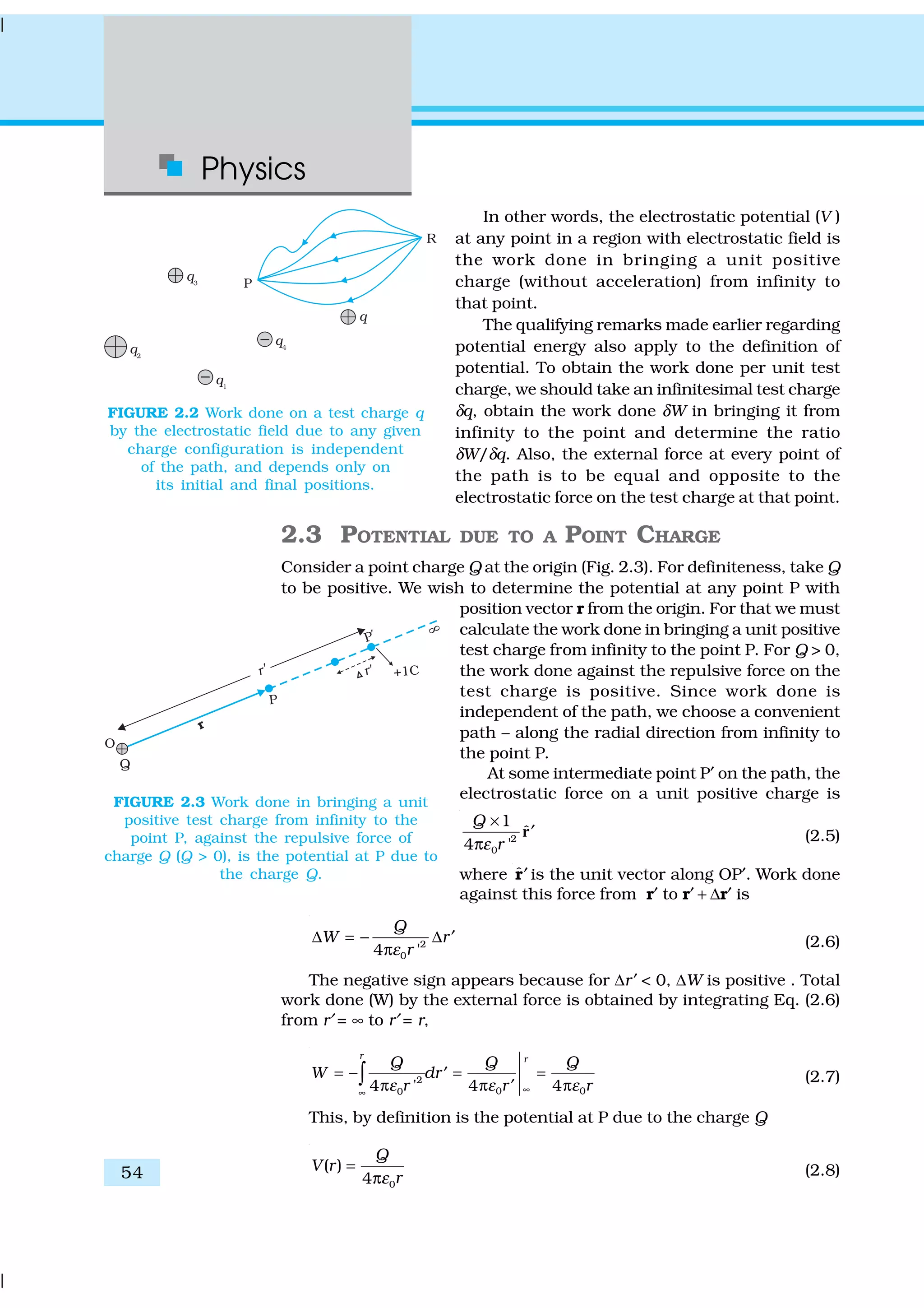
![Electrostatic Potential
and Capacitance
55
EXAMPLE2.1
Equation (2.8) is true for any
sign of the charge Q, though we
considered Q > 0 in its derivation.
For Q < 0, V < 0, i.e., work done (by
the external force) per unit positive
test charge in bringing it from
infinity to the point is negative. This
is equivalent to saying that work
done by the electrostatic force in
bringing the unit positive charge
form infinity to the point P is
positive. [This is as it should be,
since for Q < 0, the force on a unit
positive test charge is attractive, so
that the electrostatic force and the
displacement (from infinity to P) are
in the same direction.] Finally, we
note that Eq. (2.8) is consistent with
the choice that potential at infinity
be zero.
Figure (2.4) shows how the electrostatic potential ( ∝ 1/r) and the
electrostatic field ( ∝ 1/r2
) varies with r.
Example 2.1
(a) Calculate the potential at a point P due to a charge of 4 × 10–7
C
located 9 cm away.
(b) Hence obtain the work done in bringing a charge of 2 × 10–9
C
from infinity to the point P. Does the answer depend on the path
along which the charge is brought?
Solution
(a)
7
9 2 –2
0
1 4 10 C
9 10 Nm C
4 0.09m
Q
V
rε
−
×
= = × ×
π
= 4 × 104
V
(b) 9 4
2 10 C 4 10 VW qV −
= = × × ×
= 8 × 10–5
J
No, work done will be path independent. Any arbitrary infinitesimal
path can be resolved into two perpendicular displacements: One along
r and another perpendicular to r. The work done corresponding to
the later will be zero.
2.4 POTENTIAL DUE TO AN ELECTRIC DIPOLE
As we learnt in the last chapter, an electric dipole consists of two charges
q and –q separated by a (small) distance 2a. Its total charge is zero. It is
characterised by a dipole moment vector p whose magnitude is q × 2a
and which points in the direction from –q to q (Fig. 2.5). We also saw that
the electric field of a dipole at a point with position vector r depends not
just on the magnitude r, but also on the angle between r and p. Further,
FIGURE 2.4 Variation of potential V with r [in units of
(Q/4πε0
) m-1
] (blue curve) and field with r [in units
of (Q/4πε0
) m-2
] (black curve) for a point charge Q.](https://image.slidesharecdn.com/ncert-class-12-physics-part-1-161112171109/75/Ncert-class-12-physics-part-1-59-2048.jpg)
![Physics
56
the field falls off, at large distance, not as
1/r 2
(typical of field due to a single charge)
but as 1/r3
.We, now, determine the electric
potential due to a dipole and contrast it
with the potential due to a single charge.
As before, we take the origin at the
centre of the dipole. Now we know that the
electric field obeys the superposition
principle. Since potential is related to the
work done by the field, electrostatic
potential also follows the superposition
principle. Thus, the potential due to the
dipole is the sum of potentials due to the
charges q and –q
0 1 2
1
4
q q
V
r rε
= − π
(2.9)
where r1
and r2
are the distances of the
point P from q and –q, respectively.
Now, by geometry,
2 2 2
1 2r r a ar= + − cosθ
2 2 2
2 2r r a ar= + + cosθ (2.10)
We take r much greater than a ( ar >> ) and retain terms only upto
the first order in a/r
2
2 2
1 2
2 cos
1
a a
r r
r r
θ
= − +
2 2 cos
1
a
r
r
θ
≅ − (2.11)
Similarly,
2 2
2
2 cos
1
a
r r
r
θ
≅ + (2.12)
Using the Binomial theorem and retaining terms upto the first order
in a/r ; we obtain,
1/2
1
1 1 2 cos 1
1 1 cos
a a
r r r r r
θ
θ
−
≅ − ≅ + [2.13(a)]
1/2
2
1 1 2 cos 1
1 1 cos
a a
r r r r r
θ
θ
−
≅ + ≅ − [2.13(b)]
Using Eqs. (2.9) and (2.13) and p = 2qa, we get
2 2
0 0
2 cos cos
4 4
q a p
V
r r
θ θ
ε ε
= =
π π (2.14)
Now, p cos θ = ˆp rC
FIGURE 2.5 Quantities involved in the calculation
of potential due to a dipole.](https://image.slidesharecdn.com/ncert-class-12-physics-part-1-161112171109/75/Ncert-class-12-physics-part-1-60-2048.jpg)
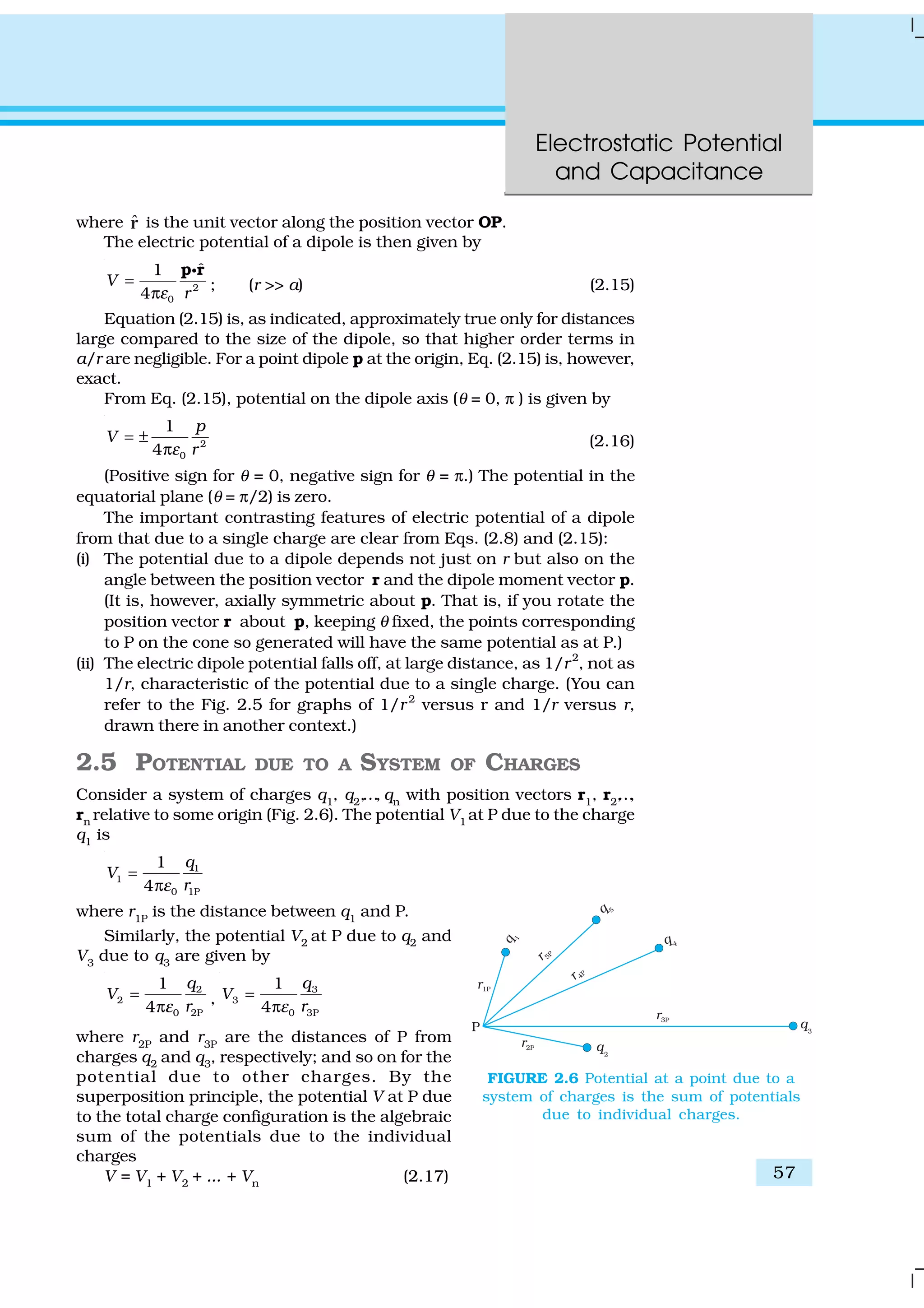
![Physics
58
EXAMPLE2.2
1 2
0 1P 2P P
1
......
4
n
n
qq q
r r rε
= + + + π
(2.18)
If we have a continuous charge distribution characterised by a charge
density ρ (r), we divide it, as before, into small volume elements each of
size ∆v and carrying a charge ρ∆v. We then determine the potential due
to each volume element and sum (strictly speaking , integrate) over all
such contributions, and thus determine the potential due to the entire
distribution.
We have seen in Chapter 1 that for a uniformly charged spherical shell,
the electric field outside the shell is as if the entire charge is concentrated
at the centre. Thus, the potential outside the shell is given by
0
1
4
q
V
rε
=
π ( )r R≥ [2.19(a)]
where q is the total charge on the shell and R its radius. The electric field
inside the shell is zero. This implies (Section 2.6) that potential is constant
inside the shell (as no work is done in moving a charge inside the shell),
and, therefore, equals its value at the surface, which is
0
1
4
q
V
Rε
=
π [2.19(b)]
Example 2.2 Two charges 3 × 10–8
C and –2 × 10–8
C are located
15 cm apart. At what point on the line joining the two charges is the
electric potential zero? Take the potential at infinity to be zero.
Solution Let us take the origin O at the location of the positive charge.
The line joining the two charges is taken to be the x-axis; the negative
charge is taken to be on the right side of the origin (Fig. 2.7).
FIGURE 2.7
Let P be the required point on the x-axis where the potential is zero.
If x is the x-coordinate of P, obviously x must be positive. (There is no
possibility of potentials due to the two charges adding up to zero for
x < 0.) If x lies between O and A, we have
–8 –8
–2 –2
0
1 3 10 2 10
0
10 (15 ) 104 ε
× ×
− =
× − ×π
x x
where x is in cm. That is,
3 2
0
15x x
− =
−
which gives x = 9 cm.
If x lies on the extended line OA, the required condition is
3 2
0
15x x
− =
−](https://image.slidesharecdn.com/ncert-class-12-physics-part-1-161112171109/75/Ncert-class-12-physics-part-1-62-2048.jpg)
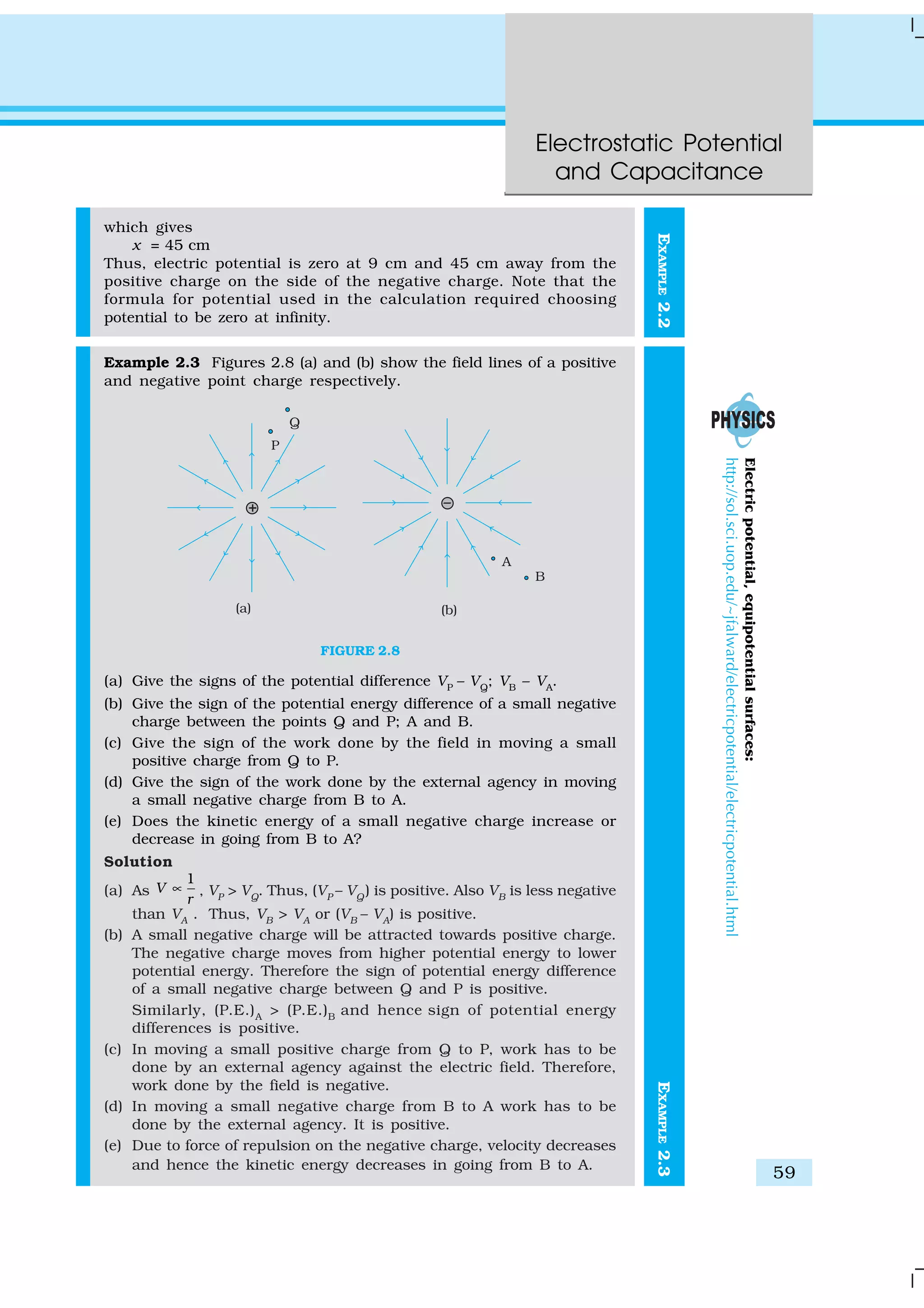
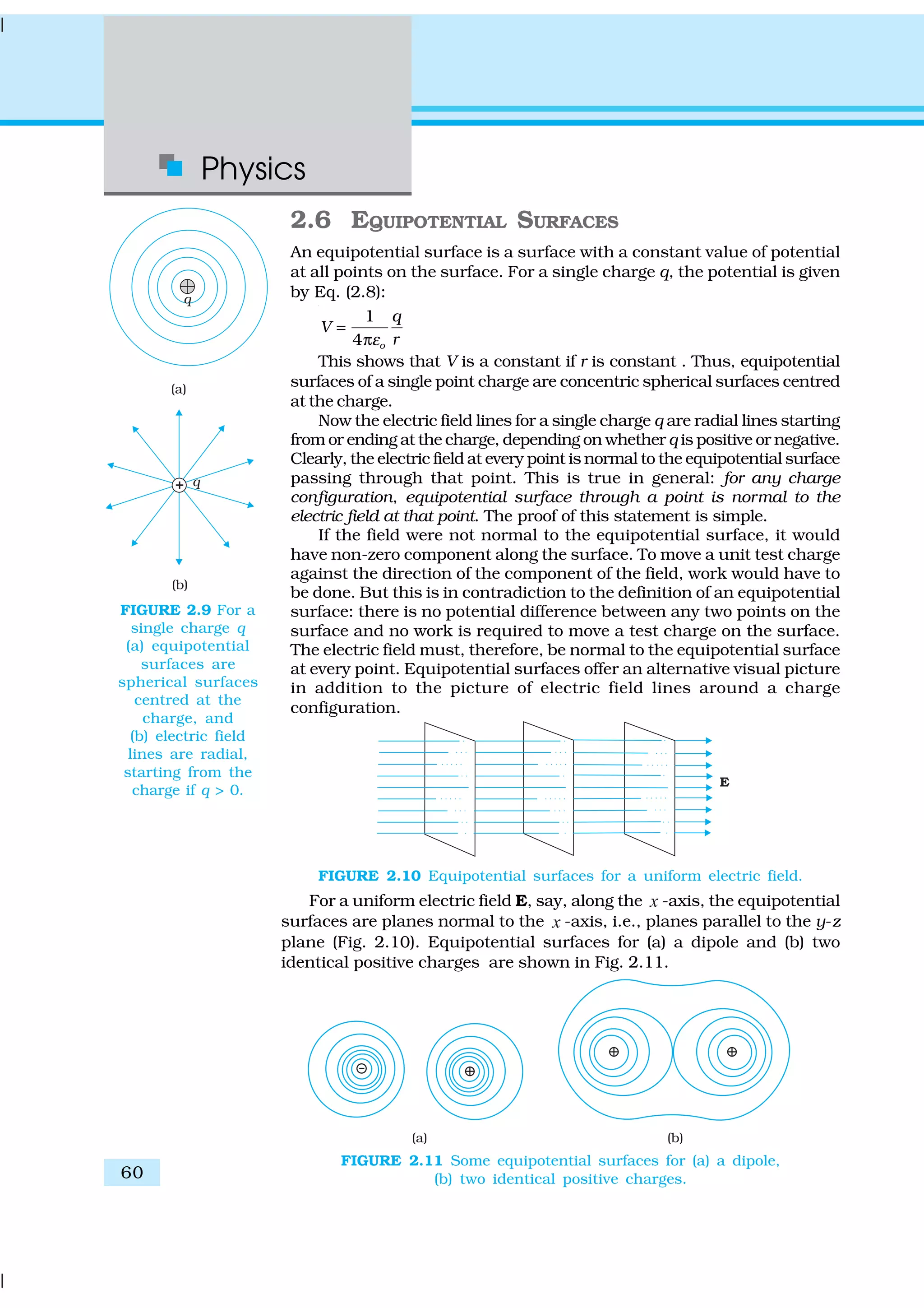

![Physics
62
where r12
is the distance between points 1 and 2.
Since electrostatic force is conservative, this work gets
stored in the form of potential energy of the system. Thus,
the potential energy of a system of two charges q1
and q2
is
1 2
0 12
1
4
q q
U
rε
=
π
(2.22)
Obviously, if q2
was brought first to its present location and
q1
brought later, the potential energy U would be the same.
More generally, the potential energy expression,
Eq. (2.22), is unaltered whatever way the charges are brought to the specified
locations, because of path-independence of work for electrostatic force.
Equation (2.22) is true for any sign of q1and q2. If q1q2 > 0, potential
energy is positive. This is as expected, since for like charges (q1
q2
> 0),
electrostatic force is repulsive and a positive amount of work is needed to
be done against this force to bring the charges from infinity to a finite
distance apart. For unlike charges (q1
q2
< 0), the electrostatic force is
attractive. In that case, a positive amount of work is needed against this
force to take the charges from the given location to infinity. In other words,
a negative amount of work is needed for the reverse path (from infinity to
the present locations), so the potential energy is negative.
Equation (2.22) is easily generalised for a system of any number of
point charges. Let us calculate the potential energy of a system of three
charges q1
, q2
and q3
located at r1
, r2
, r3
, respectively. To bring q1
first
from infinity to r1, no work is required. Next we bring q2 from infinity to
r2
. As before, work done in this step is
1 2
2 1 2
0 12
1
( )
4
q q
q V
rε
=
π
r (2.23)
The charges q1 and q2 produce a potential, which at any point P is
given by
1 2
1,2
0 1P 2P
1
4
q q
V
r rε
= + π
(2.24)
Work done next in bringing q3
from infinity to the point r3
is q3
times
V1, 2 at r3
1 3 2 3
3 1,2 3
0 13 23
1
( )
4
q q q q
q V
r rε
= + π
r (2.25)
The total work done in assembling the charges
at the given locations is obtained by adding the work
done in different steps [Eq. (2.23) and Eq. (2.25)],
1 3 2 31 2
0 12 13 23
1
4
q q q qq q
U
r r rε
= + + π
(2.26)
Again, because of the conservative nature of the
electrostatic force (or equivalently, the path
independence of work done), the final expression for
U, Eq. (2.26), is independent of the manner in which
the configuration is assembled. The potential energy
FIGURE 2.13 Potential energy of a
system of charges q1
and q2
is
directly proportional to the product
of charges and inversely to the
distance between them.
FIGURE 2.14 Potential energy of a
system of three charges is given by
Eq. (2.26), with the notation given
in the figure.](https://image.slidesharecdn.com/ncert-class-12-physics-part-1-161112171109/75/Ncert-class-12-physics-part-1-66-2048.jpg)
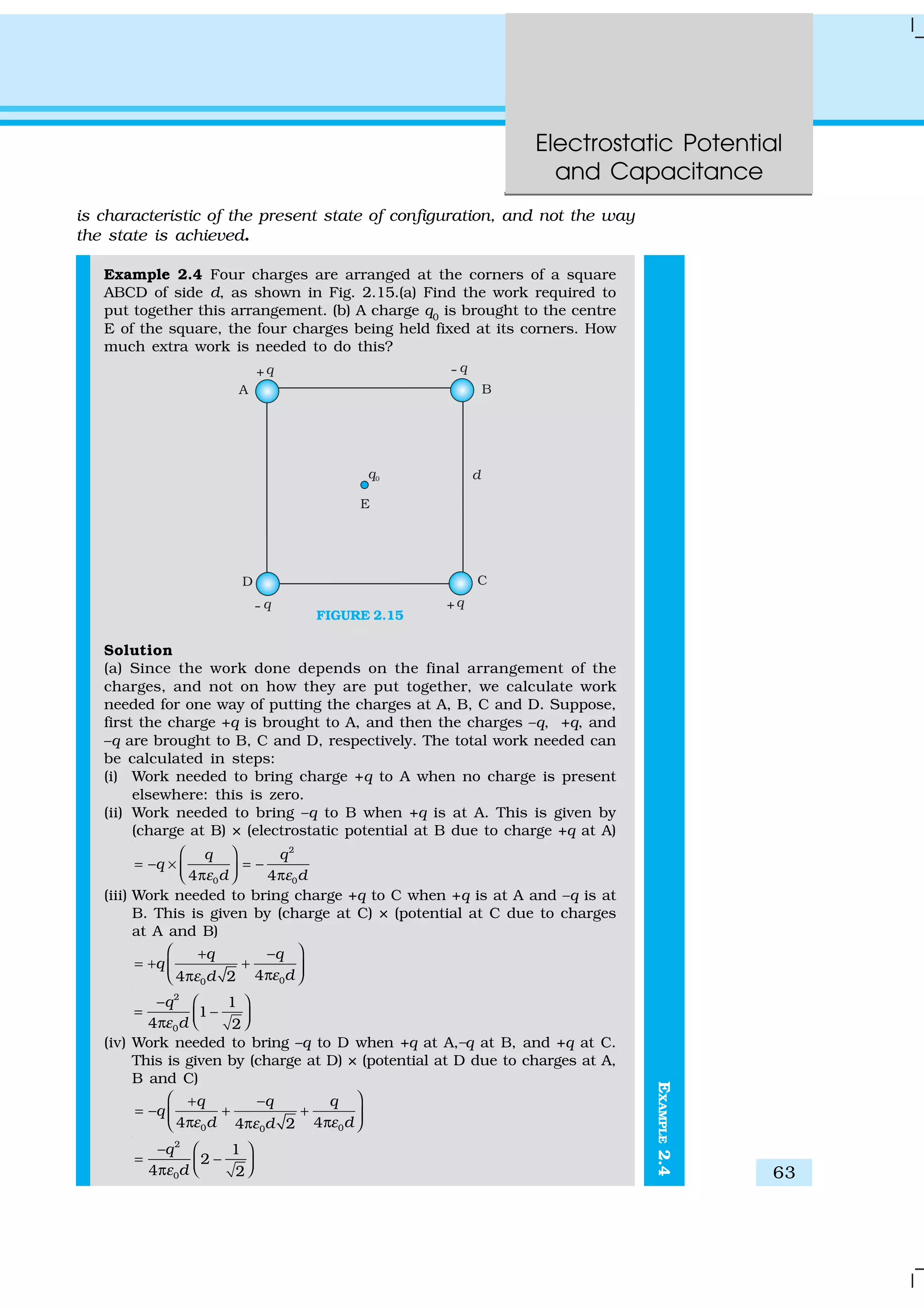
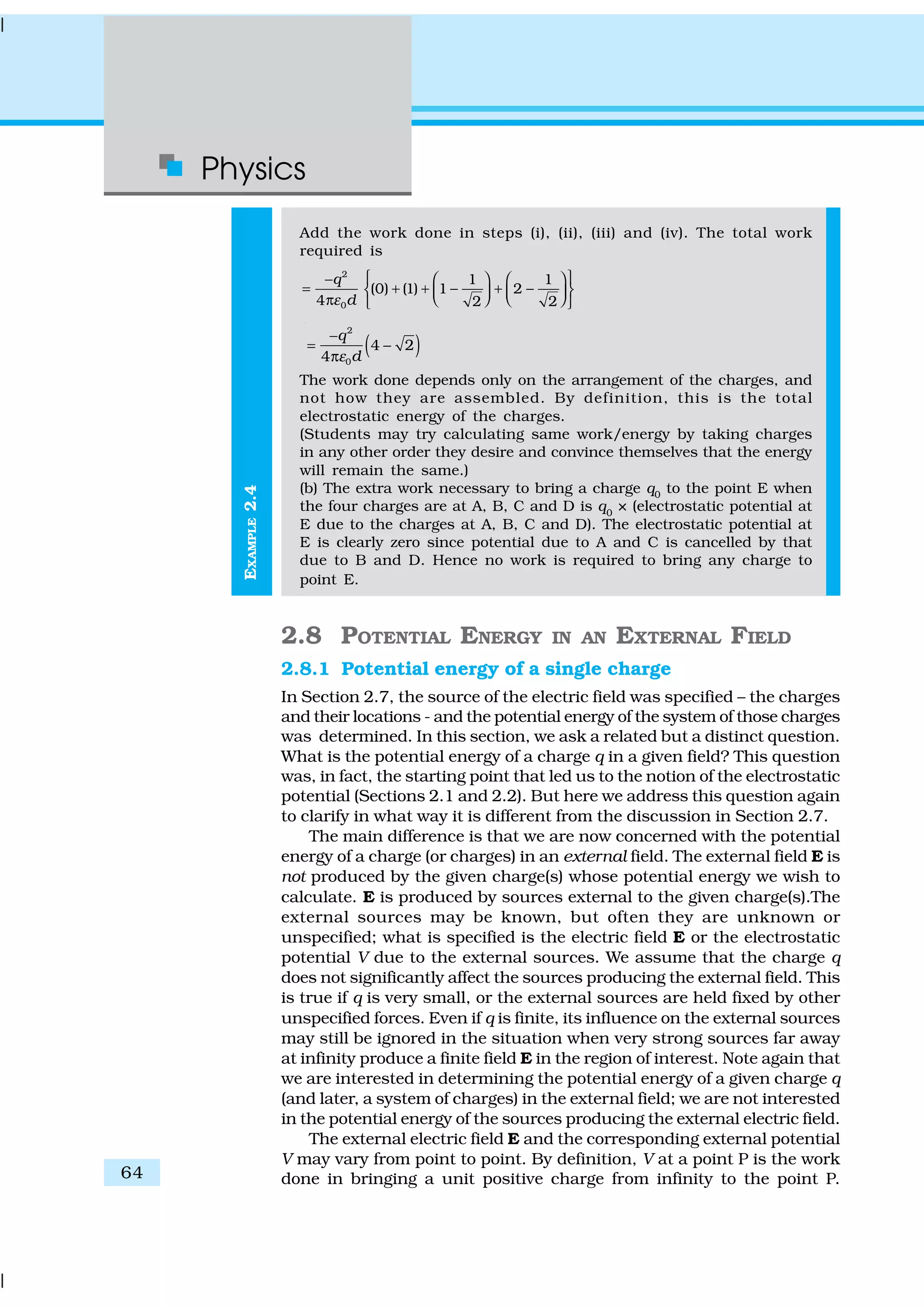
![Electrostatic Potential
and Capacitance
65
EXAMPLE2.5
(We continue to take potential at infinity to be zero.) Thus, work done in
bringing a charge q from infinity to the point P in the external field is qV.
This work is stored in the form of potential energy of q. If the point P has
position vector r relative to some origin, we can write:
Potential energy of q at r in an external field
= qV(r) (2.27)
where V(r) is the external potential at the point r.
Thus, if an electron with charge q = e = 1.6×10–19
C is accelerated by
a potential difference of ∆V = 1 volt, it would gain energy of q∆V = 1.6 ×
10–19
J. This unit of energy is defined as 1 electron volt or 1eV, i.e.,
1 eV=1.6 × 10–19
J. The units based on eV are most commonly used in
atomic, nuclear and particle physics, (1 keV = 103
eV = 1.6 × 10–16
J, 1 MeV
= 106
eV = 1.6 × 10–13
J, 1 GeV = 109
eV = 1.6 × 10–10
J and 1 TeV = 1012
eV
= 1.6 × 10–7
J). [This has already been defined on Page 117, XI Physics
Part I, Table 6.1.]
2.8.2 Potential energy of a system of two charges in an
external field
Next, we ask: what is the potential energy of a system of two charges q1
and q2
located at r1
and r2
, respectively, in an external field? First, we
calculate the work done in bringing the charge q1
from infinity to r1
.
Work done in this step is q1 V(r1), using Eq. (2.27). Next, we consider the
work done in bringing q2
to r2
. In this step, work is done not only against
the external field E but also against the field due to q1
.
Work done on q2 against the external field
= q2
V (r2
)
Work done on q2
against the field due to q1
1 2
124 o
q q
rε
=
π
where r12
is the distance between q1
and q2
. We have made use of Eqs.
(2.27) and (2.22). By the superposition principle for fields, we add up
the work done on q2 against the two fields (E and that due to q1):
Work done in bringing q2
to r2
1 2
2 2
12
( )
4 o
q q
q V
rε
= +
π
r (2.28)
Thus,
Potential energy of the system
= the total work done in assembling the configuration
1 2
1 1 2 2
0 12
( ) ( )
4
q q
q V q V
rε
= + +
π
r r (2.29)
Example 2.5
(a) Determine the electrostatic potential energy of a system consisting
of two charges 7 µC and –2 µC (and with no external field) placed
at (–9 cm, 0, 0) and (9 cm, 0, 0) respectively.
(b) How much work is required to separate the two charges infinitely
away from each other?](https://image.slidesharecdn.com/ncert-class-12-physics-part-1-161112171109/75/Ncert-class-12-physics-part-1-69-2048.jpg)
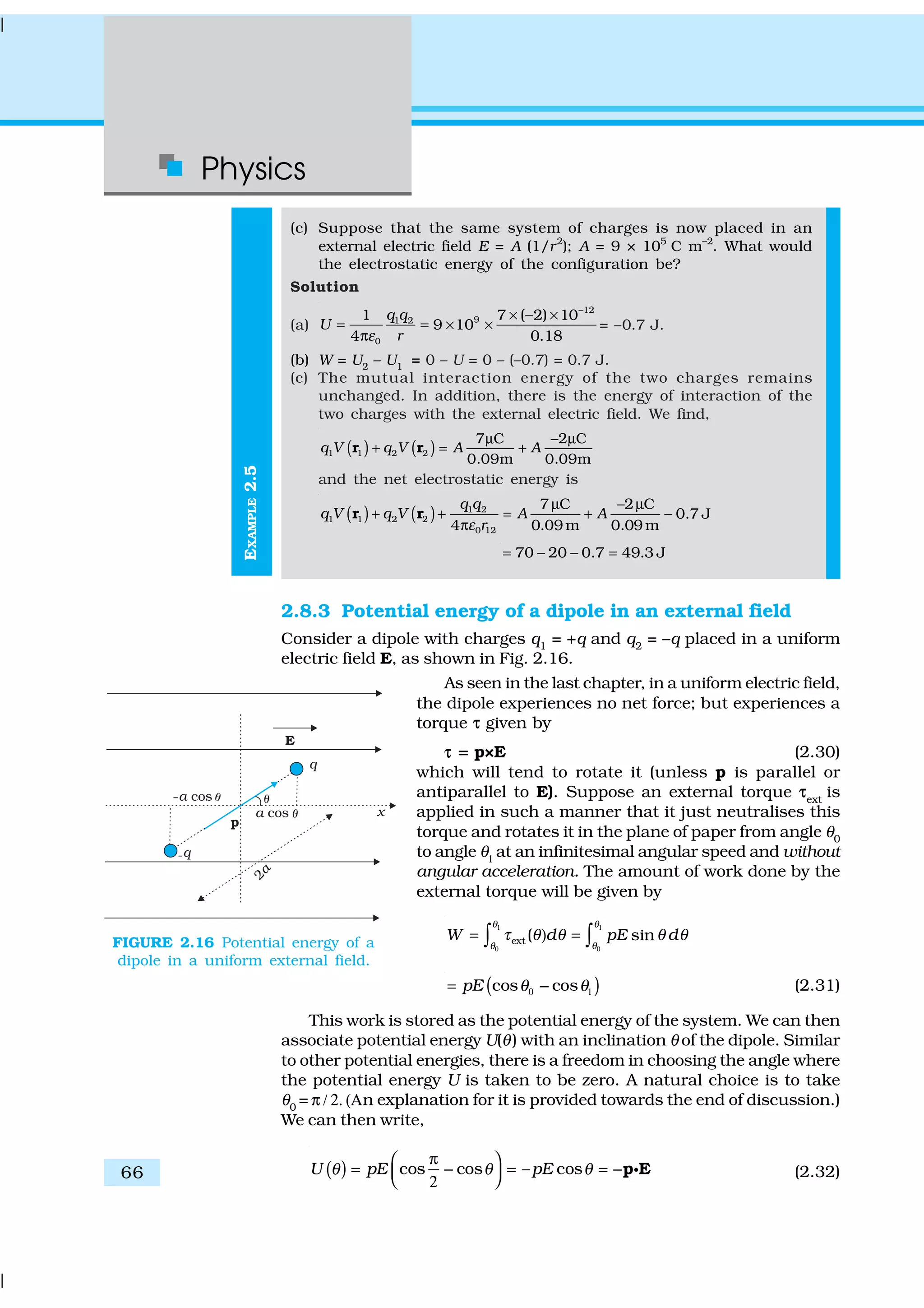
![Electrostatic Potential
and Capacitance
67
EXAMPLE2.6
This expression can alternately be understood also from Eq. (2.29).
We apply Eq. (2.29) to the present system of two charges +q and –q. The
potential energy expression then reads
( ) ( ) ( )
2
1 2[ ]
4 2
q
U q V V
a
θ
ε0
= − −′
π ×
r r (2.33)
Here, r1
and r2
denote the position vectors of +q and –q. Now, the
potential difference between positions r1 and r2 equals the work done
in bringing a unit positive charge against field from r2
to r1
. The
displacement parallel to the force is 2a cosθ. Thus, [V(r1
)–V (r2
)] =
–E × 2a cosθ . We thus obtain,
( )
2 2
cos
4 2 4 2
q q
U pE
a a
θ θ
ε ε0 0
= − − = − −′
π × π ×
p EC (2.34)
We note that U′(θ) differs from U(θ ) by a quantity which is just a constant
for a given dipole. Since a constant is insignificant for potential energy, we
can drop the second term in Eq. (2.34) and it then reduces to Eq. (2.32).
We can now understand why we took θ0
=π/2. In this case, the work
done against the external field E in bringing +q and – q are equal and
opposite and cancel out, i.e., q [V (r1) – V (r2)]=0.
Example 2.6 A molecule of a substance has a permanent electric
dipole moment of magnitude 10–29
C m. A mole of this substance is
polarised (at low temperature) by applying a strong electrostatic field
of magnitude 106
V m–1
. The direction of the field is suddenly changed
by an angle of 60º. Estimate the heat released by the substance in
aligning its dipoles along the new direction of the field. For simplicity,
assume 100% polarisation of the sample.
Solution Here, dipole moment of each molecules = 10–29
C m
As 1 mole of the substance contains 6 × 1023
molecules,
total dipole moment of all the molecules, p = 6 × 1023
× 10–29
C m
= 6 × 10–6
C m
Initial potential energy, Ui
= –pE cos θ = –6×10–6
×106
cos 0° = –6 J
Final potential energy (when θ = 60°), Uf
= –6 × 10–6
× 106
cos 60° = –3 J
Change in potential energy = –3 J – (–6J) = 3 J
So, there is loss in potential energy. This must be the energy released
by the substance in the form of heat in aligning its dipoles.
2.9 ELECTROSTATICS OF CONDUCTORS
Conductors and insulators were described briefly in Chapter 1.
Conductors contain mobile charge carriers. In metallic conductors, these
charge carriers are electrons. In a metal, the outer (valence) electrons
part away from their atoms and are free to move. These electrons are free
within the metal but not free to leave the metal. The free electrons form a
kind of ‘gas’; they collide with each other and with the ions, and move
randomly in different directions. In an external electric field, they drift
against the direction of the field. The positive ions made up of the nuclei
and the bound electrons remain held in their fixed positions. In electrolytic
conductors, the charge carriers are both positive and negative ions; but](https://image.slidesharecdn.com/ncert-class-12-physics-part-1-161112171109/75/Ncert-class-12-physics-part-1-71-2048.jpg)
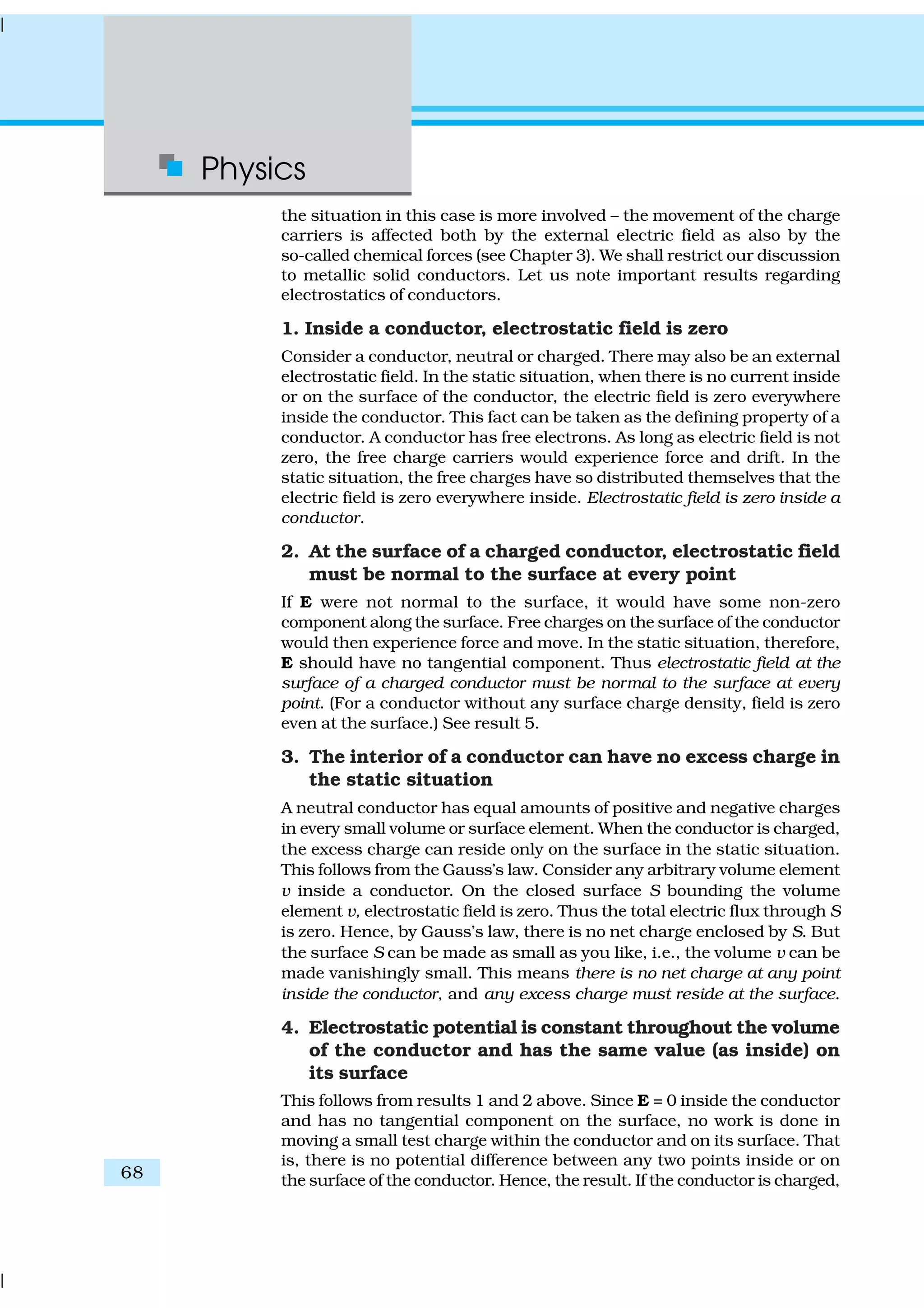
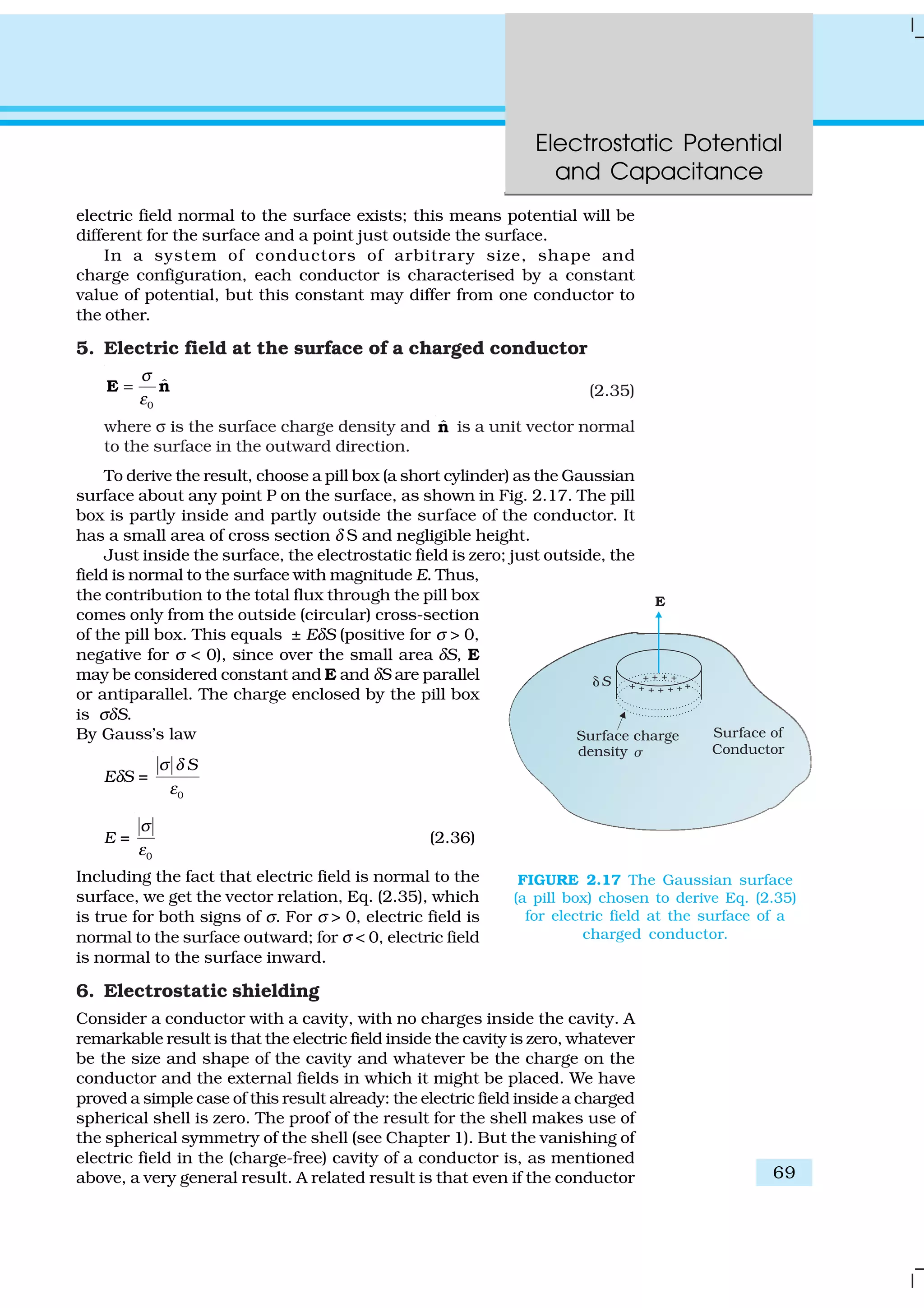
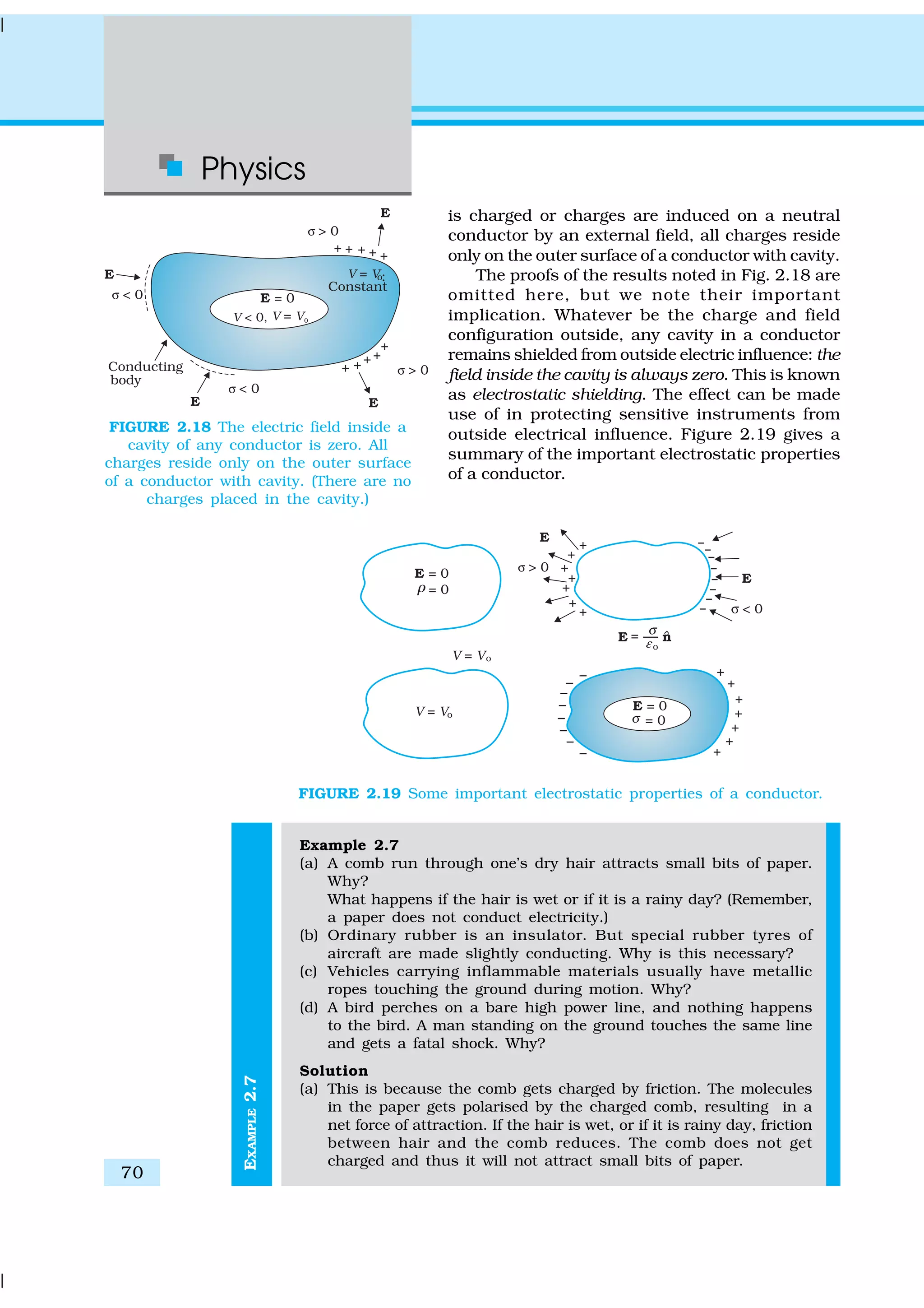


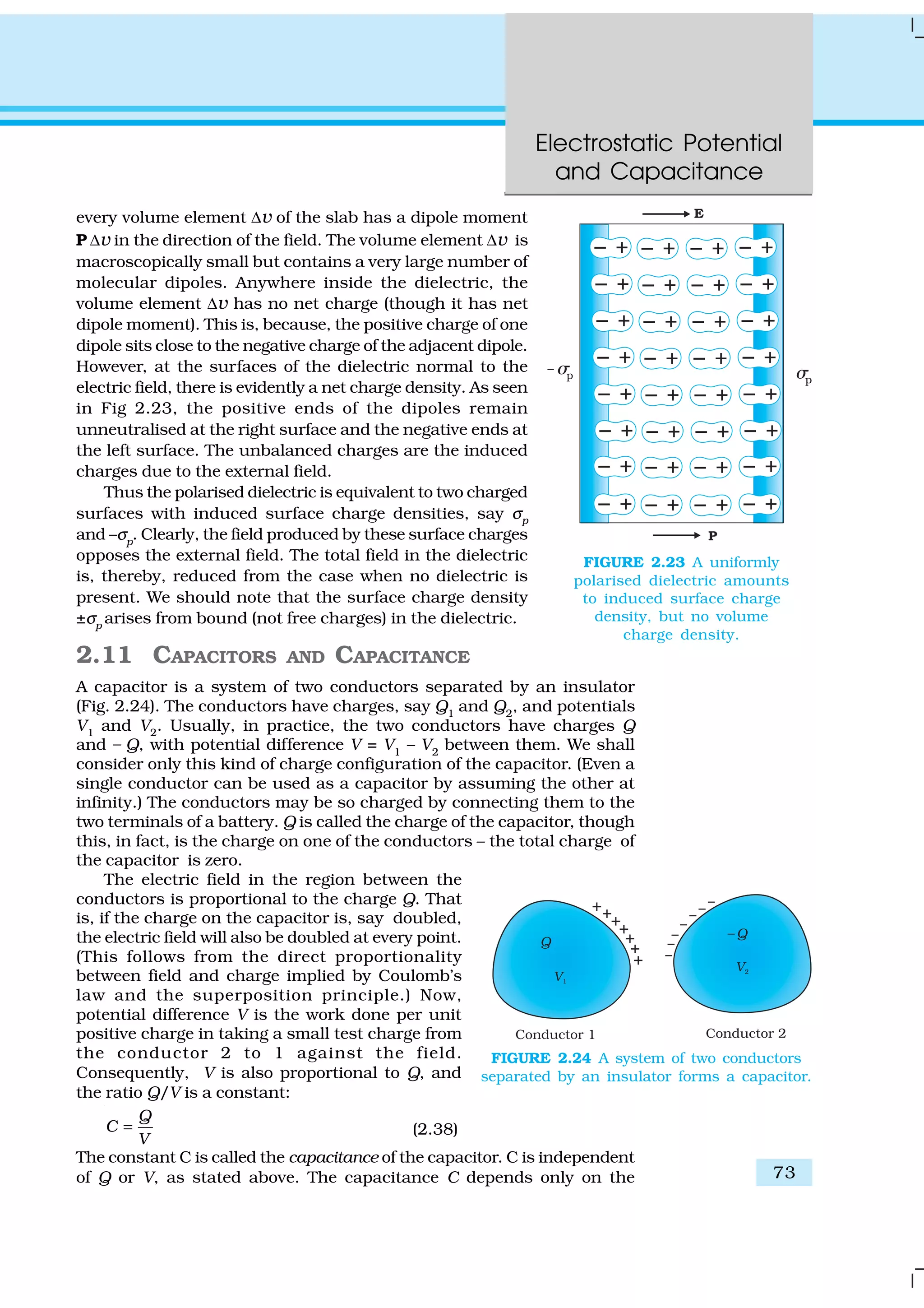
![Physics
74
geometrical configuration (shape, size, separation) of the system of two
conductors. [As we shall see later, it also depends on the nature of the
insulator (dielectric) separating the two conductors.] The SI unit of
capacitance is 1 farad (=1 coulomb volt-1
) or 1 F = 1 C V–1
. A capacitor
with fixed capacitance is symbolically shown as ---||---, while the one with
variable capacitance is shown as .
Equation (2.38) shows that for large C, V is small for a given Q. This
means a capacitor with large capacitance can hold large amount of charge
Q at a relatively small V. This is of practical importance. High potential
difference implies strong electric field around the conductors. A strong
electric field can ionise the surrounding air and accelerate the charges so
produced to the oppositely charged plates, thereby neutralising the charge
on the capacitor plates, at least partly. In other words, the charge of the
capacitor leaks away due to the reduction in insulating power of the
intervening medium.
The maximum electric field that a dielectric medium can withstand
without break-down (of its insulating property) is called its dielectric
strength; for air it is about 3 × 106
Vm–1
. For a separation between
conductors of the order of 1 cm or so, this field corresponds to a potential
difference of 3 × 104
V between the conductors. Thus, for a capacitor to
store a large amount of charge without leaking, its capacitance should
be high enough so that the potential difference and hence the electric
field do not exceed the break-down limits. Put differently, there is a limit
to the amount of charge that can be stored on a given capacitor without
significant leaking. In practice, a farad is a very big unit; the most common
units are its sub-multiples 1 µF = 10–6
F, 1 nF = 10–9
F, 1 pF = 10–12
F,
etc. Besides its use in storing charge, a capacitor is a key element of most
ac circuits with important functions, as described in Chapter 7.
2.12 THE PARALLEL PLATE CAPACITOR
A parallel plate capacitor consists of two large plane parallel conducting
plates separated by a small distance (Fig. 2.25). We first take the
intervening medium between the plates to be
vacuum. The effect of a dielectric medium between
the plates is discussed in the next section. Let A be
the area of each plate and d the separation between
them. The two plates have charges Q and –Q. Since
d is much smaller than the linear dimension of the
plates (d2
<< A), we can use the result on electric
field by an infinite plane sheet of uniform surface
charge density (Section 1.15). Plate 1 has surface
charge density σ = Q/A and plate 2 has a surface
charge density –σ. Using Eq. (1.33), the electric field
in different regions is:
Outer region I (region above the plate 1),
0 0
0
2 2
E
σ σ
ε ε
= − = (2.39)
FIGURE 2.25 The parallel plate capacitor.](https://image.slidesharecdn.com/ncert-class-12-physics-part-1-161112171109/75/Ncert-class-12-physics-part-1-78-2048.jpg)
![Electrostatic Potential
and Capacitance
75
Outer region II (region below the plate 2),
0 0
0
2 2
E
σ σ
ε ε
= − = (2.40)
In the inner region between the plates 1 and 2, the electric fields due
to the two charged plates add up, giving
0 0 0 02 2
Q
E
A
σ σ σ
ε ε ε ε
= + = = (2.41)
The direction of electric field is from the positive to the negative plate.
Thus, the electric field is localised between the two plates and is
uniform throughout. For plates with finite area, this will not be true near
the outer boundaries of the plates. The field lines bend outward at the
edges – an effect called ‘fringing of the field’. By the same token, σ will not
be strictly uniform on the entire plate. [E and σ are related by Eq. (2.35).]
However, for d2
<< A, these effects can be ignored in the regions sufficiently
far from the edges, and the field there is given by Eq. (2.41). Now for
uniform electric field, potential difference is simply the electric field times
the distance between the plates, that is,
0
1 Qd
V E d
Aε
= = (2.42)
The capacitance C of the parallel plate capacitor is then
Q
C
V
= =
0 A
d
ε
= (2.43)
which, as expected, depends only on the geometry of the system. For
typical values like A = 1 m2
, d = 1 mm, we get
12 2 –1 –2 2
9
3
8.85 10 C N m 1m
8.85 10 F
10 m
C
−
−
−
× ×
= = × (2.44)
(You can check that if 1F= 1C V–1
= 1C (NC–1
m)–1
= 1 C2
N–1
m–1
.)
This shows that 1F is too big a unit in practice, as remarked earlier.
Another way of seeing the ‘bigness’ of 1F is to calculate the area of the
plates needed to have C = 1F for a separation of, say 1 cm:
0
Cd
A
ε
= =
2
9 2
12 2 –1 –2
1F 10 m
10 m
8.85 10 C N m
−
−
×
=
×
(2.45)
which is a plate about 30 km in length and breadth!
2.13 EFFECT OF DIELECTRIC ON CAPACITANCE
With the understanding of the behavior of dielectrics in an external field
developed in Section 2.10, let us see how the capacitance of a parallel
plate capacitor is modified when a dielectric is present. As before, we
have two large plates, each of area A, separated by a distance d. The
charge on the plates is ±Q, corresponding to the charge density ±σ (with
σ = Q/A). When there is vacuum between the plates,
0
0
E
σ
ε
=
Factorsaffectingcapacitance,capacitorsinaction
InteractiveJavatutorial
http://micro.magnet.fsa.edu/electromag/java/capacitance/](https://image.slidesharecdn.com/ncert-class-12-physics-part-1-161112171109/75/Ncert-class-12-physics-part-1-79-2048.jpg)
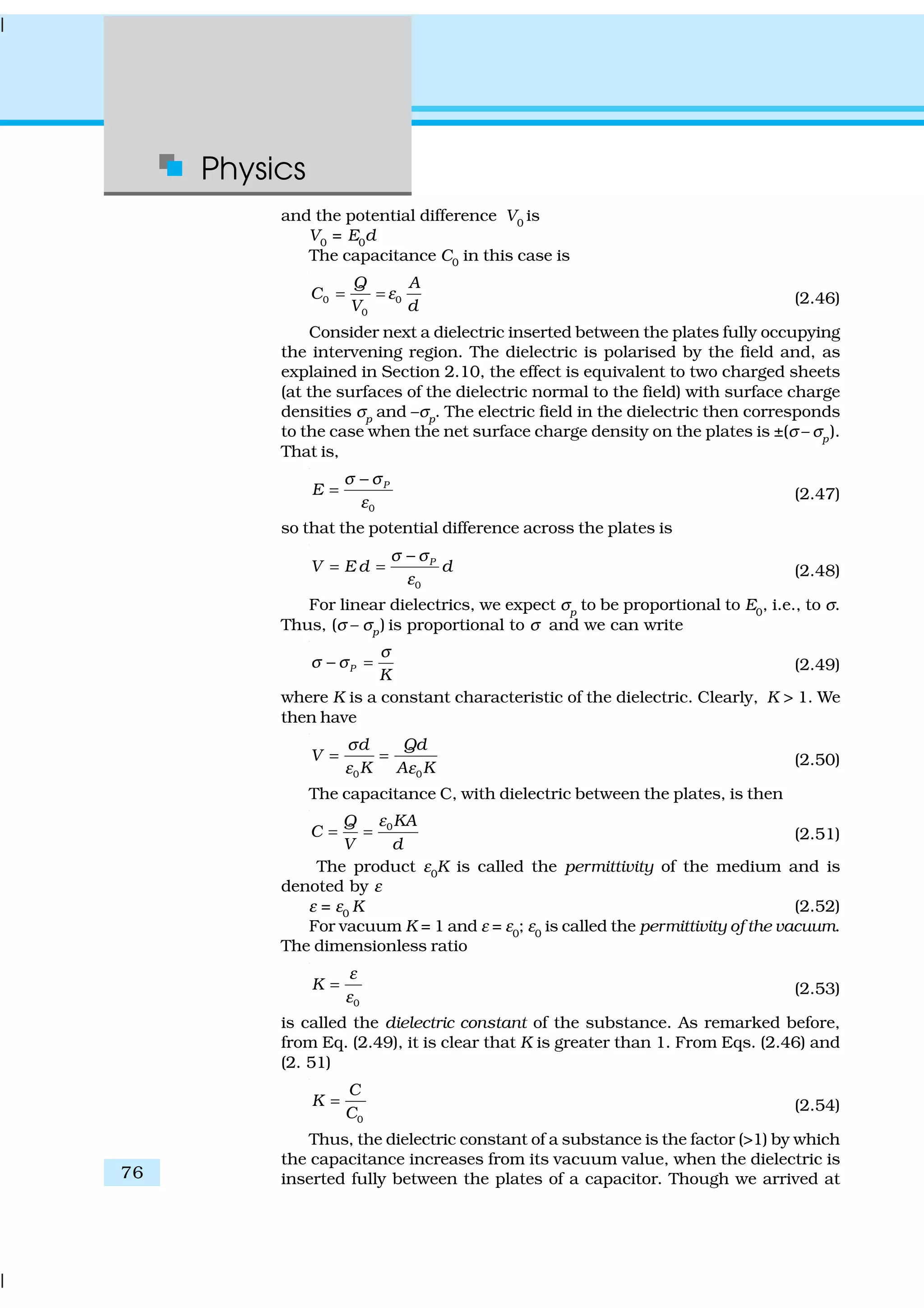
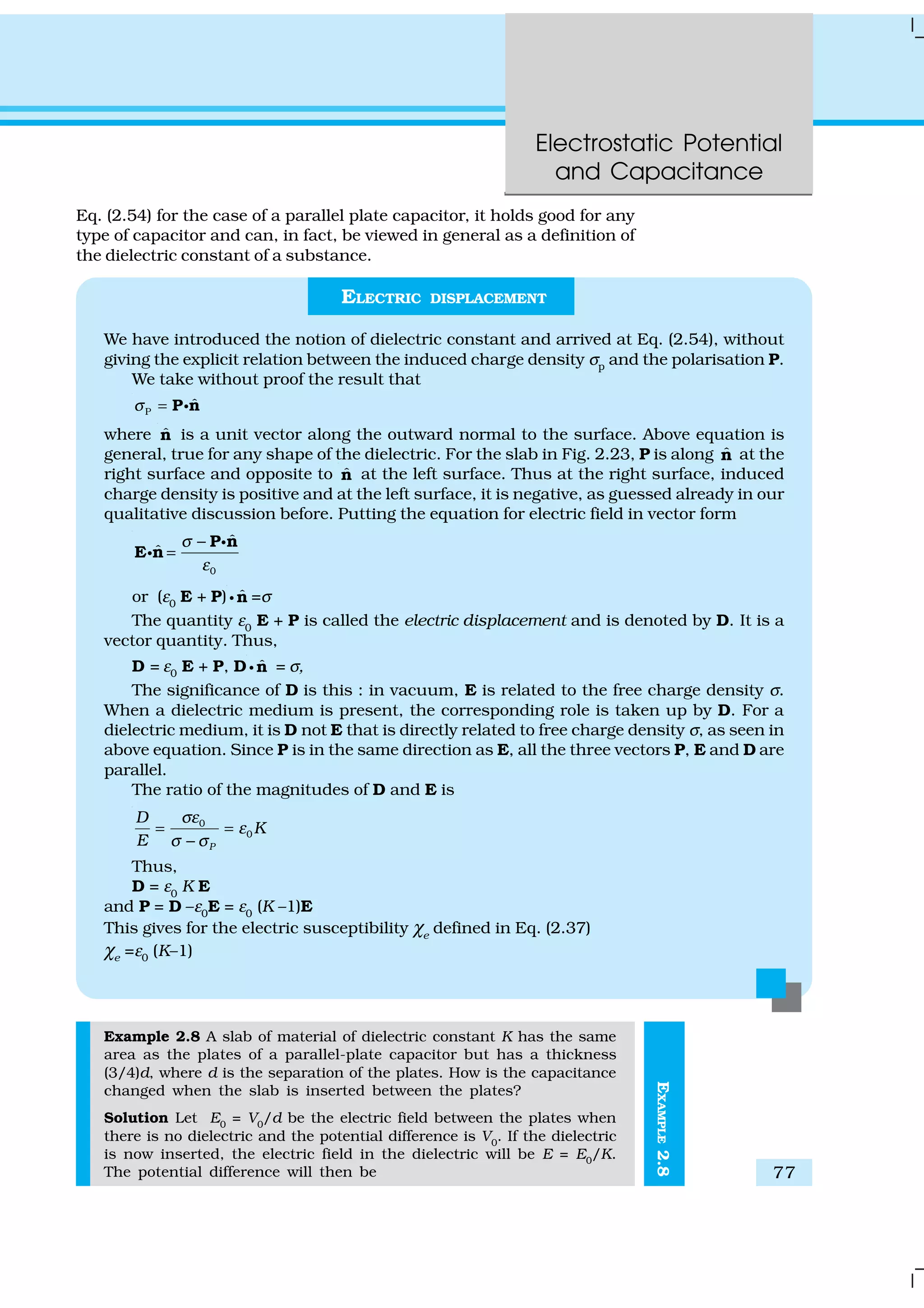
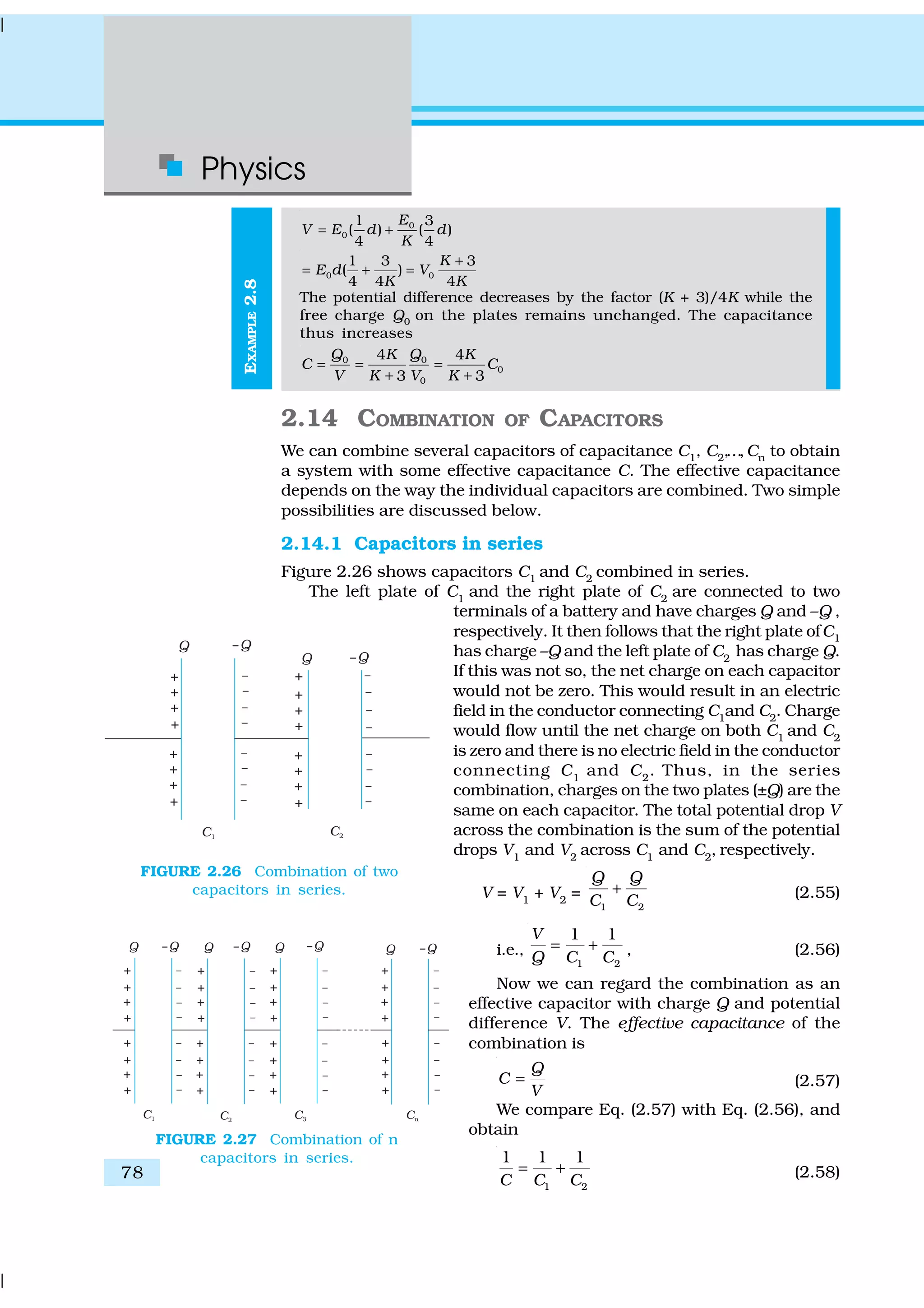
![Electrostatic Potential
and Capacitance
79
EXAMPLE2.9
The proof clearly goes through for any number of
capacitors arranged in a similar way. Equation (2.55),
for n capacitors arranged in series, generalises to
1 2 n
1 2 n
... ...
Q Q Q
V V V V
C C C
= + + + = + + + (2.59)
Following the same steps as for the case of two
capacitors, we get the general formula for effective
capacitance of a series combination of n capacitors:
1 2 3 n
1 1 1 1 1
...
C C C C C
= + + + + (2.60)
2.14.2 Capacitors in parallel
Figure 2.28 (a) shows two capacitors arranged in
parallel. In this case, the same potential difference is
applied across both the capacitors. But the plate charges
(±Q1) on capacitor 1 and the plate charges (±Q2) on the
capacitor 2 are not necessarily the same:
Q1
= C1
V, Q2
= C2
V (2.61)
The equivalent capacitor is one with charge
Q = Q1 + Q2 (2.62)
and potential difference V.
Q = CV = C1
V + C2
V (2.63)
The effective capacitance C is, from Eq. (2.63),
C = C1
+ C2
(2.64)
The general formula for effective capacitance C for
parallel combination of n capacitors [Fig. 2.28 (b)]
follows similarly,
Q = Q1
+ Q2
+ ... + Qn
(2.65)
i.e., CV = C1
V + C2
V + ... Cn
V (2.66)
which gives
C = C1
+ C2
+ ... Cn
(2.67)
Example 2.9 A network of four 10 µF capacitors is connected to a 500 V
supply, as shown in Fig. 2.29. Determine (a) the equivalent capacitance
of the network and (b) the charge on each capacitor. (Note, the charge
on a capacitor is the charge on the plate with higher potential, equal
and opposite to the charge on the plate with lower potential.)
FIGURE 2.28 Parallel combination of
(a) two capacitors, (b) n capacitors.
FIGURE 2.29](https://image.slidesharecdn.com/ncert-class-12-physics-part-1-161112171109/75/Ncert-class-12-physics-part-1-83-2048.jpg)
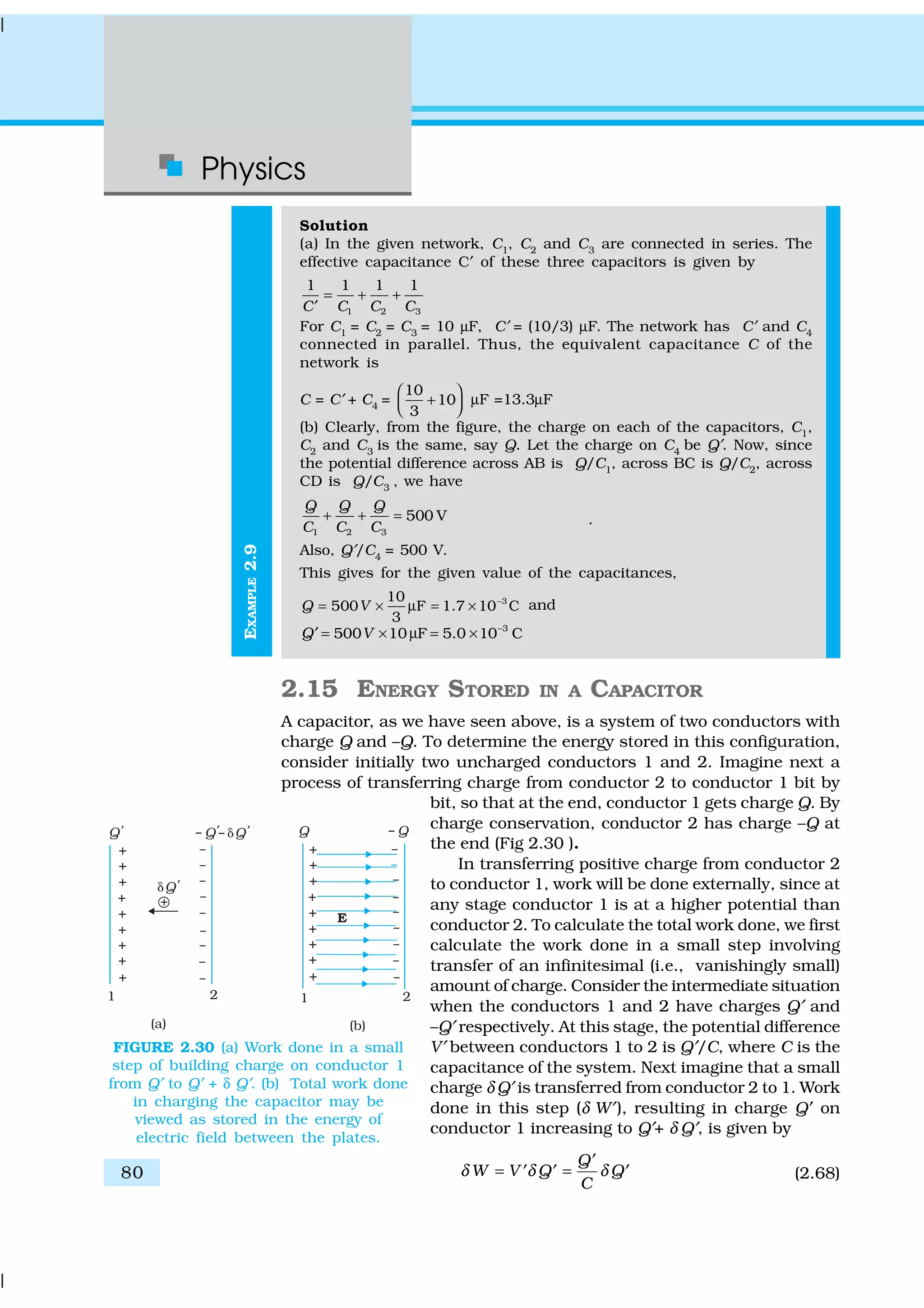
![Electrostatic Potential
and Capacitance
81
Since δQ′ can be made as small as we like, Eq. (2.68) can be written as
2 21
[( ) ]
2
W Q Q Q
C
δ δ= + −′ ′ ′ (2.69)
Equations (2.68) and (2.69) are identical because the term of second
order in δ Q′, i.e., δ Q′ 2
/2C, is negligible, since δ Q′ is arbitrarily small. The
total work done (W) is the sum of the small work (δ W) over the very large
number of steps involved in building the charge Q′ from zero to Q.
sum over all steps
W Wδ= ∑
=
2 2
sum over all steps
1
[( ) ]
2
Q Q Q
C
δ+ −′ ′ ′∑ (2.70)
=
2 2 21
[{ 0} {(2 ) }
2
Q Q Q
C
δ δ δ− + −′ ′ ′ 2 2
{(3 ) (2 ) } ...Q Qδ δ+ − +′ ′
2 2
{ ( ) }]Q Q Qδ+ − − (2.71)
2
21
[ 0]
2 2
Q
Q
C C
= − = (2.72)
The same result can be obtained directly from Eq. (2.68) by integration
2 2
0 0
1
'
2 2
QQ
Q Q Q
W Q
C C C
δ
′ ′
= = =∫
This is not surprising since integration is nothing but summation of
a large number of small terms.
We can write the final result, Eq. (2.72) in different ways
2
21 1
2 2 2
Q
W CV QV
C
= = = (2.73)
Since electrostatic force is conservative, this work is stored in the form
of potential energy of the system. For the same reason, the final result for
potential energy [Eq. (2.73)] is independent of the manner in which the
charge configuration of the capacitor is built up. When the capacitor
discharges, this stored-up energy is released. It is possible to view the
potential energy of the capacitor as ‘stored’ in the electric field between
the plates. To see this, consider for simplicity, a parallel plate capacitor
[of area A(of each plate) and separation d between the plates].
Energy stored in the capacitor
=
2 2
0
1 ( )
2 2
Q A d
C A
σ
ε
= × (2.74)
The surface charge density σ is related to the electric field E between
the plates,
0
E
σ
ε
= (2.75)
From Eqs. (2.74) and (2.75) , we get
Energy stored in the capacitor
U = ( ) 2
01/2 E A dε × (2.76)](https://image.slidesharecdn.com/ncert-class-12-physics-part-1-161112171109/75/Ncert-class-12-physics-part-1-85-2048.jpg)
![Physics
82
EXAMPLE2.10
Note that Ad is the volume of the region between the plates (where
electric field alone exists). If we define energy density as energy stored
per unit volume of space, Eq (2.76) shows that
Energy density of electric field,
u =(1/2)ε0E2
(2.77)
Though we derived Eq. (2.77) for the case of a parallel plate capacitor,
the result on energy density of an electric field is, in fact, very general and
holds true for electric field due to any configuration of charges.
Example 2.10 (a) A 900 pF capacitor is charged by 100 V battery
[Fig. 2.31(a)]. How much electrostatic energy is stored by the capacitor?
(b) The capacitor is disconnected from the battery and connected to
another 900 pF capacitor [Fig. 2.31(b)]. What is the electrostatic energy
stored by the system?
FIGURE 2.31
Solution
(a) The charge on the capacitor is
Q = CV = 900 × 10–12
F × 100 V = 9 × 10–8
C
The energy stored by the capacitor is
= (1/2) CV2
= (1/2) QV
= (1/2) × 9 × 10–8
C × 100 V = 4.5 × 10–6
J
(b) In the steady situation, the two capacitors have their positive
plates at the same potential, and their negative plates at the
same potential. Let the common potential difference be V′. The
charge on each capacitor is then Q′ = CV′. By charge conservation,
Q′ = Q/2. This implies V′ = V/2. The total energy of the system is
61 1
2 ' ' 2.25 10 J
2 4
Q V QV −
= × = = ×
Thus in going from (a) to (b), though no charge is lost; the final
energy is only half the initial energy. Where has the remaining
energy gone?
There is a transient period before the system settles to the
situation (b). During this period, a transient current flows from
the first capacitor to the second. Energy is lost during this time
in the form of heat and electromagnetic radiation.](https://image.slidesharecdn.com/ncert-class-12-physics-part-1-161112171109/75/Ncert-class-12-physics-part-1-86-2048.jpg)
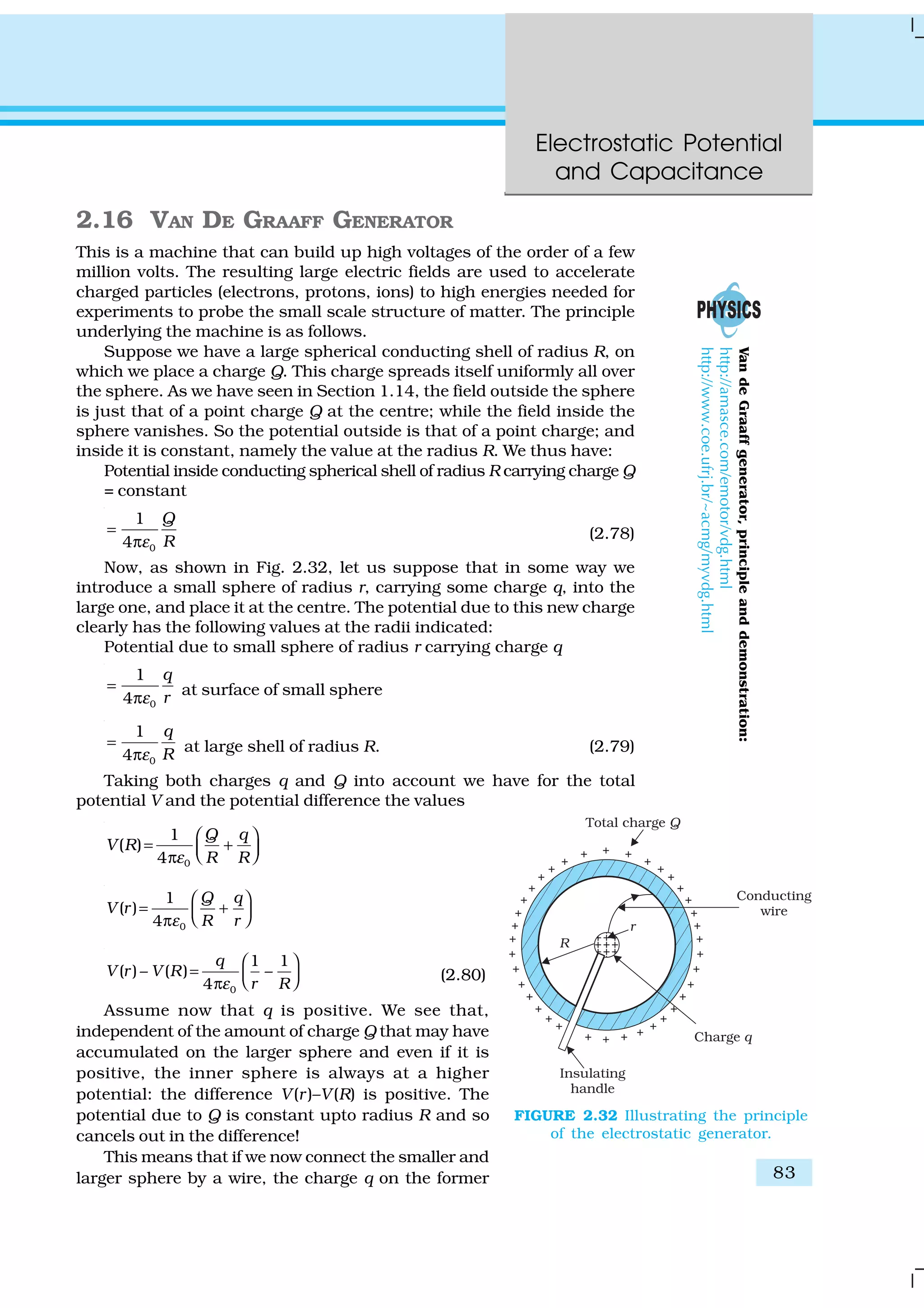
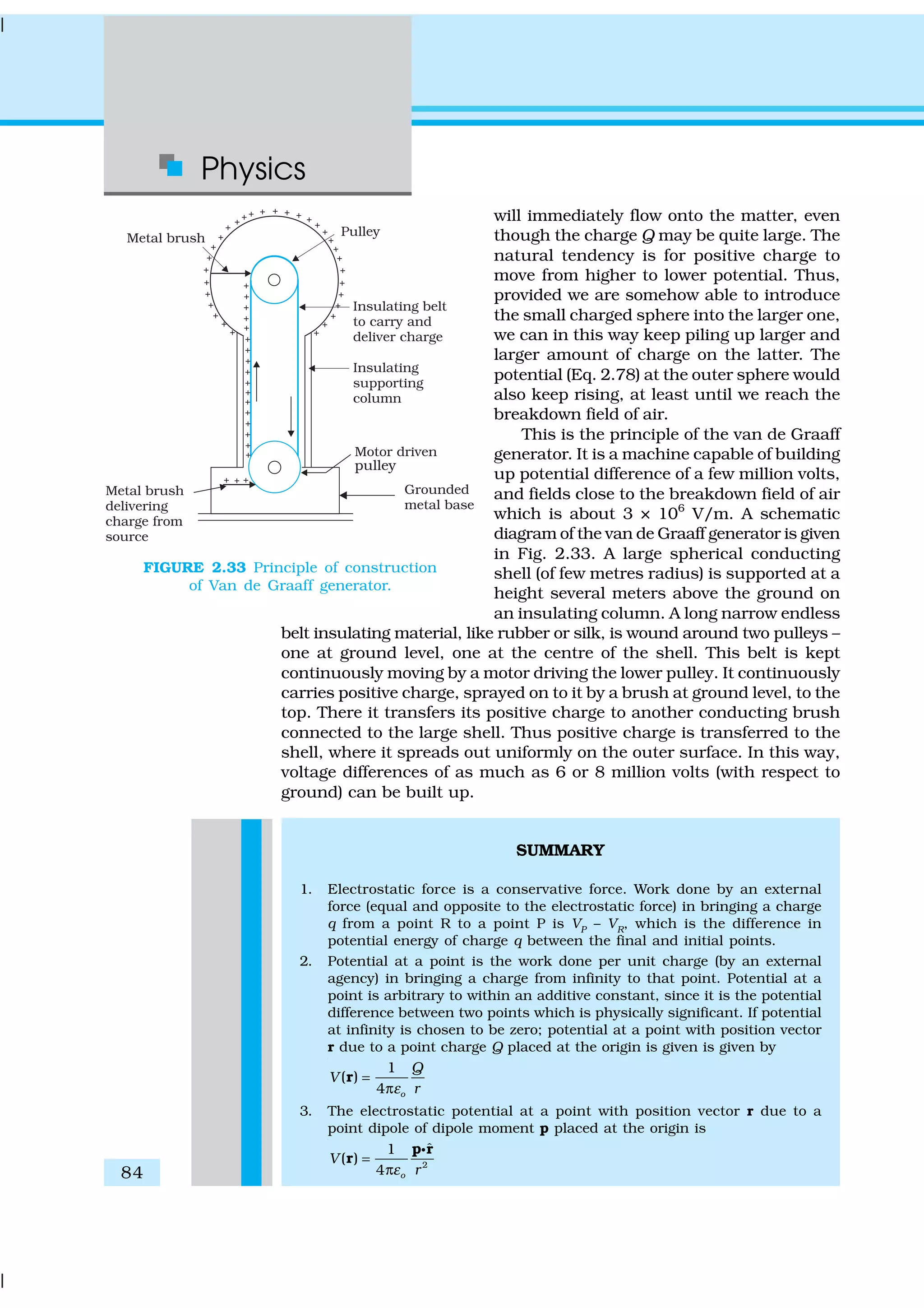
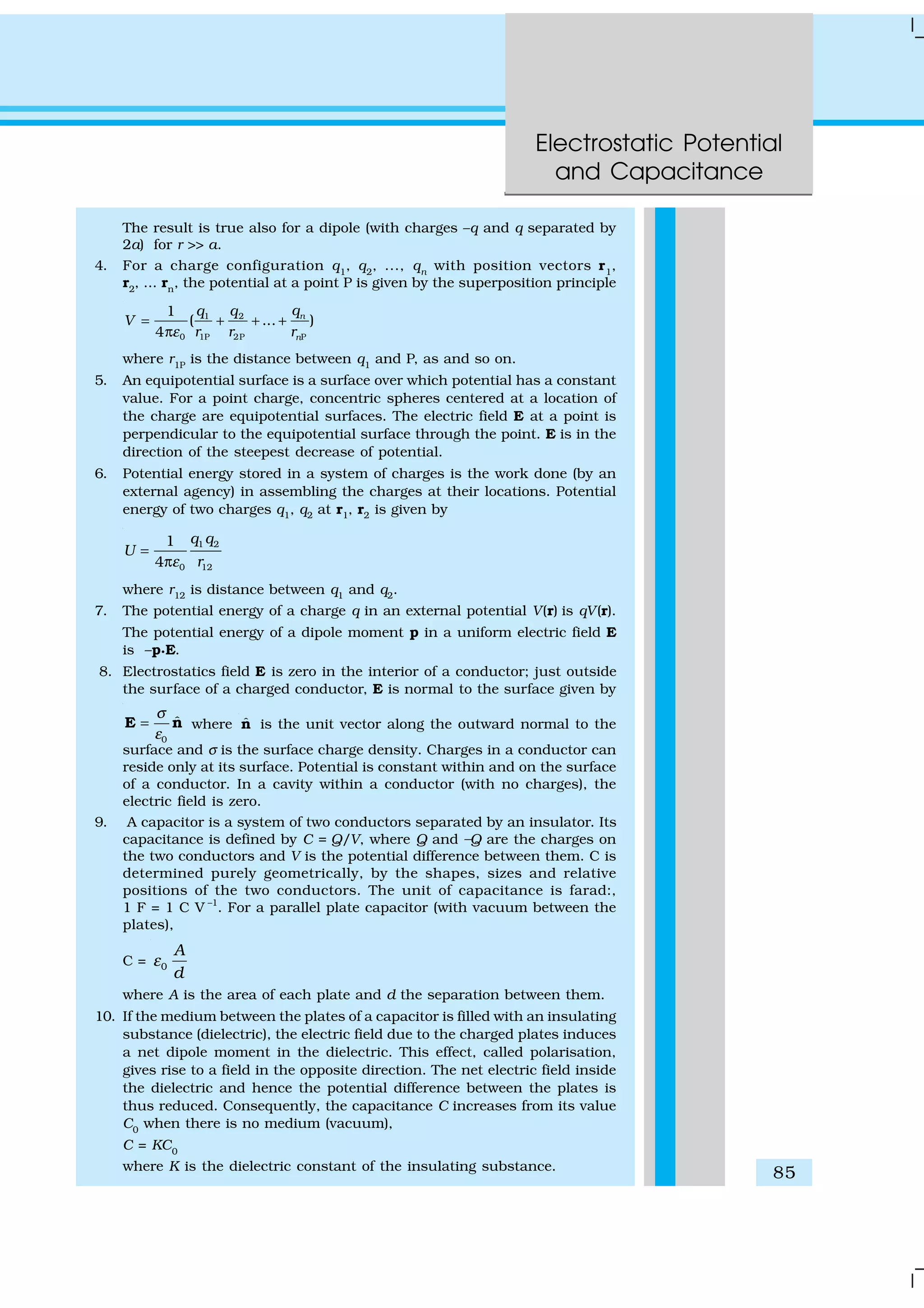
![Physics
86
11. For capacitors in the series combination, the total capacitance C is given by
1 2 3
1 1 1 1
...
C C C C
= + + +
In the parallel combination, the total capacitance C is:
C = C1
+ C2
+ C3
+ ...
where C1
, C2
, C3
... are individual capacitances.
12. The energy U stored in a capacitor of capacitance C, with charge Q and
voltage V is
2
21 1 1
2 2 2
Q
U QV CV
C
= = =
The electric energy density (energy per unit volume) in a region with
electric field is (1/2)ε0
E2
.
13. A Van de Graaff generator consists of a large spherical conducting shell
(a few metre in diameter). By means of a moving belt and suitable brushes,
charge is continuously transferred to the shell and potential difference
of the order of several million volts is built up, which can be used for
accelerating charged particles.
Physical quantity Symbol Dimensions Unit Remark
Potential φ or V [M1
L2
T–3
A–1
] V Potential difference is
physically significant
Capacitance C [M–1
L–2
T–4
A2
] F
Polarisation P [L–2
AT] C m-2
Dipole moment per unit
volume
Dielectric constant K [Dimensionless]
POINTS TO PONDER
1. Electrostatics deals with forces between charges at rest. But if there is a
force on a charge, how can it be at rest? Thus, when we are talking of
electrostatic force between charges, it should be understood that each
charge is being kept at rest by some unspecified force that opposes the
net Coulomb force on the charge.
2. A capacitor is so configured that it confines the electric field lines within
a small region of space. Thus, even though field may have considerable
strength, the potential difference between the two conductors of a
capacitor is small.
3. Electric field is discontinuous across the surface of a spherical charged
shell. It is zero inside and 0
ˆσ
ε n outside. Electric potential is, however
continuous across the surface, equal to q/4πε0R at the surface.
4. The torque p × E on a dipole causes it to oscillate about E. Only if there
is a dissipative mechanism, the oscillations are damped and the dipole
eventually aligns with E.](https://image.slidesharecdn.com/ncert-class-12-physics-part-1-161112171109/75/Ncert-class-12-physics-part-1-90-2048.jpg)
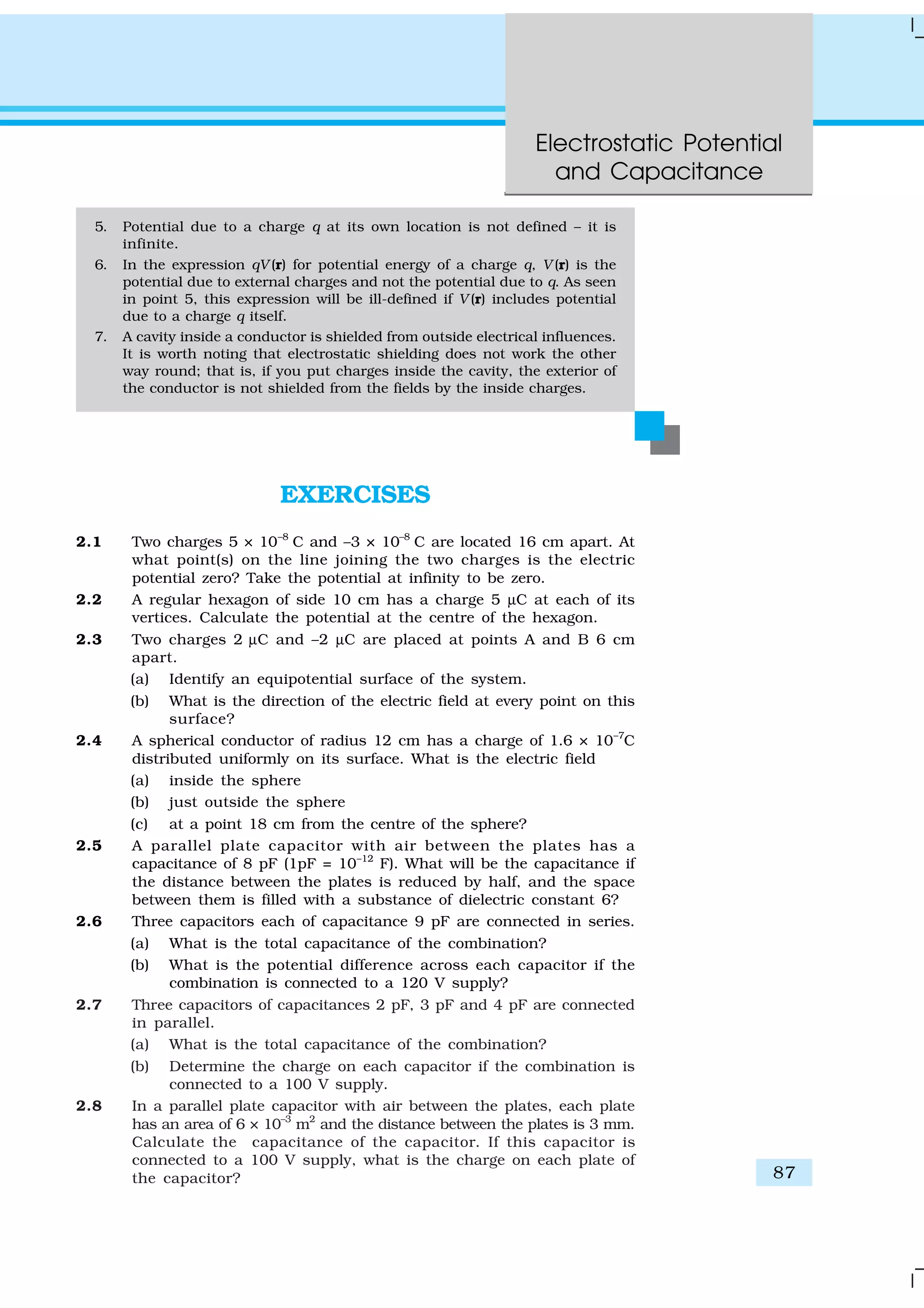
![Physics
88
2.9 Explain what would happen if in the capacitor given in Exercise
2.8, a 3 mm thick mica sheet (of dielectric constant = 6) were inserted
between the plates,
(a) while the voltage supply remained connected.
(b) after the supply was disconnected.
2.10 A 12pF capacitor is connected to a 50V battery. How much
electrostatic energy is stored in the capacitor?
2.11 A 600pF capacitor is charged by a 200V supply. It is then
disconnected from the supply and is connected to another
uncharged 600 pF capacitor. How much electrostatic energy is lost
in the process?
ADDITIONAL EXERCISES
2.12 A charge of 8 mC is located at the origin. Calculate the work done in
taking a small charge of –2 × 10–9
C from a point P (0, 0, 3 cm) to a
point Q (0, 4 cm, 0), via a point R (0, 6 cm, 9 cm).
2.13 A cube of side b has a charge q at each of its vertices. Determine the
potential and electric field due to this charge array at the centre of
the cube.
2.14 Two tiny spheres carrying charges 1.5 µC and 2.5 µC are located 30 cm
apart. Find the potential and electric field:
(a) at the mid-point of the line joining the two charges, and
(b) at a point 10 cm from this midpoint in a plane normal to the
line and passing through the mid-point.
2.15 A spherical conducting shell of inner radius r1
and outer radius r2
has a charge Q.
(a) A charge q is placed at the centre of the shell. What is the
surface charge density on the inner and outer surfaces of the
shell?
(b) Is the electric field inside a cavity (with no charge) zero, even if
the shell is not spherical, but has any irregular shape? Explain.
2.16 (a) Show that the normal component of electrostatic field has a
discontinuity from one side of a charged surface to another
given by
2 1
0
ˆ( )
σ
ε
− =E E nC
where ˆn is a unit vector normal to the surface at a point and
σ is the surface charge density at that point. (The direction of
ˆn is from side 1 to side 2.) Hence show that just outside a
conductor, the electric field is σ ˆn /ε0
.
(b) Show that the tangential component of electrostatic field is
continuous from one side of a charged surface to another. [Hint:
For (a), use Gauss’s law. For, (b) use the fact that work done by
electrostatic field on a closed loop is zero.]
2.17 A long charged cylinder of linear charged density λ is surrounded
by a hollow co-axial conducting cylinder. What is the electric field in
the space between the two cylinders?
2.18 In a hydrogen atom, the electron and proton are bound at a distance
of about 0.53 Å:](https://image.slidesharecdn.com/ncert-class-12-physics-part-1-161112171109/75/Ncert-class-12-physics-part-1-92-2048.jpg)
![Electrostatic Potential
and Capacitance
89
(a) Estimate the potential energy of the system in eV, taking the
zero of the potential energy at infinite separation of the electron
from proton.
(b) What is the minimum work required to free the electron, given
that its kinetic energy in the orbit is half the magnitude of
potential energy obtained in (a)?
(c) What are the answers to (a) and (b) above if the zero of potential
energy is taken at 1.06 Å separation?
2.19 If one of the two electrons of a H2
molecule is removed, we get a
hydrogen molecular ion H+
2
. In the ground state of an H+
2
, the two
protons are separated by roughly 1.5 Å, and the electron is roughly
1 Å from each proton. Determine the potential energy of the system.
Specify your choice of the zero of potential energy.
2.20 Two charged conducting spheres of radii a and b are connected to
each other by a wire. What is the ratio of electric fields at the surfaces
of the two spheres? Use the result obtained to explain why charge
density on the sharp and pointed ends of a conductor is higher
than on its flatter portions.
2.21 Two charges –q and +q are located at points (0, 0, –a) and (0, 0, a),
respectively.
(a) What is the electrostatic potential at the points (0, 0, z) and
(x, y, 0) ?
(b) Obtain the dependence of potential on the distance r of a point
from the origin when r/a >> 1.
(c) How much work is done in moving a small test charge from the
point (5,0,0) to (–7,0,0) along the x-axis? Does the answer
change if the path of the test charge between the same points
is not along the x-axis?
2.22 Figure 2.34 shows a charge array known as an electric quadrupole.
For a point on the axis of the quadrupole, obtain the dependence
of potential on r for r/a >> 1, and contrast your results with that
due to an electric dipole, and an electric monopole (i.e., a single
charge).
FIGURE 2.34
2.23 An electrical technician requires a capacitance of 2 µF in a circuit
across a potential difference of 1 kV. A large number of 1 µF capacitors
are available to him each of which can withstand a potential
difference of not more than 400 V. Suggest a possible arrangement
that requires the minimum number of capacitors.
2.24 What is the area of the plates of a 2 F parallel plate capacitor, given
that the separation between the plates is 0.5 cm? [You will realise
from your answer why ordinary capacitors are in the range of µF or
less. However, electrolytic capacitors do have a much larger
capacitance (0.1 F) because of very minute separation between the
conductors.]](https://image.slidesharecdn.com/ncert-class-12-physics-part-1-161112171109/75/Ncert-class-12-physics-part-1-93-2048.jpg)
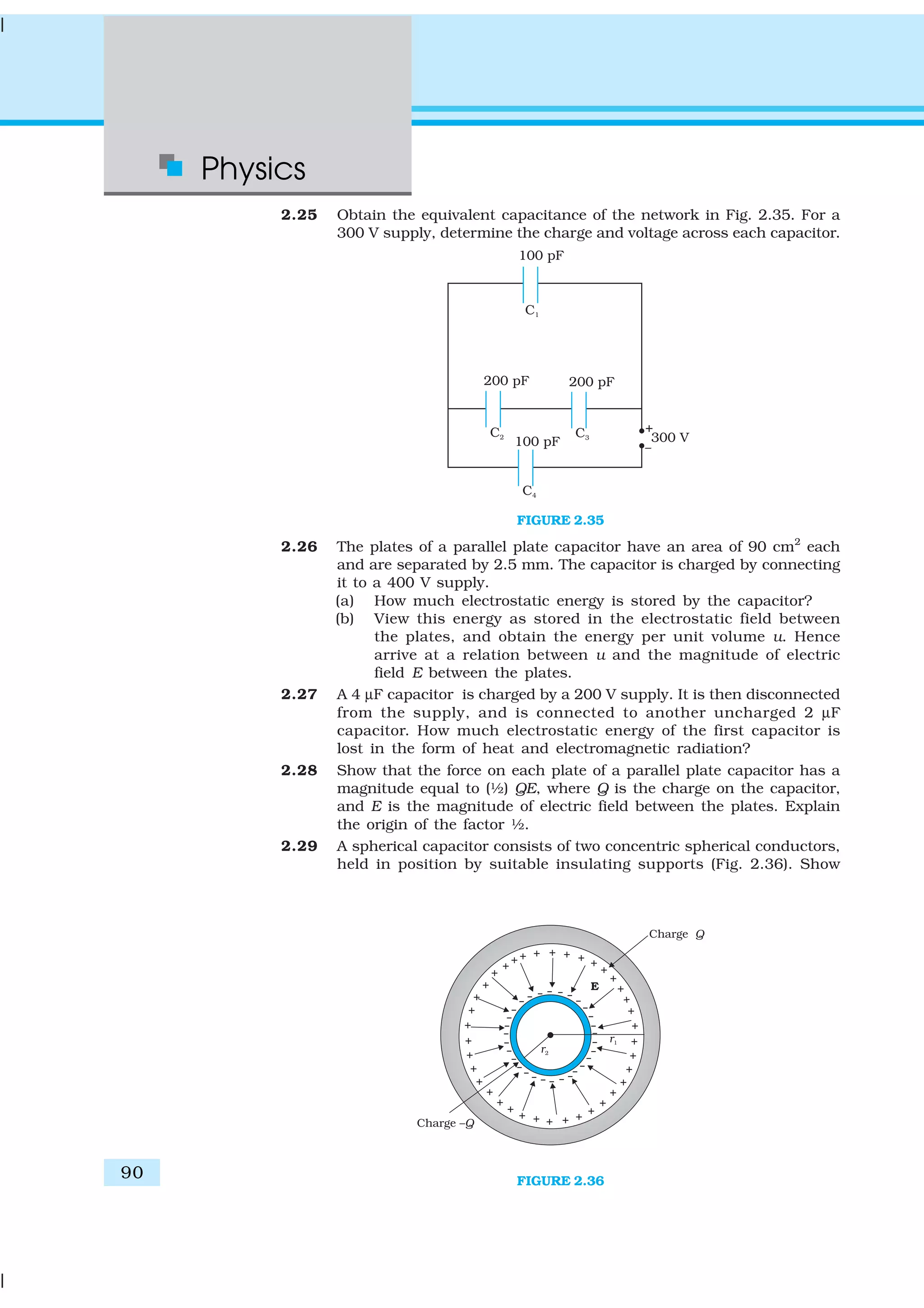
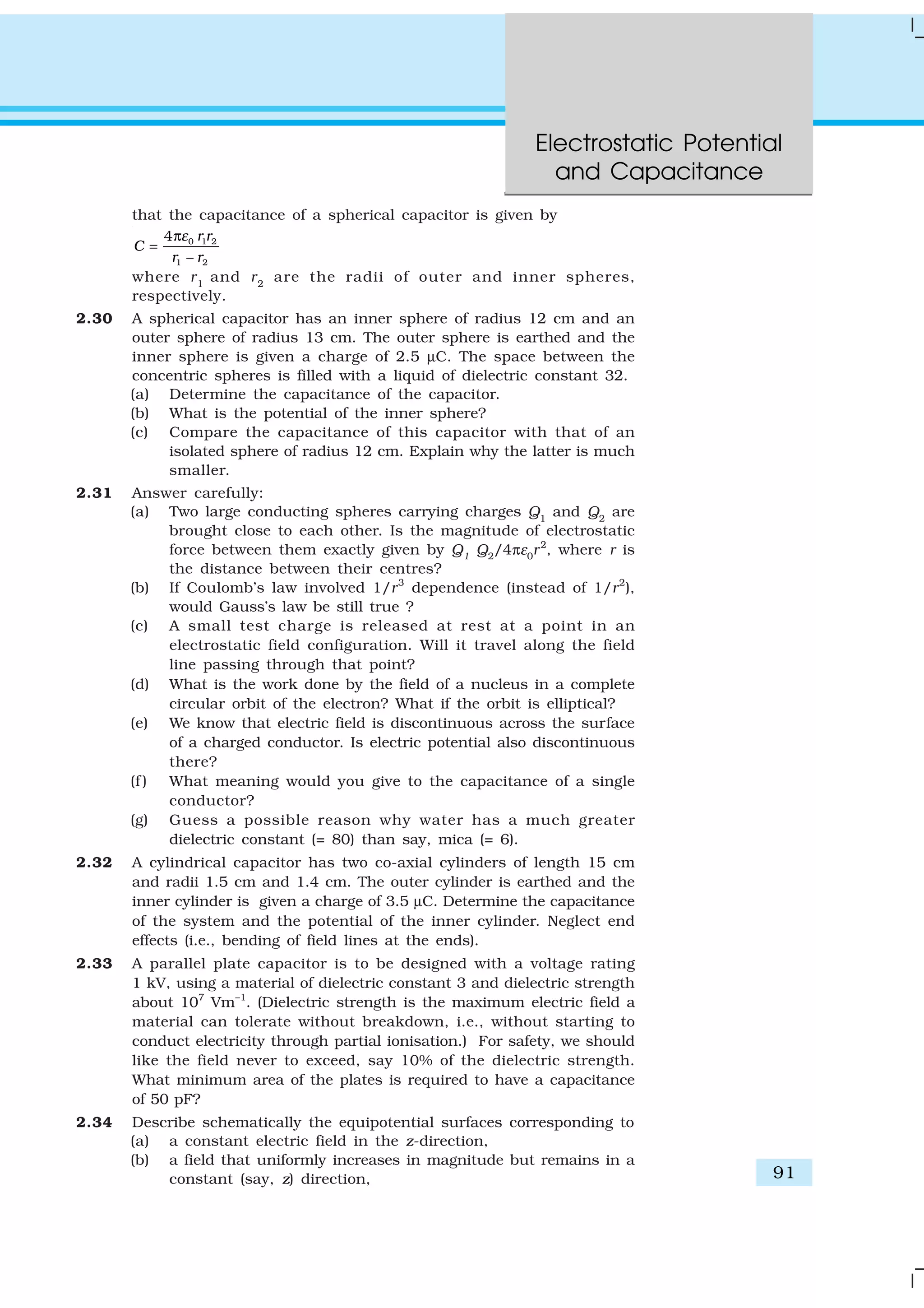

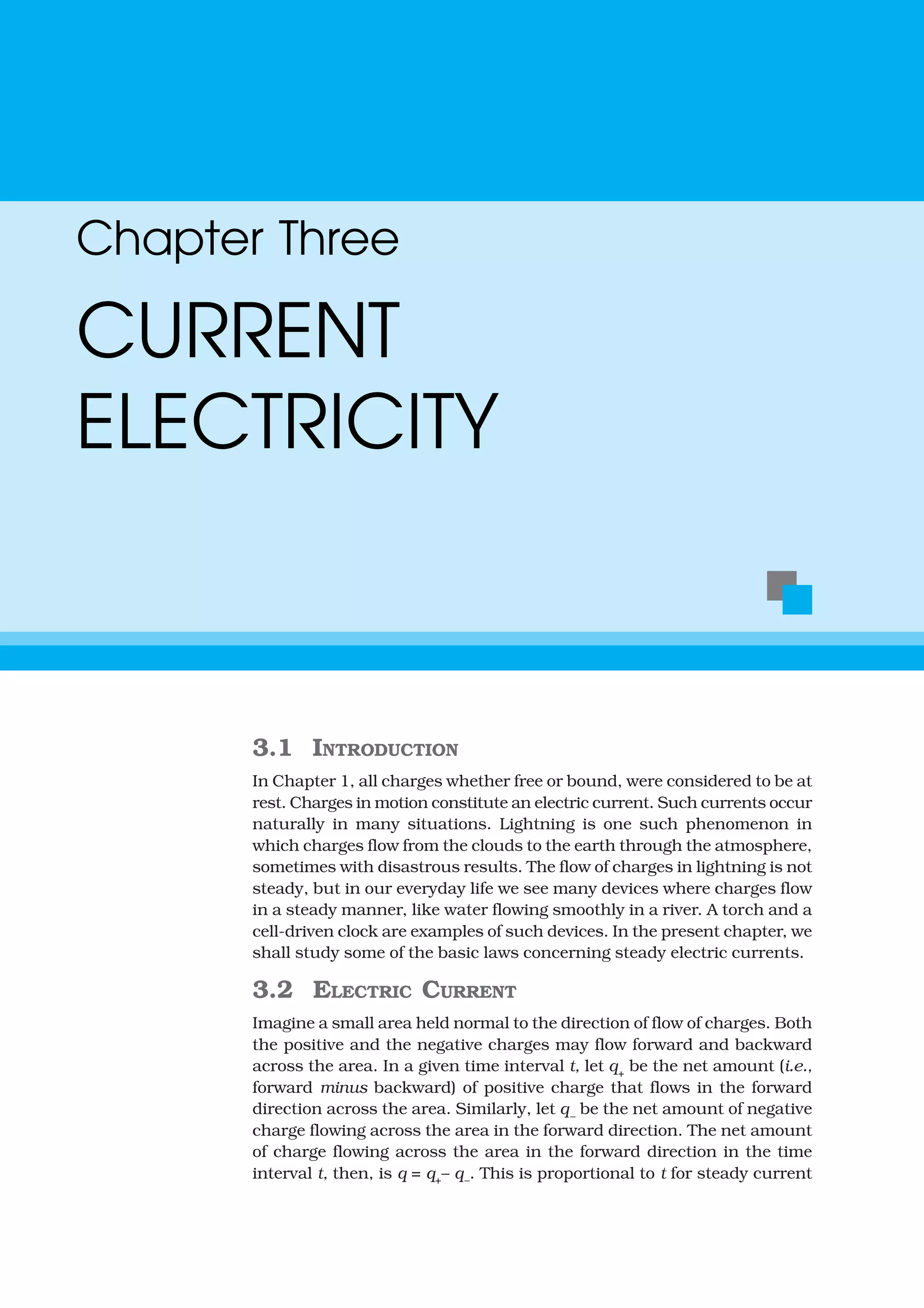
![Physics
94
and the quotient
q
I
t
= (3.1)
is defined to be the current across the area in the forward direction. (If it
turn out to be a negative number, it implies a current in the backward
direction.)
Currents are not always steady and hence more generally, we define
the current as follows. Let ∆Q be the net charge flowing across a cross-
section of a conductor during the time interval ∆t [i.e., between times t
and (t + ∆t)]. Then, the current at time t across the cross-section of the
conductor is defined as the value of the ratio of ∆Q to ∆t in the limit of ∆t
tending to zero,
( ) 0
lim
t
Q
I t
t∆ →
∆
≡
∆
(3.2)
In SI units, the unit of current is ampere. An ampere is defined
through magnetic effects of currents that we will study in the following
chapter. An ampere is typically the order of magnitude of currents in
domestic appliances. An average lightning carries currents of the order
of tens of thousands of amperes and at the other extreme, currents in
our nerves are in microamperes.
3.3 ELECTRIC CURRENTS IN CONDUCTORS
An electric charge will experience a force if an electric field is applied. If it is
free to move, it will thus move contributing to a current. In nature, free
charged particles do exist like in upper strata of atmosphere called the
ionosphere. However, in atoms and molecules, the negatively charged
electrons and the positively charged nuclei are bound to each other and
are thus not free to move. Bulk matter is made up of many molecules, a
gram of water, for example, contains approximately 1022
molecules. These
molecules are so closely packed that the electrons are no longer attached
to individual nuclei. In some materials, the electrons will still be bound,
i.e., they will not accelerate even if an electric field is applied. In other
materials, notably metals, some of the electrons are practically free to move
within the bulk material. These materials, generally called conductors,
develop electric currents in them when an electric field is applied.
If we consider solid conductors, then of course the atoms are tightly
bound to each other so that the current is carried by the negatively
charged electrons. There are, however, other types of conductors like
electrolytic solutions where positive and negative charges both can move.
In our discussions, we will focus only on solid conductors so that the
current is carried by the negatively charged electrons in the background
of fixed positive ions.
Consider first the case when no electric field is present. The electrons
will be moving due to thermal motion during which they collide with the
fixed ions. An electron colliding with an ion emerges with the same speed
as before the collision. However, the direction of its velocity after the
collision is completely random. At a given time, there is no preferential
direction for the velocities of the electrons. Thus on the average, the](https://image.slidesharecdn.com/ncert-class-12-physics-part-1-161112171109/75/Ncert-class-12-physics-part-1-98-2048.jpg)
![Current
Electricity
95
number of electrons travelling in any direction will be equal to the number
of electrons travelling in the opposite direction. So, there will be no net
electric current.
Let us now see what happens to such a
piece of conductor if an electric field is applied.
To focus our thoughts, imagine the conductor
in the shape of a cylinder of radius R (Fig. 3.1).
Suppose we now take two thin circular discs
of a dielectric of the same radius and put
positive charge +Q distributed over one disc
and similarly –Q at the other disc. We attach
the two discs on the two flat surfaces of the
cylinder. An electric field will be created and
is directed from the positive towards the
negative charge. The electrons will be accelerated due to this field towards
+Q. They will thus move to neutralise the charges. The electrons, as long
as they are moving, will constitute an electric current. Hence in the
situation considered, there will be a current for a very short while and no
current thereafter.
We can also imagine a mechanism where the ends of the cylinder are
supplied with fresh charges to make up for any charges neutralised by
electrons moving inside the conductor. In that case, there will be a steady
electric field in the body of the conductor. This will result in a continuous
current rather than a current for a short period of time. Mechanisms,
which maintain a steady electric field are cells or batteries that we shall
study later in this chapter. In the next sections, we shall study the steady
current that results from a steady electric field in conductors.
3.4 OHM’S LAW
A basic law regarding flow of currents was discovered by G.S. Ohm in
1828, long before the physical mechanism responsible for flow of currents
was discovered. Imagine a conductor through which a current I is flowing
and let V be the potential difference between the ends of the conductor.
Then Ohm’s law states that
V ∝ I
or, V = R I (3.3)
where the constant of proportionality R is called the resistance of the
conductor. The SI units of resistance is ohm, and is denoted by the symbol
Ω. The resistance R not only depends on the material of the conductor
but also on the dimensions of the conductor. The dependence of R on the
dimensions of the conductor can easily be determined as follows.
Consider a conductor satisfying Eq. (3.3) to be in the form of a slab of
length l and cross sectional area A [Fig. 3.2(a)]. Imagine placing two such
identical slabs side by side [Fig. 3.2(b)], so that the length of the
combination is 2l. The current flowing through the combination is the
same as that flowing through either of the slabs. If V is the potential
difference across the ends of the first slab, then V is also the potential
difference across the ends of the second slab since the second slab is
FIGURE 3.1 Charges +Q and –Q put at the ends
of a metallic cylinder. The electrons will drift
because of the electric field created to
neutralise the charges. The current thus
will stop after a while unless the charges +Q
and –Q are continuously replenished.
FIGURE 3.2
Illustrating the
relation R = ρl/A for
a rectangular slab
of length l and area
of cross-section A.](https://image.slidesharecdn.com/ncert-class-12-physics-part-1-161112171109/75/Ncert-class-12-physics-part-1-99-2048.jpg)
![Physics
96
identical to the first and the same current I flows through
both. The potential difference across the ends of the
combination is clearly sum of the potential difference
across the two individual slabs and hence equals 2V. The
current through the combination is I and the resistance
of the combination RC is [from Eq. (3.3)],
2
2C
V
R R
I
= = (3.4)
since V/I = R, the resistance of either of the slabs. Thus,
doubling the length of a conductor doubles the
resistance. In general, then resistance is proportional to
length,
R l∝ (3.5)
Next, imagine dividing the slab into two by cutting it
lengthwise so that the slab can be considered as a
combination of two identical slabs of length l, but each
having a cross sectional area of A/2 [Fig. 3.2(c)].
For a given voltage V across the slab, if I is the current
through the entire slab, then clearly the current flowing
through each of the two half-slabs is I/2. Since the
potential difference across the ends of the half-slabs is V,
i.e., the same as across the full slab, the resistance of each
of the half-slabs R1
is
1 2 2 .
( /2)
V V
R R
I I
= = = (3.6)
Thus, halving the area of the cross-section of a conductor doubles
the resistance. In general, then the resistance R is inversely proportional
to the cross-sectional area,
1
R
A
∝ (3.7)
Combining Eqs. (3.5) and (3.7), we have
l
R
A
∝ (3.8)
and hence for a given conductor
l
R
A
ρ= (3.9)
where the constant of proportionality ρ depends on the material of the
conductor but not on its dimensions. ρ is called resistivity.
Using the last equation, Ohm’s law reads
I l
V I R
A
ρ
= × = (3.10)
Current per unit area (taken normal to the current), I/A, is called
current density and is denoted by j. The SI units of the current density
are A/m2
. Further, if E is the magnitude of uniform electric field in the
conductor whose length is l, then the potential difference V across its
ends is El. Using these, the last equation reads
GEORGSIMONOHM(1787–1854)
Georg Simon Ohm (1787–
1854) German physicist,
professor at Munich. Ohm
was led to his law by an
analogy between the
conduction of heat: the
electric field is analogous to
the temperature gradient,
and the electric current is
analogous to the heat flow.](https://image.slidesharecdn.com/ncert-class-12-physics-part-1-161112171109/75/Ncert-class-12-physics-part-1-100-2048.jpg)
![Current
Electricity
97
E l = j ρ l
or, E = j ρ (3.11)
The above relation for magnitudes E and j can indeed be cast in a
vector form. The current density, (which we have defined as the current
through unit area normal to the current) is also directed along E, and is
also a vector j (≡ j E/E). Thus, the last equation can be written as,
E = jρ (3.12)
or, j = σ E (3.13)
where σ ≡1/ρ is called the conductivity. Ohm’s law is often stated in an
equivalent form, Eq. (3.13) in addition to Eq.(3.3). In the next section, we
will try to understand the origin of the Ohm’s law as arising from the
characteristics of the drift of electrons.
3.5 DRIFT OF ELECTRONS AND THE ORIGIN OF
RESISTIVITY
As remarked before, an electron will suffer collisions with the heavy fixed
ions, but after collision, it will emerge with the same speed but in random
directions. If we consider all the electrons, their average velocity will be
zero since their directions are random. Thus, if there are N electrons and
the velocity of the ith
electron (i = 1, 2, 3, ... N) at a given time is vi
, then
1
1
0
N
i
iN =
=∑v (3.14)
Consider now the situation when an electric field is
present. Electrons will be accelerated due to this
field by
–e
m
=
E
a (3.15)
where –e is the charge and m is the mass of an electron.
Consider again the ith
electron at a given time t. This
electron would have had its last collision some time
before t, and let ti be the time elapsed after its last
collision. If vi
was its velocity immediately after the last
collision, then its velocity Vi
at time t is
–i i i
e
t
m
=
E
V v (3.16)
since starting with its last collision it was accelerated
(Fig. 3.3) with an acceleration given by Eq. (3.15) for a
time interval ti
. The average velocity of the electrons at
time t is the average of all the Vi’s. The average of vi’s is
zero [Eq. (3.14)] since immediately after any collision,
the direction of the velocity of an electron is completely
random. The collisions of the electrons do not occur at
regular intervals but at random times. Let us denote by
τ, the average time between successive collisions. Then
at a given time, some of the electrons would have spent
FIGURE 3.3 A schematic picture of
an electron moving from a point A to
another point B through repeated
collisions, and straight line travel
between collisions (full lines). If an
electric field is applied as shown, the
electron ends up at point B′ (dotted
lines). A slight drift in a direction
opposite the electric field is visible.](https://image.slidesharecdn.com/ncert-class-12-physics-part-1-161112171109/75/Ncert-class-12-physics-part-1-101-2048.jpg)
![Physics
98
time more than τ and some less than τ. In other words, the time ti
in
Eq. (3.16) will be less than τ for some and more than τ for others as we go
through the values of i = 1, 2 ..... N. The average value of ti then is τ
(known as relaxation time). Thus, averaging Eq. (3.16) over the
N-electrons at any given time t gives us for the average velocity vd
( ) ( ) ( )d i i iaverage average average
e
t
m
≡ = −
E
v V v
0 –
e e
m m
τ τ= = −
E E
(3.17)
This last result is surprising. It tells us that the
electrons move with an average velocity which is
independent of time, although electrons are
accelerated. This is the phenomenon of drift and the
velocity vd in Eq. (3.17) is called the drift velocity.
Because of the drift, there will be net transport of
charges across any area perpendicular to E. Consider
a planar area A, located inside the conductor such that
the normal to the area is parallel to E
(Fig. 3.4). Then because of the drift, in an infinitesimal
amount of time ∆t, all electrons to the left of the area at
distances upto |vd
|∆t would have crossed the area. If
n is the number of free electrons per unit volume in
the metal, then there are n ∆t |vd|A such electrons.
Since each electron carries a charge –e, the total charge transported across
this area A to the right in time ∆t is –ne A|vd
|∆t. E is directed towards the
left and hence the total charge transported along E across the area is
negative of this. The amount of charge crossing the area A in time ∆t is by
definition [Eq. (3.2)] I ∆t, where I is the magnitude of the current. Hence,
dI t n e A t∆ = + ∆v (3.18)
Substituting the value of |vd| from Eq. (3.17)
2
e A
I t n t
m
τ∆ = ∆ E (3.19)
By definition I is related to the magnitude |j| of the current density by
I = |j|A (3.20)
Hence, from Eqs.(3.19) and (3.20),
2
ne
m
τ=j E (3.21)
The vector j is parallel to E and hence we can write Eq. (3.21) in the
vector form
2
ne
m
τ=j E (3.22)
Comparison with Eq. (3.13) shows that Eq. (3.22) is exactly the Ohm’s
law, if we identify the conductivity σ as
FIGURE 3.4 Current in a metallic
conductor. The magnitude of current
density in a metal is the magnitude of
charge contained in a cylinder of unit
area and length vd
.](https://image.slidesharecdn.com/ncert-class-12-physics-part-1-161112171109/75/Ncert-class-12-physics-part-1-102-2048.jpg)
![Current
Electricity
99
EXAMPLE3.1
2
ne
m
σ τ= (3.23)
We thus see that a very simple picture of electrical conduction
reproduces Ohm’s law. We have, of course, made assumptions that τ
and n are constants, independent of E. We shall, in the next section,
discuss the limitations of Ohm’s law.
Example 3.1 (a) Estimate the average drift speed of conduction
electrons in a copper wire of cross-sectional area 1.0 × 10–7
m2
carrying
a current of 1.5 A. Assume that each copper atom contributes roughly
one conduction electron. The density of copper is 9.0 × 103
kg/m3
,
and its atomic mass is 63.5 u. (b) Compare the drift speed obtained
above with, (i) thermal speeds of copper atoms at ordinary
temperatures, (ii) speed of propagation of electric field along the
conductor which causes the drift motion.
Solution
(a) The direction of drift velocity of conduction electrons is opposite
to the electric field direction, i.e., electrons drift in the direction
of increasing potential. The drift speed vd
is given by Eq. (3.18)
vd
= (I/neA)
Now, e = 1.6 × 10–19
C, A = 1.0 × 10–7
m2
, I = 1.5 A. The density of
conduction electrons, n is equal to the number of atoms per cubic
metre (assuming one conduction electron per Cu atom as is
reasonable from its valence electron count of one). A cubic metre
of copper has a mass of 9.0 × 103
kg. Since 6.0 × 1023
copper
atoms have a mass of 63.5 g,
23
66.0 10
9.0 10
63.5
n
×
= × ×
= 8.5 × 1028
m–3
which gives,
28 –19 –7
1.5
8.5 10 1.6 10 1.0 10
=
× × × × ×
dv
= 1.1 × 10–3
m s–1
= 1.1 mm s–1
(b) (i) At a temperature T, the thermal speed* of a copper atom of
mass M is obtained from [<(1/2) Mv2
> = (3/2) kB
T ] and is thus
typically of the order of /Bk T M , where kB
is the Boltzmann
constant. For copper at 300 K, this is about 2 × 102
m/s. This
figure indicates the random vibrational speeds of copper atoms
in a conductor. Note that the drift speed of electrons is much
smaller, about 10–5
times the typical thermal speed at ordinary
temperatures.
(ii) An electric field travelling along the conductor has a speed of
an electromagnetic wave, namely equal to 3.0 × 108
m s–1
(You will learn about this in Chapter 8). The drift speed is, in
comparison, extremely small; smaller by a factor of 10–11
.
* See Eq. (13.23) of Chapter 13 from Class XI book.](https://image.slidesharecdn.com/ncert-class-12-physics-part-1-161112171109/75/Ncert-class-12-physics-part-1-103-2048.jpg)
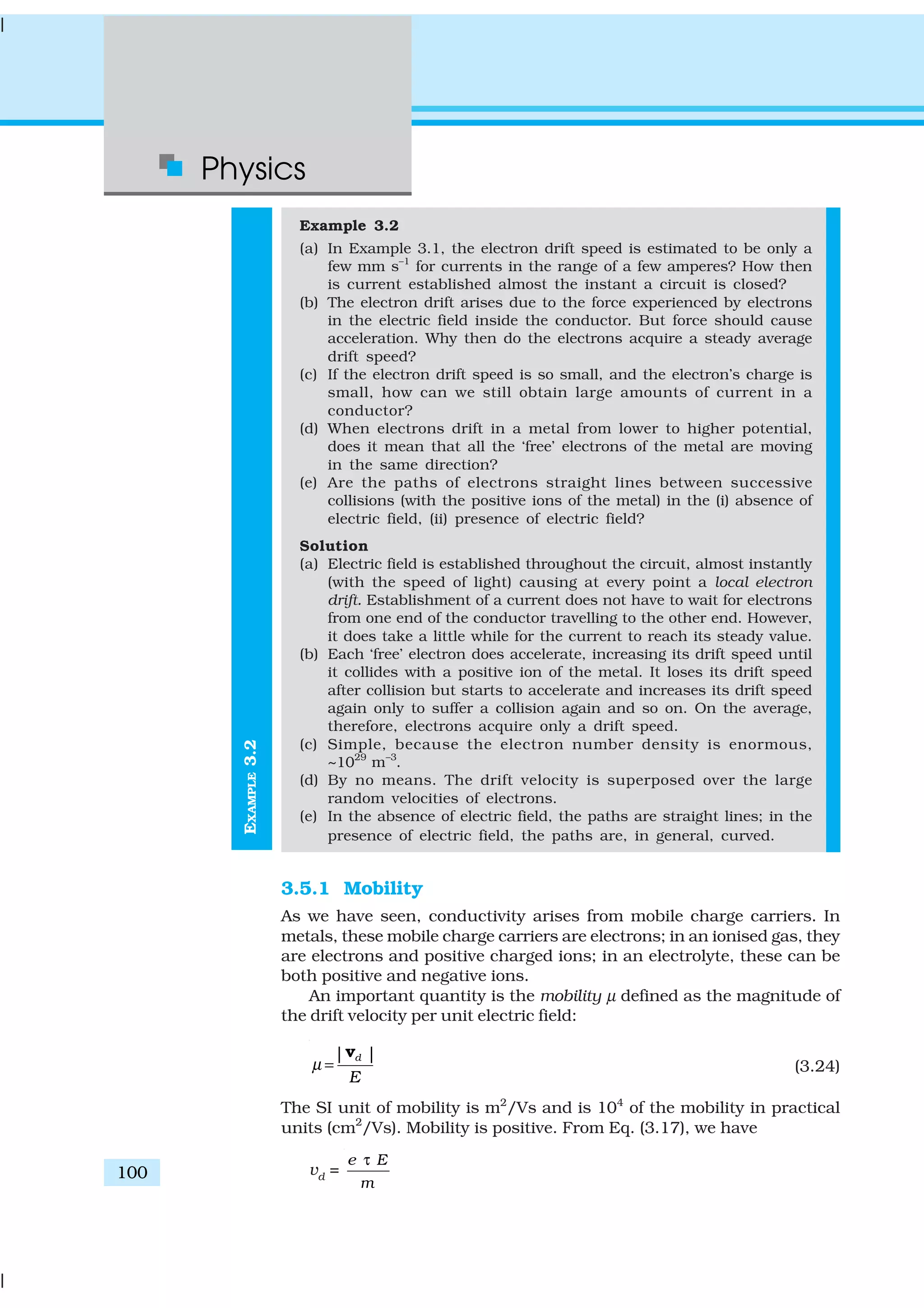
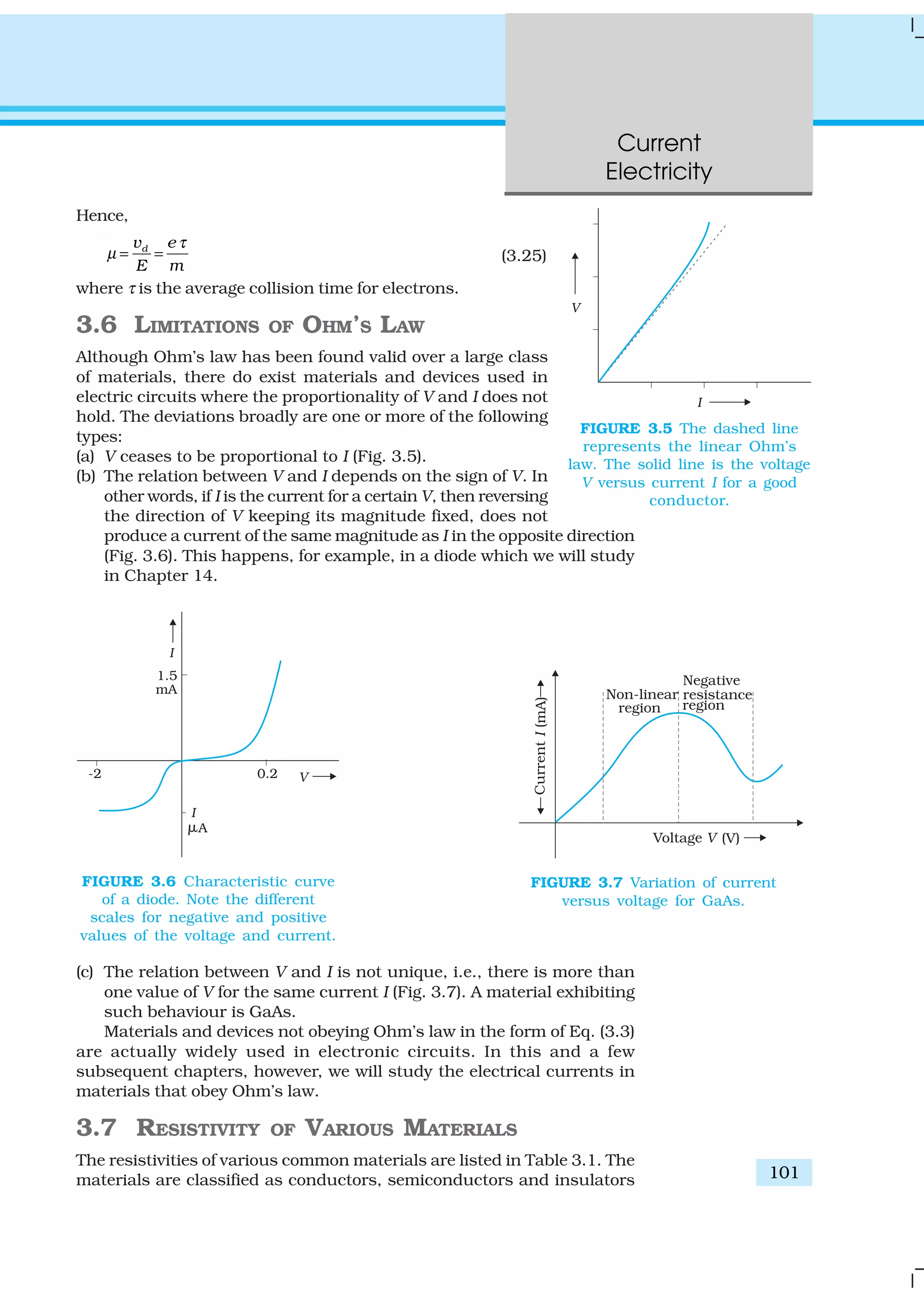
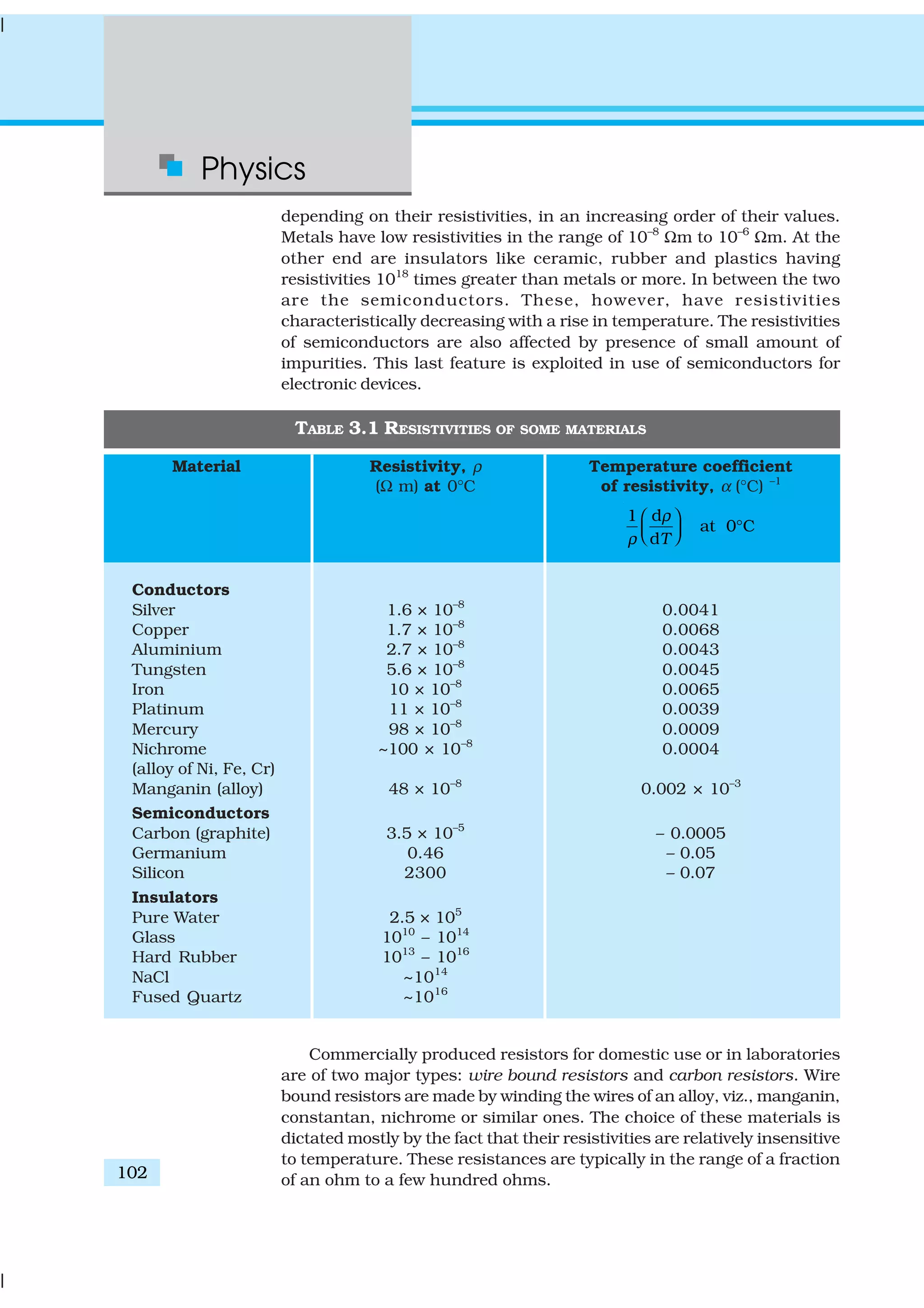
![Current
Electricity
103
Resistors in the higher range are made mostly from carbon. Carbon
resistors are compact, inexpensive and thus find extensive use in electronic
circuits. Carbon resistors are small in size and hence their values are
given using a colour code.
TABLE 3.2 RESISTOR COLOUR CODES
Colour Number Multiplier Tolerance (%)
Black 0 1
Brown 1 101
Red 2 102
Orange 3 103
Yellow 4 104
Green 5 105
Blue 6 106
Violet 7 107
Gray 8 108
White 9 109
Gold 10–1
5
Silver 10–2
10
No colour 20
The resistors have a set of co-axial coloured rings
on them whose significance are listed in Table 3.2. The
first two bands from the end indicate the first two
significant figures of the resistance in ohms. The third
band indicates the decimal multiplier (as listed in Table
3.2). The last band stands for tolerance or possible
variation in percentage about the indicated values.
Sometimes, this last band is absent and that indicates
a tolerance of 20% (Fig. 3.8). For example, if the four
colours are orange, blue, yellow and gold, the resistance
value is 36 × 104
Ω, with a tolerence value of 5%.
3.8 TEMPERATURE DEPENDENCE OF
RESISTIVITY
The resistivity of a material is found to be dependent on
the temperature. Different materials do not exhibit the
same dependence on temperatures. Over a limited range
of temperatures, that is not too large, the resistivity of a
metallic conductor is approximately given by,
ρT
= ρ0
[1 + α (T–T0
)] (3.26)
where ρT is the resistivity at a temperature T and ρ0 is the same at a
reference temperature T0
. α is called the temperature co-efficient of
resistivity, and from Eq. (3.26), the dimension of α is (Temperature)–1
.
FIGURE 3.8 Colour coded resistors
(a) (22 × 102
Ω) ± 10%,
(b) (47 × 10 Ω) ± 5%.](https://image.slidesharecdn.com/ncert-class-12-physics-part-1-161112171109/75/Ncert-class-12-physics-part-1-107-2048.jpg)
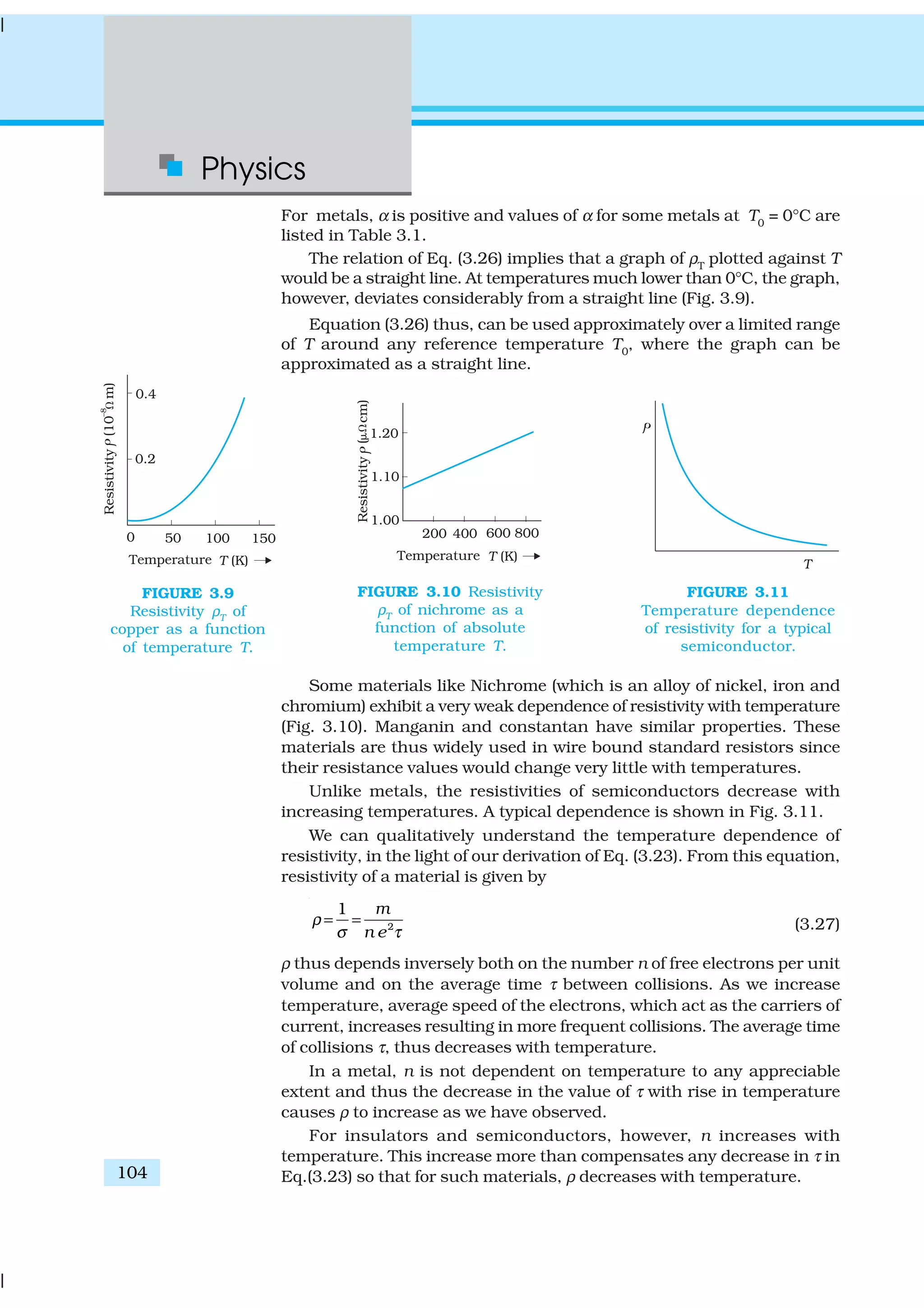
![Current
Electricity
105
EXAMPLE3.4
Example 3.3 An electric toaster uses nichrome for its heating
element. When a negligibly small current passes through it, its
resistance at room temperature (27.0 °C) is found to be 75.3 Ω. When
the toaster is connected to a 230 V supply, the current settles, after
a few seconds, to a steady value of 2.68 A. What is the steady
temperature of the nichrome element? The temperature coefficient
of resistance of nichrome averaged over the temperature range
involved, is 1.70 × 10–4
°C–1
.
Solution When the current through the element is very small, heating
effects can be ignored and the temperature T1
of the element is the
same as room temperature. When the toaster is connected to the
supply, its initial current will be slightly higher than its steady value
of 2.68 A. But due to heating effect of the current, the temperature
will rise. This will cause an increase in resistance and a slight
decrease in current. In a few seconds, a steady state will be reached
when temperature will rise no further, and both the resistance of the
element and the current drawn will achieve steady values. The
resistance R2
at the steady temperature T2
is
R2
230 V
85.8
2.68 A
= = Ω
Using the relation
R2
= R1
[1 + α (T2
– T1
)]
with α = 1.70 × 10–4
°C–1
, we get
T2
– T1 –4
(85.8 – 75.3)
(75.3) 1.70 10
=
× ×
= 820 °C
that is, T2
= (820 + 27.0) °C = 847 °C
Thus, the steady temperature of the heating element (when heating
effect due to the current equals heat loss to the surroundings) is
847 °C.
Example 3.4 The resistance of the platinum wire of a platinum
resistance thermometer at the ice point is 5 Ω and at steam point is
5.23 Ω. When the thermometer is inserted in a hot bath, the resistance
of the platinum wire is 5.795 Ω. Calculate the temperature of the
bath.
Solution R0
= 5 Ω, R100
= 5.23 Ω and Rt
= 5.795 Ω
Now,
0
0
100 0
100, (1 )t
t
R R
t R R t
R R
α
−
= × = +
−
5.795 5
100
5.23 5
−
= ×
−
=
0.795
100
0.23
× = 345.65 °C
3.9 ELECTRICAL ENERGY, POWER
Consider a conductor with end points A and B, in which a current I is
flowing from A to B. The electric potential at A and B are denoted by V(A)
EXAMPLE3.3](https://image.slidesharecdn.com/ncert-class-12-physics-part-1-161112171109/75/Ncert-class-12-physics-part-1-109-2048.jpg)
![Physics
106
and V(B) respectively. Since current is flowing from A to B, V(A) > V(B)
and the potential difference across AB is V = V(A) – V(B) > 0.
In a time interval ∆t, an amount of charge ∆Q = I ∆t travels from A to
B. The potential energy of the charge at A, by definition, was Q V(A) and
similarly at B, it is Q V(B). Thus, change in its potential energy ∆Upot
is
∆Upot = Final potential energy – Initial potential energy
= ∆Q[(V (B) – V (A)] = –∆Q V
= –I V∆t < 0 (3.28)
If charges moved without collisions through the conductor, their
kinetic energy would also change so that the total energy is unchanged.
Conservation of total energy would then imply that,
∆K = –∆Upot
(3.29)
that is,
∆K = I V∆t > 0 (3.30)
Thus, in case charges were moving freely through the conductor under
the action of electric field, their kinetic energy would increase as they
move. We have, however, seen earlier that on the average, charge carriers
do not move with acceleration but with a steady drift velocity. This is
because of the collisions with ions and atoms during transit. During
collisions, the energy gained by the charges thus is shared with the atoms.
The atoms vibrate more vigorously, i.e., the conductor heats up. Thus,
in an actual conductor, an amount of energy dissipated as heat in the
conductor during the time interval ∆t is,
∆W = I V∆t (3.31)
The energy dissipated per unit time is the power dissipated
P = ∆W/∆t and we have,
P = I V (3.32)
Using Ohm’s law V = IR, we get
P = I 2
R = V 2
/R (3.33)
as the power loss (“ohmic loss”) in a conductor of resistance R carrying a
current I. It is this power which heats up, for example, the coil of an
electric bulb to incandescence, radiating out heat and
light.
Where does the power come from? As we have
reasoned before, we need an external source to keep
a steady current through the conductor. It is clearly
this source which must supply this power. In the
simple circuit shown with a cell (Fig.3.12), it is the
chemical energy of the cell which supplies this power
for as long as it can.
The expressions for power, Eqs. (3.32) and (3.33),
show the dependence of the power dissipated in a
resistor R on the current through it and the voltage
across it.
Equation (3.33) has an important application to
power transmission. Electrical power is transmitted
from power stations to homes and factories, which
FIGURE 3.12 Heat is produced in the
resistor R which is connected across
the terminals of a cell. The energy
dissipated in the resistor R comes from
the chemical energy of the electrolyte.](https://image.slidesharecdn.com/ncert-class-12-physics-part-1-161112171109/75/Ncert-class-12-physics-part-1-110-2048.jpg)
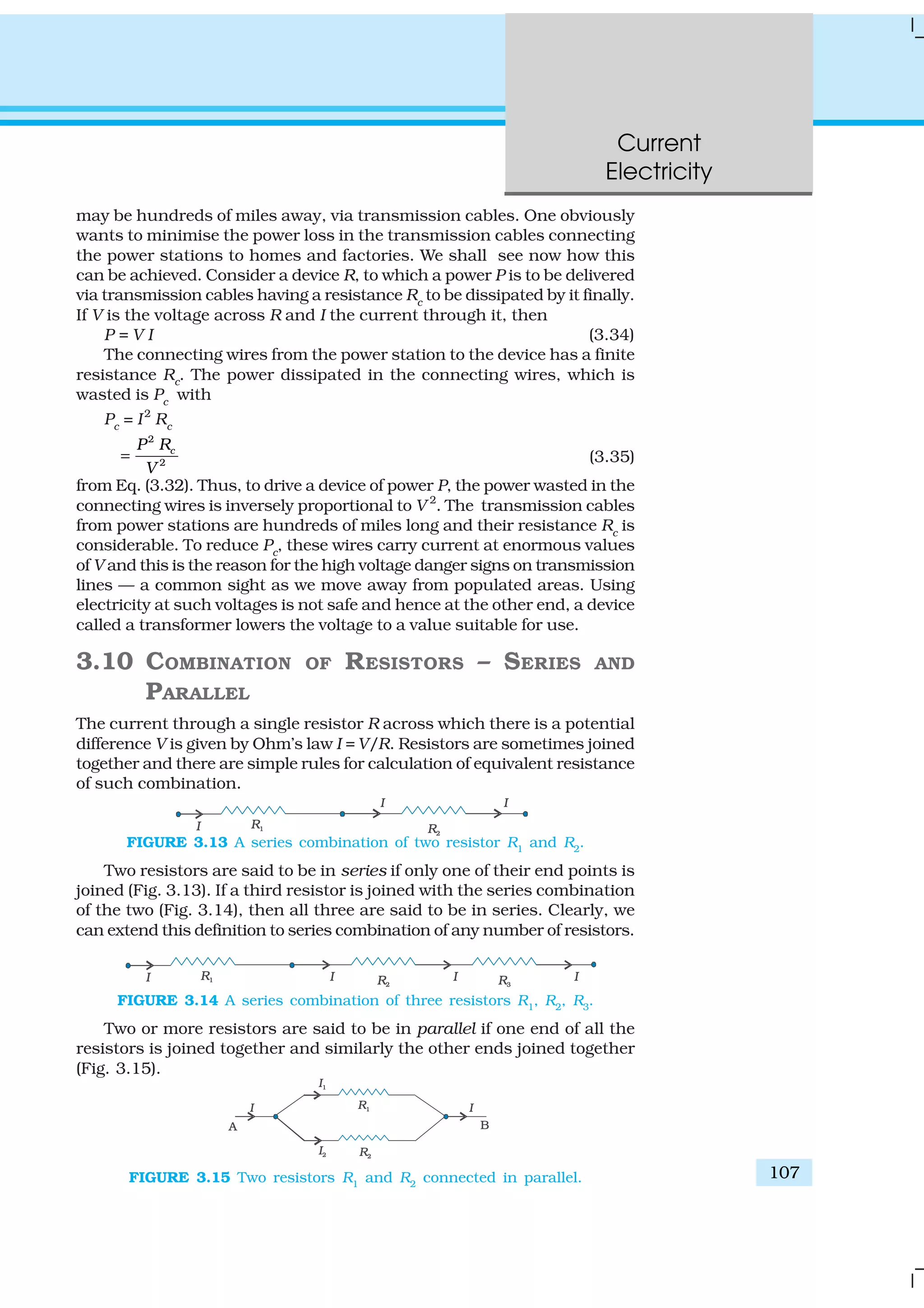

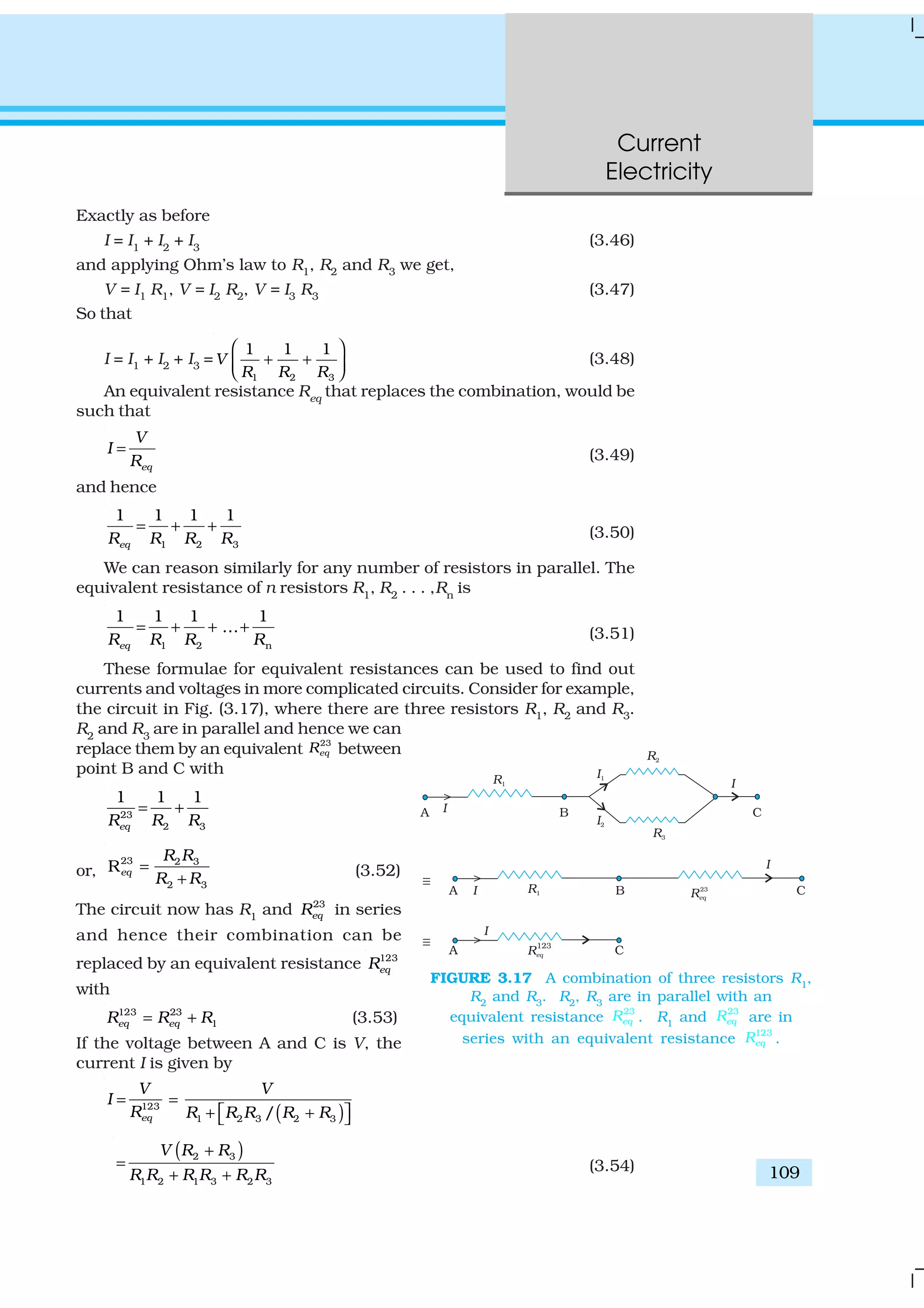
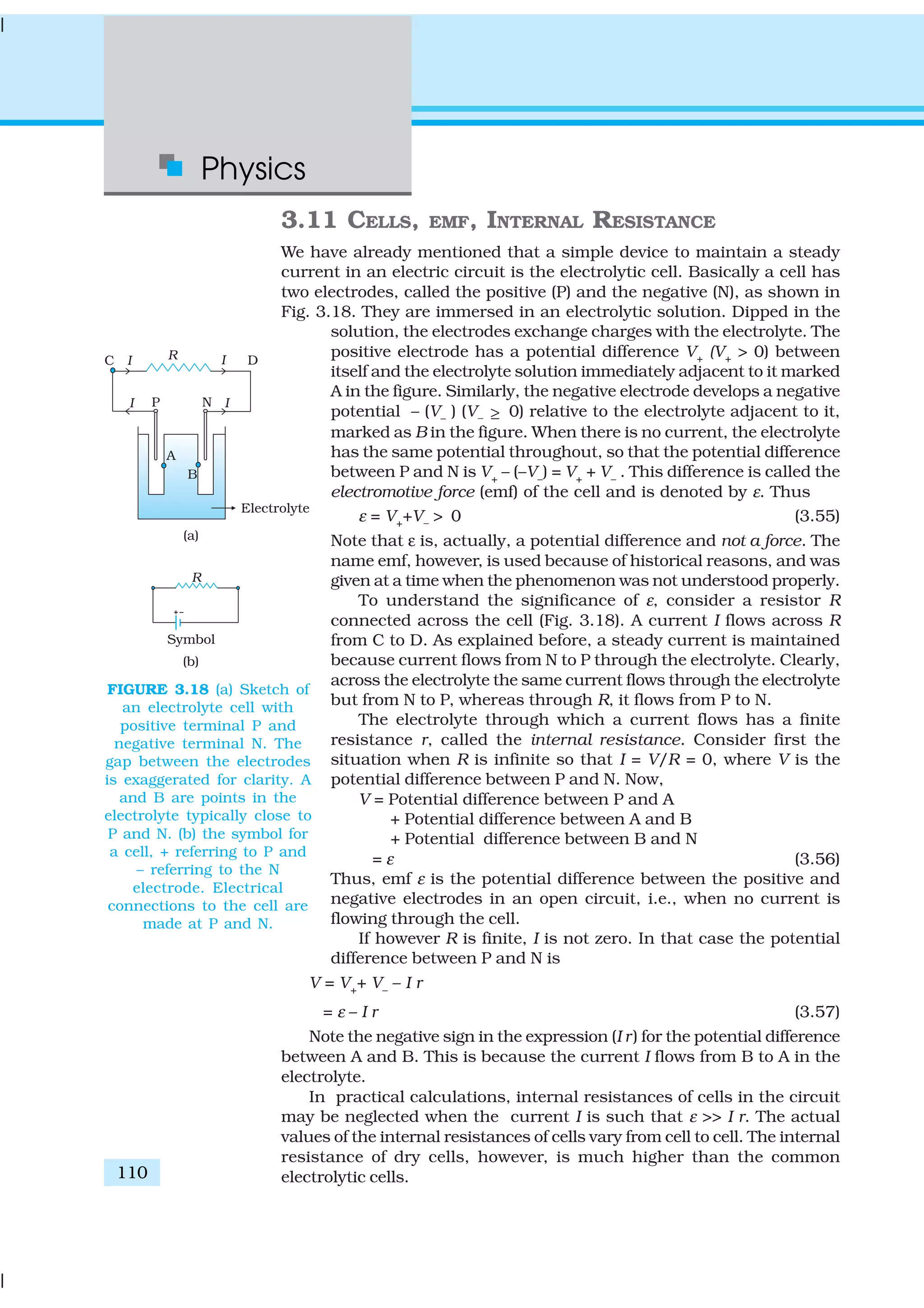
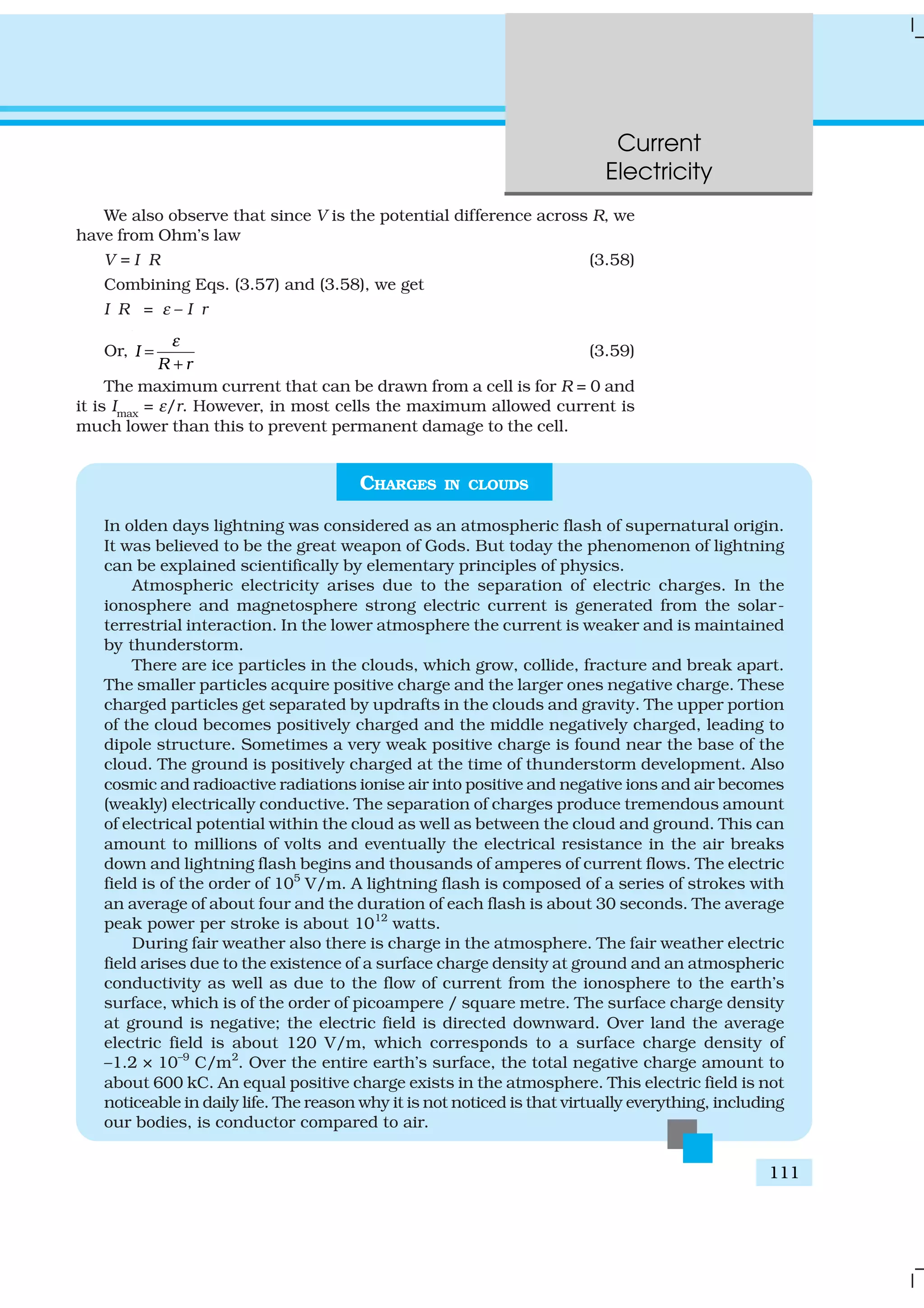
![Physics
112
EXAMPLE3.5
Example 3.5 A network of resistors is connected to a 16 V battery
with internal resistance of 1Ω, as shown in Fig. 3.19: (a) Compute
the equivalent resistance of the network. (b) Obtain the current in
each resistor. (c) Obtain the voltage drops VAB
, VBC
and VCD
.
FIGURE 3.19
Solution
(a) The network is a simple series and parallel combination of
resistors. First the two 4Ω resistors in parallel are equivalent to a
resistor = [(4 × 4)/(4 + 4)] Ω = 2 Ω.
In the same way, the 12 Ω and 6 Ω resistors in parallel are
equivalent to a resistor of
[(12 × 6)/(12 + 6)] Ω = 4 Ω.
The equivalent resistance R of the network is obtained by
combining these resistors (2 Ω and 4 Ω) with 1 Ω in series,
that is,
R = 2 Ω + 4 Ω + 1 Ω = 7 Ω.
(b) The total current I in the circuit is
16
2 A
(7 1)
V
I
R r
ε
= = =
+ + Ω
Consider the resistors between A and B. If I1
is the current in one
of the 4 Ω resistors and I2
the current in the other,
I1
× 4 = I2
× 4
that is, I1
= I2
, which is otherwise obvious from the symmetry of
the two arms. But I1
+ I2
= I = 2 A. Thus,
I1
= I2
= 1 A
that is, current in each 4 Ω resistor is 1 A. Current in 1 Ω resistor
between B and C would be 2 A.
Now, consider the resistances between C and D. If I3
is the current
in the 12 Ω resistor, and I4
in the 6 Ω resistor,
I3
× 12 = I4
× 6, i.e., I4
= 2I3
But, I3
+ I4
= I = 2 A
Thus, I3
=
2
3
A, I4
=
4
3
A
that is, the current in the 12 Ω resistor is (2/3) A, while the current
in the 6 Ω resistor is (4/3) A.
(c) The voltage drop across AB is
VAB
= I1
× 4 = 1 A × 4 Ω = 4 V,
This can also be obtained by multiplying the total current between
A and B by the equivalent resistance between A and B, that is,](https://image.slidesharecdn.com/ncert-class-12-physics-part-1-161112171109/75/Ncert-class-12-physics-part-1-116-2048.jpg)
![Current
Electricity
113
EXAMPLE3.5
VAB
= 2 A × 2 Ω = 4 V
The voltage drop across BC is
VBC
= 2 A × 1 Ω = 2 V
Finally, the voltage drop across CD is
VCD
= 12 Ω × I3
= 12 Ω ×
2
3
A = 8 V.
This can alternately be obtained by multiplying total current
between C and D by the equivalent resistance between C and D,
that is,
VCD
= 2 A × 4 Ω = 8 V
Note that the total voltage drop across AD is 4 V + 2 V + 8 V = 14 V.
Thus, the terminal voltage of the battery is 14 V, while its emf is 16 V.
The loss of the voltage (= 2 V) is accounted for by the internal resistance
1 Ω of the battery [2 A × 1 Ω = 2 V].
3.12 CELLS IN SERIES AND IN PARALLEL
Like resistors, cells can be combined together in an electric circuit. And
like resistors, one can, for calculating currents and voltages in a circuit,
replace a combination of cells by an equivalent cell.
FIGURE 3.20 Two cells of emf’s ε1
and ε2
in the series. r1
, r2
are their
internal resistances. For connections across A and C, the combination
can be considered as one cell of emf εeq
and an internal resistance req
.
Consider first two cells in series (Fig. 3.20), where one terminal of the
two cells is joined together leaving the other terminal in either cell free.
ε1
, ε2
are the emf’s of the two cells and r1
, r2
their internal resistances,
respectively.
Let V (A), V (B), V (C) be the potentials at points A, B and C shown in
Fig. 3.20. Then V (A) – V (B) is the potential difference between the positive
and negative terminals of the first cell. We have already calculated it in
Eq. (3.57) and hence,
AB 1 1(A) – (B) –V V V I rε≡ = (3.60)
Similarly,
BC 2 2(B)– (C) –V V V I rε≡ = (3.61)
Hence, the potential difference between the terminals A and C of the
combination is
( ) ( ) ( ) ( )AC (A) – (C) A – B B – CV V V V V V V≡ = +
( ) ( )1 2 1 2– I r rε ε= + + (3.62)](https://image.slidesharecdn.com/ncert-class-12-physics-part-1-161112171109/75/Ncert-class-12-physics-part-1-117-2048.jpg)
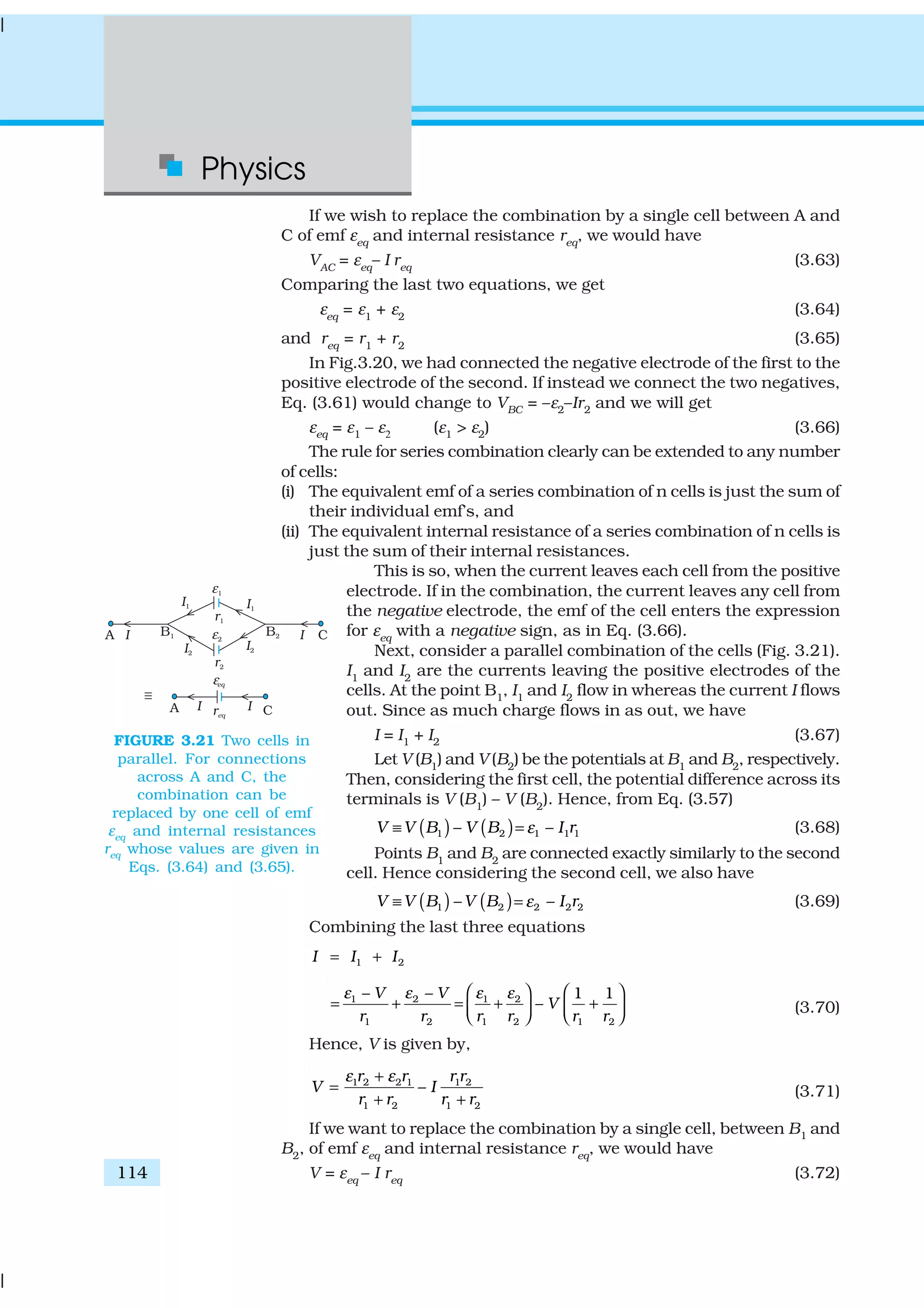
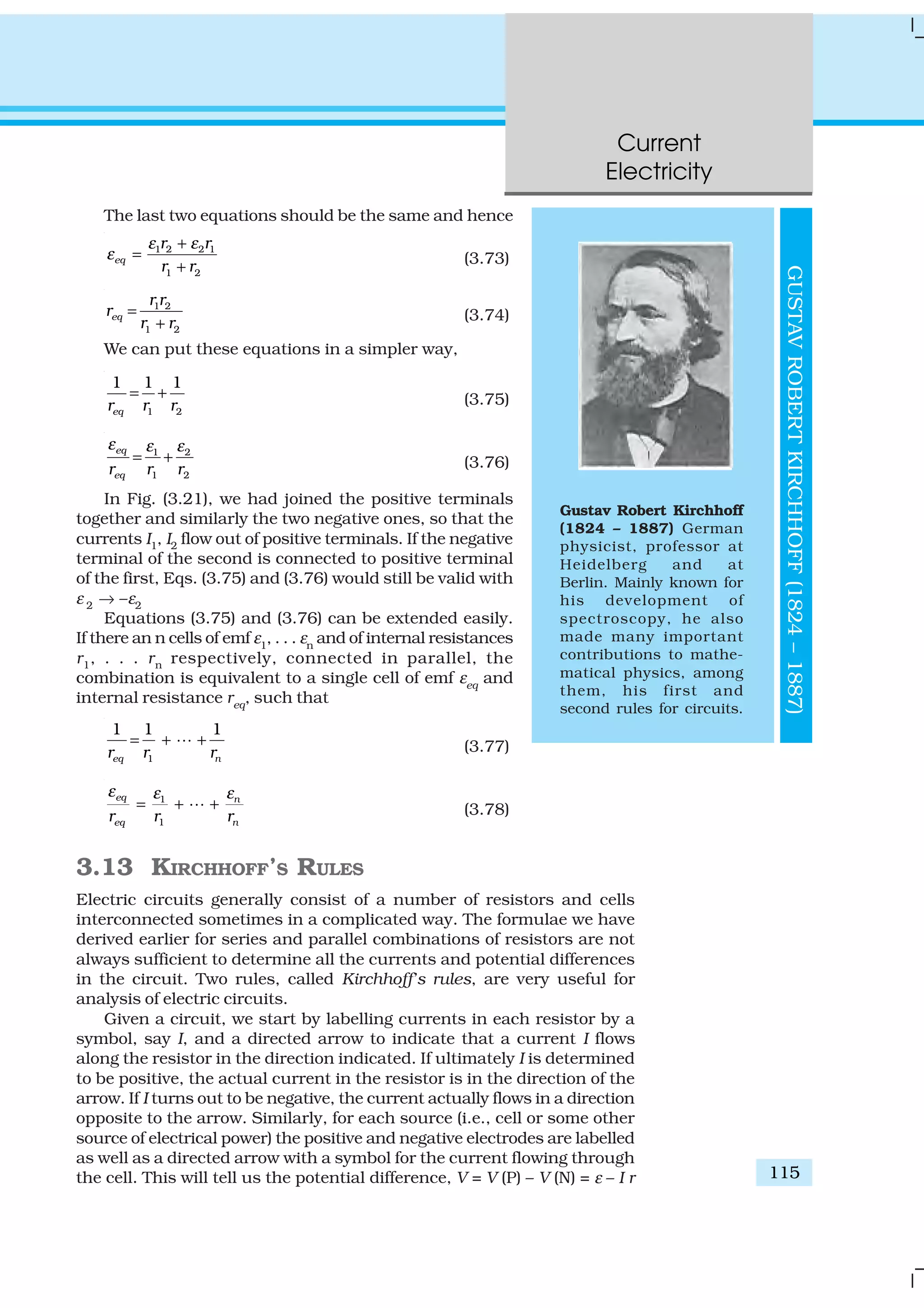
![Physics
116
EXAMPLE3.6
[Eq. (3.57) between the positive terminal P and the negative terminal N; I
here is the current flowing from N to P through the cell]. If, while labelling
the current I through the cell one goes from P to N,
then of course
V = ε + I r (3.79)
Having clarified labelling, we now state the rules
and the proof:
(a) Junction rule: At any junction, the sum of the
currents entering the junction is equal to the
sum of currents leaving the junction (Fig. 3.22).
This applies equally well if instead of a junction of
several lines, we consider a point in a line.
The proof of this rule follows from the fact that
when currents are steady, there is no accumulation
of charges at any junction or at any point in a line.
Thus, the total current flowing in, (which is the rate
at which charge flows into the junction), must equal
the total current flowing out.
(b) Loop rule: The algebraic sum of changes in
potential around any closed loop involving
resistors and cells in the loop is zero (Fig. 3.22).
This rule is also obvious, since electric potential is
dependent on the location of the point. Thus starting with any point if we
come back to the same point, the total change must be zero. In a closed
loop, we do come back to the starting point and hence the rule.
Example 3.6 A battery of 10 V and negligible internal resistance is
connected across the diagonally opposite corners of a cubical network
consisting of 12 resistors each of resistance 1 Ω (Fig. 3.23). Determine
the equivalent resistance of the network and the current along each
edge of the cube.
FIGURE 3.23
FIGURE 3.22 At junction a the current
leaving is I1
+ I2
and current entering is I3
.
The junction rule says I3
= I1
+ I2
. At point
h current entering is I1
. There is only one
current leaving h and by junction rule
that will also be I1
. For the loops ‘ahdcba’
and ‘ahdefga’, the loop rules give –30I1
–
41 I3
+ 45 = 0 and –30I1
+ 21 I2
– 80 = 0.](https://image.slidesharecdn.com/ncert-class-12-physics-part-1-161112171109/75/Ncert-class-12-physics-part-1-120-2048.jpg)
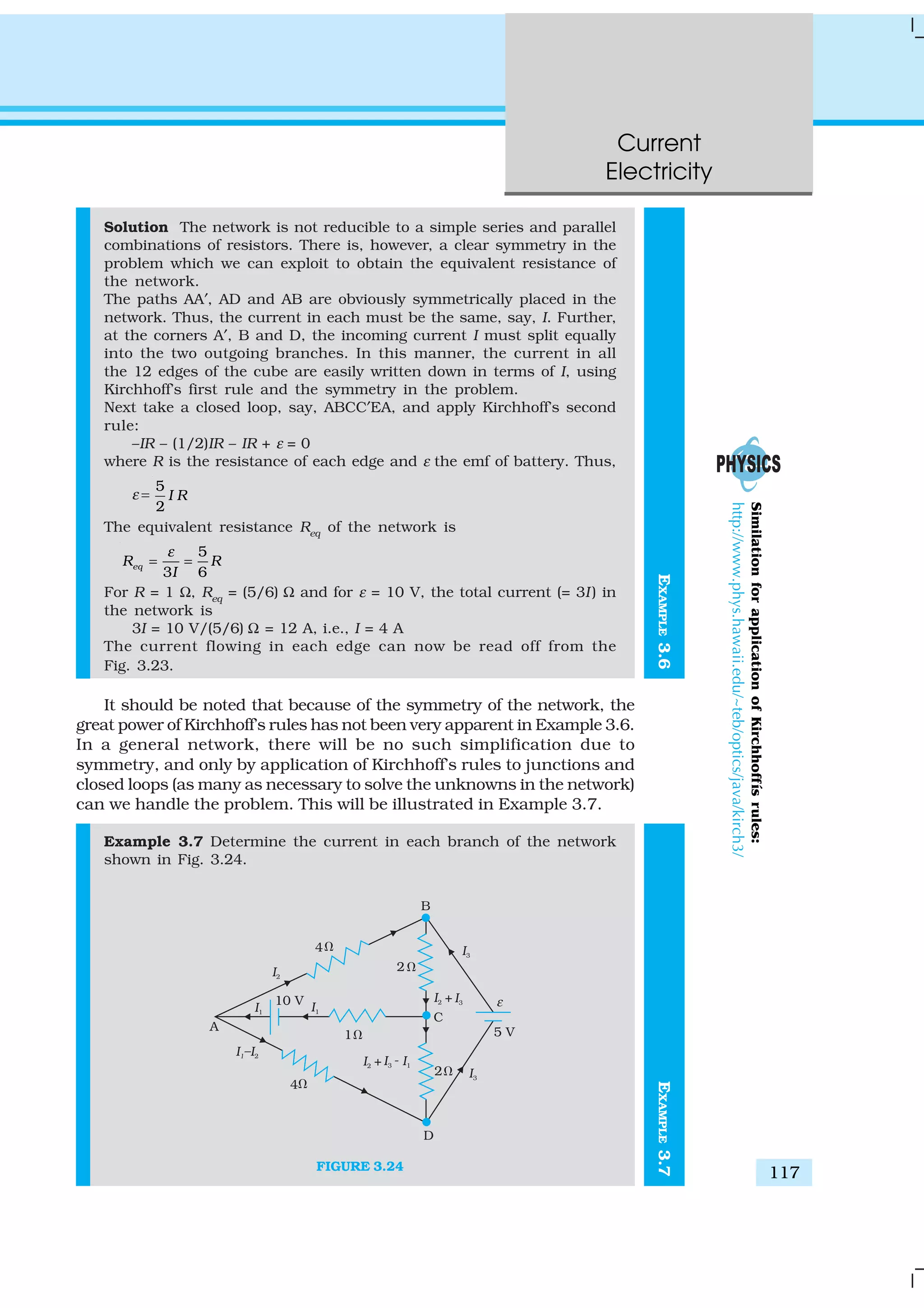
![Physics
118
EXAMPLE3.7
Solution Each branch of the network is assigned an unknown current
to be determined by the application of Kirchhoff’s rules. To reduce
the number of unknowns at the outset, the first rule of Kirchhoff is
used at every junction to assign the unknown current in each branch.
We then have three unknowns I1
, I2
and I3
which can be found by
applying the second rule of Kirchhoff to three different closed loops.
Kirchhoff’s second rule for the closed loop ADCA gives,
10 – 4(I1
– I2
) + 2(I2
+ I3
– I1
) – I1
= 0 [3.80(a)]
that is, 7I1
– 6I2
– 2I3
= 10
For the closed loop ABCA, we get
10 – 4I2
– 2 (I2
+ I3
) – I1
= 0
that is, I1
+ 6I2
+ 2I3
=10 [3.80(b)]
For the closed loop BCDEB, we get
5 – 2 (I2
+ I3
) – 2 (I2
+ I3
– I1
) = 0
that is, 2I1
– 4I2
– 4I3
= –5 [3.80(c)]
Equations (3.80 a, b, c) are three simultaneous equations in three
unknowns. These can be solved by the usual method to give
I1
= 2.5A, I2
=
5
8
A, I3
=
7
1
8
A
The currents in the various branches of the network are
AB :
5
8
A, CA :
1
2
2
A, DEB :
7
1
8
A
AD :
7
1
8
A, CD : 0 A, BC :
1
2
2
A
It is easily verified that Kirchhoff’s second rule applied to the
remaining closed loops does not provide any additional independent
equation, that is, the above values of currents satisfy the second
rule for every closed loop of the network. For example, the total voltage
drop over the closed loop BADEB
5 15
5 V 4 V 4 V
8 8
+ × − ×
equal to zero, as required by Kirchhoff’s second rule.
3.14 WHEATSTONE BRIDGE
As an application of Kirchhoff’s rules consider the circuit shown in
Fig. 3.25, which is called the Wheatstone bridge. The bridge has
four resistors R1, R2, R3 and R4. Across one pair of diagonally opposite
points (A and C in the figure) a source is connected. This (i.e., AC) is
called the battery arm. Between the other two vertices, B and D, a
galvanometer G (which is a device to detect currents) is connected. This
line, shown as BD in the figure, is called the galvanometer arm.
For simplicity, we assume that the cell has no internal resistance. In
general there will be currents flowing across all the resistors as well as a
current Ig through G. Of special interest, is the case of a balanced bridge
where the resistors are such that Ig
= 0. We can easily get the balance
condition, such that there is no current through G. In this case, the
Kirchhoff’s junction rule applied to junctions D and B (see the figure)](https://image.slidesharecdn.com/ncert-class-12-physics-part-1-161112171109/75/Ncert-class-12-physics-part-1-122-2048.jpg)
![Current
Electricity
119
immediately gives us the relations I1
= I3
and I2
= I4
. Next, we apply
Kirchhoff’s loop rule to closed loops ADBA and CBDC. The first
loop gives
–I1 R1 + 0 + I2 R2 = 0 (Ig = 0) (3.81)
and the second loop gives, upon using I3
= I1
, I4
= I2
I2
R4
+ 0 – I1
R3
= 0 (3.82)
From Eq. (3.81), we obtain,
1 2
2 1
I R
I R
=
whereas from Eq. (3.82), we obtain,
1 4
2 3
I R
I R
=
Hence, we obtain the condition
2 4
1 3
R R
R R
= [3.83(a)]
This last equation relating the four resistors is called the balance
condition for the galvanometer to give zero or null deflection.
The Wheatstone bridge and its balance condition provide a practical
method for determination of an unknown resistance. Let us suppose we
have an unknown resistance, which we insert in the fourth arm; R4
is
thus not known. Keeping known resistances R1
and R2
in the first and
second arm of the bridge, we go on varying R3
till the galvanometer shows
a null deflection. The bridge then is balanced, and from the balance
condition the value of the unknown resistance R4
is given by,
2
4 3
1
R
R R
R
= [3.83(b)]
A practical device using this principle is called the meter bridge. It
will be discussed in the next section.
Example 3.8 The four arms of a Wheatstone bridge (Fig. 3.26) have
the following resistances:
AB = 100Ω, BC = 10Ω, CD = 5Ω, and DA = 60Ω.
FIGURE 3.26
FIGURE 3.25
EXAMPLE3.8](https://image.slidesharecdn.com/ncert-class-12-physics-part-1-161112171109/75/Ncert-class-12-physics-part-1-123-2048.jpg)
![Physics
120
EXAMPLE3.8
A galvanometer of 15Ω resistance is connected across BD. Calculate
the current through the galvanometer when a potential difference of
10 V is maintained across AC.
Solution Considering the mesh BADB, we have
100I1
+ 15Ig
– 60I2
= 0
or 20I1
+ 3Ig
– 12I2
= 0 [3.84(a)]
Considering the mesh BCDB, we have
10 (I1
– Ig
) – 15Ig
– 5 (I2
+ Ig
) = 0
10I1
– 30Ig
–5I2
= 0
2I1
– 6Ig
– I2
= 0 [3.84(b)]
Considering the mesh ADCEA,
60I2
+ 5 (I2
+ Ig
) = 10
65I2
+ 5Ig
= 10
13I2
+ Ig
= 2 [3.84(c)]
Multiplying Eq. (3.84b) by 10
20I1
– 60Ig
– 10I2
= 0 [3.84(d)]
From Eqs. (3.84d) and (3.84a) we have
63Ig
– 2I2
= 0
I2
= 31.5Ig
[3.84(e)]
Substituting the value of I2
into Eq. [3.84(c)], we get
13 (31.5Ig
) + Ig
= 2
410.5 Ig
= 2
Ig
= 4.87 mA.
3.15 METER BRIDGE
The meter bridge is shown in Fig. 3.27. It consists of
a wire of length 1m and of uniform cross sectional
area stretched taut and clamped between two thick
metallic strips bent at right angles, as shown. The
metallic strip has two gaps across which resistors can
be connected. The end points where the wire is
clamped are connected to a cell through a key. One
end of a galvanometer is connected to the metallic
strip midway between the two gaps. The other end of
the galvanometer is connected to a ‘jockey’. The jockey
is essentially a metallic rod whose one end has a
knife-edge which can slide over the wire to make
electrical connection.
R is an unknown resistance whose value we want to determine. It is
connected across one of the gaps. Across the other gap, we connect a
FIGURE 3.27 A meter bridge. Wire AC
is 1 m long. R is a resistance to be
measured and S is a standard
resistance.](https://image.slidesharecdn.com/ncert-class-12-physics-part-1-161112171109/75/Ncert-class-12-physics-part-1-124-2048.jpg)
![Current
Electricity
121
standard known resistance S. The jockey is connected to some point D
on the wire, a distance l cm from the end A. The jockey can be moved
along the wire. The portion AD of the wire has a resistance Rcml, where
Rcm
is the resistance of the wire per unit centimetre. The portion DC of
the wire similarly has a resistance Rcm
(100-l).
The four arms AB, BC, DA and CD [with resistances R, S, Rcm l and
Rcm
(100-l)] obviously form a Wheatstone bridge with AC as the battery
arm and BD the galvanometer arm. If the jockey is moved along the wire,
then there will be one position where the galvanometer will show no
current. Let the distance of the jockey from the end A at the balance
point be l= l1
. The four resistances of the bridge at the balance point then
are R, S, Rcm l1 and Rcm(100–l1). The balance condition, Eq. [3.83(a)]
gives
( )
1 1
1 1100 – 100 –
cm
cm
R l lR
S R l l
= = (3.85)
Thus, once we have found out l1
, the unknown resistance R is known
in terms of the standard known resistance S by
1
1100 –
l
R S
l
= (3.86)
By choosing various values of S, we would get various values of l1
,
and calculate R each time. An error in measurement of l1 would naturally
result in an error in R. It can be shown that the percentage error in R can
be minimised by adjusting the balance point near the middle of the
bridge, i.e., when l1 is close to 50 cm. (This requires a suitable choice
of S.)
Example 3.9 In a metre bridge (Fig. 3.27), the null point is found at a
distance of 33.7 cm from A. If now a resistance of 12Ω is connected in
parallel with S, the null point occurs at 51.9 cm. Determine the values
of R and S.
Solution From the first balance point, we get
33.7
66.3
R
S
= (3.87)
After S is connected in parallel with a resistance of 12Ω , the resistance
across the gap changes from S to Seq
, where
12
12
eq
S
S
S
=
+
and hence the new balance condition now gives
( )1251.9
48.1 12eq
R SR
S S
+
= = (3.88)
Substituting the value of R/S from Eq. (3.87), we get
51.9 12 33.7
48.1 12 66.3
S +
= g
which gives S = 13.5Ω. Using the value of R/S above, we get
R = 6.86 Ω.
EXAMPLE3.9](https://image.slidesharecdn.com/ncert-class-12-physics-part-1-161112171109/75/Ncert-class-12-physics-part-1-125-2048.jpg)
![Physics
122
3.16 POTENTIOMETER
This is a versatile instrument. It is basically a long piece of uniform wire,
sometimes a few meters in length across which a standard cell is
connected. In actual design, the wire is sometimes cut in several pieces
placed side by side and connected at the ends by thick metal strip.
(Fig. 3.28). In the figure, the wires run from A to C. The small vertical
portions are the thick metal strips connecting the various sections of
the wire.
A current I flows through the wire which can be varied by a variable
resistance (rheostat, R) in the circuit. Since the wire is uniform, the
potential difference between A and any point at a distance l from A is
( )ε φ=l l (3.89)
where φ is the potential drop per unit length.
Figure 3.28 (a) shows an application of the potentiometer to compare
the emf of two cells of emf ε1
and ε2
. The points marked 1, 2, 3 form a two
way key. Consider first a position of the key where 1 and 3 are connected
so that the galvanometer is connected to ε1
. The jockey
is moved along the wire till at a point N1
, at a distance l1
from A, there is no deflection in the galvanometer. We
can apply Kirchhoff’s loop rule to the closed loop
AN1
G31A and get,
φ l1 + 0 – ε1 = 0 (3.90)
Similarly, if another emf ε2
is balanced against l2
(AN2
)
φ l2
+ 0 – ε2
= 0 (3.91)
From the last two equations
1 1
2 2
l
l
ε
ε
= (3.92)
This simple mechanism thus allows one to compare
the emf’s of any two sources. In practice one of the cells
is chosen as a standard cell whose emf is known to a
high degree of accuracy. The emf of the other cell is then
easily calculated from Eq. (3.92).
We can also use a potentiometer to measure internal
resistance of a cell [Fig. 3.28 (b)]. For this the cell (emf ε )
whose internal resistance (r) is to be determined is
connected across a resistance box through a key K2
, as
shown in the figure. With key K2
open, balance is
obtained at length l1 (AN1). Then,
ε = φ l1
[3.93(a)]
When key K2
is closed, the cell sends a current (I )
through the resistance box (R). If V is the terminal
potential difference of the cell and balance is obtained at
length l2
(AN2
),
V = φ l2
[3.93(b)]
FIGURE 3.28 A potentiometer. G is
a galvanometer and R a variable
resistance (rheostat). 1, 2, 3 are
terminals of a two way key
(a) circuit for comparing emfs of two
cells; (b) circuit for determining
internal resistance of a cell.](https://image.slidesharecdn.com/ncert-class-12-physics-part-1-161112171109/75/Ncert-class-12-physics-part-1-126-2048.jpg)
![Current
Electricity
123
So, we have ε/V = l1
/l2
[3.94(a)]
But, ε = I (r + R) and V = IR. This gives
ε/V = (r+R)/R [3.94(b)]
From Eq. [3.94(a)] and [3.94(b)] we have
(R+r)/R = l1
/l2
1
2
– 1
l
r R
l
=
(3.95)
Using Eq. (3.95) we can find the internal resistance of a given cell.
The potentiometer has the advantage that it draws no current from
the voltage source being measured. As such it is unaffected by the internal
resistance of the source.
Example 3.10 A resistance of R Ω draws current from a
potentiometer. The potentiometer has a total resistance R0
Ω
(Fig. 3.29). A voltage V is supplied to the potentiometer. Derive an
expression for the voltage across R when the sliding contact is in the
middle of the potentiometer.
FIGURE 3.29
Solution While the slide is in the middle of the potentiometer only
half of its resistance (R0
/2) will be between the points A and B. Hence,
the total resistance between A and B, say, R1
, will be given by the
following expression:
1 0
1 1 1
( /2)R R R
= +
0
1
0 2
R R
R
R R
=
+
The total resistance between A and C will be sum of resistance between
A and B and B and C, i.e., R1
+ R0
/2
∴ The current flowing through the potentiometer will be
1 0 1 0
2
/2 2
V V
I
R R R R
= =
+ +
The voltage V1
taken from the potentiometer will be the product of
current I and resistance R1
,
V1
= I R1
= 1
1 0
2
2
V
R
R R
× +
EXAMPLE3.10](https://image.slidesharecdn.com/ncert-class-12-physics-part-1-161112171109/75/Ncert-class-12-physics-part-1-127-2048.jpg)
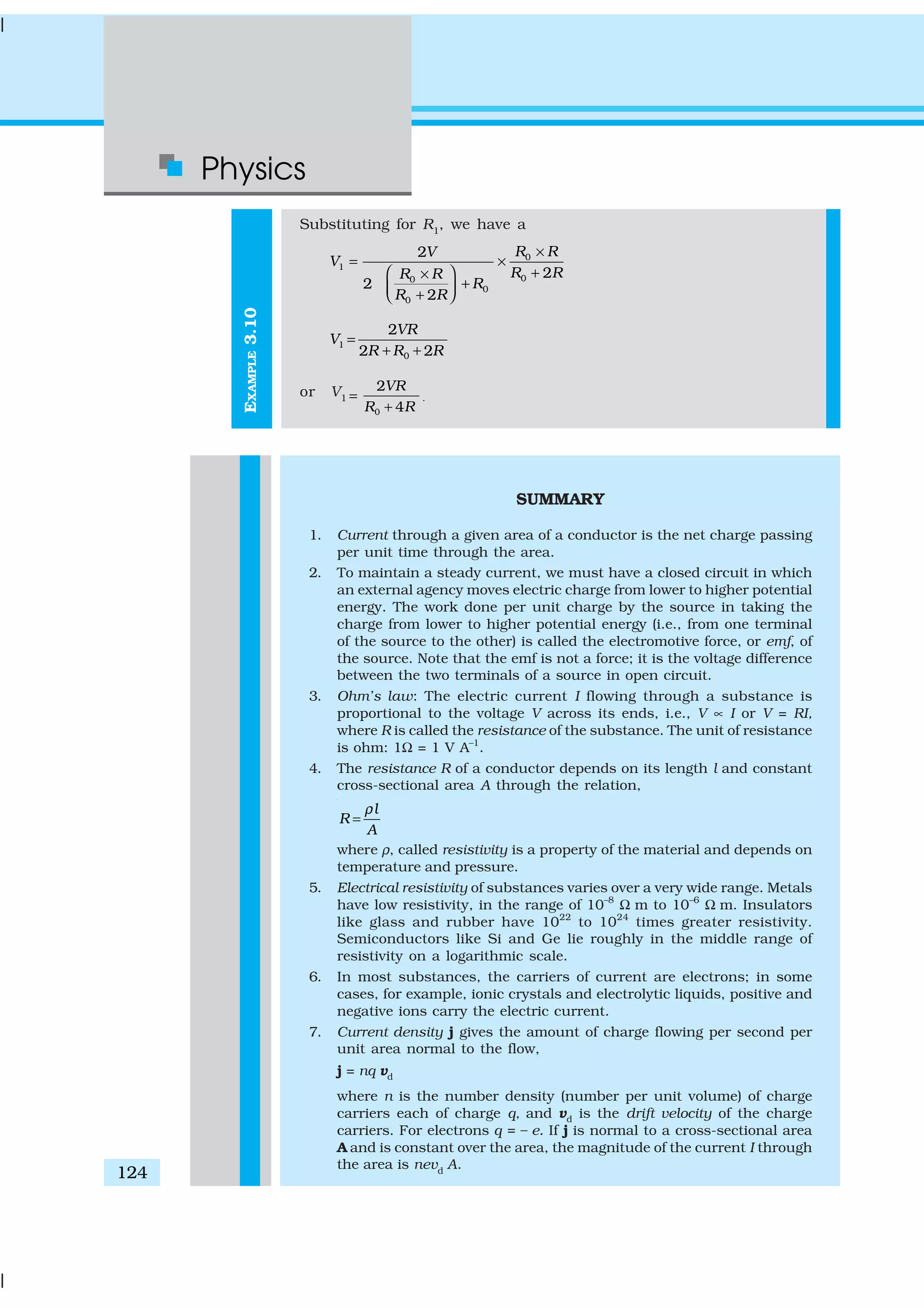
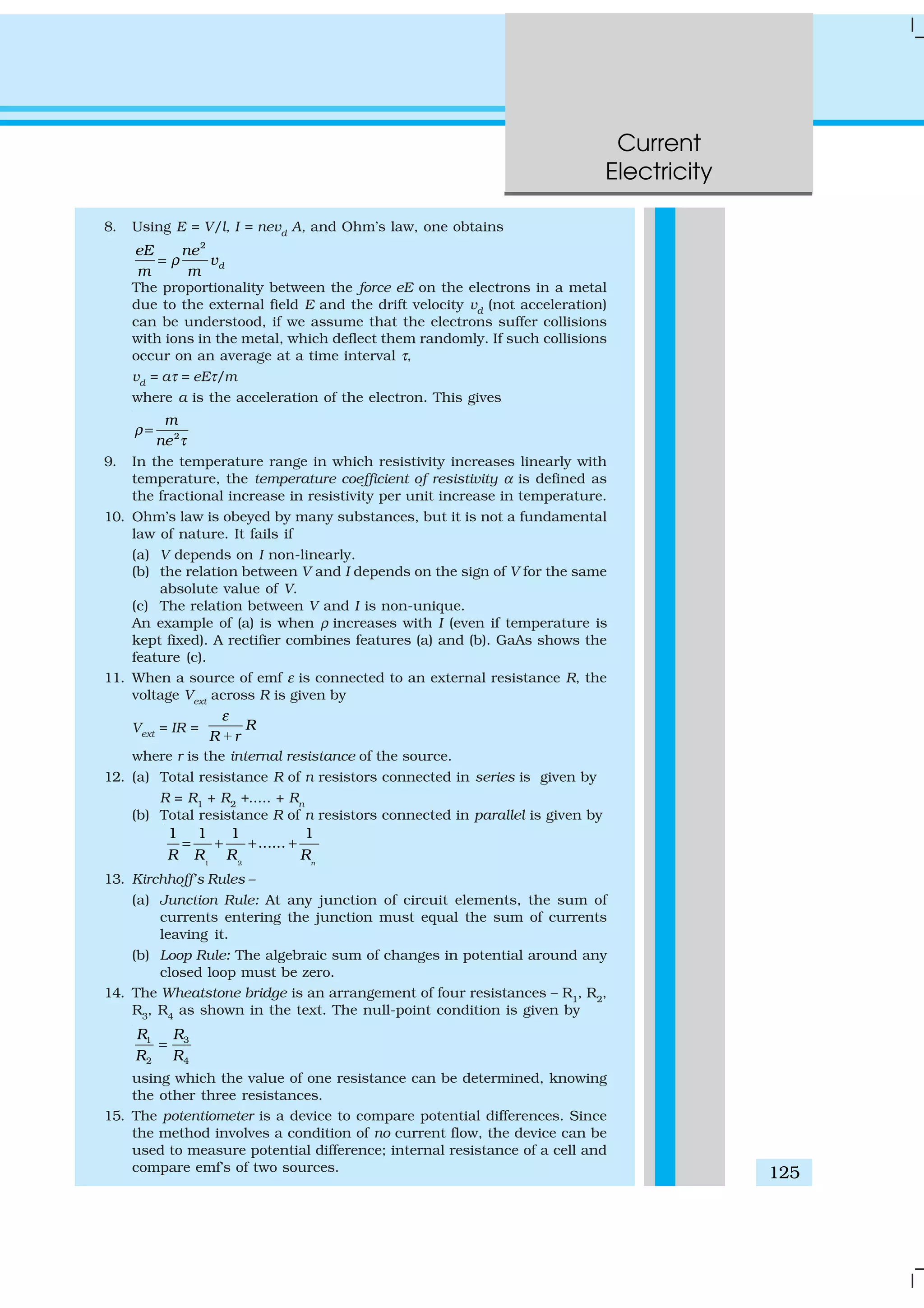
![Physics
126
POINTS TO PONDER
1. Current is a scalar although we represent current with an arrow.
Currents do not obey the law of vector addition. That current is a
scalar also follows from it’s definition. The current I through an area
of cross-section is given by the scalar product of two vectors:
I = j . ∆S
where j and ∆S are vectors.
2. Refer to V-I curves of a resistor and a diode as drawn in the text. A
resistor obeys Ohm’s law while a diode does not. The assertion that
V = IR is a statement of Ohm’s law is not true. This equation defines
resistance and it may be applied to all conducting devices whether
they obey Ohm’s law or not. The Ohm’s law asserts that the plot of I
versus V is linear i.e., R is independent of V.
Equation E = ρ j leads to another statement of Ohm’s law, i.e., a
conducting material obeys Ohm’s law when the resistivity of the
material does not depend on the magnitude and direction of applied
electric field.
3. Homogeneous conductors like silver or semiconductors like pure
germanium or germanium containing impurities obey Ohm’s law
within some range of electric field values. If the field becomes too
strong, there are departures from Ohm’s law in all cases.
4. Motion of conduction electrons in electric field E is the sum of (i)
motion due to random collisions and (ii) that due to E. The motion
Physical Quantity Symbol Dimensions Unit Remark
Electric current I [A] A SI base unit
Charge Q, q [T A] C
Voltage, Electric V [M L
2
T
–3
A
–1
] V Work/charge
potential difference
Electromotive force ε [M L
2
T
–3
A
–1
] V Work/charge
Resistance R [M L
2
T
–3
A
–2
] Ω R = V/I
Resistivity ρ [M L
3
T
–3
A
–2
] Ω m R = ρl/A
Electrical σ [M
–1
L
–3
T
3
A
2
] S σ = 1/ρ
conductivity
Electric field E [M L T
–3
A
–1
] V m
–1 Electric force
charge
Drift speed vd
[L T–1
] m s–1
vd
e E
m
=
τ
Relaxation time τ [T] s
Current density j [L
–2
A] A m
–2
current/area
Mobility µ [M L
3
T
–4
A
–1
] m
2
V
–1
s
–1
/dv E](https://image.slidesharecdn.com/ncert-class-12-physics-part-1-161112171109/75/Ncert-class-12-physics-part-1-130-2048.jpg)
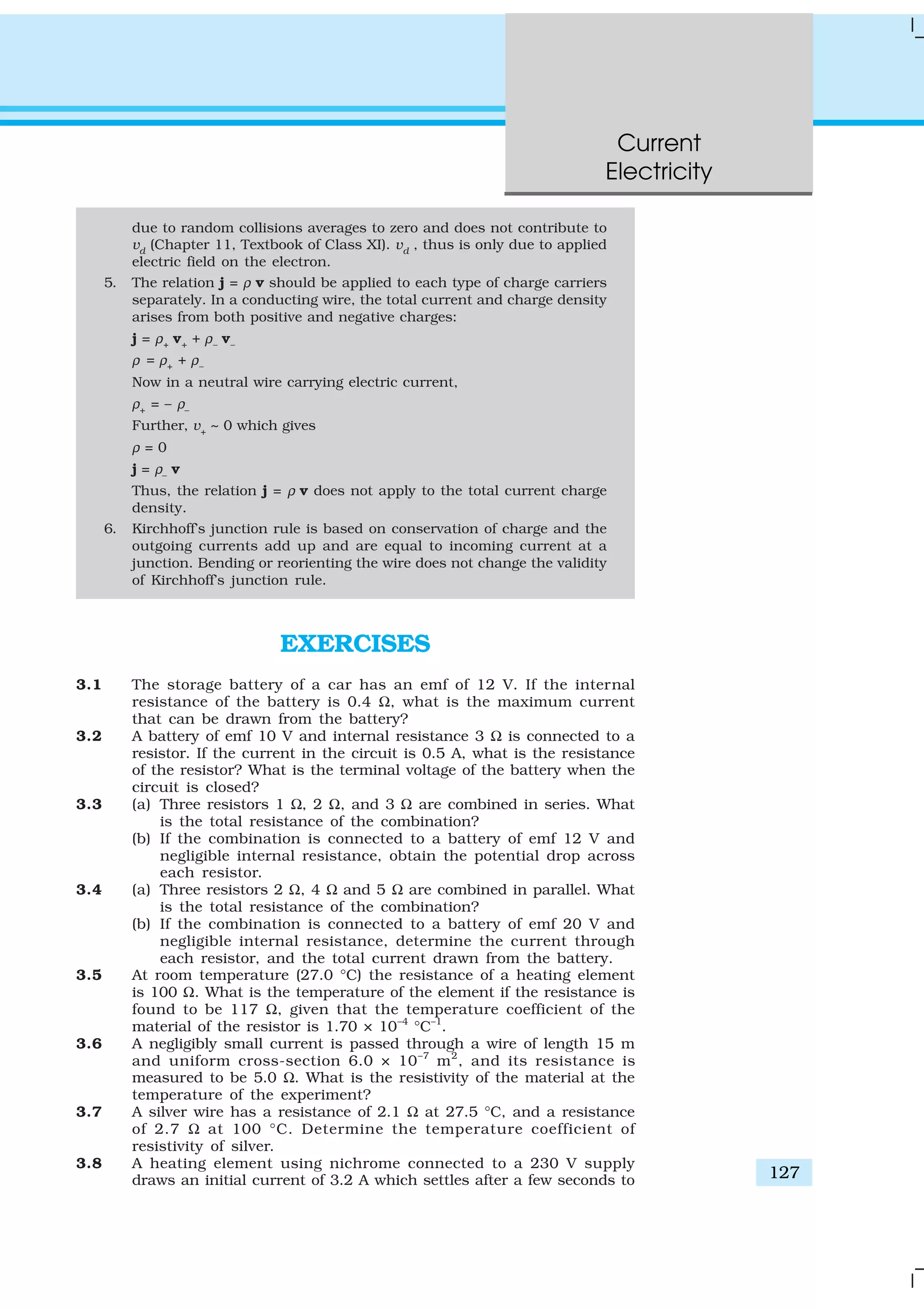
![Physics
128
a steady value of 2.8 A. What is the steady temperature of the heating
element if the room temperature is 27.0 °C? Temperature coefficient
of resistance of nichrome averaged over the temperature range
involved is 1.70 × 10–4
°C–1
.
3.9 Determine the current in each branch of the network shown in
Fig. 3.30:
FIGURE 3.30
3.10 (a) In a metre bridge [Fig. 3.27], the balance point is found to be at
39.5 cm from the end A, when the resistor Y is of 12.5 Ω.
Determine the resistance of X. Why are the connections between
resistors in a Wheatstone or meter bridge made of thick copper
strips?
(b) Determine the balance point of the bridge above if X and Y are
interchanged.
(c) What happens if the galvanometer and cell are interchanged at
the balance point of the bridge? Would the galvanometer show
any current?
3.11 A storage battery of emf 8.0 V and internal resistance 0.5 Ω is being
charged by a 120 V dc supply using a series resistor of 15.5 Ω. What
is the terminal voltage of the battery during charging? What is the
purpose of having a series resistor in the charging circuit?
3.12 In a potentiometer arrangement, a cell of emf 1.25 V gives a balance
point at 35.0 cm length of the wire. If the cell is replaced by another
cell and the balance point shifts to 63.0 cm, what is the emf of the
second cell?
3. 13 The number density of free electrons in a copper conductor
estimated in Example 3.1 is 8.5 × 1028
m–3
. How long does an electron
take to drift from one end of a wire 3.0 m long to its other end? The
area of cross-section of the wire is 2.0 × 10–6
m2
and it is carrying a
current of 3.0 A.
ADDITIONAL EXERCISES
3. 14 The earth’s surface has a negative surface charge density of 10–9
C
m–2
. The potential difference of 400 kV between the top of the
atmosphere and the surface results (due to the low conductivity of
the lower atmosphere) in a current of only 1800 A over the entire
globe. If there were no mechanism of sustaining atmospheric electric](https://image.slidesharecdn.com/ncert-class-12-physics-part-1-161112171109/75/Ncert-class-12-physics-part-1-132-2048.jpg)
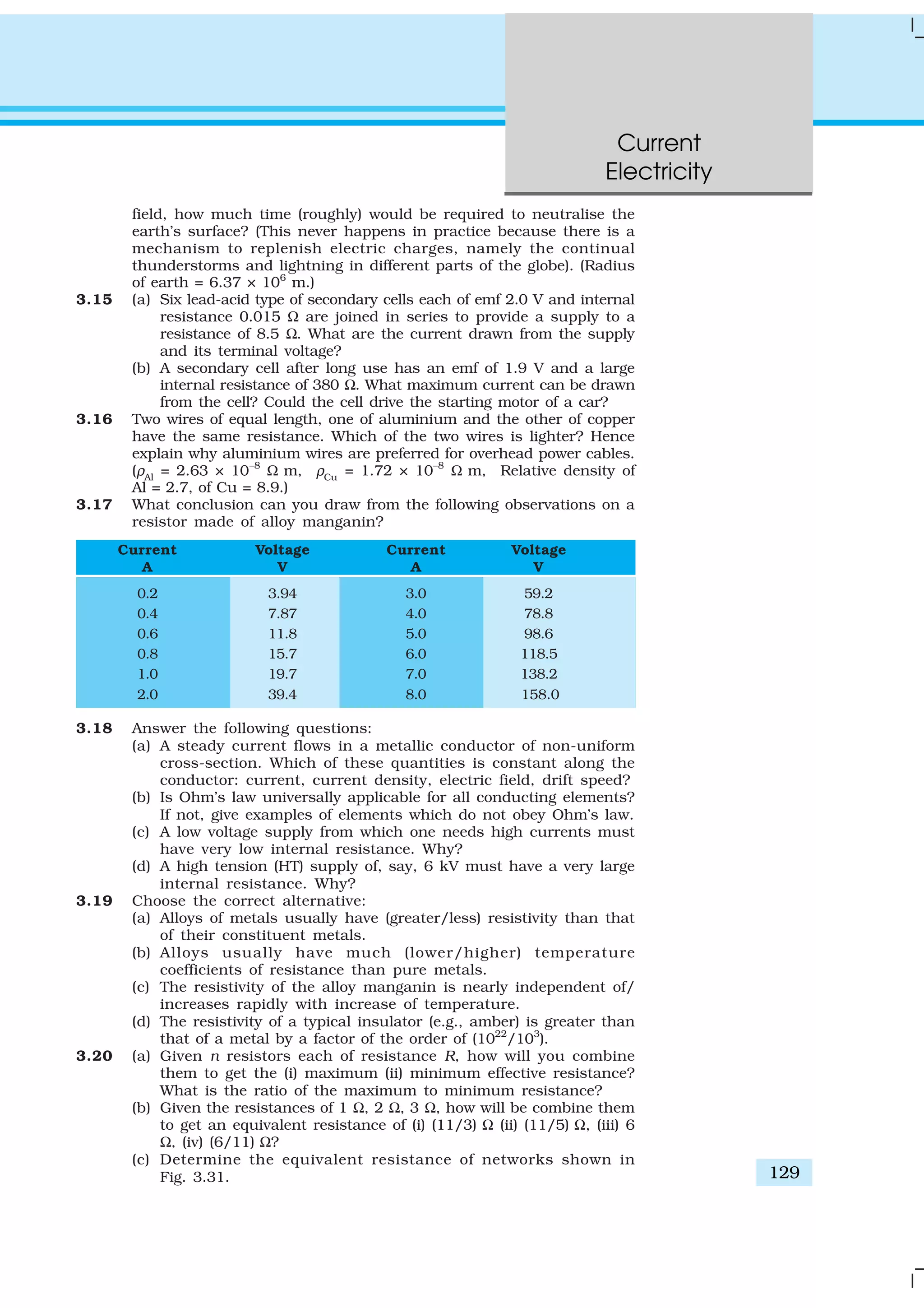
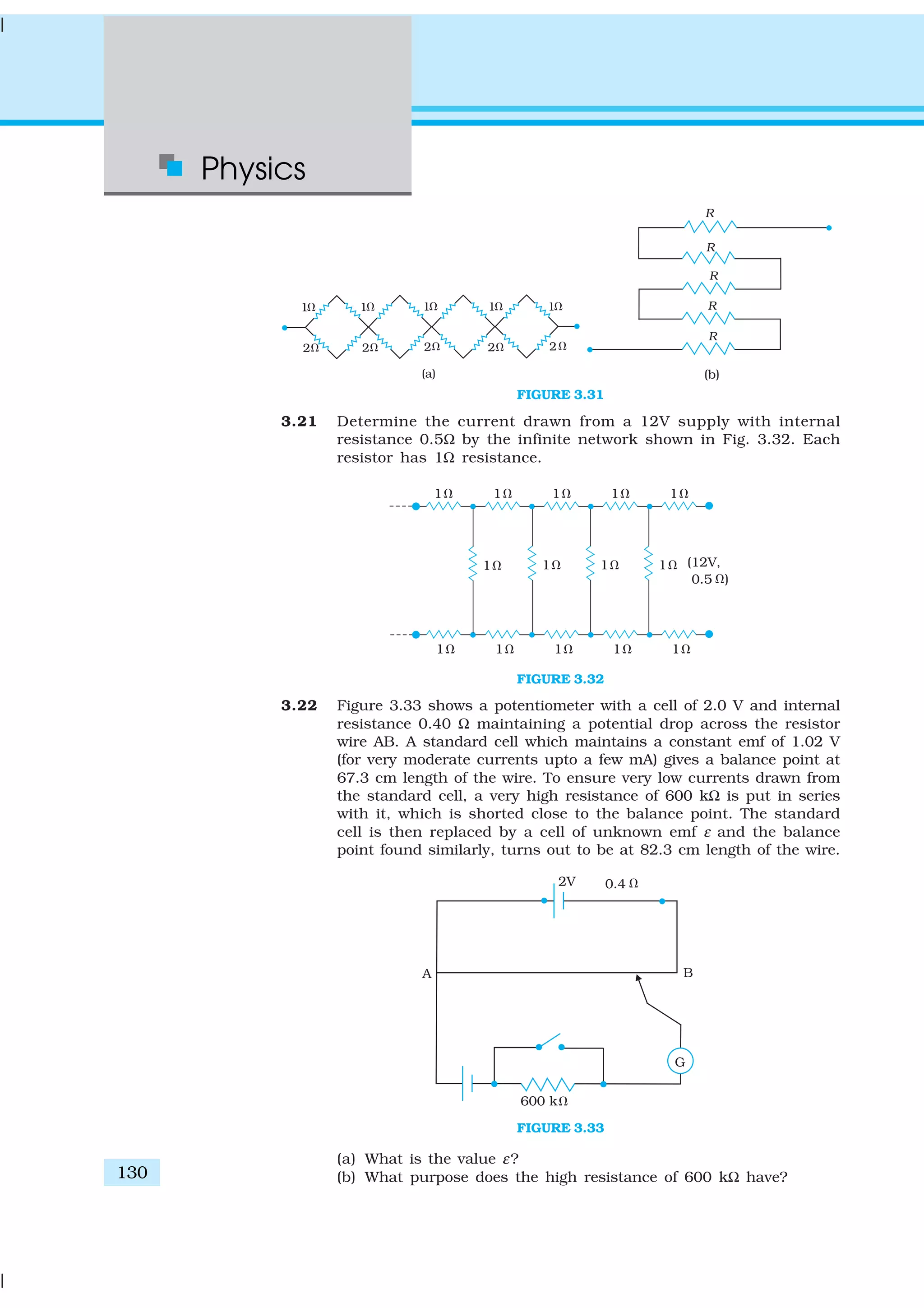
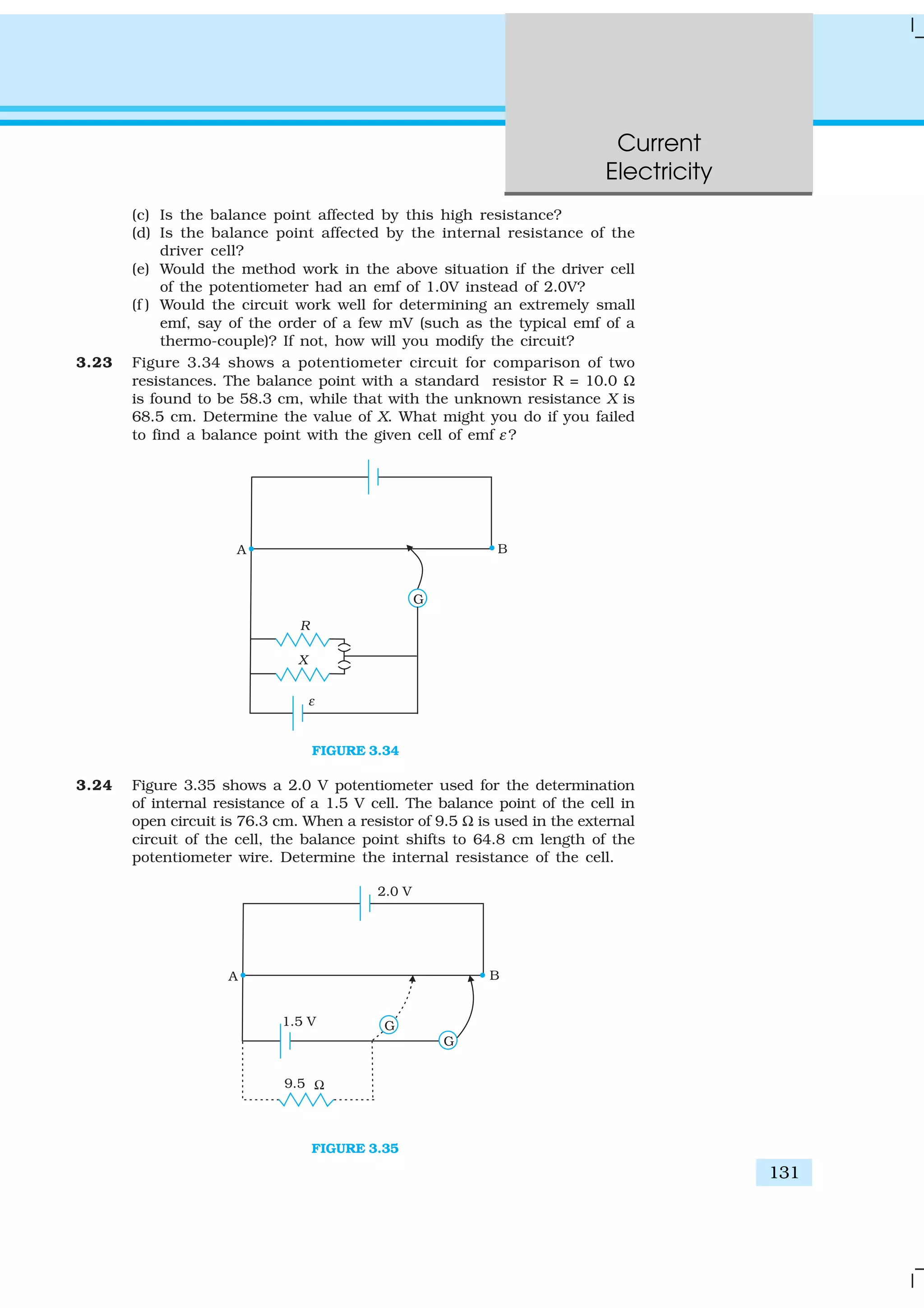
![4.1 INTRODUCTION
Both Electricity and Magnetism have been known for more than 2000
years. However, it was only about 200 years ago, in 1820, that it was
realised that they were intimately related*. During a lecture demonstration
in the summer of 1820, the Danish physicist Hans Christian Oersted
noticed that a current in a straight wire caused a noticeable deflection in
a nearby magnetic compass needle. He investigated this phenomenon.
He found that the alignment of the needle is tangential to an imaginary
circle which has the straight wire as its centre and has its plane
perpendicular to the wire. This situation is depicted in Fig.4.1(a). It is
noticeable when the current is large and the needle sufficiently close to
the wire so that the earth’s magnetic field may be ignored. Reversing the
direction of the current reverses the orientation of the needle [Fig. 4.1(b)].
The deflection increases on increasing the current or bringing the needle
closer to the wire. Iron filings sprinkled around the wire arrange
themselves in concentric circles with the wire as the centre [Fig. 4.1(c)].
Oersted concluded that moving charges or currents produced a
magnetic field in the surrounding space.
Following this there was intense experimentation. In 1864, the laws
obeyed by electricity and magnetism were unified and formulated by
Chapter Four
MOVING CHARGES
AND MAGNETISM
* See the box in Chapter 1, Page 3.](https://image.slidesharecdn.com/ncert-class-12-physics-part-1-161112171109/75/Ncert-class-12-physics-part-1-136-2048.jpg)
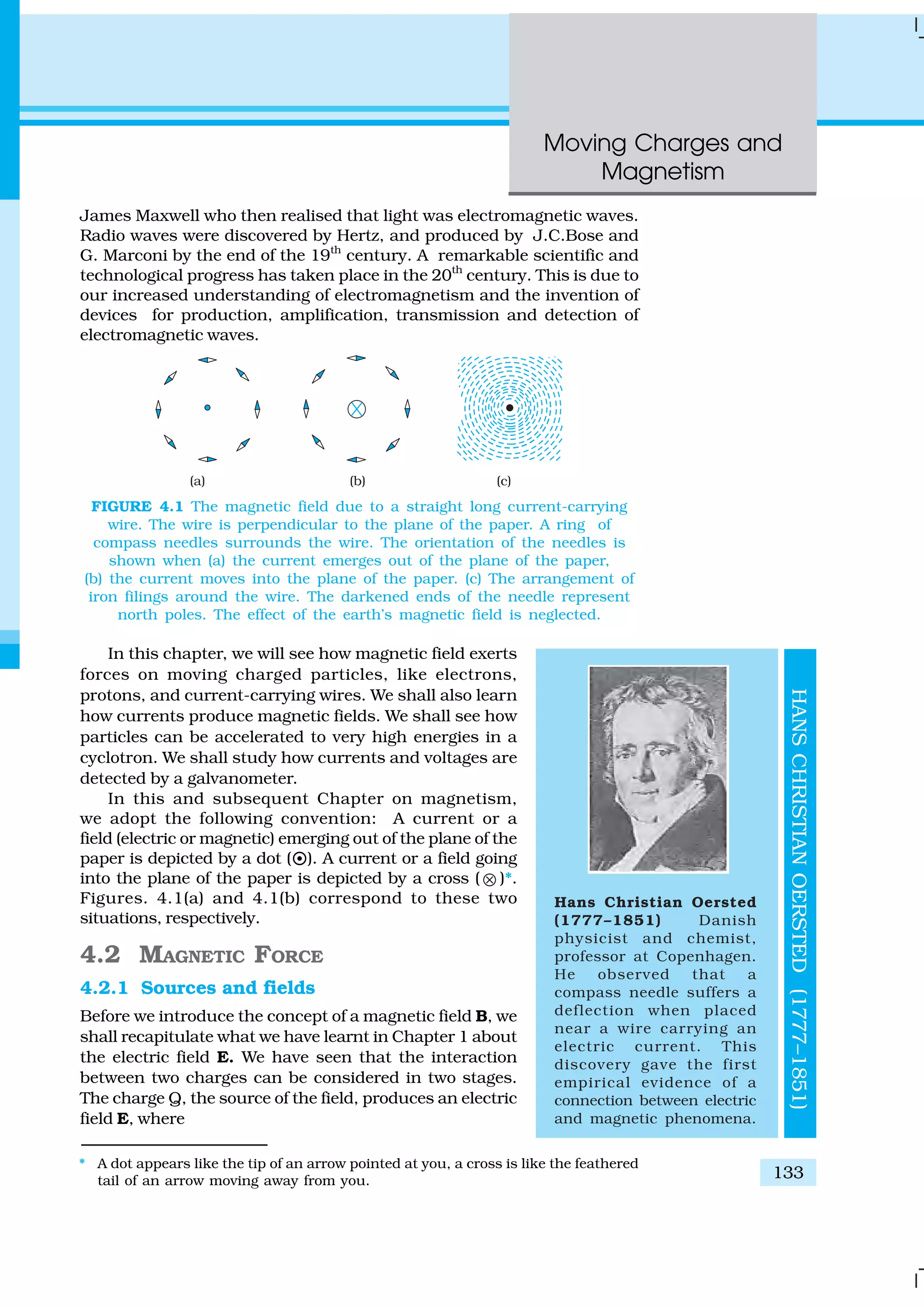
![Physics
134
E = Q ˆr / (4πε0
)r2
(4.1)
where ˆr is unit vector along r, and the field E is a vector
field. A charge q interacts with this field and experiences
a force F given by
F = q E = q Q ˆr / (4πε0
) r2
(4.2)
As pointed out in the Chapter 1, the field E is not
just an artefact but has a physical role. It can convey
energy and momentum and is not established
instantaneously but takes finite time to propagate. The
concept of a field was specially stressed by Faraday and
was incorporated by Maxwell in his unification of
electricity and magnetism. In addition to depending on
each point in space, it can also vary with time, i.e., be a
function of time. In our discussions in this chapter, we
will assume that the fields do not change with time.
The field at a particular point can be due to one or
more charges. If there are more charges the fields add
vectorially. You have already learnt in Chapter 1 that this
is called the principle of superposition. Once the field is
known, the force on a test charge is given by Eq. (4.2).
Just as static charges produce an electric field, the
currents or moving charges produce (in addition) a
magnetic field, denoted by B (r), again a vector field. It
has several basic properties identical to the electric field.
It is defined at each point in space (and can in addition
depend on time). Experimentally, it is found to obey the
principle of superposition: the magnetic field of several
sources is the vector addition of magnetic field of each
individual source.
4.2.2 Magnetic Field, Lorentz Force
Let us suppose that there is a point charge q (moving
with a velocity v and, located at r at a given time t) in
presence of both the electric field E (r) and the magnetic
field B (r). The force on an electric charge q due to both of
them can be written as
F = q [ E (r) + v × B (r)] ≡ Felectric
+Fmagnetic
(4.3)
This force was given first by H.A. Lorentz based on the extensive
experiments of Ampere and others. It is called the Lorentz force. You
have already studied in detail the force due to the electric field. If we
look at the interaction with the magnetic field, we find the following
features.
(i) It depends on q, v and B (charge of the particle, the velocity and the
magnetic field). Force on a negative charge is opposite to that on a
positive charge.
(ii) The magnetic force q [ v × B ] includes a vector product of velocity
and magnetic field. The vector product makes the force due to magnetic
HENDRIKANTOONLORENTZ(1853–1928)
Hendrik Antoon Lorentz
(1853 – 1928) Dutch
theoretical physicist,
professor at Leiden. He
investigated the
relationship between
electricity, magnetism, and
mechanics. In order to
explain the observed effect
of magnetic fields on
emitters of light (Zeeman
effect), he postulated the
existence of electric charges
in the atom, for which he
was awarded the Nobel Prize
in 1902. He derived a set of
transformation equations
(known after him, as
Lorentz transformation
equations) by some tangled
mathematical arguments,
but he was not aware that
these equations hinge on a
new concept of space and
time.](https://image.slidesharecdn.com/ncert-class-12-physics-part-1-161112171109/75/Ncert-class-12-physics-part-1-138-2048.jpg)
![Moving Charges and
Magnetism
135
field vanish (become zero) if velocity and magnetic field are parallel
or anti-parallel. The force acts in a (sideways) direction perpendicular
to both the velocity and the magnetic field.
Its direction is given by the screw rule or
right hand rule for vector (or cross) product
as illustrated in Fig. 4.2.
(iii) The magnetic force is zero if charge is not
moving (as then |v|= 0). Only a moving
charge feels the magnetic force.
The expression for the magnetic force helps
us to define the unit of the magnetic field, if
one takes q, F and v, all to be unity in the force
equation F = q [ v × B] =q v B sin θ ˆn , where θ
is the angle between v and B [see Fig. 4.2 (a)].
The magnitude of magnetic field B is 1 SI unit,
when the force acting on a unit charge (1 C),
moving perpendicular to B with a speed 1m/s,
is one newton.
Dimensionally, we have [B] = [F/qv] and the unit
of B are Newton second / (coulomb metre). This
unit is called tesla (T) named after Nikola Tesla
(1856 – 1943). Tesla is a rather large unit. A smaller unit (non-SI) called
gauss (=10–4
tesla) is also often used. The earth’s magnetic field is about
3.6 × 10–5
T. Table 4.1 lists magnetic fields over a wide range in the
universe.
FIGURE 4.2 The direction of the magnetic
force acting on a charged particle. (a) The
force on a positively charged particle with
velocity v and making an angle θ with the
magnetic field B is given by the right-hand
rule. (b) A moving charged particle q is
deflected in an opposite sense to –q in the
presence of magnetic field.
TABLE 4.1 ORDER OF MAGNITUDES OF MAGNETIC FIELDS IN A VARIETY OF PHYSICAL SITUATIONS
Physical situation Magnitude of B (in tesla)
Surface of a neutron star 108
Typical large field in a laboratory 1
Near a small bar magnet 10–2
On the earth’s surface 10–5
Human nerve fibre 10–10
Interstellar space 10–12
4.2.3 Magnetic force on a current-carrying conductor
We can extend the analysis for force due to magnetic field on a single
moving charge to a straight rod carrying current. Consider a rod of a
uniform cross-sectional area A and length l. We shall assume one kind
of mobile carriers as in a conductor (here electrons). Let the number
density of these mobile charge carriers in it be n. Then the total number
of mobile charge carriers in it is nAl. For a steady current I in this
conducting rod, we may assume that each mobile carrier has an average](https://image.slidesharecdn.com/ncert-class-12-physics-part-1-161112171109/75/Ncert-class-12-physics-part-1-139-2048.jpg)
![Physics
136
EXAMPLE4.1
drift velocity vd
(see Chapter 3). In the presence of an external magnetic
field B, the force on these carriers is:
F = (nAl)q vd
× B
where q is the value of the charge on a carrier. Now nqvd
is the current
density j and |(nq vd
)|A is the current I (see Chapter 3 for the discussion
of current and current density). Thus,
F = [(nqevd
)Al] × B = [ jAl ] × B
= I1 × B (4.4)
where l is a vector of magnitude l, the length of the rod, and with a direction
identical to the current I. Note that the current I is not a vector. In the last
step leading to Eq. (4.4), we have transferred the vector sign from j to l.
Equation (4.4) holds for a straight rod. In this equation, B is the external
magnetic field. It is not the field produced by the current-carrying rod. If
the wire has an arbitrary shape we can calculate the Lorentz force on it
by considering it as a collection of linear strips dlj
and summing
d j
j
I= ∑F l × B
This summation can be converted to an integral in most cases.
ON PERMITTIVITY AND PERMEABILITY
In the universal law of gravitation, we say that any two point masses exert a force on
each other which is proportional to the product of the masses m1
, m2
and inversely
proportional to the square of the distance r between them. We write it as F = Gm1
m2
/r2
where G is the universal constant of gravitation. Similarly in Coulomb’s law of electrostatics
we write the force between two point charges q1
, q2
, separated by a distance r as
F = kq1
q2
/r2
where k is a constant of proportionality. In SI units, k is taken as
1/4πε where ε is the permittivity of the medium. Also in magnetism, we get another
constant, which in SI units, is taken as µ/4π where µ is the permeability of the medium.
Although G, ε and µ arise as proportionality constants, there is a difference between
gravitational force and electromagnetic force. While the gravitational force does not depend
on the intervening medium, the electromagnetic force depends on the medium between
the two charges or magnets. Hence while G is a universal constant, ε and µ depend on
the medium. They have different values for different media. The product εµ turns out to
be related to the speed v of electromagnetic radiation in the medium through εµ =1/ v 2
.
Electric permittivity ε is a physical quantity that describes how an electric field affects
and is affected by a medium. It is determined by the ability of a material to polarise in
response to an applied field, and thereby to cancel, partially, the field inside the material.
Similarly, magnetic permeability µ is the ability of a substance to acquire magnetisation in
magnetic fields. It is a measure of the extent to which magnetic field can penetrate matter.
Example 4.1 A straight wire of mass 200 g and length 1.5 m carries
a current of 2 A. It is suspended in mid-air by a uniform horizontal
magnetic field B (Fig. 4.3). What is the magnitude of the magnetic
field?](https://image.slidesharecdn.com/ncert-class-12-physics-part-1-161112171109/75/Ncert-class-12-physics-part-1-140-2048.jpg)
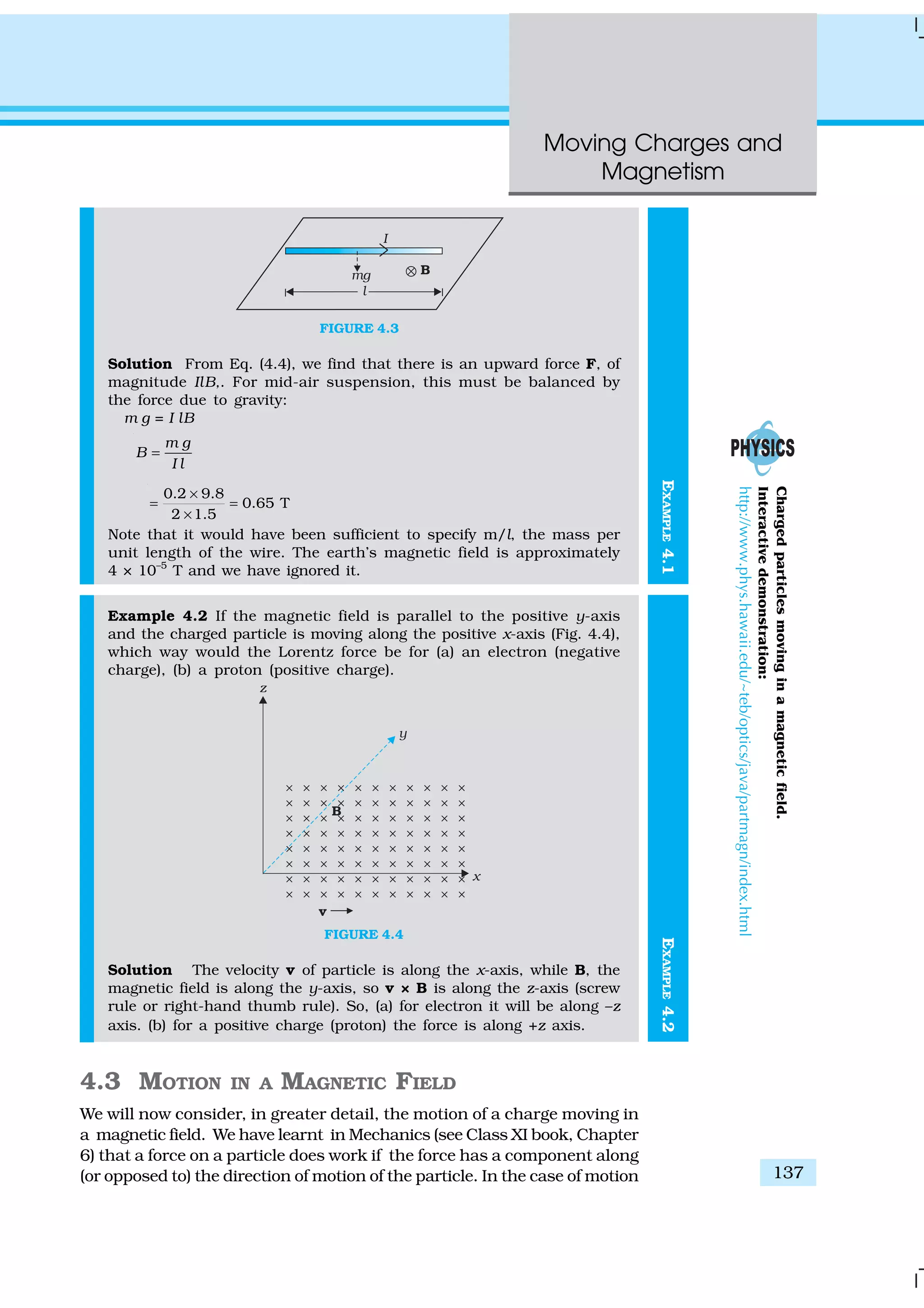
![Physics
138
of a charge in a magnetic field, the magnetic force is
perpendicular to the velocity of the particle. So no work is done
and no change in the magnitude of the velocity is produced
(though the direction of momentum may be changed). [Notice
that this is unlike the force due to an electric field, qE, which
can have a component parallel (or antiparallel) to motion and
thus can transfer energy in addition to momentum.]
We shall consider motion of a charged particle in a uniform
magnetic field. First consider the case of v perpendicular to B.
The perpendicular force, q v × B, acts as a centripetal force and
produces a circular motion perpendicular to the magnetic field.
The particle will describe a circle if v and B are perpendicular
to each other (Fig. 4.5).
If velocity has a component along B, this component
remains unchanged as the motion along the magnetic field will
not be affected by the magnetic field. The motion
in a plane perpendicular to B is as before a
circular one, thereby producing a helical motion
(Fig. 4.6).
You have already learnt in earlier classes
(See Class XI, Chapter 4) that if r is the radius
of the circular path of a particle, then a force of
m v2
/ r, acts perpendicular to the path towards
the centre of the circle, and is called the
centripetal force. If the velocity v is
perpendicular to the magnetic field B, the
magnetic force is perpendicular to both v and
B and acts like a centripetal force. It has a
magnitude q v B. Equating the two expressions
for centripetal force,
m v 2
/r = q v B, which gives
r = m v / qB (4.5)
for the radius of the circle described by the
charged particle. The larger the momentum,
the larger is the radius and bigger the circle described. If ω is the angular
frequency, then v = ω r. So,
ω = 2π ν = q B/ m [4.6(a)]
which is independent of the velocity or energy . Here ν is the frequency of
rotation. The independence of ν from energy has important application
in the design of a cyclotron (see Section 4.4.2).
The time taken for one revolution is T= 2π/ω ≡ 1/ν. If there is a
component of the velocity parallel to the magnetic field (denoted by v||
), it
will make the particle move along the field and the path of the particle
would be a helical one (Fig. 4.6). The distance moved along the magnetic
field in one rotation is called pitch p. Using Eq. [4.6 (a)], we have
p = v||
T = 2πm v||
/ q B [4.6(b)]
The radius of the circular component of motion is called the radius of
the helix.
FIGURE 4.5 Circular motion
FIGURE 4.6 Helical motion](https://image.slidesharecdn.com/ncert-class-12-physics-part-1-161112171109/75/Ncert-class-12-physics-part-1-142-2048.jpg)

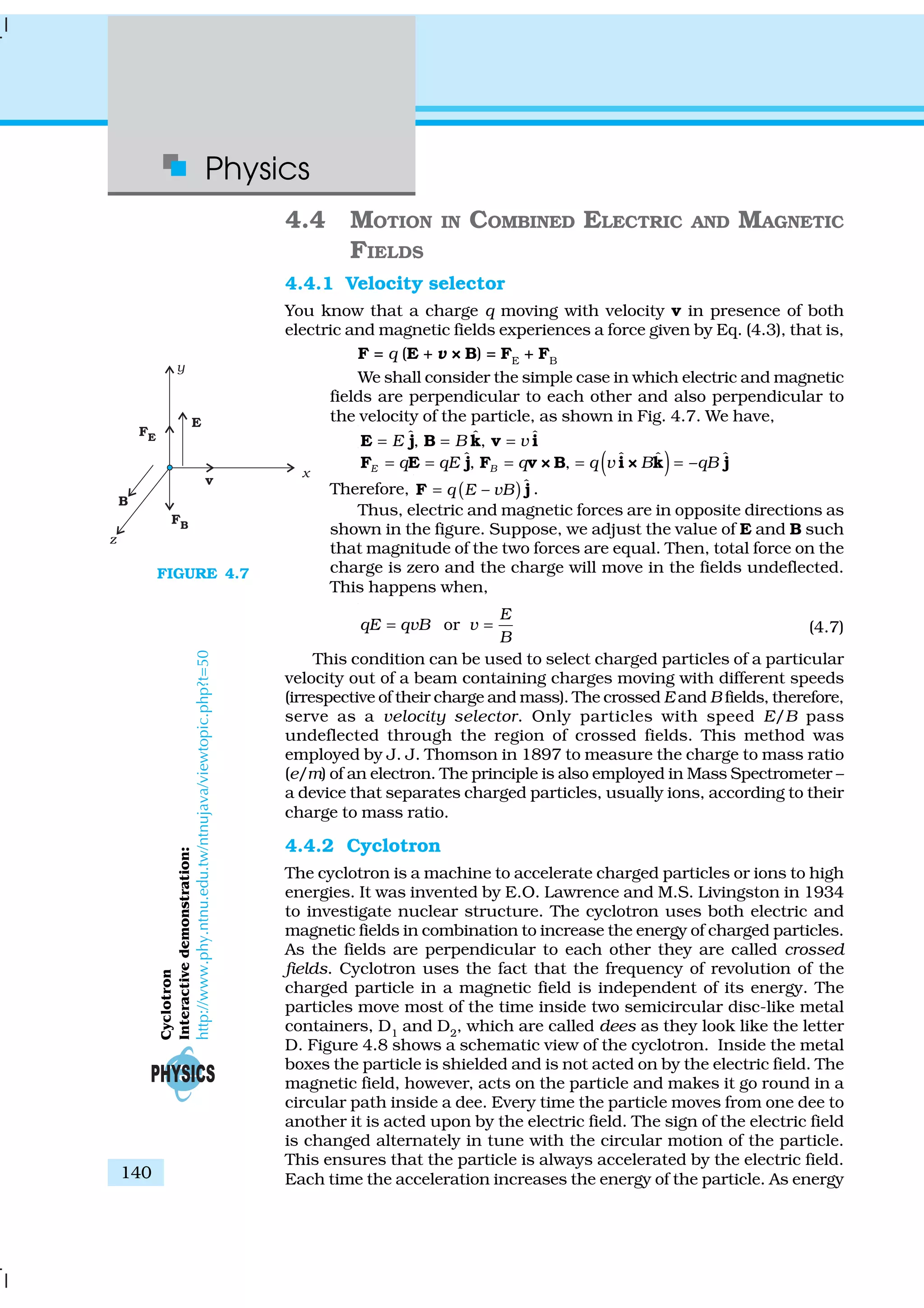

![Physics
142
EXAMPLE4.4
the resulting nuclear reactions. It is also used to implant ions into solids
and modify their properties or even synthesise new materials. It is used
in hospitals to produce radioactive substances which can be used in
diagnosis and treatment.
Example 4.4 A cyclotron’s oscillator frequency is 10 MHz. What
should be the operating magnetic field for accelerating protons? If
the radius of its ‘dees’ is 60 cm, what is the kinetic energy (in MeV) of
the proton beam produced by the accelerator.
(e =1.60 × 10–19
C, mp
= 1.67 × 10–27
kg, 1 MeV = 1.6 × 10–13
J).
Solution The oscillator frequency should be same as proton’s
cyclotron frequency.
Using Eqs. (4.5) and [4.6(a)] we have
B = 2π m ν/q =6.3 ×1.67 × 10–27
× 107
/ (1.6 × 10–19
) = 0.66 T
Final velocity of protons is
v = r × 2π ν = 0.6 m × 6.3 ×107
= 3.78 × 107
m/s.
E = ½ mv 2
= 1.67 ×10–27
× 14.3 × 1014
/ (2 × 1.6 × 10–13
) = 7 MeV.
ACCELERATORS IN INDIA
India has been an early entrant in the area of accelerator- based research. The vision of
Dr. Meghnath Saha created a 37" Cyclotron in the Saha Institute of Nuclear Physics in
Kolkata in 1953. This was soon followed by a series of Cockroft-Walton type of accelerators
established in Tata Institute of Fundamental Research (TIFR), Mumbai, Aligarh Muslim
University (AMU), Aligarh, Bose Institute, Kolkata and Andhra University, Waltair.
The sixties saw the commissioning of a number of Van de Graaff accelerators: a 5.5 MV
terminal machine in Bhabha Atomic Research Centre (BARC), Mumbai (1963); a 2 MV terminal
machine in Indian Institute of Technology (IIT), Kanpur; a 400 kV terminal machine in Banaras
Hindu University (BHU), Varanasi; and Punjabi University, Patiala. One 66 cm Cyclotron
donated by the Rochester University of USA was commissioned in Panjab University,
Chandigarh. A small electron accelerator was also established in University of Pune, Pune.
In a major initiative taken in the seventies and eighties, a Variable Energy Cyclotron was
built indigenously in Variable Energy Cyclotron Centre (VECC), Kolkata; 2 MV Tandem Van
de Graaff accelerator was developed and built in BARC and a 14 MV Tandem Pelletron
accelerator was installed in TIFR.
This was soon followed by a 15 MV Tandem Pelletron established by University Grants
Commission (UGC), as an inter-university facility in Inter-University Accelerator Centre
(IUAC), New Delhi; a 3 MV Tandem Pelletron in Institute of Physics, Bhubaneshwar; and
two 1.7 MV Tandetrons in Atomic Minerals Directorate for Exploration and Research,
Hyderabad and Indira Gandhi Centre for Atomic Research, Kalpakkam. Both TIFR and
IUAC are augmenting their facilities with the addition of superconducting LINAC modules
to accelerate the ions to higher energies.
Besides these ion accelerators, the Department of Atomic Energy (DAE) has developed
many electron accelerators. A 2 GeV Synchrotron Radiation Source is being built in Raja
Ramanna Centre for Advanced Technologies, Indore.
The Department of Atomic Energy is considering Accelerator Driven Systems (ADS) for
power production and fissile material breeding as future options.](https://image.slidesharecdn.com/ncert-class-12-physics-part-1-161112171109/75/Ncert-class-12-physics-part-1-146-2048.jpg)
![Moving Charges and
Magnetism
143
4.5 MAGNETIC FIELD DUE TO A CURRENT ELEMENT,
BIOT-SAVART LAW
All magnetic fields that we know are due to currents (or moving charges)
and due to intrinsic magnetic moments of particles. Here, we shall study
the relation between current and the magnetic field it produces.
It is given by the Biot-Savart’s law. Figure 4.9 shows a finite
conductor XY carrying current I. Consider an infinitesimal
element dl of the conductor. The magnetic field dB due to this
element is to be determined at a point P which is at a distance r
from it. Let θ be the angle between dl and the displacement vector
r. According to Biot-Savart’s law, the magnitude of the magnetic
field dB is proportional to the current I, the element length |dl|,
and inversely proportional to the square of the distance r. Its
direction* is perpendicular to the plane containing dl and r .
Thus, in vector notation,
3
I d
d
r
×
∝
l r
B
0
3
4
I d
r
µ ×
=
π
l r
[4.11(a)]
where µ0
/4π is a constant of proportionality. The above
expression holds when the medium is vacuum.
The magnitude of this field is,
0
2
d sin
d
4
I l
r
µ θ
=
π
B [4.11(b)]
where we have used the property of cross-product. Equation [4.11 (a)]
constitutes our basic equation for the magnetic field. The proportionality
constant in SI units has the exact value,
70
10 Tm/A
4
µ −
=
π
[4.11(c)]
We call µ0
the permeability of free space (or vacuum).
The Biot-Savart law for the magnetic field has certain similarities as
well as differences with the Coulomb’s law for the electrostatic field. Some
of these are:
(i) Both are long range, since both depend inversely on the square of
distance from the source to the point of interest. The principle of
superposition applies to both fields. [In this connection, note that
the magnetic field is linear in the source I dl just as the electrostatic
field is linear in its source: the electric charge.]
(ii) The electrostatic field is produced by a scalar source, namely, the
electric charge. The magnetic field is produced by a vector source
I dl.
* The sense of dl×r is also given by the Right Hand Screw rule : Look at the plane
containing vectors dl and r. Imagine moving from the first vector towards second
vector. If the movement is anticlockwise, the resultant is towards you. If it is
clockwise, the resultant is away from you.
FIGURE 4.9 Illustration of
the Biot-Savart law. The
current element I dl
produces a field dB at a
distance r. The ⊗ sign
indicates that the
field is perpendicular
to the plane of this
page and directed
into it.](https://image.slidesharecdn.com/ncert-class-12-physics-part-1-161112171109/75/Ncert-class-12-physics-part-1-147-2048.jpg)
![Physics
144
EXAMPLE4.5
(iii) The electrostatic field is along the displacement vector joining the
source and the field point. The magnetic field is perpendicular to the
plane containing the displacement vector rand the current element
I dl.
(iv) There is an angle dependence in the Biot-Savart law which is not
present in the electrostatic case. In Fig. 4.9, the magnetic field at any
point in the direction of dl (the dashed line) is zero. Along this line,
θ = 0, sin θ = 0 and from Eq. [4.11(a)], |dB| = 0.
There is an interesting relation between ε0
, the permittivity of free
space; µ0
, the permeability of free space; and c, the speed of light in
vacuum:
( ) 0
0 0 04
4
µ
ε µ ε
= π π
( )7
9
1
10
9 10
−
= × 8 2 2
1 1
(3 10 ) c
= =
×
We will discuss this connection further in Chapter 8 on the
electromagnetic waves. Since the speed of light in vacuum is constant,
the product µ0
ε0
is fixed in magnitude. Choosing the value of either ε0
or
µ0
, fixes the value of the other. In SI units, µ0
is fixed to be equal to
4π × 10–7
in magnitude.
Example 4.5 An element ˆx∆ = ∆l i is placed at the origin and carries
a large current I = 10 A (Fig. 4.10). What is the magnetic field on the
y-axis at a distance of 0.5 m. ∆x = 1 cm.
FIGURE 4.10
Solution
0
2
d sin
|d |
4
I l
r
µ θ
=
π
B [using Eq. (4.11)]
2
d 10 ml x −
= ∆ = , I = 10 A, r = 0.5 m = y, 7
0
T m
/4 10
A
µ −
π =
θ = 90° ; sin θ = 1
7 2
2
10 10 10
d
25 10
− −
−
× ×
=
×
B = 4 × 10–8
T
The direction of the field is in the +z-direction. This is so since,
ˆ ˆd x y= ∆l × i × jr ( )ˆ ˆy x= ∆ i × j ˆy x= ∆ k
We remind you of the following cyclic property of cross-products,
ˆ ˆ ˆ ˆ ˆ ˆ ˆ ˆ ˆ; ;× = × = × =i j k j k i k i j
Note that the field is small in magnitude.](https://image.slidesharecdn.com/ncert-class-12-physics-part-1-161112171109/75/Ncert-class-12-physics-part-1-148-2048.jpg)
![Moving Charges and
Magnetism
145
In the next section, we shall use the Biot-Savart law to calculate the
magnetic field due to a circular loop.
4.6 MAGNETIC FIELD ON THE AXIS OF A CIRCULAR
CURRENT LOOP
In this section, we shall evaluate the magnetic field due to a circular coil
along its axis. The evaluation entails summing up the effect of infinitesimal
current elements (I dl) mentioned in the previous section.
We assume that the current I is steady and that the
evaluation is carried out in free space (i.e., vacuum).
Figure 4.11 depicts a circular loop carrying a steady
current I. The loop is placed in the y-z plane with its
centre at the origin O and has a radius R. The x-axis is
the axis of the loop. We wish to calculate the magnetic
field at the point P on this axis. Let x be the distance of
P from the centre O of the loop.
Consider a conducting element dl of the loop. This is
shown in Fig. 4.11. The magnitude dB of the magnetic
field due to dl is given by the Biot-Savart law [Eq. 4.11(a)],
0
3
4
I d
dB
r
µ
π
=
l × r
(4.12)
Now r2
= x2
+ R2
. Further, any element of the loop
will be perpendicular to the displacement vector from
the element to the axial point. For example, the element
dl in Fig. 4.11 is in the y-z plane whereas the
displacement vector r from dl to the axial point P is in
the x-y plane. Hence |dl × r|=r dl. Thus,
( )ð
0
2 2
d
d
4
I l
B
x R
µ
=
+ (4.13)
The direction of dB is shown in Fig. 4.11. It is perpendicular to the
plane formed by dl and r. It has an x-component dBx
and a component
perpendicular to x-axis, dB⊥
. When the components perpendicular to
the x-axis are summed over, they cancel out and we obtain a null result.
For example, the dB⊥
component due to dl is cancelled by the
contribution due to the diametrically opposite dl element, shown in
Fig. 4.11. Thus, only the x-component survives. The net contribution
along x-direction can be obtained by integrating dBx
= dB cos θ over the
loop. For Fig. 4.11,
2 2 1/2
cos
( )
R
x R
θ =
+
(4.14)
From Eqs. (4.13) and (4.14),
( )ð
0
3/22 2
d
d
4
x
I l R
B
x R
µ
=
+
FIGURE 4.11 Magnetic field on the
axis of a current carrying circular
loop of radius R. Shown are the
magnetic field dB (due to a line
element dl ) and its
components along and
perpendicular to the axis.](https://image.slidesharecdn.com/ncert-class-12-physics-part-1-161112171109/75/Ncert-class-12-physics-part-1-149-2048.jpg)
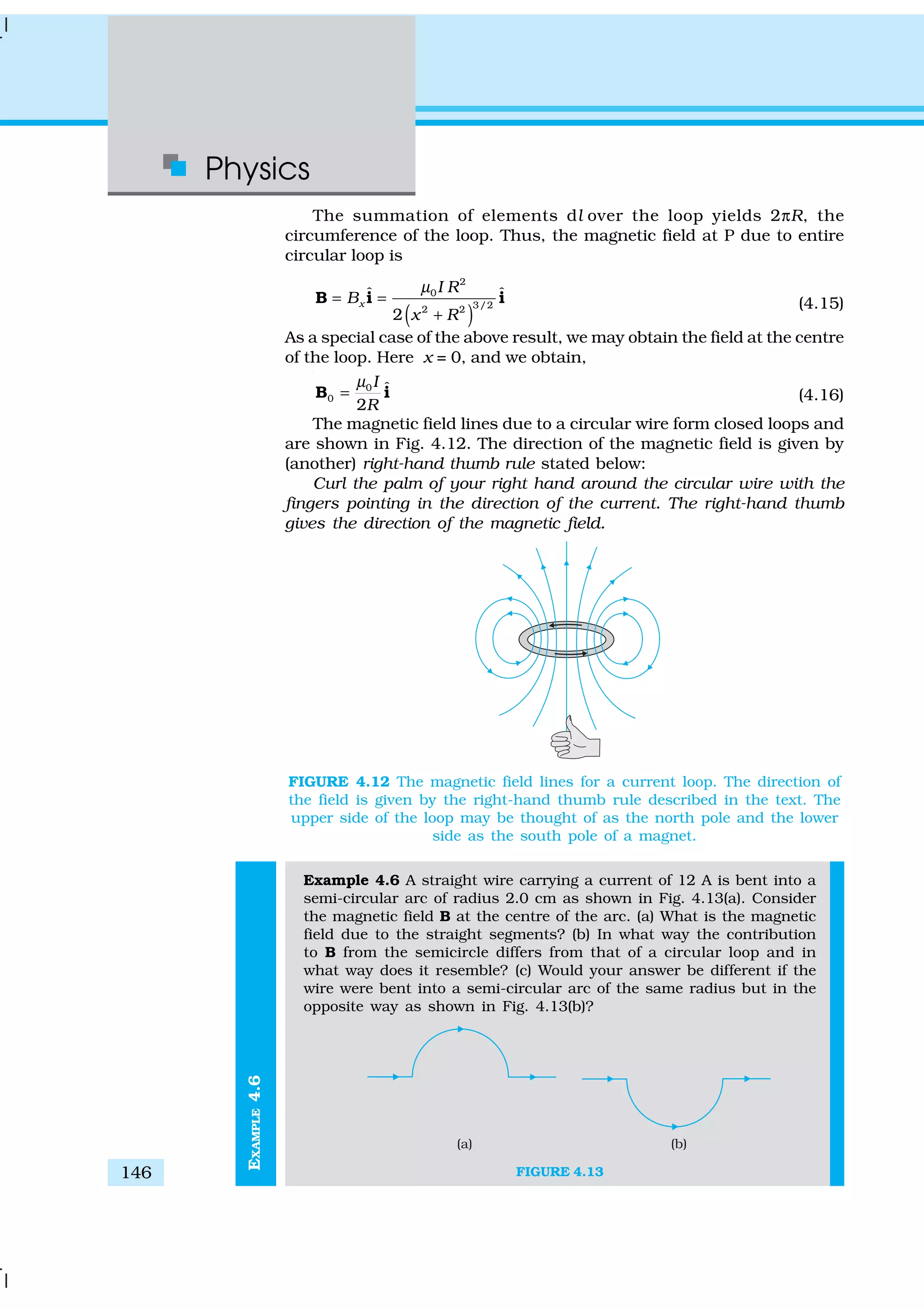
![Moving Charges and
Magnetism
147
EXAMPLE4.6
Solution
(a) dl and r for each element of the straight segments are parallel.
Therefore, dl × r = 0. Straight segments do not contribute to
|B|.
(b) For all segments of the semicircular arc, dl × r are all parallel to
each other (into the plane of the paper). All such contributions
add up in magnitude. Hence direction of B for a semicircular arc
is given by the right-hand rule and magnitude is half that of a
circular loop. Thus B is 1.9 × 10–4
T normal to the plane of the
paper going into it.
(c) Same magnitude of B but opposite in direction to that in (b).
Example 4.7 Consider a tightly wound 100 turn coil of radius 10 cm,
carrying a current of 1 A. What is the magnitude of the magnetic
field at the centre of the coil?
Solution Since the coil is tightly wound, we may take each circular
element to have the same radius R = 10 cm = 0.1 m. The number of
turns N = 100. The magnitude of the magnetic field is,
–7 2
0
–1
4 10 10 1
2 2 10
NI
B
R
µ π × × ×
= =
×
4
2 10−
= π ×
4
6 28 10 T. −
= ×
4.7 AMPERE’S CIRCUITAL LAW
There is an alternative and appealing way in which the Biot-Savart law
may be expressed. Ampere’s circuital law considers an open surface
with a boundary (Fig. 4.14). The surface has current passing
through it. We consider the boundary to be made up of a number
of small line elements. Consider one such element of length dl. We
take the value of the tangential component of the magnetic field,
Bt
, at this element and multiply it by the length of that element dl
[Note: Bt
dl=B.dl]. All such products are added together. We
consider the limit as the lengths of elements get smaller and their
number gets larger. The sum then tends to an integral. Ampere’s
law states that this integral is equal to µ0
times the total current
passing through the surface, i.e.,
0d Iµ=∫ B lgÑ [4.17(a)]
where I is the total current through the surface. The integral is taken
over the closed loop coinciding with the boundary C of the surface. The
relation above involves a sign-convention, given by the right-hand rule.
Let the fingers of the right-hand be curled in the sense the boundary is
traversed in the loop integral “B.dl. Then the direction of the thumb
gives the sense in which the current I is regarded as positive.
For several applications, a much simplified version of Eq. [4.17(a)]
proves sufficient. We shall assume that, in such cases, it is possible to
choose the loop (called an amperian loop) such that at each point of the
loop, either
FIGURE 4.14
EXAMPLE4.7](https://image.slidesharecdn.com/ncert-class-12-physics-part-1-161112171109/75/Ncert-class-12-physics-part-1-151-2048.jpg)
![Physics
148
(i) B is tangential to the loop and is a non-zero constant
B, or
(ii) B is normal to the loop, or
(iii) B vanishes.
Now, let L be the length (part) of the loop for which B
is tangential. Let Ie
be the current enclosed by the loop.
Then, Eq. (4.17) reduces to,
BL =µ0
Ie
[4.17(b)]
When there is a system with a symmetry such as for
a straight infinite current-carrying wire in Fig. 4.15, the
Ampere’s law enables an easy evaluation of the magnetic
field, much the same way Gauss’ law helps in
determination of the electric field. This is exhibited in the
Example 4.8 below. The boundary of the loop chosen is
a circle and magnetic field is tangential to the
circumference of the circle. The law gives, for the left hand
side of Eq. [4.17 (b)], B. 2πr. We find that the magnetic
field at a distance r outside the wire is tangential and
given by
B × 2πr = µ0
I,
B = µ0
I/ (2πr) (4.18)
The above result for the infinite wire is interesting
from several points of view.
(i) It implies that the field at every point on a circle of
radius r, (with the wire along the axis), is same in
magnitude. In other words, the magnetic field
possesses what is called a cylindrical symmetry. The
field that normally can depend on three coordinates
depends only on one: r. Whenever there is symmetry,
the solutions simplify.
(ii) The field direction at any point on this circle is
tangential to it. Thus, the lines of constant magnitude
of magnetic field form concentric circles. Notice now,
in Fig. 4.1(c), the iron filings form concentric circles.
These lines called magnetic field lines form closed
loops. This is unlike the electrostatic field lines which
originate from positive charges and end at negative
charges. The expression for the magnetic field of a
straight wire provides a theoretical justification to
Oersted’s experiments.
(iii) Another interesting point to note is that even though
the wire is infinite, the field due to it at a nonzero
distance is not infinite. It tends to blow up only when
we come very close to the wire. The field is directly
proportional to the current and inversely proportional
to the distance from the (infinitely long) current
source.
ANDREAMPERE(1775–1836)
Andre Ampere (1775 –
1836) Andre Marie Ampere
was a French physicist,
mathematician and
chemist who founded the
science of electrodynamics.
Ampere was a child prodigy
who mastered advanced
mathematics by the age of
12. Ampere grasped the
significance of Oersted’s
discovery. He carried out a
large series of experiments
to explore the relationship
between current electricity
and magnetism. These
investigations culminated
in 1827 with the
publication of the
‘Mathematical Theory of
Electrodynamic Pheno-
mena Deduced Solely from
Experiments’. He hypo-
thesised that all magnetic
phenomena are due to
circulating electric
currents. Ampere was
humble and absent-
minded. He once forgot an
invitation to dine with the
Emperor Napoleon. He died
of pneumonia at the age of
61. His gravestone bears
the epitaph: Tandem Felix
(Happy at last).](https://image.slidesharecdn.com/ncert-class-12-physics-part-1-161112171109/75/Ncert-class-12-physics-part-1-152-2048.jpg)
![Moving Charges and
Magnetism
149
EXAMPLE4.8
(iv) There exists a simple rule to determine the direction of the magnetic
field due to a long wire. This rule, called the right-hand rule*, is:
Grasp the wire in your right hand with your extended thumb pointing
in the direction of the current. Your fingers will curl around in the
direction of the magnetic field.
Ampere’s circuital law is not new in content from Biot-Savart law.
Both relate the magnetic field and the current, and both express the same
physical consequences of a steady electrical current. Ampere’s law is to
Biot-Savart law, what Gauss’s law is to Coulomb’s law. Both, Ampere’s
and Gauss’s law relate a physical quantity on the periphery or boundary
(magnetic or electric field) to another physical quantity, namely, the source,
in the interior (current or charge). We also note that Ampere’s circuital
law holds for steady currents which do not fluctuate with time. The
following example will help us understand what is meant by the term
enclosed current.
Example 4.8 Figure 4.15 shows a long straight wire of a circular
cross-section (radius a) carrying steady current I. The current I is
uniformly distributed across this cross-section. Calculate the
magnetic field in the region r < a and r > a.
FIGURE 4.15
Solution (a) Consider the case r > a. The Amperian loop, labelled 2,
is a circle concentric with the cross-section. For this loop,
L = 2 π r
Ie
= Current enclosed by the loop = I
The result is the familiar expression for a long straight wire
B (2π r) = µ0
I
ð
0
2
I
B
r
µ
= [4.19(a)]
1
B
r
∝ (r > a)
(b) Consider the case r < a. The Amperian loop is a circle labelled 1.
For this loop, taking the radius of the circle to be r,
L = 2 π r
* Note that there are two distinct right-hand rules: One which gives the direction
of B on the axis of current-loop and the other which gives direction of B
for a straight conducting wire. Fingers and thumb play different roles in
the two.](https://image.slidesharecdn.com/ncert-class-12-physics-part-1-161112171109/75/Ncert-class-12-physics-part-1-153-2048.jpg)
![Physics
150
EXAMPLE4.8
Now the current enclosed Ie
is not I, but is less than this value.
Since the current distribution is uniform, the current enclosed is,
2
2e
r
I I
a
π
= π
2
2
Ir
a
=
Using Ampere’s law, ð
2
0 2
(2 )
I r
B r
a
µ=
ð
0
2
2
I
B r
a
µ
= [4.19(b)]
B ∝ r (r < a)
FIGURE 4.16
Figure (4.16) shows a plot of the magnitude of B with distance r
from the centre of the wire. The direction of the field is tangential to
the respective circular loop (1 or 2) and given by the right-hand
rule described earlier in this section.
This example possesses the required symmetry so that Ampere’s
law can be applied readily.
It should be noted that while Ampere’s circuital law holds for any
loop, it may not always facilitate an evaluation of the magnetic field in
every case. For example, for the case of the circular loop discussed in
Section 4.6, it cannot be applied to extract the simple expression
B = µ0
I/2R [Eq. (4.16)] for the field at the centre of the loop. However,
there exists a large number of situations of high symmetry where the law
can be conveniently applied. We shall use it in the next section to calculate
the magnetic field produced by two commonly used and very useful
magnetic systems: the solenoid and the toroid.
4.8 THE SOLENOID AND THE TOROID
The solenoid and the toroid are two pieces of equipment which generate
magnetic fields. The television uses the solenoid to generate magnetic
fields needed. The synchrotron uses a combination of both to generate
the high magnetic fields required. In both, solenoid and toroid, we come
across a situation of high symmetry where Ampere’s law can be
conveniently applied.](https://image.slidesharecdn.com/ncert-class-12-physics-part-1-161112171109/75/Ncert-class-12-physics-part-1-154-2048.jpg)
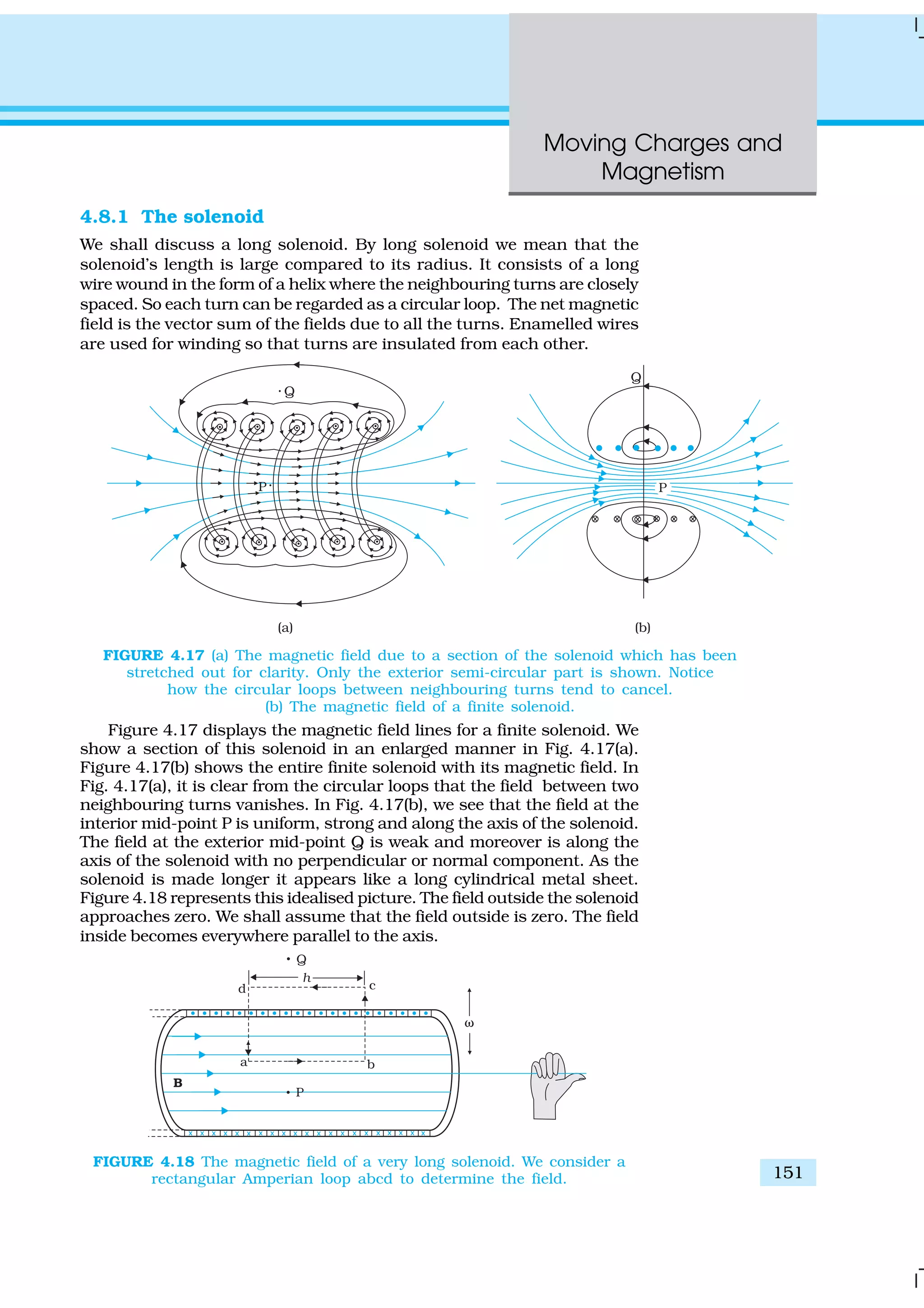
![Physics
152
Consider a rectangular Amperian loop abcd. Along cd the field is zero
as argued above. Along transverse sections bc and ad, the field component
is zero. Thus, these two sections make no contribution. Let the field along
ab be B. Thus, the relevant length of the Amperian loop is, L = h.
Let n be the number of turns per unit length, then the total number
of turns is nh. The enclosed current is, Ie
= I (n h), where I is the current
in the solenoid. From Ampere’s circuital law [Eq. 4.17 (b)]
BL = µ0
Ie
, B h = µ0
I (n h)
B = µ0
n I (4.20)
The direction of the field is given by the right-hand rule. The solenoid
is commonly used to obtain a uniform magnetic field. We shall see in the
next chapter that a large field is possible by inserting a soft
iron core inside the solenoid.
4.8.2 The toroid
The toroid is a hollow circular ring on which a large number
of turns of a wire are closely wound. It can be viewed as a
solenoid which has been bent into a circular shape to close
on itself. It is shown in Fig. 4.19(a) carrying a current I. We
shall see that the magnetic field in the open space inside
(point P) and exterior to the toroid (point Q) is zero. The
field B inside the toroid is constant in magnitude for the
ideal toroid of closely wound turns.
Figure 4.19(b) shows a sectional view of the toroid. The
direction of the magnetic field inside is clockwise as per the
right-hand thumb rule for circular loops. Three circular
Amperian loops 1, 2 and 3 are shown by dashed lines. By
symmetry, the magnetic field should be tangential to each
of them and constant in magnitude for a given loop. The
circular areas bounded by loops 2 and 3 both cut the toroid:
so that each turn of current carrying wire is cut once by
the loop 2 and twice by the loop 3.
Let the magnetic field along loop 1 be B1
in magnitude.
Then in Ampere’s circuital law [Eq. 4.17(a)], L = 2π r1
.
However, the loop encloses no current, so Ie
= 0. Thus,
B1
(2 π r1
) = µ0
(0), B1
= 0
Thus, the magnetic field at any point P in the open space
inside the toroid is zero.
We shall now show that magnetic field at Q is likewise
zero. Let the magnetic field along loop 3 be B3
. Once again
from Ampere’s law L = 2 π r3
. However, from the sectional
cut, we see that the current coming out of the plane of the
paper is cancelled exactly by the current going into it. Thus,
Ie
= 0, and B3
= 0. Let the magnetic field inside the solenoid
be B. We shall now consider the magnetic field at S. Once again we employ
Ampere’s law in the form of Eq. [4.17 (a)]. We find, L = 2π r.
The current enclosed Ie
is (for N turns of toroidal coil) N I.
B (2πr) = µ0
NI
FIGURE 4.19 (a) A toroid carrying
a current I. (b) A sectional view of
the toroid. The magnetic field can
be obtained at an arbitrary
distance r from the centre O of
the toroid by Ampere’s circuital
law. The dashed lines labelled
1, 2 and 3 are three circular
Amperian loops.](https://image.slidesharecdn.com/ncert-class-12-physics-part-1-161112171109/75/Ncert-class-12-physics-part-1-156-2048.jpg)
![Moving Charges and
Magnetism
153
0
2
NI
B
r
µ
=
π
(4.21)
We shall now compare the two results: for a toroid and solenoid. We
re-express Eq. (4.21) to make the comparison easier with the solenoid
result given in Eq. (4.20). Let r be the average radius of the toroid and n
be the number of turns per unit length. Then
N = 2πr n = (average) perimeter of the toroid
× number of turns per unit length
and thus,
B = µ0
n I, (4.22)
i.e., the result for the solenoid!
In an ideal toroid the coils are circular. In reality the turns of the
toroidal coil form a helix and there is always a small magnetic field external
to the toroid.
MAGNETIC CONFINEMENT
We have seen in Section 4.3 (see also the box on helical motion of charged particles earlier
in this chapter) that orbits of charged particles are helical. If the magnetic field is
non-uniform, but does not change much during one circular orbit, then the radius of the
helix will decrease as it enters stronger magnetic field and the radius will increase when it
enters weaker magnetic fields. We consider two solenoids at a distance from each other,
enclosed in an evacuated container (see figure below where we have not shown the container).
Charged particles moving in the region between the two solenoids will start with a small
radius. The radius will increase as field decreases and the radius will decrease again as
field due to the second solenoid takes over. The solenoids act as a mirror or reflector. [See
the direction of F as the particle approaches coil 2 in the figure. It has a horizontal component
against the forward motion.] This makes the particles turn back when they approach the
solenoid. Such an arrangement will act like magnetic bottle or magnetic container. The
particles will never touch the sides of the container. Such magnetic bottles are of great use
in confining the high energy plasma in fusion experiments. The plasma will destroy any
other form of material container because of it’s high temperature. Another useful container
is a toroid. Toroids are expected to play a key role in the tokamak, an equipment for plasma
confinement in fusion power reactors. There is an international collaboration called the
International Thermonuclear Experimental Reactor (ITER), being set up in France, for
achieving controlled fusion, of which India is a collaborating nation. For details of ITER
collaboration and the project, you may visit http://www.iter.org.](https://image.slidesharecdn.com/ncert-class-12-physics-part-1-161112171109/75/Ncert-class-12-physics-part-1-157-2048.jpg)
![Physics
154
EXAMPLE4.9
Example 4.9 A solenoid of length 0.5 m has a radius of 1 cm and is
made up of 500 turns. It carries a current of 5 A. What is the
magnitude of the magnetic field inside the solenoid?
Solution The number of turns per unit length is,
500
1000
0.5
n = = turns/m
The length l = 0.5 m and radius r = 0.01 m. Thus, l/a = 50 i.e., l >> a.
Hence, we can use the long solenoid formula, namely, Eq. (4.20)
B = µ0
n I
= 4π × 10–7
× 103
× 5
= 6.28 × 10–3
T
4.9 FORCE BETWEEN TWO PARALLEL CURRENTS,
THE AMPERE
We have learnt that there exists a magnetic field due to a conductor
carrying a current which obeys the Biot-Savart law. Further, we have
learnt that an external magnetic field will exert a force on
a current-carrying conductor. This follows from the
Lorentz force formula. Thus, it is logical to expect that
two current-carrying conductors placed near each other
will exert (magnetic) forces on each other. In the period
1820-25, Ampere studied the nature of this magnetic
force and its dependence on the magnitude of the current,
on the shape and size of the conductors as well as the
distances between the conductors. In this section, we
shall take the simple example of two parallel current-
carrying conductors, which will perhaps help us to
appreciate Ampere’s painstaking work.
Figure 4.20 shows two long parallel conductors a
and b separated by a distance d and carrying (parallel)
currents Ia
and Ib
, respectively. The conductor ‘a’
produces, the same magnetic field Ba
at all points along
the conductor ‘b’. The right-hand rule tells us that the
direction of this field is downwards (when the conductors
are placed horizontally). Its magnitude is given by Eq. [4.19(a)] or from
Ampere’s circuital law,
0
2
a
a
I
B
d
µ
=
π
The conductor ‘b’ carrying a current Ib
will experience a sideways
force due to the field Ba
. The direction of this force is towards the
conductor ‘a’ (Verify this). We label this force as Fba
, the force on a
segment L of ‘b’ due to ‘a’. The magnitude of this force is given by
Eq. (4.4),
FIGURE 4.20 Two long straight
parallel conductors carrying steady
currents Ia
and Ib
and separated by a
distance d. Ba
is the magnetic field set
up by conductor ‘a’ at conductor ‘b’.](https://image.slidesharecdn.com/ncert-class-12-physics-part-1-161112171109/75/Ncert-class-12-physics-part-1-158-2048.jpg)
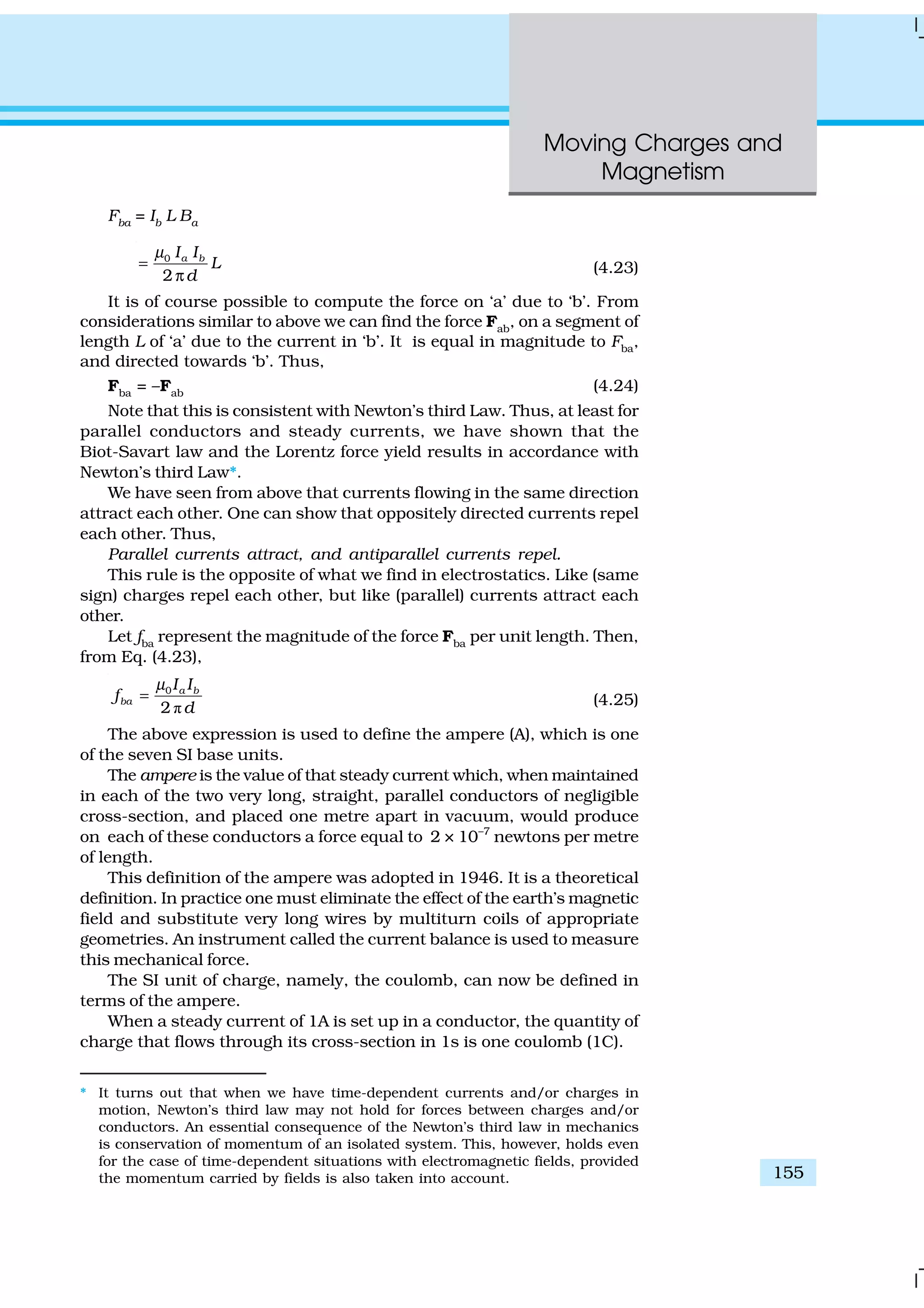
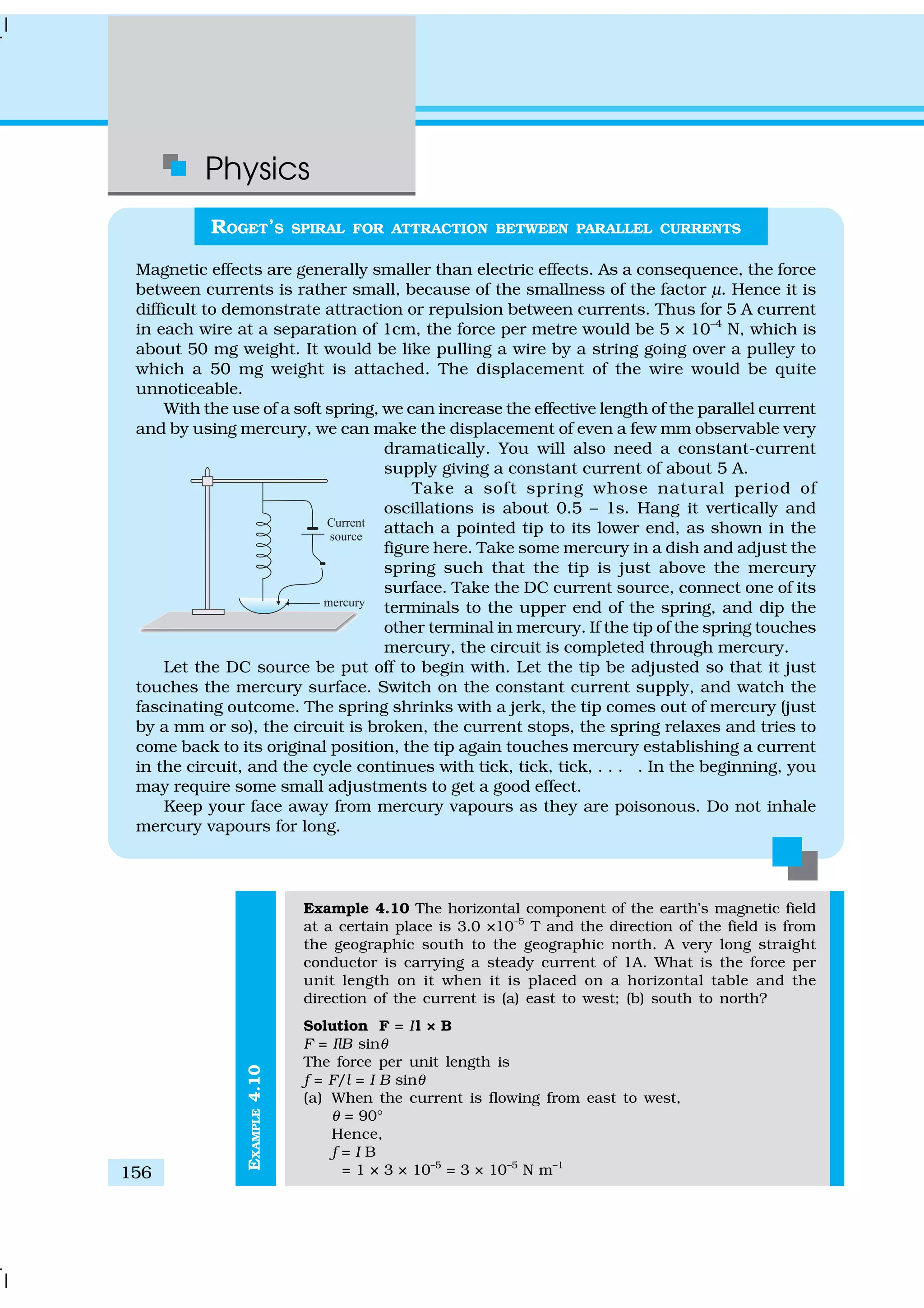
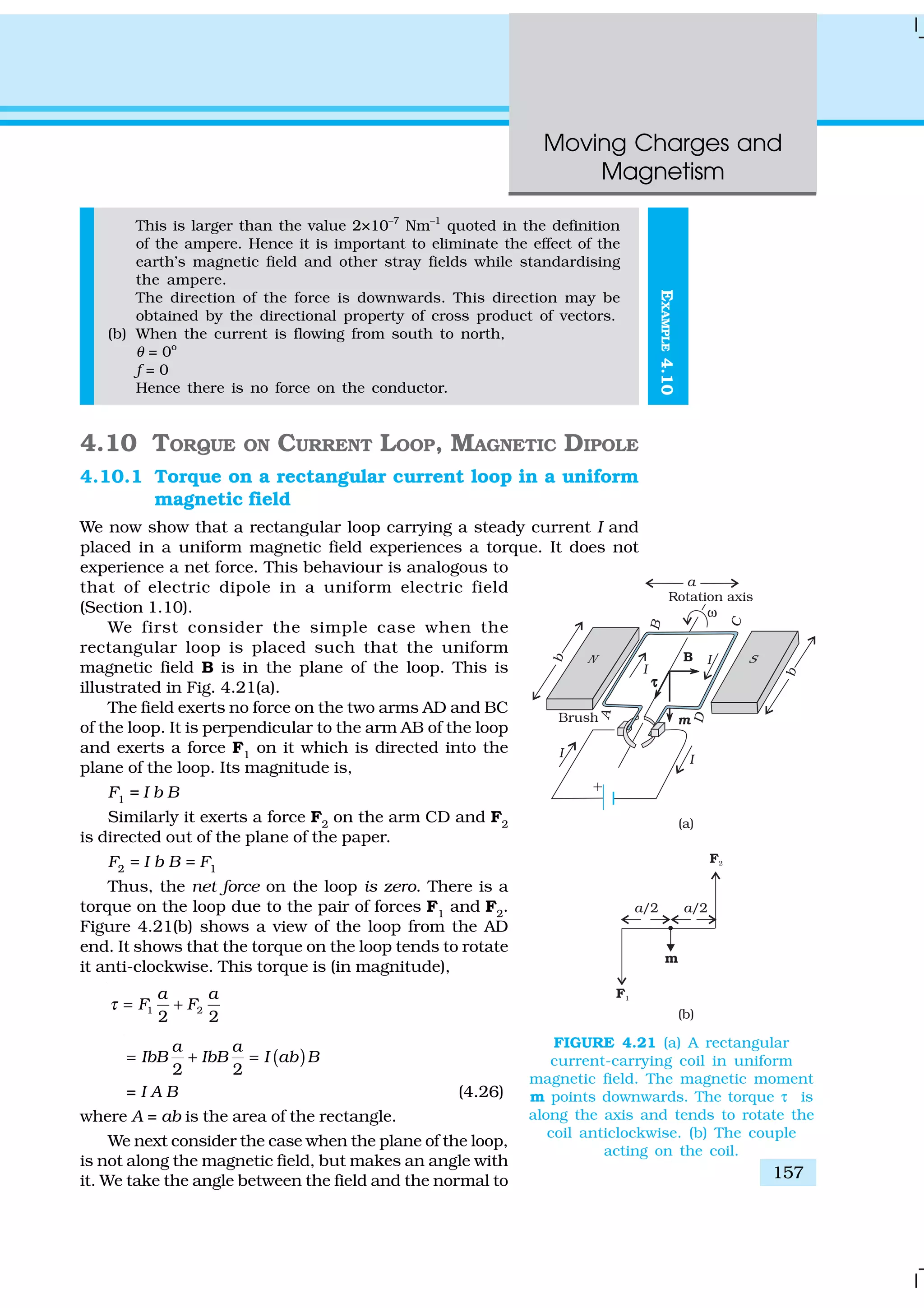
![Physics
158
the coil to be angle θ (The previous case
corresponds to θ = π/2). Figure 4.22 illustrates
this general case.
The forces on the arms BC and DA are equal,
opposite, and act along the axis of the coil, which
connects the centres of mass of BC and DA. Being
collinear along the axis they cancel each other,
resulting in no net force or torque. The forces on
arms AB and CD are F1
and F2
. They too are equal
and opposite, with magnitude,
F1
= F2
= I b B
But they are not collinear! This results in a
couple as before. The torque is, however, less than
the earlier case when plane of loop was along the
magnetic field. This is because the perpendicular
distance between the forces of the couple has
decreased. Figure 4.22(b) is a view of the
arrangement from the AD end and it illustrates
these two forces constituting a couple. The
magnitude of the torque on the loop is,
1 2sin sin
2 2
a a
F Fτ θ θ= +
= I ab B sin θ
= I A B sin θ (4.27)
As θ à 0, the perpendicular distance between
the forces of the couple also approaches zero. This
makes the forces collinear and the net force and
torque zero. The torques in Eqs. (4.26) and (4.27)
can be expressed as vector product of the magnetic moment of the coil
and the magnetic field. We define the magnetic moment of the current
loop as,
m = I A (4.28)
where the direction of the area vector A is given by the right-hand thumb
rule and is directed into the plane of the paper in Fig. 4.21. Then as the
angle between m and B is θ , Eqs. (4.26) and (4.27) can be expressed by
one expression
= ×m Bτ (4.29)
This is analogous to the electrostatic case (Electric dipole of dipole
moment pe
in an electric field E).
e= ×p Eτ
As is clear from Eq. (4.28), the dimensions of the magnetic moment are
[A][L2
] and its unit is Am2
.
From Eq. (4.29), we see that the torque ττ vanishes when m is either
parallel or antiparallel to the magnetic field B. This indicates a state of
equilibrium as there is no torque on the coil (this also applies to any
object with a magnetic moment m). When m and B are parallel the
FIGURE 4.22 (a) The area vector of the loop
ABCD makes an arbitrary angle θ with
the magnetic field. (b) Top view of
the loop. The forces F1
and F2
acting
on the arms AB and CD
are indicated.](https://image.slidesharecdn.com/ncert-class-12-physics-part-1-161112171109/75/Ncert-class-12-physics-part-1-162-2048.jpg)
![Moving Charges and
Magnetism
159
EXAMPLE4.11
equilibrium is a stable one. Any small rotation of the coil produces a
torque which brings it back to its original position. When they are
antiparallel, the equilibrium is unstable as any rotation produces a torque
which increases with the amount of rotation. The presence of this torque
is also the reason why a small magnet or any magnetic dipole aligns
itself with the external magnetic field.
If the loop has N closely wound turns, the expression for torque, Eq.
(4.29), still holds, with
m = N I A (4.30)
Example 4.11 A 100 turn closely wound circular coil of radius 10 cm
carries a current of 3.2 A. (a) What is the field at the centre of the
coil? (b) What is the magnetic moment of this coil?
The coil is placed in a vertical plane and is free to rotate about a
horizontal axis which coincides with its diameter. A uniform magnetic
field of 2T in the horizontal direction exists such that initially the
axis of the coil is in the direction of the field. The coil rotates through
an angle of 90º under the influence of the magnetic field.
(c) What are the magnitudes of the torques on the coil in the initial
and final position? (d) What is the angular speed acquired by the
coil when it has rotated by 90º? The moment of inertia of the coil is
0.1 kg m2
.
Solution
(a) From Eq. (4.16)
0
2
NI
B
R
µ
=
Here, N = 100; I = 3.2 A, and R = 0.1 m. Hence,
7 2
1
4 10 10 3.2
2 10
B
−
−
π × × ×
=
×
5
1
4 10 10
2 10
−
−
× ×
=
×
(using π × 3.2 = 10)
= 2 × 10–3
T
The direction is given by the right-hand thumb rule.
(b) The magnetic moment is given by Eq. (4.30),
m = N I A = N I π r2
= 100 × 3.2 × 3.14 × 10–2
= 10 A m2
The direction is once again given by the right hand thumb rule.
(c) τ = ×m B [from Eq. (4.29)]
sinm B θ=
Initially, θ = 0. Thus, initial torque τi
= 0. Finally, θ = π/2 (or 90º).
Thus, final torque τf
= m B = 10 × 2 = 20 N m.
(d) From Newton’s second law,
1
d
sin
d
m B
t
ω
θ=
where 1 is the moment of inertia of the coil. From chain rule,
d d d d
d d d dt t
ω ω θ ω
ω
θ θ
= =
Using this,
1 d sin dm Bω ω θ θ=](https://image.slidesharecdn.com/ncert-class-12-physics-part-1-161112171109/75/Ncert-class-12-physics-part-1-163-2048.jpg)
![Physics
160
EXAMPLE4.12EXAMPLE4.11
Integrating from θ = 0 to θ = π/2,
ð / 2
0 0
d sin d
f
m B
ω
ω ω θ θ=∫ ∫1
2
/2
0
cos
2
f
m B
ω
θ
π
= −1 = m B
1/2
2
f
m B
ω
= 1
1/2
1
2 20
10−
×
=
= 20 s–1
.
Example 4.12
(a) A current-carrying circular loop lies on a smooth horizontal plane.
Can a uniform magnetic field be set up in such a manner that
the loop turns around itself (i.e., turns about the vertical axis).
(b) A current-carrying circular loop is located in a uniform external
magnetic field. If the loop is free to turn, what is its orientation
of stable equilibrium? Show that in this orientation, the flux of
the total field (external field + field produced by the loop) is
maximum.
(c) A loop of irregular shape carrying current is located in an external
magnetic field. If the wire is flexible, why does it change to a
circular shape?
Solution
(a) No, because that would require ττ to be in the vertical direction.
But ττ = I A × B, and since A of the horizontal loop is in the vertical
direction, τ would be in the plane of the loop for any B.
(b) Orientation of stable equilibrium is one where the area vector A
of the loop is in the direction of external magnetic field. In this
orientation, the magnetic field produced by the loop is in the same
direction as external field, both normal to the plane of the loop,
thus giving rise to maximum flux of the total field.
(c) It assumes circular shape with its plane normal to the field to
maximize flux, since for a given perimeter, a circle encloses greater
area than any other shape.
4.10.2 Circular current loop as a magnetic dipole
In this section, we shall consider the elementary magnetic element: the
current loop. We shall show that the magnetic field (at large distances)
due to current in a circular current loop is very similar in behavior to the
electric field of an electric dipole. In Section 4.6, we have evaluated the
magnetic field on the axis of a circular loop, of a radius R, carrying a
steady current I. The magnitude of this field is [(Eq. (4.15)],
( )
2
0
3/22 2
2
I R
B
x R
µ
=
+
and its direction is along the axis and given by the right-hand thumb
rule (Fig. 4.12). Here, x is the distance along the axis from the centre of
the loop. For x >> R, we may drop the R2
term in the denominator. Thus,](https://image.slidesharecdn.com/ncert-class-12-physics-part-1-161112171109/75/Ncert-class-12-physics-part-1-164-2048.jpg)
![Moving Charges and
Magnetism
161
2
0
3
2
R
B
x
µ
=
Note that the area of the loop A = πR2
. Thus,
0
3
2
IA
B
x
µ
=
π
As earlier, we define the magnetic moment m to have a magnitude IA,
m = I A. Hence,
ð
0
3
2 x
µ m
B ;
ð
0
3
2
4 x
µ
=
m
[4.31(a)]
The expression of Eq. [4.31(a)] is very similar to an expression obtained
earlier for the electric field of a dipole. The similarity may be seen if we
substitute,
0 01/µ ε→
e→m p (electrostatic dipole)
→B E (electrostatic field)
We then obtain,
3
0
2
4
e
xε
=
π
p
E
which is precisely the field for an electric dipole at a point on its axis.
considered in Chapter 1, Section 1.10 [Eq. (1.20)].
It can be shown that the above analogy can be carried further. We
had found in Chapter 1 that the electric field on the perpendicular bisector
of the dipole is given by [See Eq.(1.21)],
3
04
e
xεπ
p
E ;
where x is the distance from the dipole. If we replace p à m and 0 01/µ ε→
in the above expression, we obtain the result for B for a point in the
plane of the loop at a distance x from the centre. For x >>R,
0
3
;
4
x R
x
µ
>>
π
m
B ; [4.31(b)]
The results given by Eqs. [4.31(a)] and [4.31(b)] become exact for a
point magnetic dipole.
The results obtained above can be shown to apply to any planar loop:
a planar current loop is equivalent to a magnetic dipole of dipole moment
m = I A, which is the analogue of electric dipole moment p. Note, however,
a fundamental difference: an electric dipole is built up of two elementary
units — the charges (or electric monopoles). In magnetism, a magnetic
dipole (or a current loop) is the most elementary element. The equivalent
of electric charges, i.e., magnetic monopoles, are not known to exist.
We have shown that a current loop (i) produces a magnetic field (see
Fig. 4.12) and behaves like a magnetic dipole at large distances, and](https://image.slidesharecdn.com/ncert-class-12-physics-part-1-161112171109/75/Ncert-class-12-physics-part-1-165-2048.jpg)
![Physics
162
(ii) is subject to torque like a magnetic needle. This led Ampere to suggest
that all magnetism is due to circulating currents. This seems to be partly
true and no magnetic monopoles have been seen so far. However,
elementary particles such as an electron or a proton also carry an intrinsic
magnetic moment, not accounted by circulating currents.
4.10.3 The magnetic dipole moment of a revolving electron
In Chapter 12 we shall read about the Bohr model of the hydrogen atom.
You may perhaps have heard of this model which was proposed by the
Danish physicist Niels Bohr in 1911 and was a stepping stone
to a new kind of mechanics, namely, quantum mechanics.
In the Bohr model, the electron (a negatively charged particle)
revolves around a positively charged nucleus much as a
planet revolves around the sun. The force in the former case
is electrostatic (Coulomb force) while it is gravitational for
the planet-Sun case. We show this Bohr picture of the electron
in Fig. 4.23.
The electron of charge (–e) (e = + 1.6 × 10–19
C) performs
uniform circular motion around a stationary heavy nucleus
of charge +Ze. This constitutes a current I, where,
e
I
T
= (4.32)
and T is the time period of revolution. Let r be the orbital
radius of the electron, and v the orbital speed. Then,
ð2 r
T =
v
(4.33)
Substituting in Eq. (4.32), we have I = ev/2πr.
There will be a magnetic moment, usually denoted by µl
,
associated with this circulating current. From Eq. (4.28) its
magnitude is, µl
= Iπr2
= evr/2.
The direction of this magnetic moment is into the plane
of the paper in Fig. 4.23. [This follows from the right-hand
rule discussed earlier and the fact that the negatively charged
electron is moving anti-clockwise, leading to a clockwise current.]
Multiplying and dividing the right-hand side of the above expression by
the electron mass me
, we have,
( )
2
l e
e
e
m vr
m
µ =
2 e
e
l
m
= [4.34(a)]
Here, l is the magnitude of the angular momentum of the electron
about the central nucleus (“orbital” angular momentum). Vectorially,
2
l
e
e
m
= − lµ [4.34(b)]
The negative sign indicates that the angular momentum of the electron
is opposite in direction to the magnetic moment. Instead of electron with
FIGURE 4.23 In the Bohr model
of hydrogen-like atoms, the
negatively charged electron is
revolving with uniform speed
around a centrally placed
positively charged (+Z e)
nucleus. The uniform circular
motion of the electron
constitutes a current. The
direction of the magnetic
moment is into the plane of the
paper and is indicated
separately by ⊗.](https://image.slidesharecdn.com/ncert-class-12-physics-part-1-161112171109/75/Ncert-class-12-physics-part-1-166-2048.jpg)
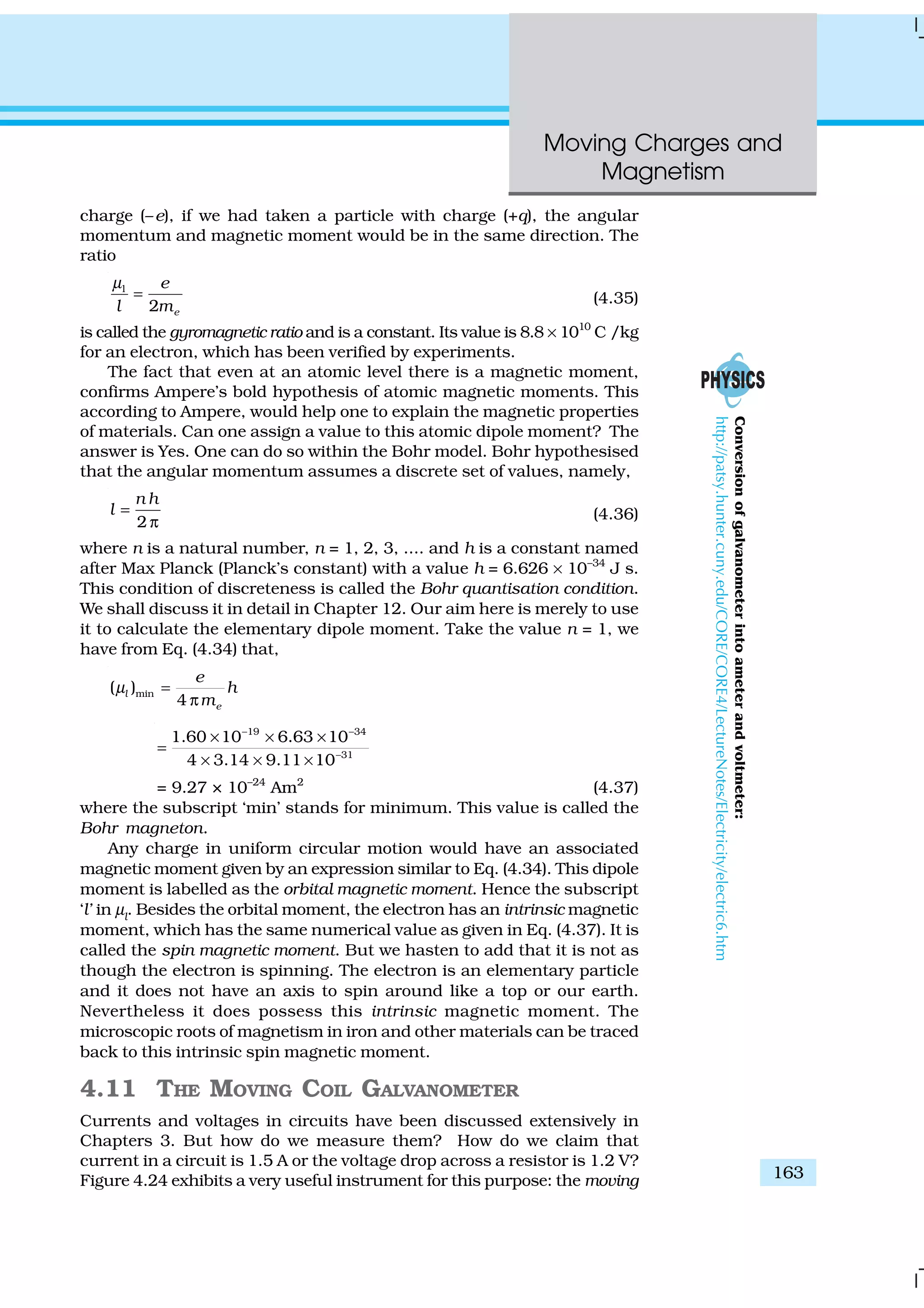
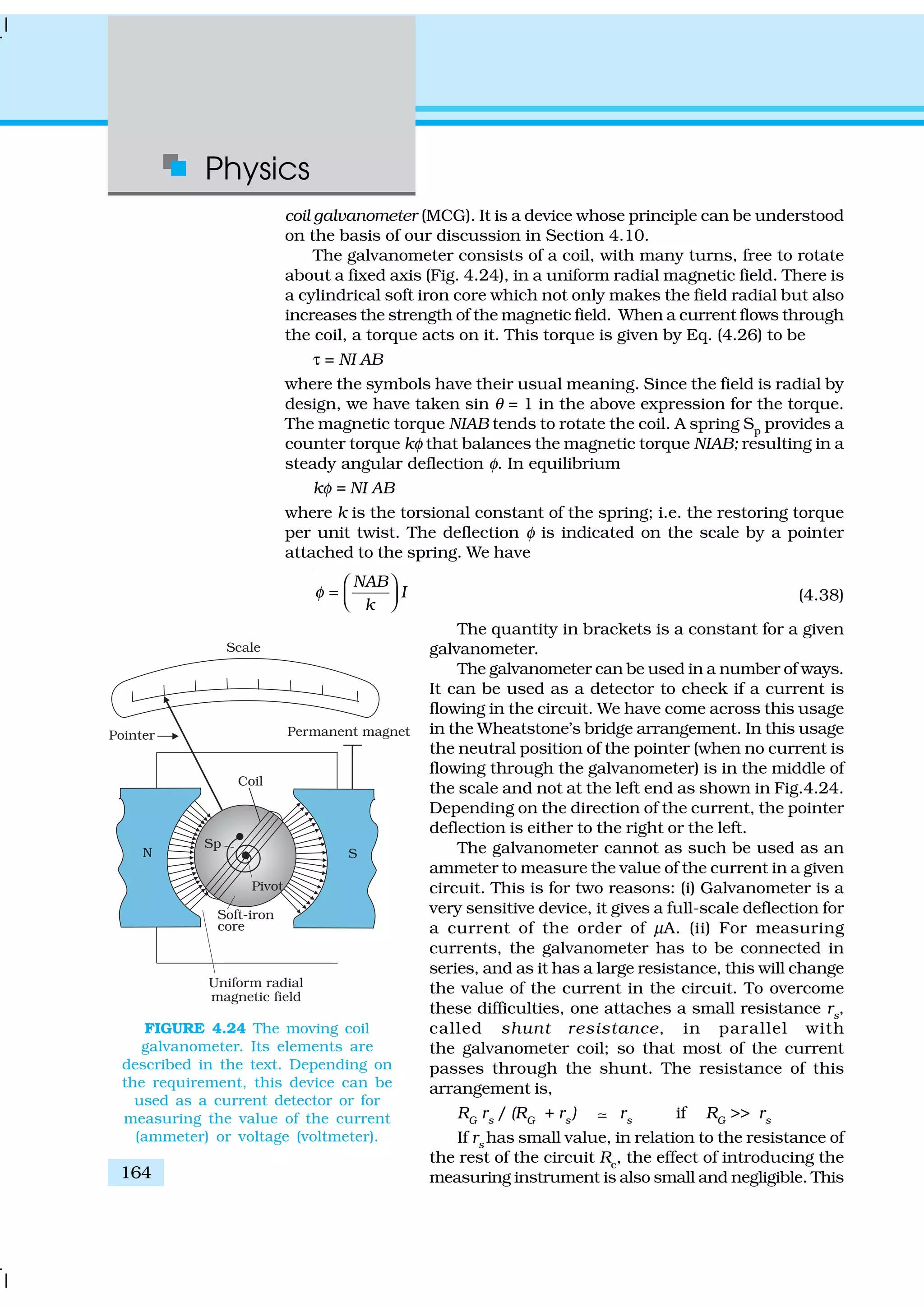
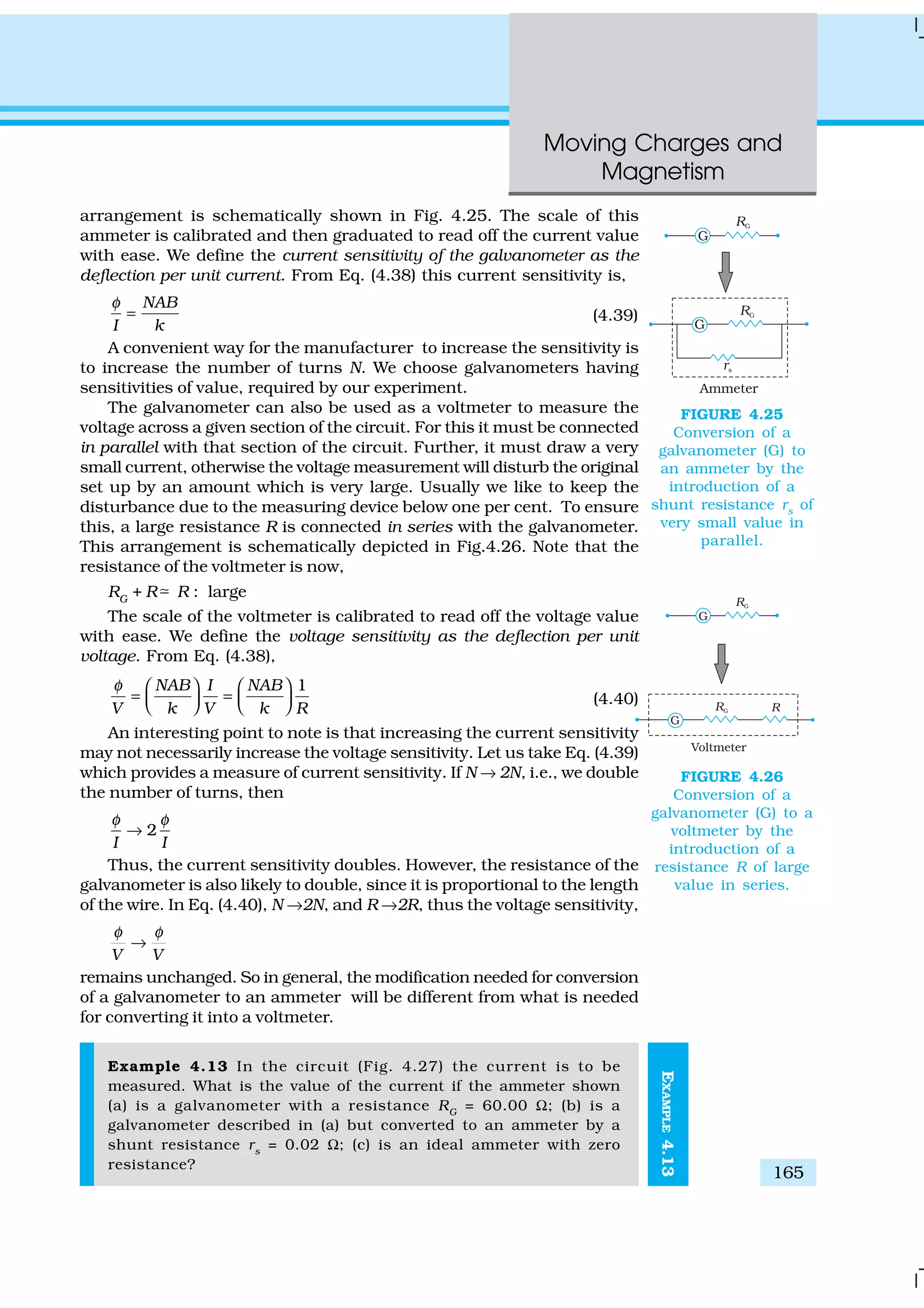
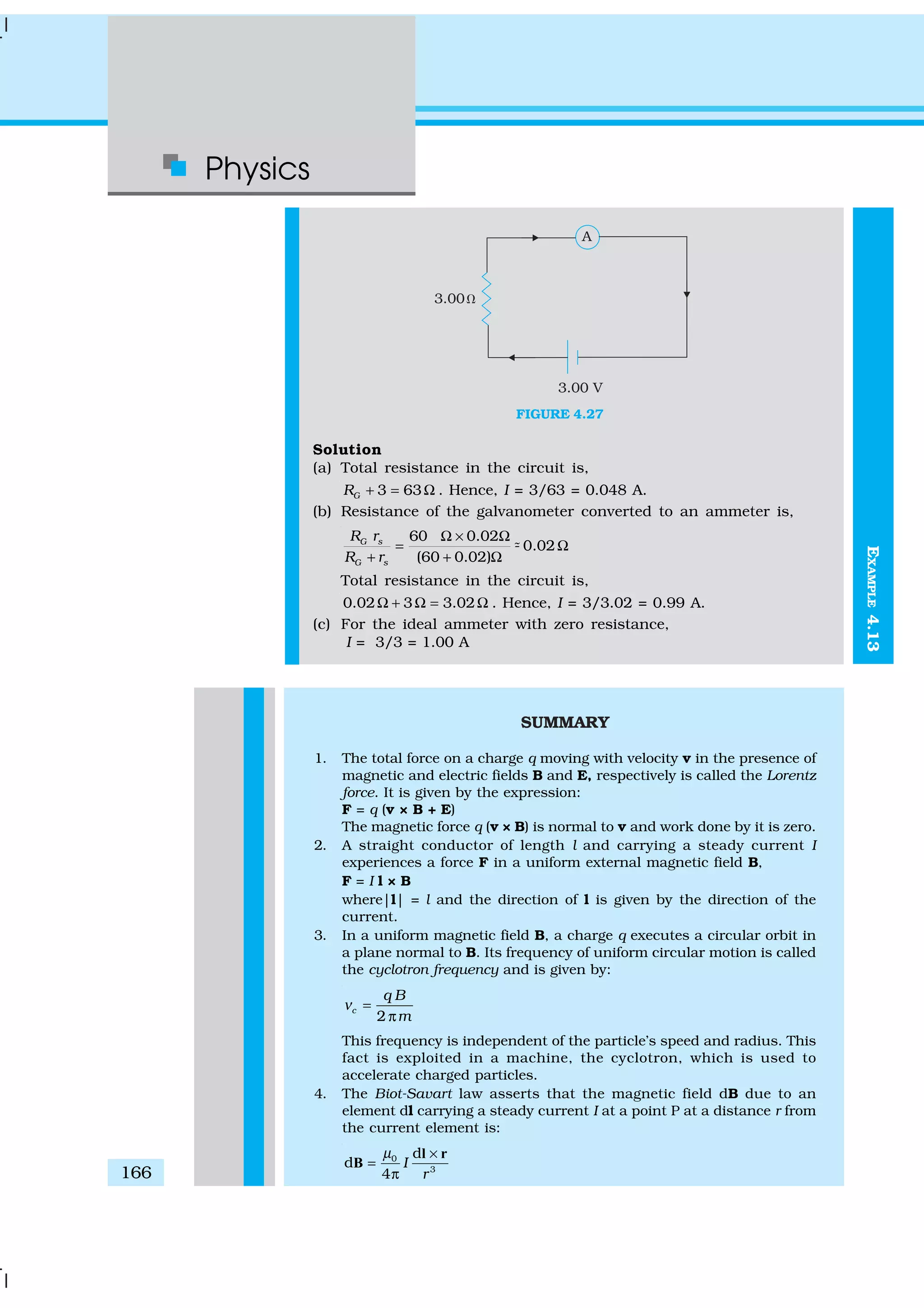
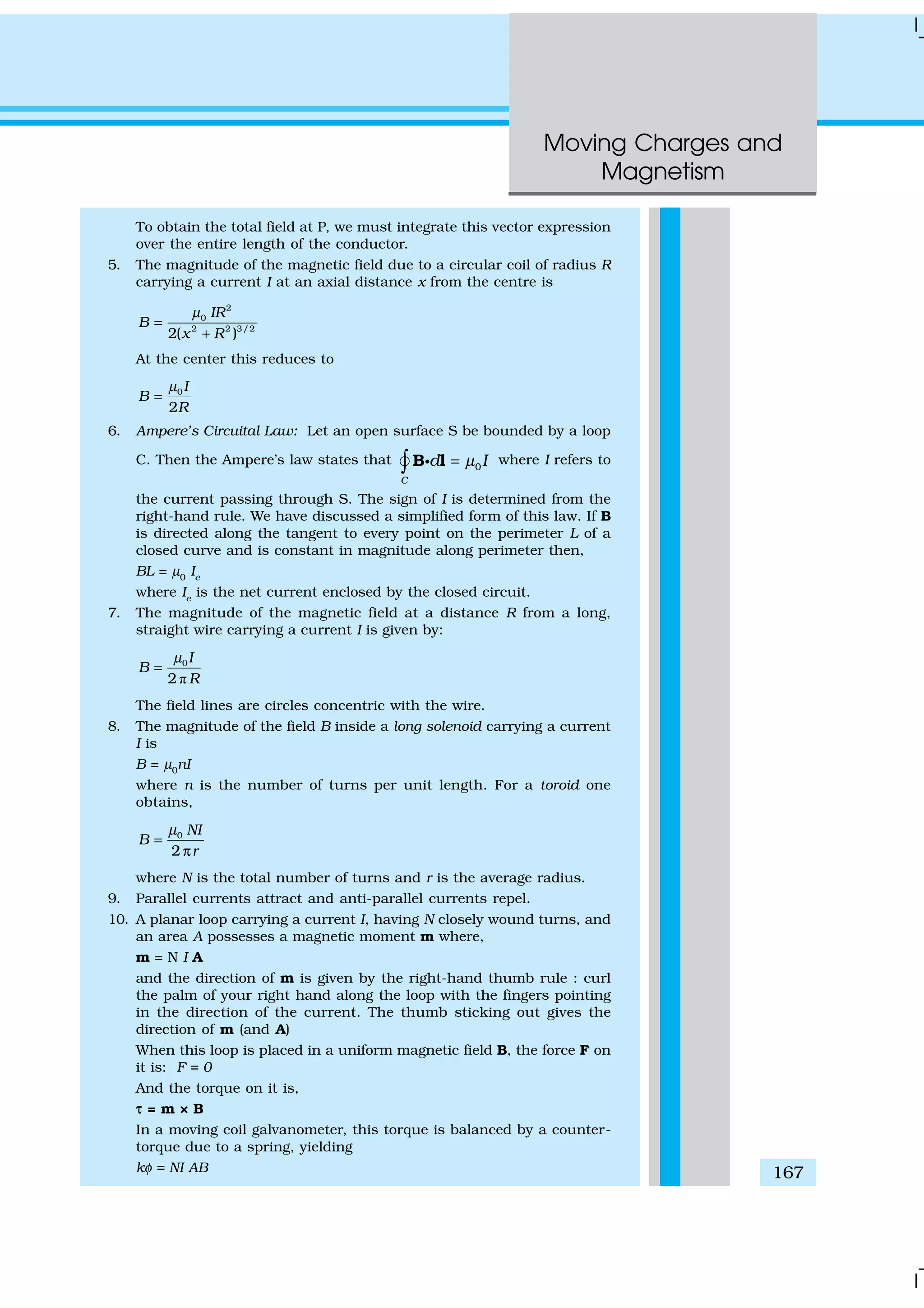
![Physics
168
where φ is the equilibrium deflection and k the torsion constant of
the spring.
11. An electron moving around the central nucleus has a magnetic moment
µl
given by:
2
l
e
l
m
µ =
where l is the magnitude of the angular momentum of the circulating
electron about the central nucleus. The smallest value of µl
is called
the Bohr magneton µB
and it is µB
= 9.27×10–24
J/T
12. A moving coil galvanometer can be converted into a ammeter by
introducing a shunt resistance rs
, of small value in parallel. It can be
converted into a voltmeter by introducing a resistance of a large value
in series.
Physical Quantity Symbol Nature Dimensions Units Remarks
Permeability of free µ0
Scalar [MLT–2
A–2
] T m A–1
4π × 10–7
T m A–1
space
Magnetic Field B Vector [M T–2
A–1
] T (telsa)
Magnetic Moment m Vector [L2
A] A m2
or J/T
Torsion Constant k Scalar [M L2
T–2
] N m rad–1
Appears in MCG
POINTS TO PONDER
1. Electrostatic field lines originate at a positive charge and terminate at a
negative charge or fade at infinity. Magnetic field lines always form
closed loops.
2. The discussion in this Chapter holds only for steady currents which do
not vary with time.
When currents vary with time Newton’s third law is valid only if momentum
carried by the electromagnetic field is taken into account.
3. Recall the expression for the Lorentz force,
F = q (v × B + E)
This velocity dependent force has occupied the attention of some of the
greatest scientific thinkers. If one switches to a frame with instantaneous
velocity v, the magnetic part of the force vanishes. The motion of the
charged particle is then explained by arguing that there exists an
appropriate electric field in the new frame. We shall not discuss the
details of this mechanism. However, we stress that the resolution of this
paradox implies that electricity and magnetism are linked phenomena
(electromagnetism) and that the Lorentz force expression does not imply
a universal preferred frame of reference in nature.
4. Ampere’s Circuital law is not independent of the Biot-Savart law. It
can be derived from the Biot-Savart law. Its relationship to the
Biot-Savart law is similar to the relationship between Gauss’s law and
Coulomb’s law.](https://image.slidesharecdn.com/ncert-class-12-physics-part-1-161112171109/75/Ncert-class-12-physics-part-1-172-2048.jpg)
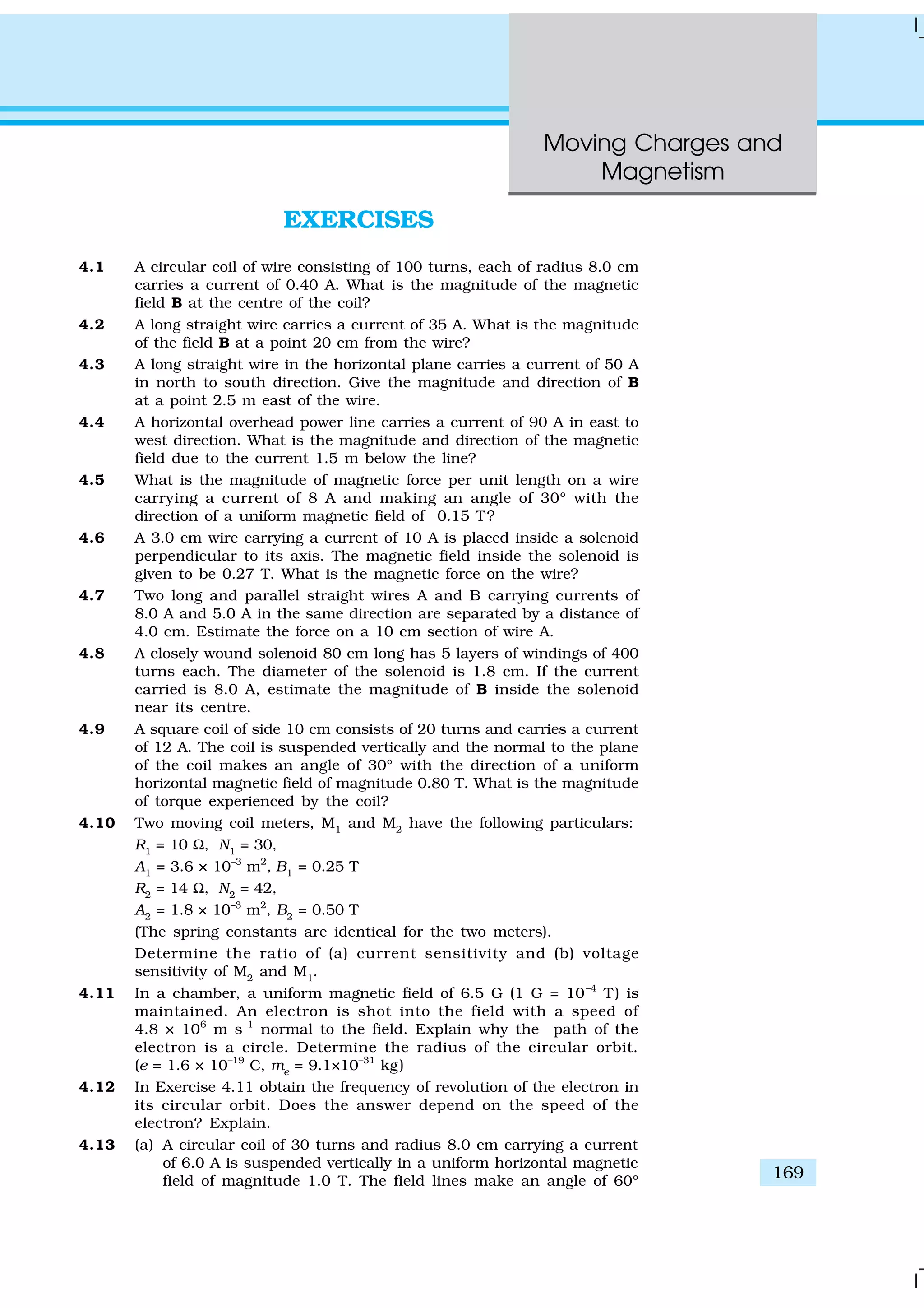
![Physics
170
with the normal of the coil. Calculate the magnitude of the
counter torque that must be applied to prevent the coil from
turning.
(b) Would your answer change, if the circular coil in (a) were replaced
by a planar coil of some irregular shape that encloses the same
area? (All other particulars are also unaltered.)
ADDITIONAL EXERCISES
4.14 Two concentric circular coils X and Y of radii 16 cm and 10 cm,
respectively, lie in the same vertical plane containing the north to
south direction. Coil X has 20 turns and carries a current of 16 A;
coil Y has 25 turns and carries a current of 18 A. The sense of the
current in X is anticlockwise, and clockwise in Y, for an observer
looking at the coils facing west. Give the magnitude and direction of
the net magnetic field due to the coils at their centre.
4.15 A magnetic field of 100 G (1 G = 10–4
T) is required which is uniform
in a region of linear dimension about 10 cm and area of cross-section
about 10–3
m2
. The maximum current-carrying capacity of a given
coil of wire is 15 A and the number of turns per unit length that can
be wound round a core is at most 1000 turns m–1
. Suggest some
appropriate design particulars of a solenoid for the required purpose.
Assume the core is not ferromagnetic.
4.16 For a circular coil of radius R and N turns carrying current I, the
magnitude of the magnetic field at a point on its axis at a distance x
from its centre is given by,
( )
2
0
3/22 2
2
IR N
B
x R
µ
=
+
(a) Show that this reduces to the familiar result for field at the
centre of the coil.
(b) Consider two parallel co-axial circular coils of equal radius R,
and number of turns N, carrying equal currents in the same
direction, and separated by a distance R. Show that the field on
the axis around the mid-point between the coils is uniform over
a distance that is small as compared to R, and is given by,
0
0.72
NI
B
R
µ
= , approximately.
[Such an arrangement to produce a nearly uniform magnetic
field over a small region is known as Helmholtz coils.]
4.17 A toroid has a core (non-ferromagnetic) of inner radius 25 cm and
outer radius 26 cm, around which 3500 turns of a wire are wound.
If the current in the wire is 11 A, what is the magnetic field
(a) outside the toroid, (b) inside the core of the toroid, and (c) in the
empty space surrounded by the toroid.
4.18 Answer the following questions:
(a) A magnetic field that varies in magnitude from point to point
but has a constant direction (east to west) is set up in a chamber.
A charged particle enters the chamber and travels undeflected](https://image.slidesharecdn.com/ncert-class-12-physics-part-1-161112171109/75/Ncert-class-12-physics-part-1-174-2048.jpg)

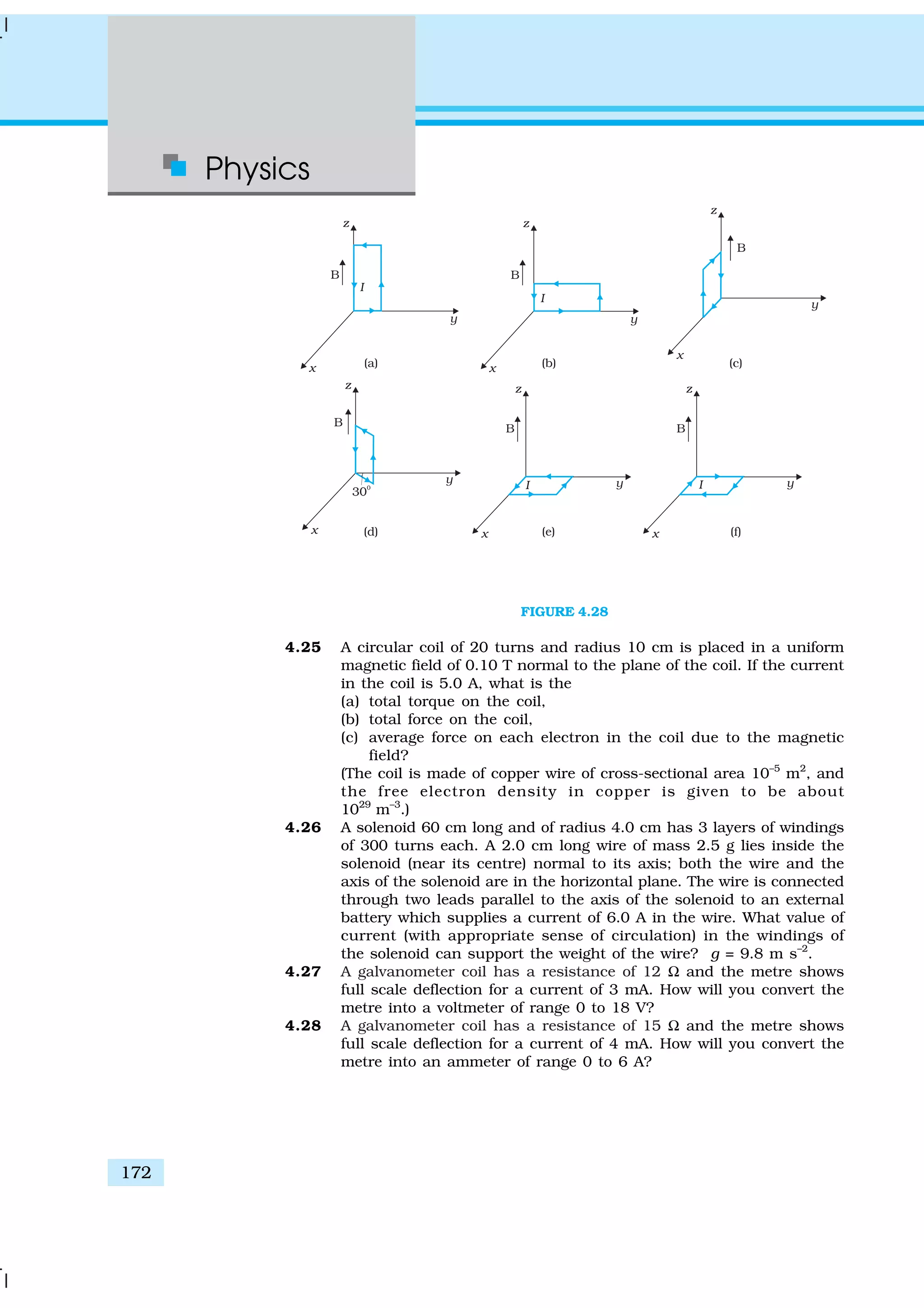

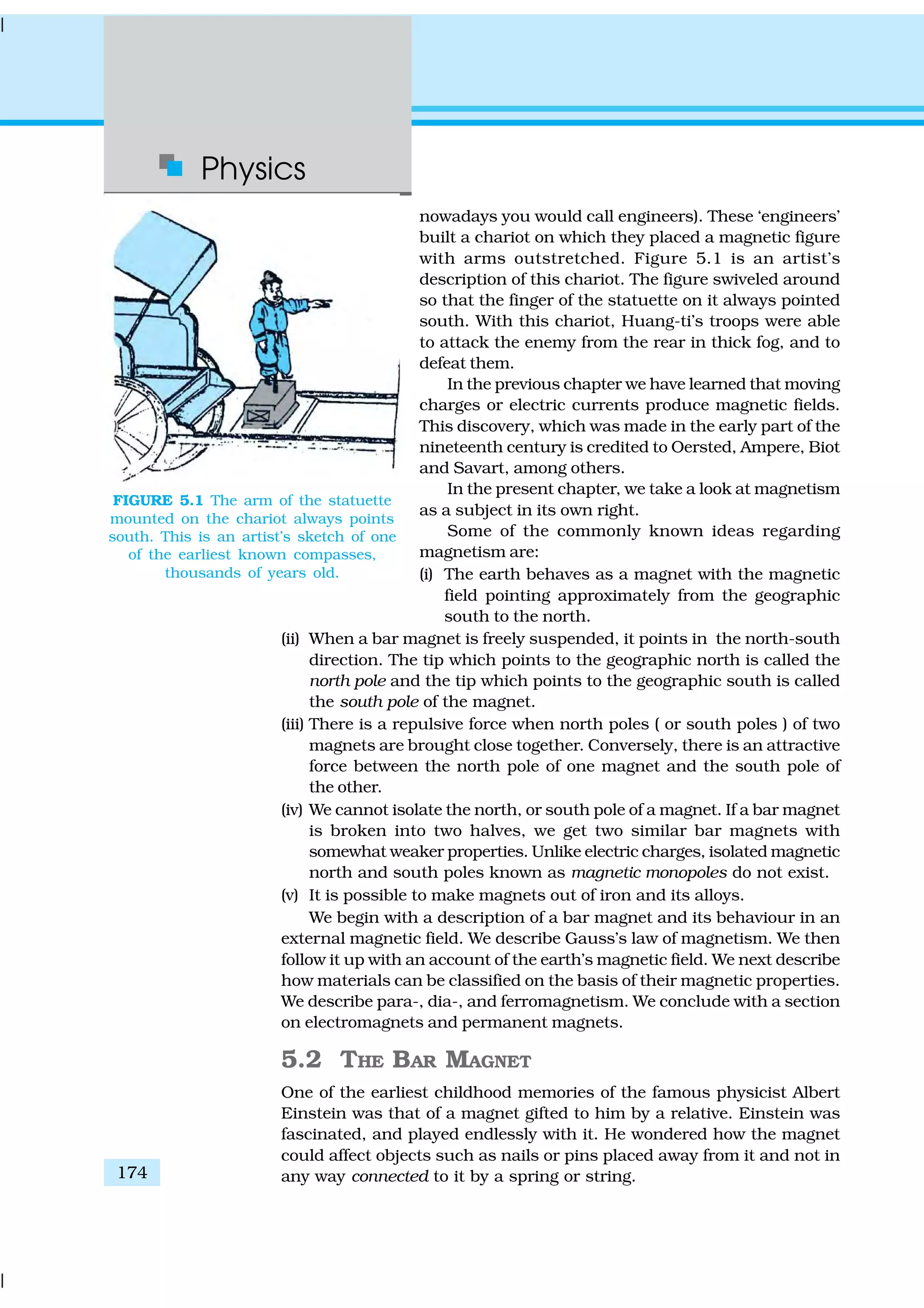
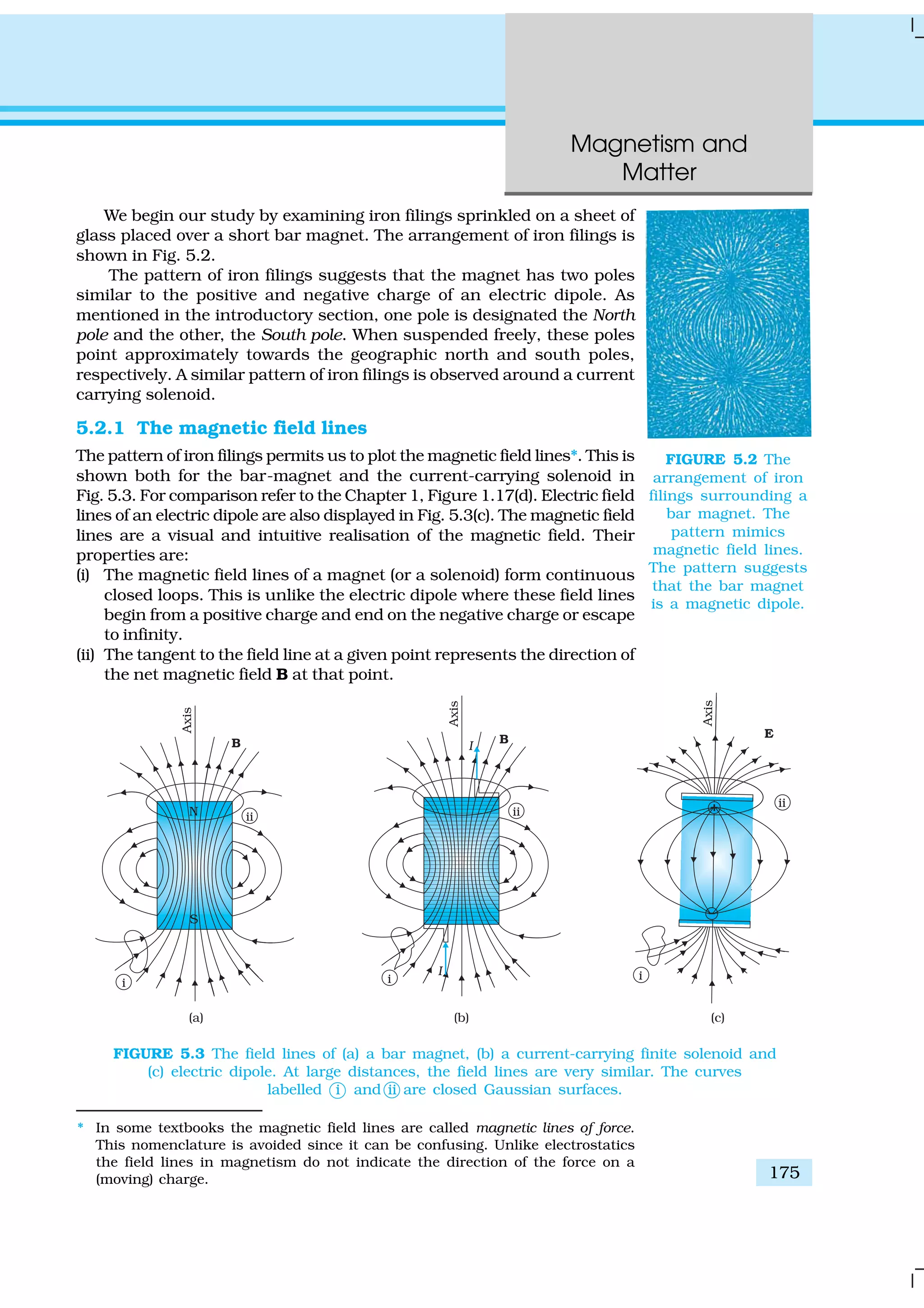
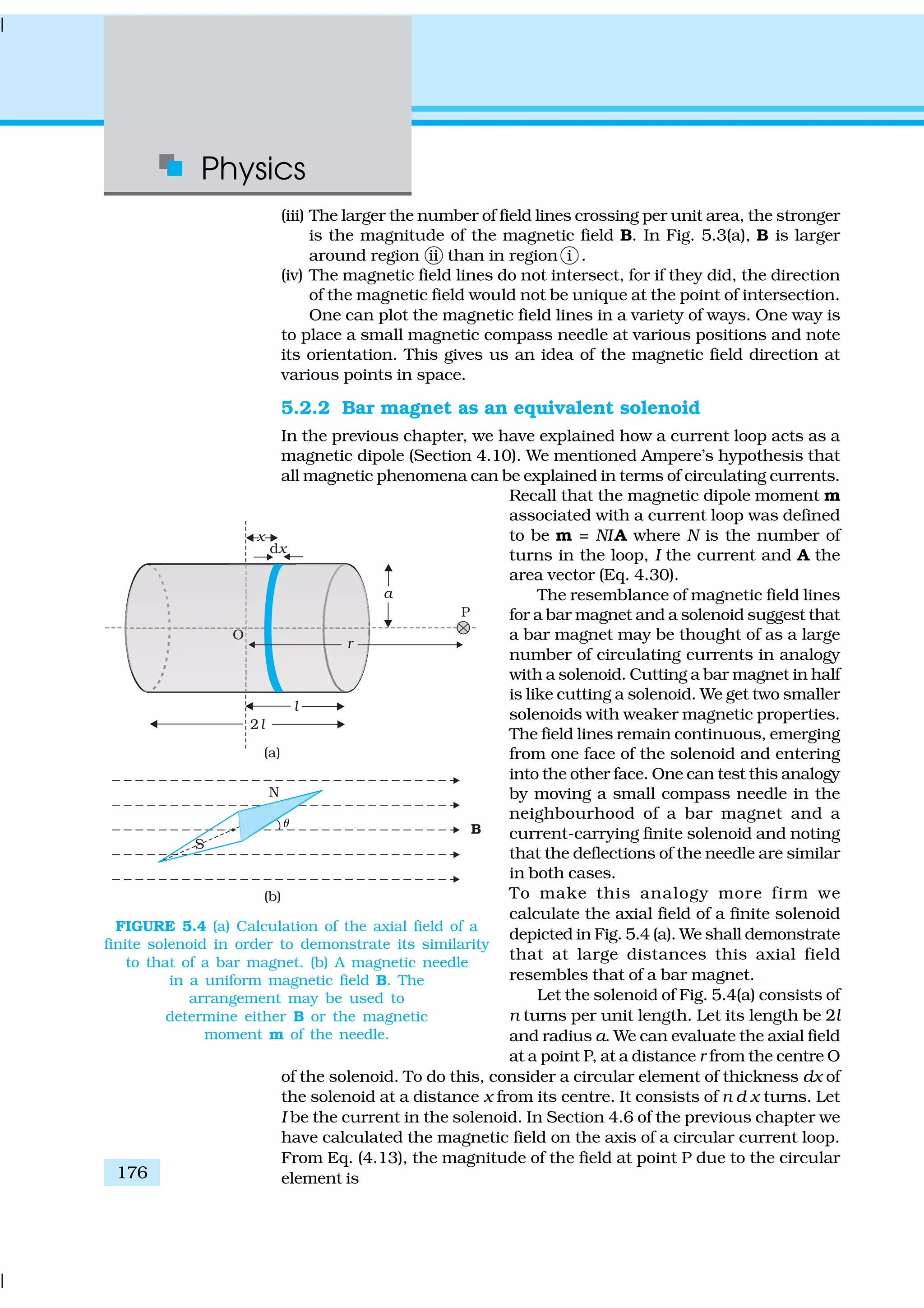
![Magnetism and
Matter
177
2
0
3
2 2 2
2[( ) ]
n dx I a
dB
r x a
µ
=
− +
The magnitude of the total field is obtained by summing over all the
elements — in other words by integrating from x = – l to x = + l. Thus,
2
0
2
nIa
B
µ
= 2 2 3/2
[( ) ]
l
l
dx
r x a− − +∫
This integration can be done by trigonometric substitutions. This
exercise, however, is not necessary for our purpose. Note that the range
of x is from – l to + l. Consider the far axial field of the solenoid, i.e.,
r >> a and r >> l. Then the denominator is approximated by
3
2 2 32
[( ) ]r x a r− + ≈
and
2
0
3
2
l
l
n I a
B dx
r
µ
−
= ∫
=
2
0
3
2
2
n I l a
r
µ
(5.1)
Note that the magnitude of the magnetic moment of the solenoid is,
m = n (2l) I (πa2
) — (total number of turns × current × cross-sectional
area). Thus,
0
3
2
4
m
B
r
µ
π
= (5.2)
This is also the far axial magnetic field of a bar magnet which one may
obtain experimentally. Thus, a bar magnet and a solenoid produce similar
magnetic fields. The magnetic moment of a bar magnet is thus equal to
the magnetic moment of an equivalent solenoid that produces the same
magnetic field.
Some textbooks assign a magnetic charge (also called pole strength)
+qm
to the north pole and –qm
to the south pole of a bar magnet of length
2l, and magnetic moment qm
(2l). The field strength due to qm
at a distance
r from it is given by µ0qm/4πr2
. The magnetic field due to the bar magnet
is then obtained, both for the axial and the equatorial case, in a manner
analogous to that of an electric dipole (Chapter 1). The method is simple
and appealing. However, magnetic monopoles do not exist, and we have
avoided this approach for that reason.
5.2.3 The dipole in a uniform magnetic field
The pattern of iron filings, i.e., the magnetic field lines gives us an
approximate idea of the magnetic field B. We may at times be required to
determine the magnitude of B accurately. This is done by placing a small
compass needle of known magnetic moment m and moment of inertia 1
and allowing it to oscillate in the magnetic field. This arrangement is shown
in Fig. 5.4(b).
The torque on the needle is [see Eq. (4.29)],
τ = m × B (5.3)](https://image.slidesharecdn.com/ncert-class-12-physics-part-1-161112171109/75/Ncert-class-12-physics-part-1-181-2048.jpg)
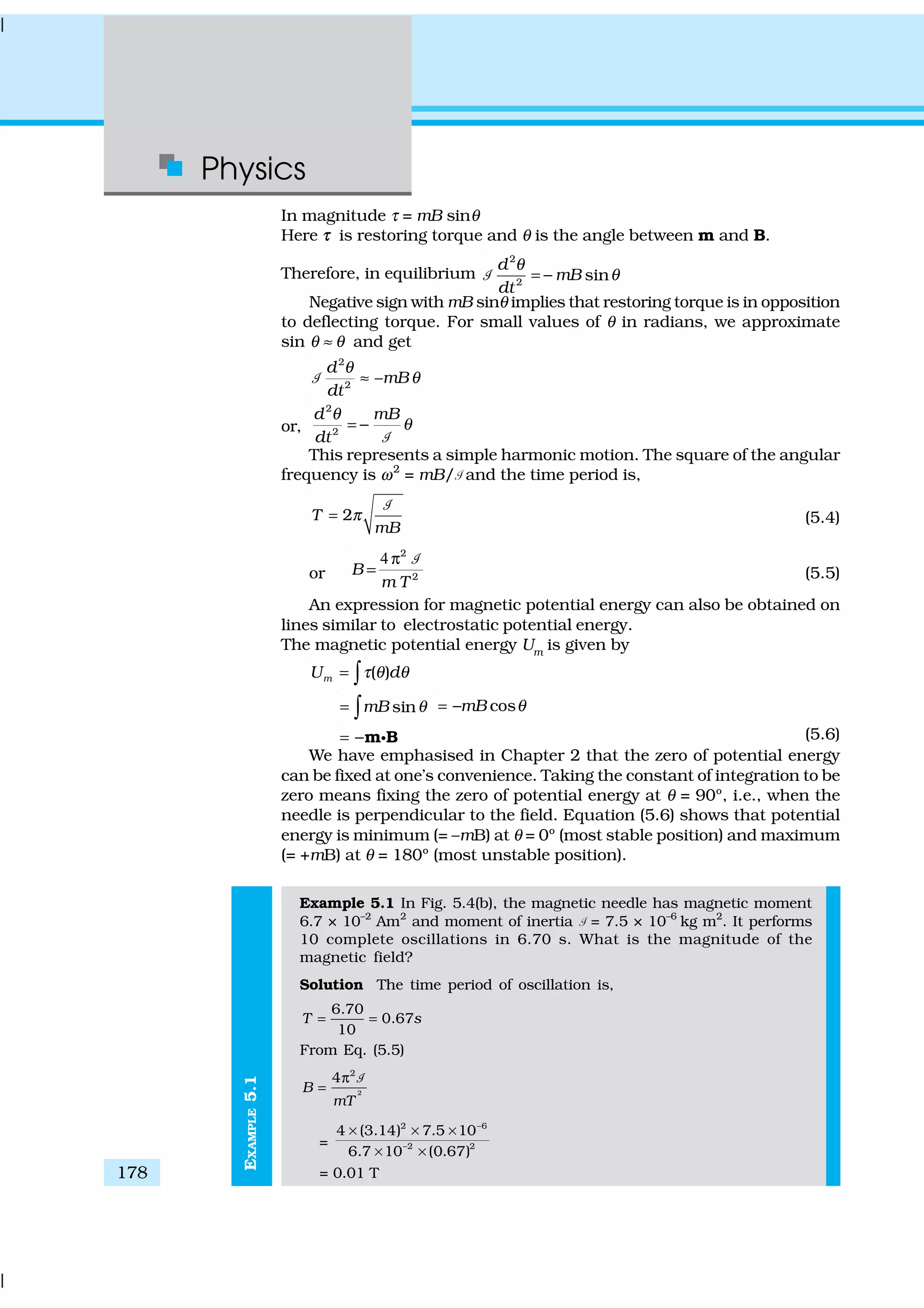
![Magnetism and
Matter
179
EXAMPLE5.2
Example 5.2 A short bar magnet placed with its axis at 30º with an
external field of 800 G experiences a torque of 0.016 Nm. (a) What is
the magnetic moment of the magnet? (b) What is the work done in
moving it from its most stable to most unstable position? (c) The bar
magnet is replaced by a solenoid of cross-sectional area 2 × 10–4
m2
and 1000 turns, but of the same magnetic moment. Determine the
current flowing through the solenoid.
Solution
(a) From Eq. (5.3), τ = m B sin θ, θ = 30º, hence sinθ =1/2.
Thus, 0.016 = m × (800 × 10–4
T) × (1/2)
m = 160 × 2/800 = 0.40 A m2
(b) From Eq. (5.6), the most stable position is θ = 0º and the most
unstable position is θ = 180º. Work done is given by
( 180 ) ( 0 )m mW U Uθ θ= = ° − = °
= 2 m B = 2 × 0.40 × 800 × 10–4
= 0.064 J
(c) From Eq. (4.30), ms
= NIA. From part (a), ms
= 0.40 A m2
0.40 = 1000 × I × 2 × 10–4
I = 0.40 × 104
/(1000 × 2) = 2A
Example 5.3
(a) What happens if a bar magnet is cut into two pieces: (i) transverse
to its length, (ii) along its length?
(b) A magnetised needle in a uniform magnetic field experiences a
torque but no net force. An iron nail near a bar magnet, however,
experiences a force of attraction in addition to a torque. Why?
(c) Must every magnetic configuration have a north pole and a south
pole? What about the field due to a toroid?
(d) Two identical looking iron bars A and B are given, one of which is
definitely known to be magnetised. (We do not know which one.)
How would one ascertain whether or not both are magnetised? If
only one is magnetised, how does one ascertain which one? [Use
nothing else but the bars A and B.]
Solution
(a) In either case, one gets two magnets, each with a north and south
pole.
(b) No force if the field is uniform. The iron nail experiences a non-
uniform field due to the bar magnet. There is induced magnetic
moment in the nail, therefore, it experiences both force and torque.
The net force is attractive because the induced south pole (say) in
the nail is closer to the north pole of magnet than induced north
pole.
(c) Not necessarily. True only if the source of the field has a net non-
zero magnetic moment. This is not so for a toroid or even for a
straight infinite conductor.
(d) Try to bring different ends of the bars closer. A repulsive force in
some situation establishes that both are magnetised. If it is always
attractive, then one of them is not magnetised. In a bar magnet
the intensity of the magnetic field is the strongest at the two ends
(poles) and weakest at the central region. This fact may be used to
determine whether A or B is the magnet. In this case, to see which
EXAMPLE5.3](https://image.slidesharecdn.com/ncert-class-12-physics-part-1-161112171109/75/Ncert-class-12-physics-part-1-183-2048.jpg)

![Magnetism and
Matter
181
EXAMPLE5.5
Example 5.5 Figure 5.5 shows a small magnetised needle P placed at
a point O. The arrow shows the direction of its magnetic moment. The
other arrows show different positions (and orientations of the magnetic
moment) of another identical magnetised needle Q.
(a) In which configuration the system is not in equilibrium?
(b) In which configuration is the system in (i) stable, and (ii) unstable
equilibrium?
(c) Which configuration corresponds to the lowest potential energy
among all the configurations shown?
FIGURE 5.5
Solution
Potential energy of the configuration arises due to the potential energy of
one dipole (say, Q) in the magnetic field due to other (P). Use the result
that the field due to P is given by the expression [Eqs. (5.7) and (5.8)]:
0 P
P 3
4 r
µ
π
= −
m
B (on the normal bisector)
0 P
P 3
2
4 r
µ
π
=
m
B (on the axis)
where mP
is the magnetic moment of the dipole P.
Equilibrium is stable when mQ
is parallel to BP
, and unstable when it
is anti-parallel to BP
.
For instance for the configuration Q3
for which Q is along the
perpendicular bisector of the dipole P, the magnetic moment of Q is
parallel to the magnetic field at the position 3. Hence Q3
is stable.
Thus,
(a) PQ1
and PQ2
(b) (i) PQ3
, PQ6
(stable); (ii) PQ5
, PQ4
(unstable)
(c) PQ6
5.3 MAGNETISM AND GAUSS’S LAW
In Chapter 1, we studied Gauss’s law for electrostatics. In Fig 5.3(c), we
see that for a closed surface represented by i , the number of lines leaving
the surface is equal to the number of lines entering it. This is consistent
with the fact that no net charge is enclosed by the surface. However, in
the same figure, for the closed surface ii, thereis a net outward flux, since
it does include a net (positive) charge.](https://image.slidesharecdn.com/ncert-class-12-physics-part-1-161112171109/75/Ncert-class-12-physics-part-1-185-2048.jpg)
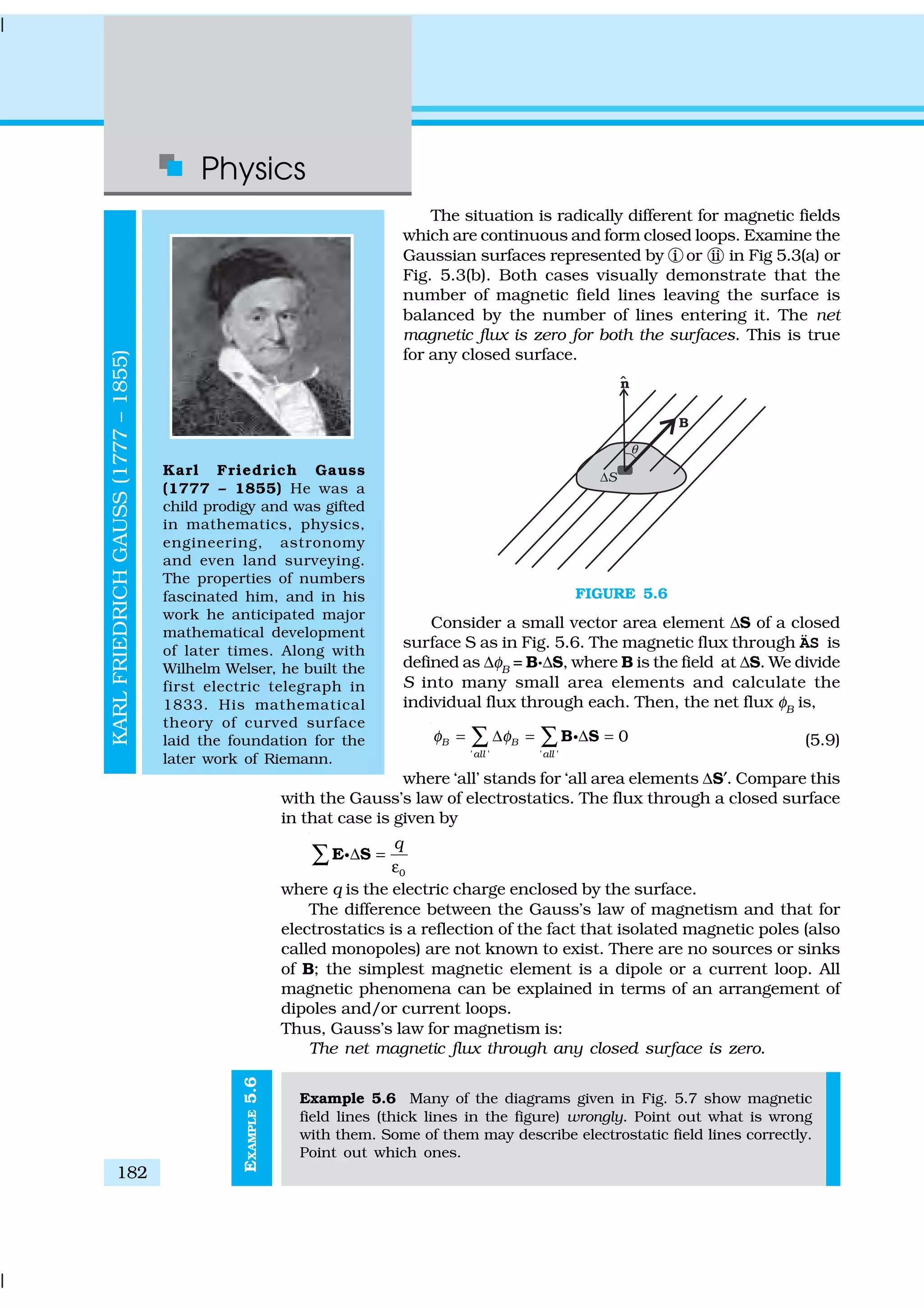
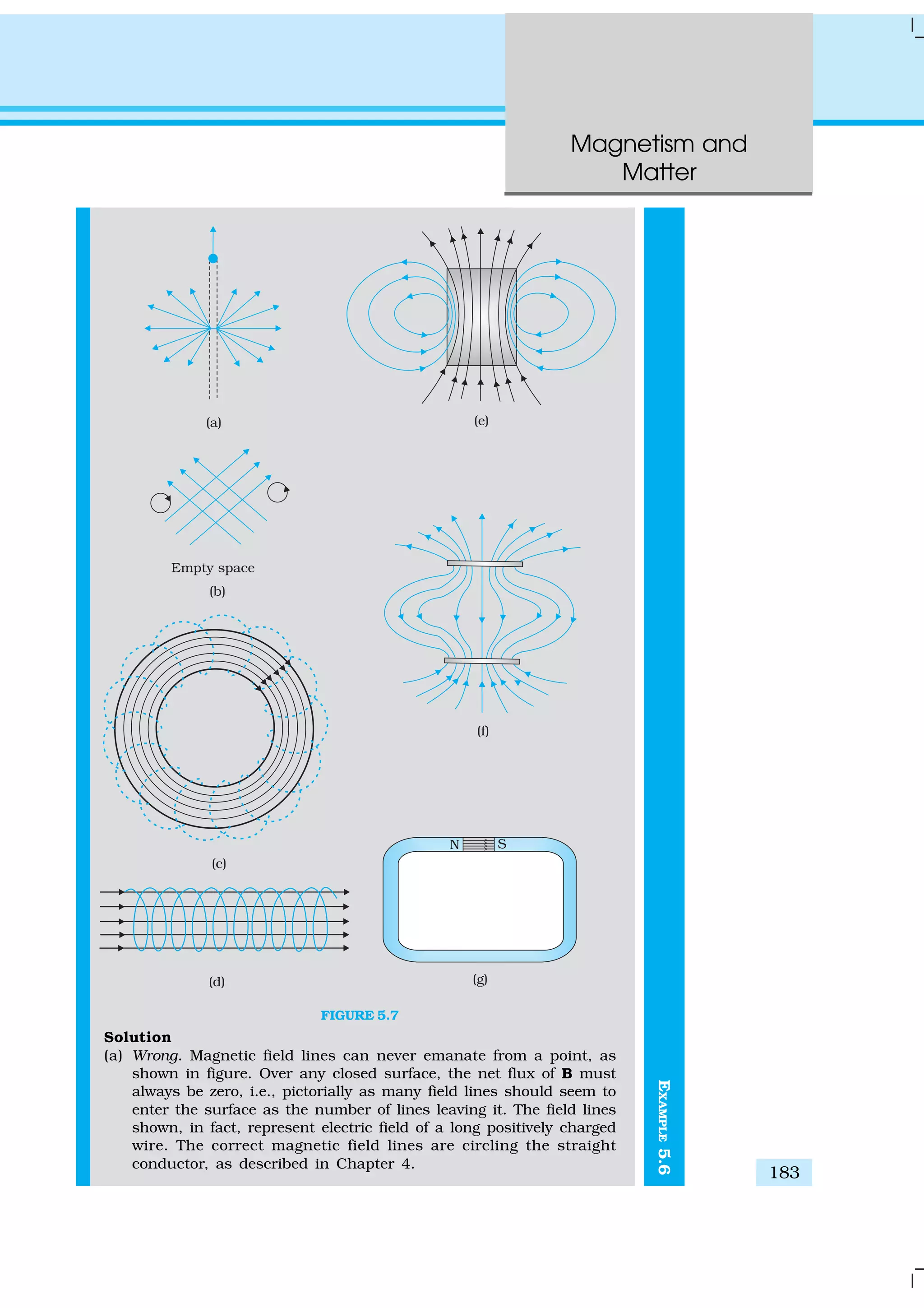
![Physics
184
EXAMPLE5.7EXAMPLE5.6
(b) Wrong. Magnetic field lines (like electric field lines) can never cross
each other, because otherwise the direction of field at the point of
intersection is ambiguous. There is further error in the figure.
Magnetostatic field lines can never form closed loops around empty
space. A closed loop of static magnetic field line must enclose a
region across which a current is passing. By contrast, electrostatic
field lines can never form closed loops, neither in empty space,
nor when the loop encloses charges.
(c) Right. Magnetic lines are completely confined within a toroid.
Nothing wrong here in field lines forming closed loops, since each
loop encloses a region across which a current passes. Note, for
clarity of figure, only a few field lines within the toroid have been
shown. Actually, the entire region enclosed by the windings
contains magnetic field.
(d) Wrong. Field lines due to a solenoid at its ends and outside cannot
be so completely straight and confined; such a thing violates
Ampere’s law. The lines should curve out at both ends, and meet
eventually to form closed loops.
(e) Right. These are field lines outside and inside a bar magnet. Note
carefully the direction of field lines inside. Not all field lines emanate
out of a north pole (or converge into a south pole). Around both
the N-pole, and the S-pole, the net flux of the field is zero.
(f ) Wrong. These field lines cannot possibly represent a magnetic field.
Look at the upper region. All the field lines seem to emanate out of
the shaded plate. The net flux through a surface surrounding the
shaded plate is not zero. This is impossible for a magnetic field.
The given field lines, in fact, show the electrostatic field lines
around a positively charged upper plate and a negatively charged
lower plate. The difference between Fig. [5.7(e) and (f)] should be
carefully grasped.
(g) Wrong. Magnetic field lines between two pole pieces cannot be
precisely straight at the ends. Some fringing of lines is inevitable.
Otherwise, Ampere’s law is violated. This is also true for electric
field lines.
Example 5.7
(a) Magnetic field lines show the direction (at every point) along which
a small magnetised needle aligns (at the point). Do the magnetic
field lines also represent the lines of force on a moving charged
particle at every point?
(b) Magnetic field lines can be entirely confined within the core of a
toroid, but not within a straight solenoid. Why?
(c) If magnetic monopoles existed, how would the Gauss’s law of
magnetism be modified?
(d) Does a bar magnet exert a torque on itself due to its own field?
Does one element of a current-carrying wire exert a force on another
element of the same wire?
(e) Magnetic field arises due to charges in motion. Can a system have
magnetic moments even though its net charge is zero?
Solution
(a) No. The magnetic force is always normal to B (remember magnetic
force = qv × B). It is misleading to call magnetic field lines as lines
of force.](https://image.slidesharecdn.com/ncert-class-12-physics-part-1-161112171109/75/Ncert-class-12-physics-part-1-188-2048.jpg)
![Magnetism and
Matter
185
EXAMPLE5.7
(b) If field lines were entirely confined between two ends of a straight
solenoid, the flux through the cross-section at each end would be
non-zero. But the flux of field B through any closed surface must
always be zero. For a toroid, this difficulty is absent because it
has no ‘ends’.
(c) Gauss’s law of magnetism states that the flux of B through any
closed surface is always zero 0
S
d =∫ B sgÑ .
If monopoles existed, the right hand side would be equal to the
monopole (magnetic charge) qm
enclosed by S. [Analogous to
Gauss’s law of electrostatics, 0 mS
d qµ=∫ B sg where qm
is the
(monopole) magnetic charge enclosed by S.]
(d) No. There is no force or torque on an element due to the field
produced by that element itself. But there is a force (or torque) on
an element of the same wire. (For the special case of a straight
wire, this force is zero.)
(e) Yes. The average of the charge in the system may be zero. Yet, the
mean of the magnetic moments due to various current loops may
not be zero. We will come across such examples in connection
with paramagnetic material where atoms have net dipole moment
through their net charge is zero.
5.4 THE EARTH’S MAGNETISM
Earlier we have referred to the magnetic field of the earth. The strength of
the earth’s magnetic field varies from place to place on the earth’s surface;
its value being of the order of 10–5
T.
What causes the earth to have a magnetic field is not clear. Originally
the magnetic field was thought of as arising from a giant bar magnet
placed approximately along the axis of rotation of the earth and deep in
the interior. However, this simplistic picture is certainly not correct. The
magnetic field is now thought to arise due to electrical currents produced
by convective motion of metallic fluids (consisting mostly of molten
iron and nickel) in the outer core of the earth. This is known as the
dynamo effect.
The magnetic field lines of the earth resemble that of a (hypothetical)
magnetic dipole located at the centre of the earth. The axis of the dipole
does not coincide with the axis of rotation of the earth but is presently
titled by approximately 11.3º with respect to the later. In this way of looking
at it, the magnetic poles are located where the magnetic field lines due to
the dipole enter or leave the earth. The location of the north magnetic pole
is at a latitude of 79.74º N and a longitude of 71.8º W, a place somewhere
in north Canada. The magnetic south pole is at 79.74º S, 108.22º E in the
Antarctica.
The pole near the geographic north pole of the earth is called the north
magnetic pole. Likewise, the pole near the geographic south pole is called
oneldioGeomagneticfieldfrequentlyaskedquestions
http://www.ngdc.noaa.gov/seg/geomag/](https://image.slidesharecdn.com/ncert-class-12-physics-part-1-161112171109/75/Ncert-class-12-physics-part-1-189-2048.jpg)
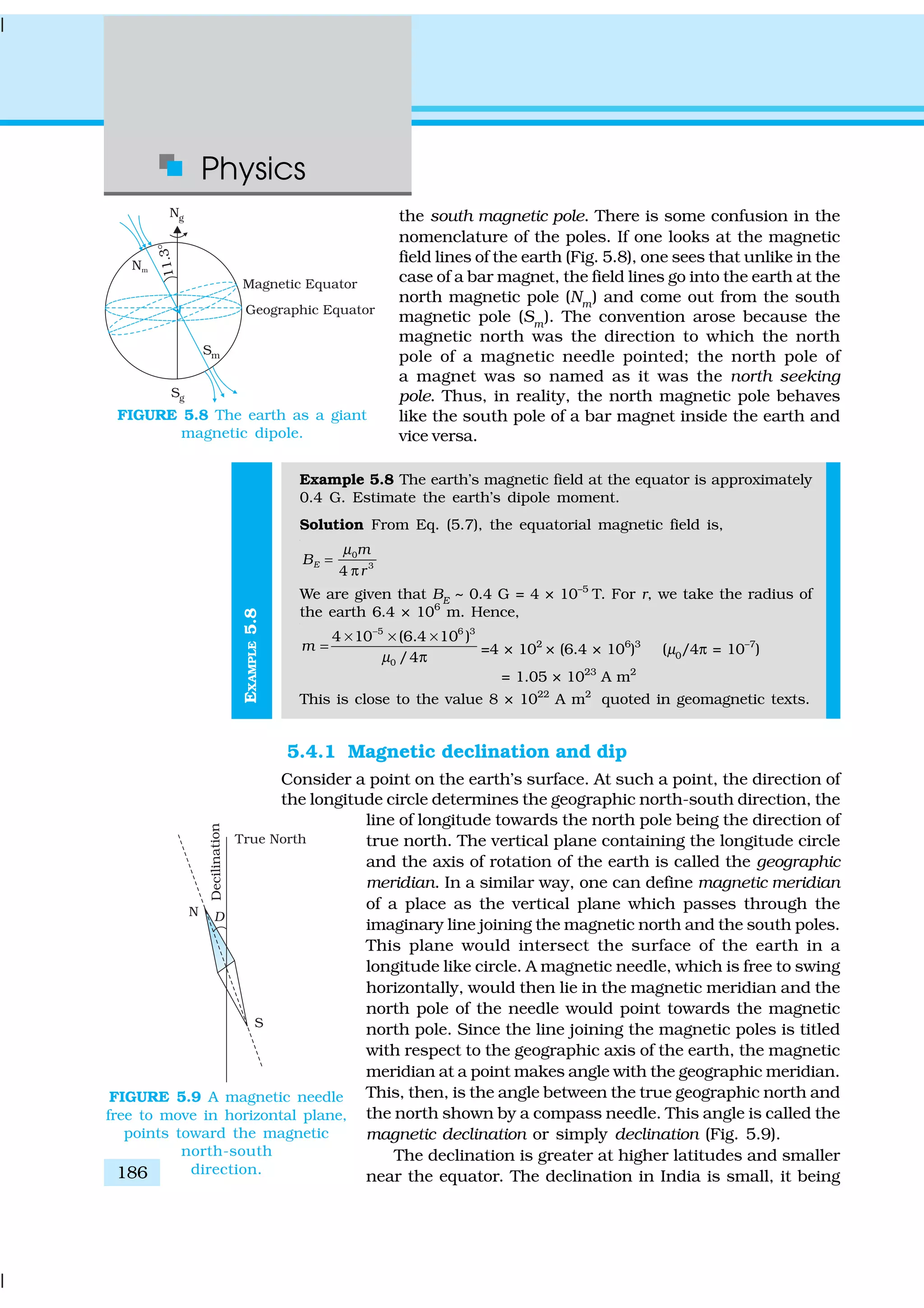
![Magnetism and
Matter
187
0º41′ E at Delhi and 0º58′ W at Mumbai. Thus, at both these places a
magnetic needle shows the true north quite accurately.
There is one more quantity of interest. If a magnetic needle is perfectly
balanced about a horizontal axis so that it can swing in a plane of the
magnetic meridian, the needle would make an angle with the horizontal
(Fig. 5.10). This is known as the angle of dip (also known as inclination).
Thus, dip is the angle that the total magnetic field BE of the earth makes
with the surface of the earth. Figure 5.11 shows the magnetic meridian
plane at a point P on the surface of the earth. The plane is a section through
the earth. The total magnetic field at P
can be resolved into a horizontal
component HE
and a vertical
component ZE. The angle that BE makes
with HE
is the angle of dip, I.
In most of the northern hemisphere, the north pole of the dip needle
tilts downwards. Likewise in most of the southern hemisphere, the south
pole of the dip needle tilts downwards.
To describe the magnetic field of the earth at a point on its surface, we
need to specify three quantities, viz., the declination D, the angle of dip or
the inclination I and the horizontal component of the earth’s field HE
. These
are known as the element of the earth’s magnetic field.
Representing the verticle component by ZE, we have
ZE
= BE
sinI [5.10(a)]
HE
= BE
cosI [5.10(b)]
which gives,
tan E
E
Z
I
H
= [5.10(c)]
FIGURE 5.10 The circle is a
section through the earth
containing the magnetic
meridian. The angle between BE
and the horizontal component
HE
is the angle of dip.
FIGURE 5.11 The earth’s
magnetic field, BE
, its horizontal
and vertical components, HE
and
ZE
. Also shown are the
declination, D and the
inclination or angle of dip, I.](https://image.slidesharecdn.com/ncert-class-12-physics-part-1-161112171109/75/Ncert-class-12-physics-part-1-191-2048.jpg)

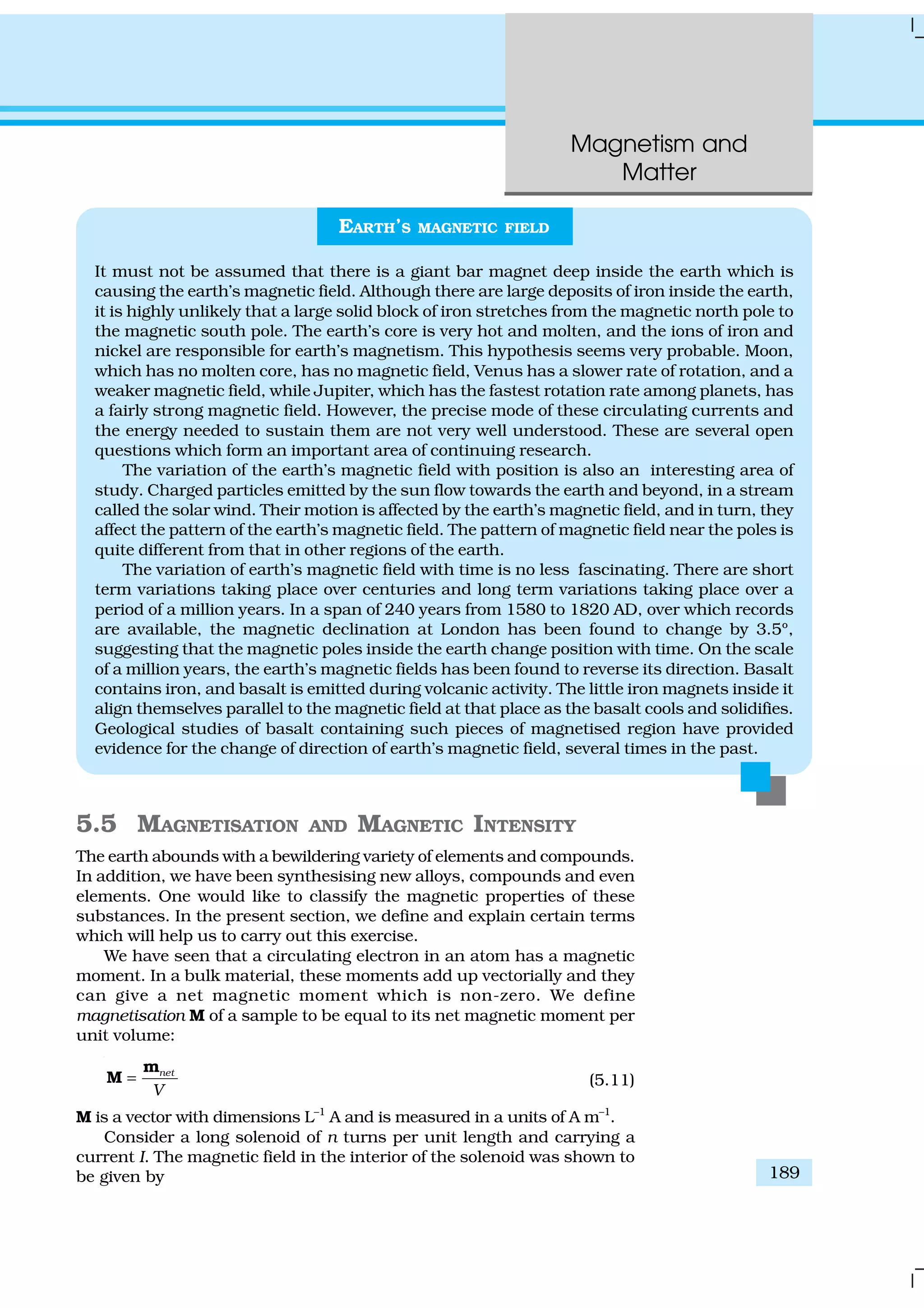
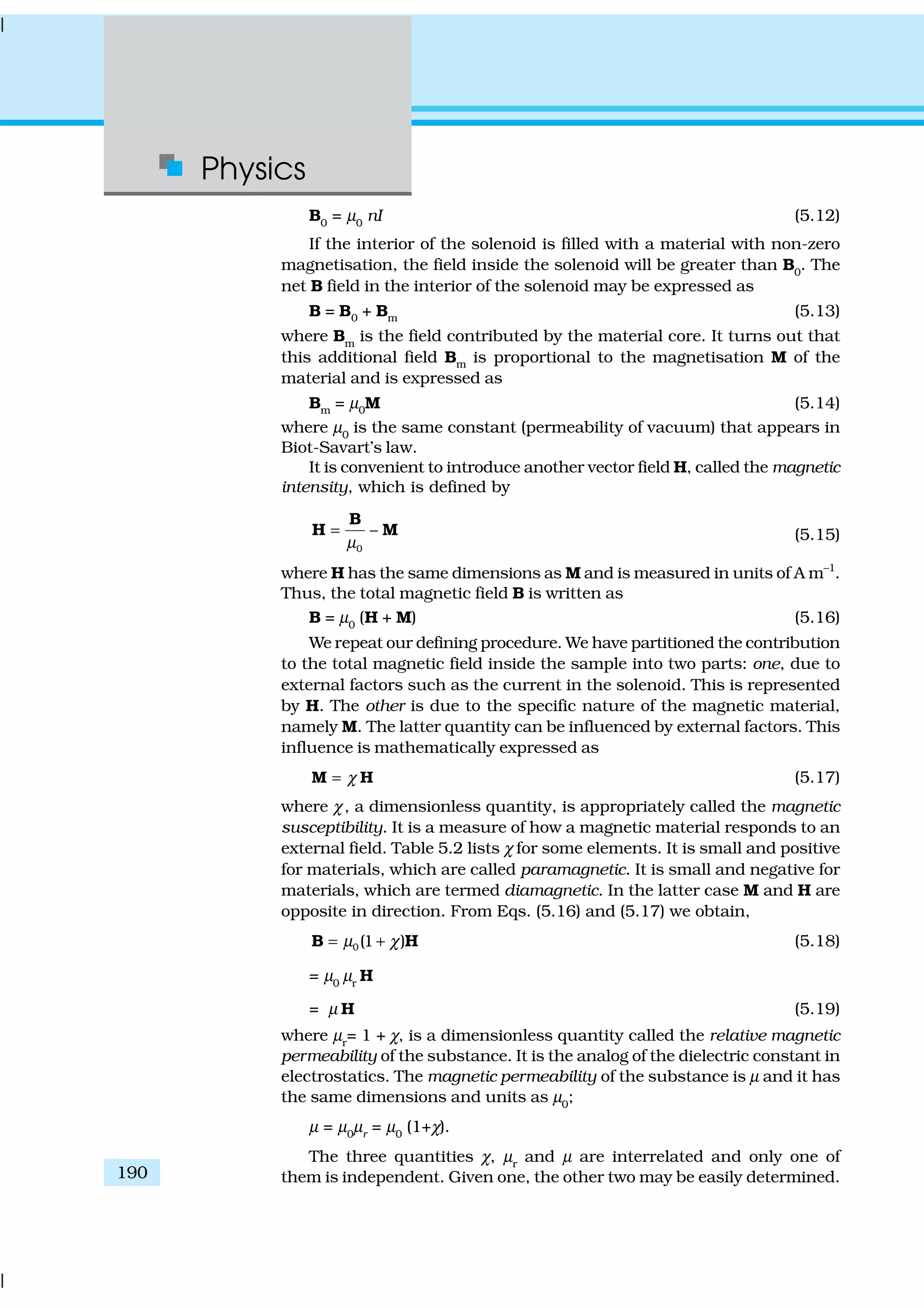
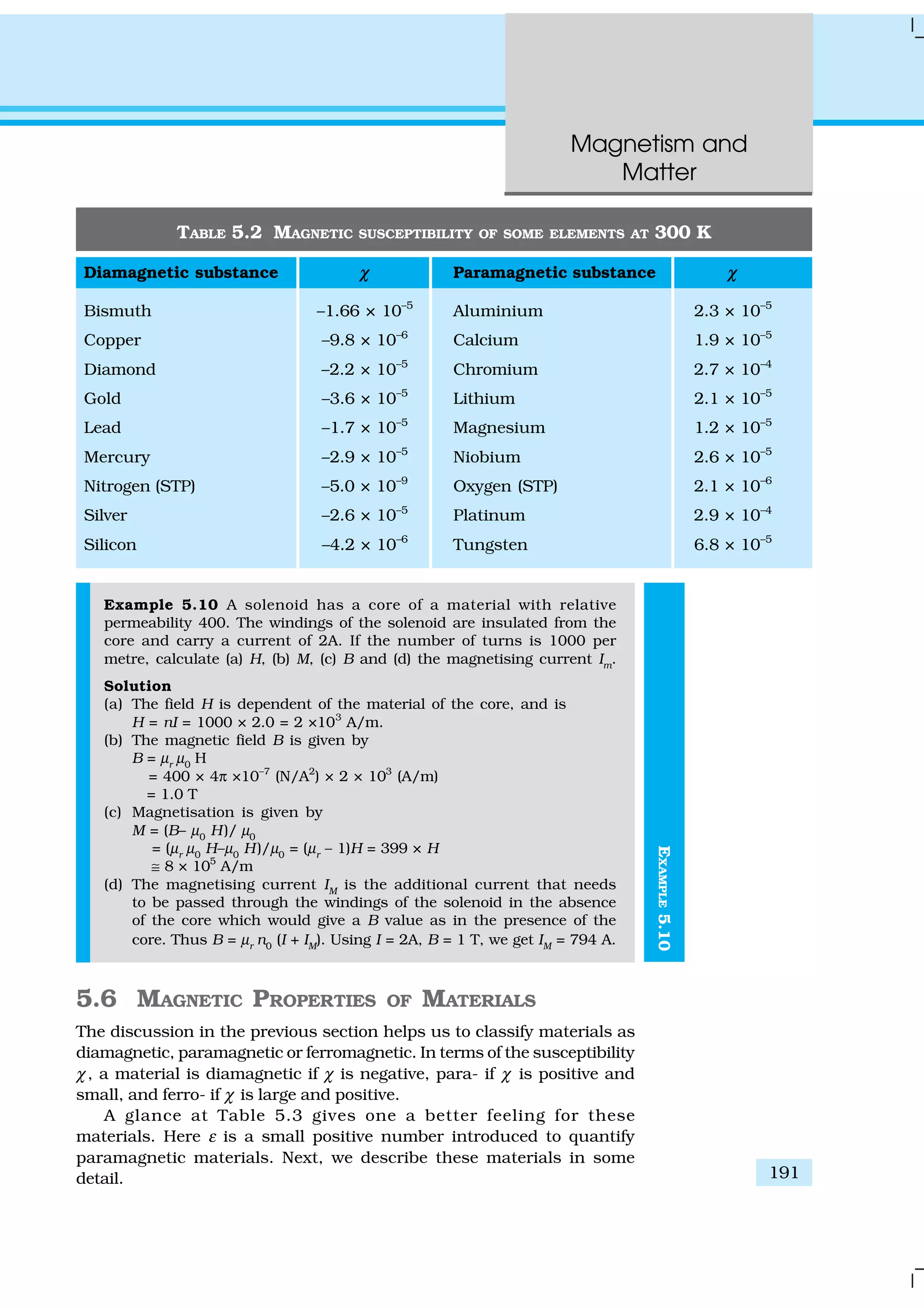
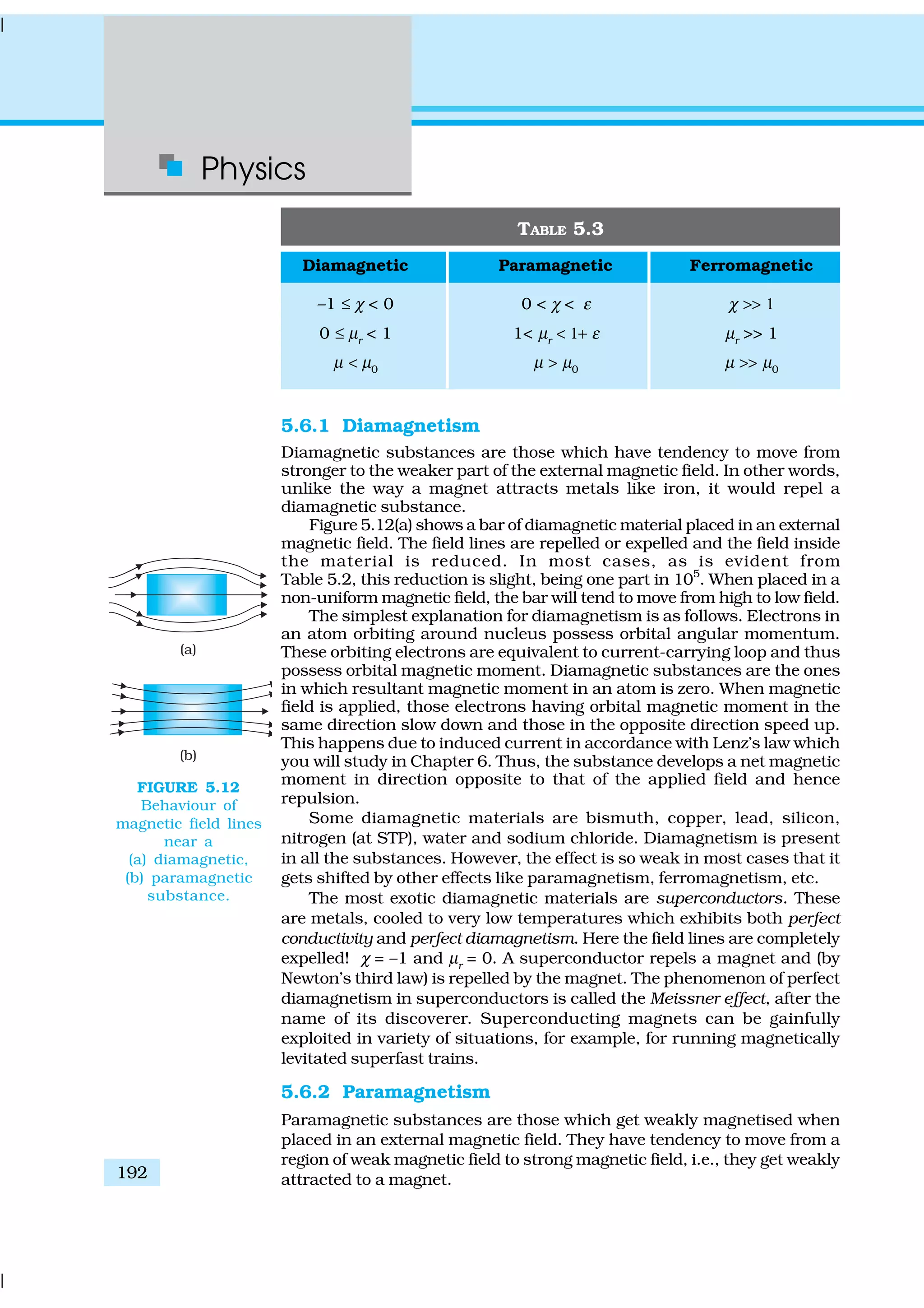
![Magnetism and
Matter
193
The individual atoms (or ions or molecules) of a paramagnetic material
possess a permanent magnetic dipole moment of their own. On account
of the ceaseless random thermal motion of the atoms, no net magnetisation
is seen. In the presence of an external field B0
, which is strong enough,
and at low temperatures, the individual atomic dipole moment can be
made to align and point in the same direction as B0. Figure 5.12(b) shows
a bar of paramagnetic material placed in an external field. The field lines
gets concentrated inside the material, and the field inside is enhanced. In
most cases, as is evident from Table 5.2, this enhancement is slight, being
one part in 105
. When placed in a non-uniform magnetic field, the bar
will tend to move from weak field to strong.
Some paramagnetic materials are aluminium, sodium, calcium,
oxygen (at STP) and copper chloride. Experimentally, one finds that the
magnetisation of a paramagnetic material is inversely proportional to the
absolute temperature T,
0B
M C
T
= [5.20(a)]
or equivalently, using Eqs. (5.12) and (5.17)
0
C
T
µ
χ = [5.20(b)]
This is known as Curie’s law, after its discoverer Pieree Curie (1859-
1906). The constant C is called Curie’s constant. Thus, for a paramagnetic
material both χ and µr depend not only on the material, but also
(in a simple fashion) on the sample temperature. As the field is
increased or the temperature is lowered, the magnetisation increases until
it reaches the saturation value Ms, at which point all the dipoles are
perfectly aligned with the field. Beyond this, Curie’s law [Eq. (5.20)] is no
longer valid.
5.6.3 Ferromagnetism
Ferromagnetic substances are those which gets strongly magnetised when
placed in an external magnetic field. They have strong tendency to move
from a region of weak magnetic field to strong magnetic field, i.e., they get
strongly attracted to a magnet.
The individual atoms (or ions or molecules) in a ferromagnetic material
possess a dipole moment as in a paramagnetic material. However, they
interact with one another in such a way that they spontaneously align
themselves in a common direction over a macroscopic volume called
domain. The explanation of this cooperative effect requires quantum
mechanics and is beyond the scope of this textbook. Each domain has a
net magnetisation. Typical domain size is 1mm and the domain contains
about 1011
atoms. In the first instant, the magnetisation varies randomly
from domain to domain and there is no bulk magnetisation. This is shown
in Fig. 5.13(a). When we apply an external magnetic field B0
, the domains
orient themselves in the direction of B0 and simultaneously the domain
oriented in the direction of B0
grow in size. This existence of domains and
their motion in B0
are not speculations. One may observe this under a
microscope after sprinkling a liquid suspension of powdered
FIGURE 5.13
(a) Randomly
oriented domains,
(b) Aligned domains.
Magneticmaterials,domain,etc.:
http://www.aacg.bham.ac.uk/magnetic_materials/](https://image.slidesharecdn.com/ncert-class-12-physics-part-1-161112171109/75/Ncert-class-12-physics-part-1-197-2048.jpg)

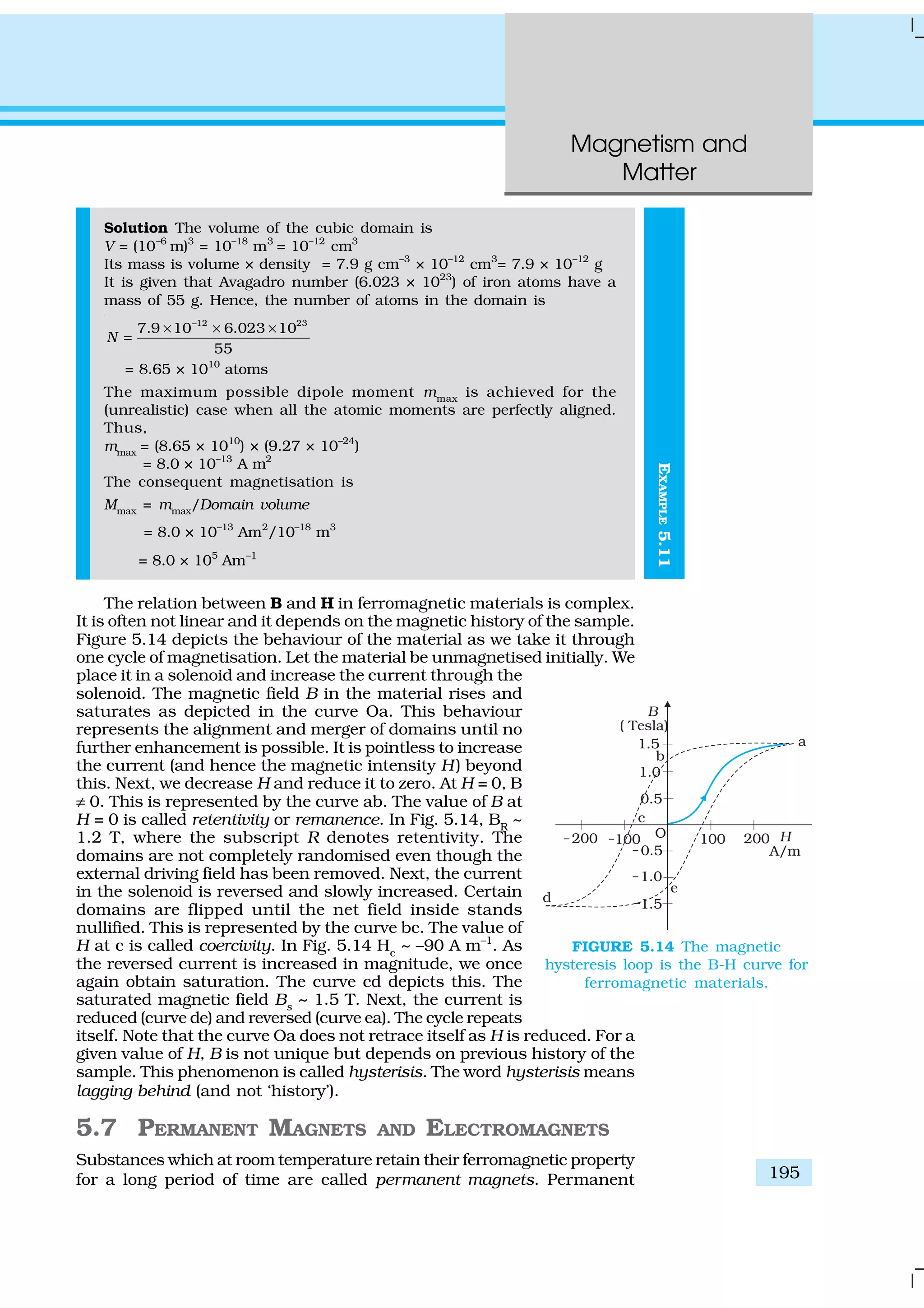
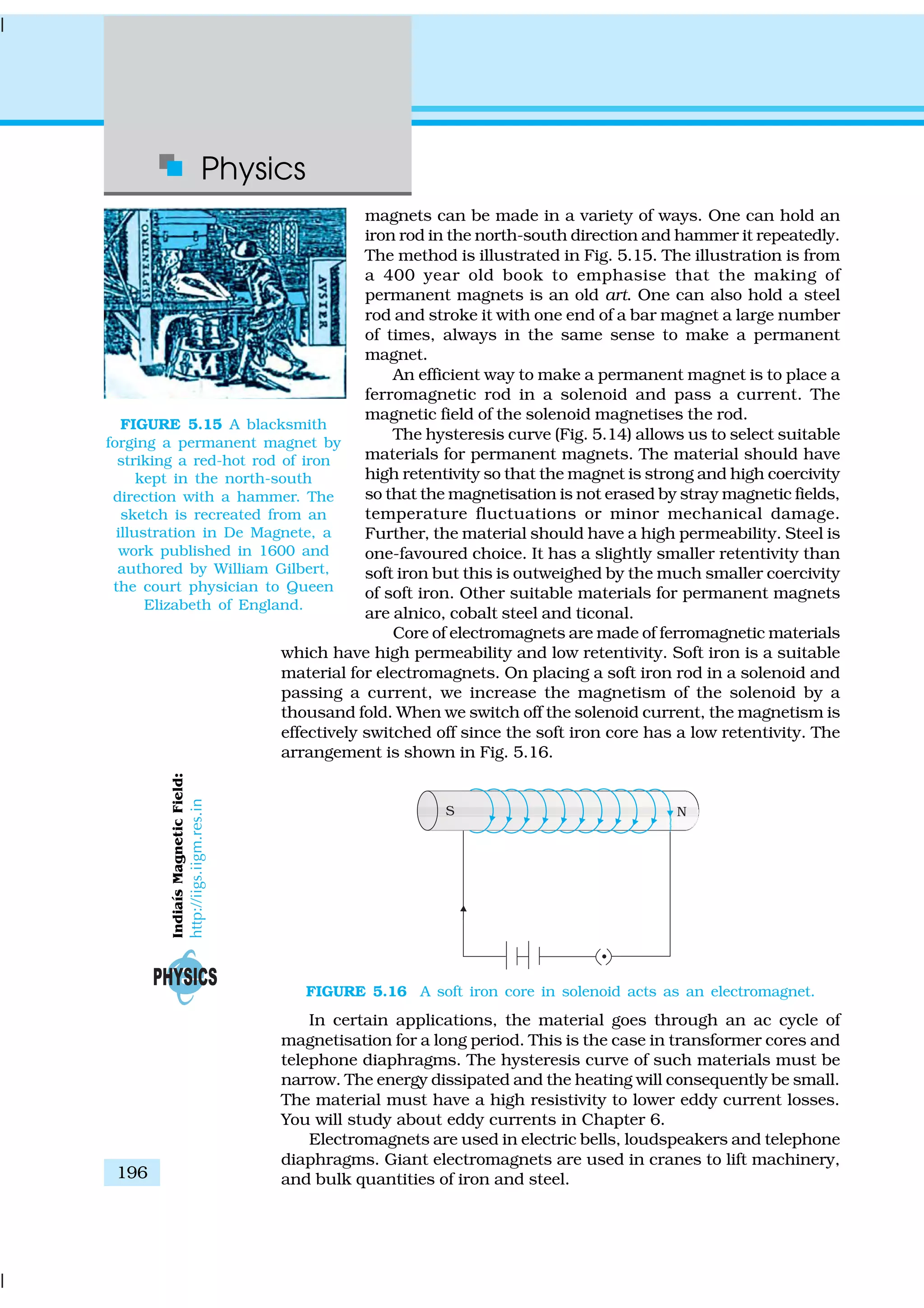
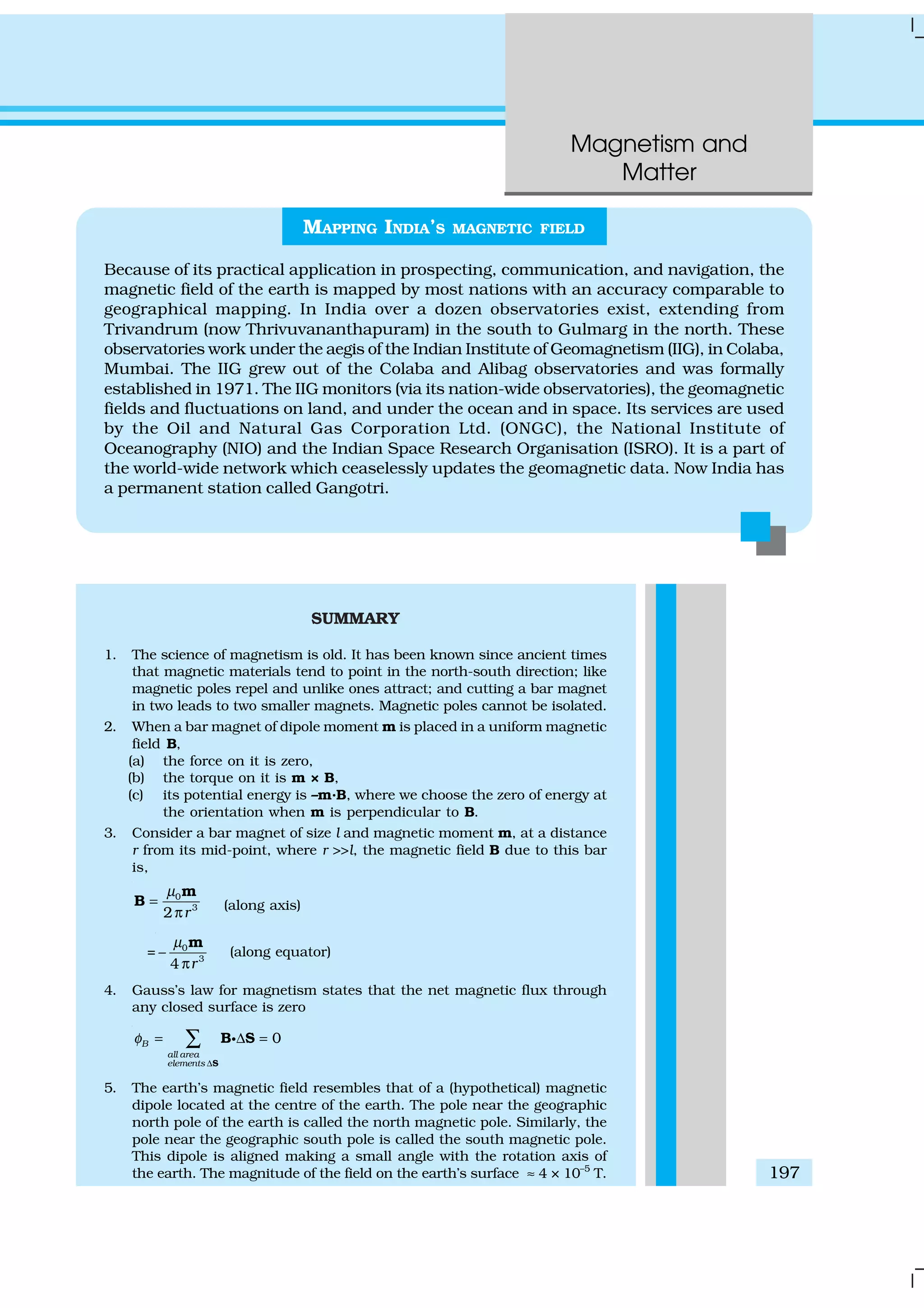
![Physics
198
6. Three quantities are needed to specify the magnetic field of the earth
on its surface – the horizontal component, the magnetic declination,
and the magnetic dip. These are known as the elements of the earth’s
magnetic field.
7. Consider a material placed in an external magnetic field B0
. The
magnetic intensity is defined as,
0
0µ
=
B
H
The magnetisation M of the material is its dipole moment per unit volume.
The magnetic field B in the material is,
B = µ0 (H + M)
8. For a linear material M = χ H. So that B = µ H and χ is called the
magnetic susceptibility of the material. The three quantities, χ, the
relative magnetic permeability µr
, and the magnetic permeability µ are
related as follows:
µ = µ0
µr
µr = 1+ χ
9. Magnetic materials are broadly classified as: diamagnetic, paramagnetic,
and ferromagnetic. For diamagnetic materials χ is negative and small
and for paramagnetic materials it is positive and small. Ferromagnetic
materials have large χ and are characterised by non-linear relation
between B and H. They show the property of hysteresis.
10. Substances, which at room temperature, retain their ferromagnetic
property for a long period of time are called permanent magnets.
Physical quantity Symbol Nature Dimensions Units Remarks
Permeability of µ0
Scalar [MLT–2
A–2
] T m A–1
µ0
/4π = 10–7
free space
Magnetic field, B Vector [MT–2
A–1
] T (tesla) 104
G (gauss) = 1 T
Magnetic induction,
Magnetic flux density
Magnetic moment m Vector [L–2
A] A m2
Magnetic flux φB
Scalar [ML2
T–2
A–1
] W (weber) W = T m2
Magnetisation M Vector [L–1
A] A m–1
Magnetic moment
Volume
Magnetic intensity H Vector [L–1
A] A m–1
B = µ0
(H + M)
Magnetic field
strength
Magnetic χ Scalar - - M = χH
susceptibility
Relative magnetic µr
Scalar - - B = µ0
µr
H
permeability
Magnetic permeability µ Scalar [MLT–2
A–2
] T m A–1
µ = µ0
µr
N A–2
B = µ H](https://image.slidesharecdn.com/ncert-class-12-physics-part-1-161112171109/75/Ncert-class-12-physics-part-1-202-2048.jpg)
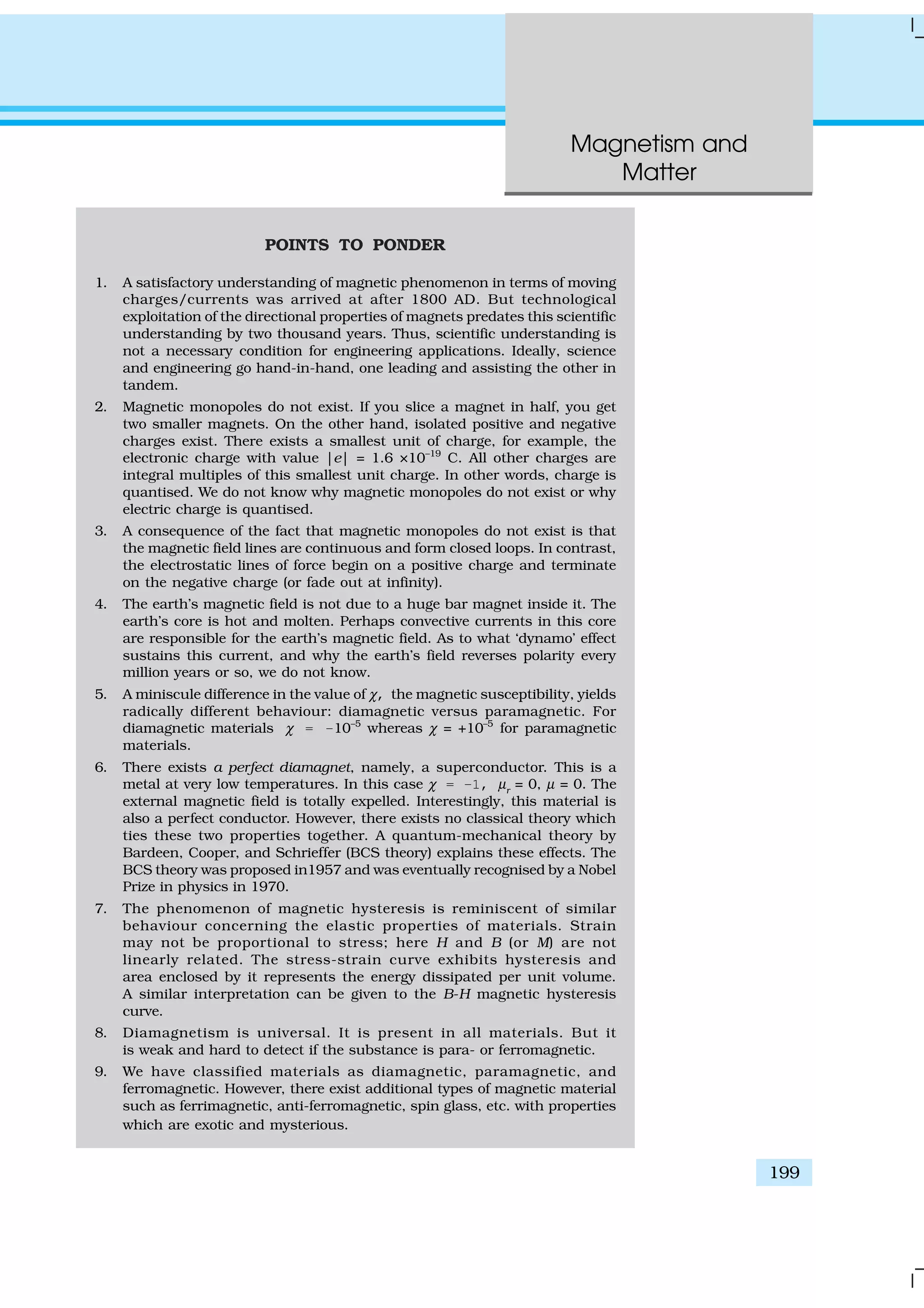
![Physics
200
EXERCISES
5.1 Answer the following questions regarding earth’s magnetism:
(a) A vector needs three quantities for its specification. Name the
three independent quantities conventionally used to specify the
earth’s magnetic field.
(b) The angle of dip at a location in southern India is about 18º.
Would you expect a greater or smaller dip angle in Britain?
(c) If you made a map of magnetic field lines at Melbourne in
Australia, would the lines seem to go into the ground or come out
of the ground?
(d) In which direction would a compass free to move in the vertical
plane point to, if located right on the geomagnetic north or south
pole?
(e) The earth’s field, it is claimed, roughly approximates the field
due to a dipole of magnetic moment 8 × 1022
J T–1
located at its
centre. Check the order of magnitude of this number in some
way.
(f ) Geologists claim that besides the main magnetic N-S poles, there
are several local poles on the earth’s surface oriented in different
directions. How is such a thing possible at all?
5.2 Answer the following questions:
(a) The earth’s magnetic field varies from point to point in space.
Does it also change with time? If so, on what time scale does it
change appreciably?
(b) The earth’s core is known to contain iron. Yet geologists do not
regard this as a source of the earth’s magnetism. Why?
(c) The charged currents in the outer conducting regions of the
earth’s core are thought to be responsible for earth’s magnetism.
What might be the ‘battery’ (i.e., the source of energy) to sustain
these currents?
(d) The earth may have even reversed the direction of its field several
times during its history of 4 to 5 billion years. How can geologists
know about the earth’s field in such distant past?
(e) The earth’s field departs from its dipole shape substantially at
large distances (greater than about 30,000 km). What agencies
may be responsible for this distortion?
(f ) Interstellar space has an extremely weak magnetic field of the
order of 10–12
T. Can such a weak field be of any significant
consequence? Explain.
[Note: Exercise 5.2 is meant mainly to arouse your curiosity. Answers
to some questions above are tentative or unknown. Brief answers
wherever possible are given at the end. For details, you should consult
a good text on geomagnetism.]
5.3 A short bar magnet placed with its axis at 30º with a uniform external
magnetic field of 0.25 T experiences a torque of magnitude equal to
4.5 × 10–2
J. What is the magnitude of magnetic moment of the magnet?
5.4 A short bar magnet of magnetic moment m = 0.32 JT–1
is placed in a
uniform magnetic field of 0.15 T. If the bar is free to rotate in the
plane of the field, which orientation would correspond to its (a) stable,
and (b) unstable equilibrium? What is the potential energy of the
magnet in each case?](https://image.slidesharecdn.com/ncert-class-12-physics-part-1-161112171109/75/Ncert-class-12-physics-part-1-204-2048.jpg)
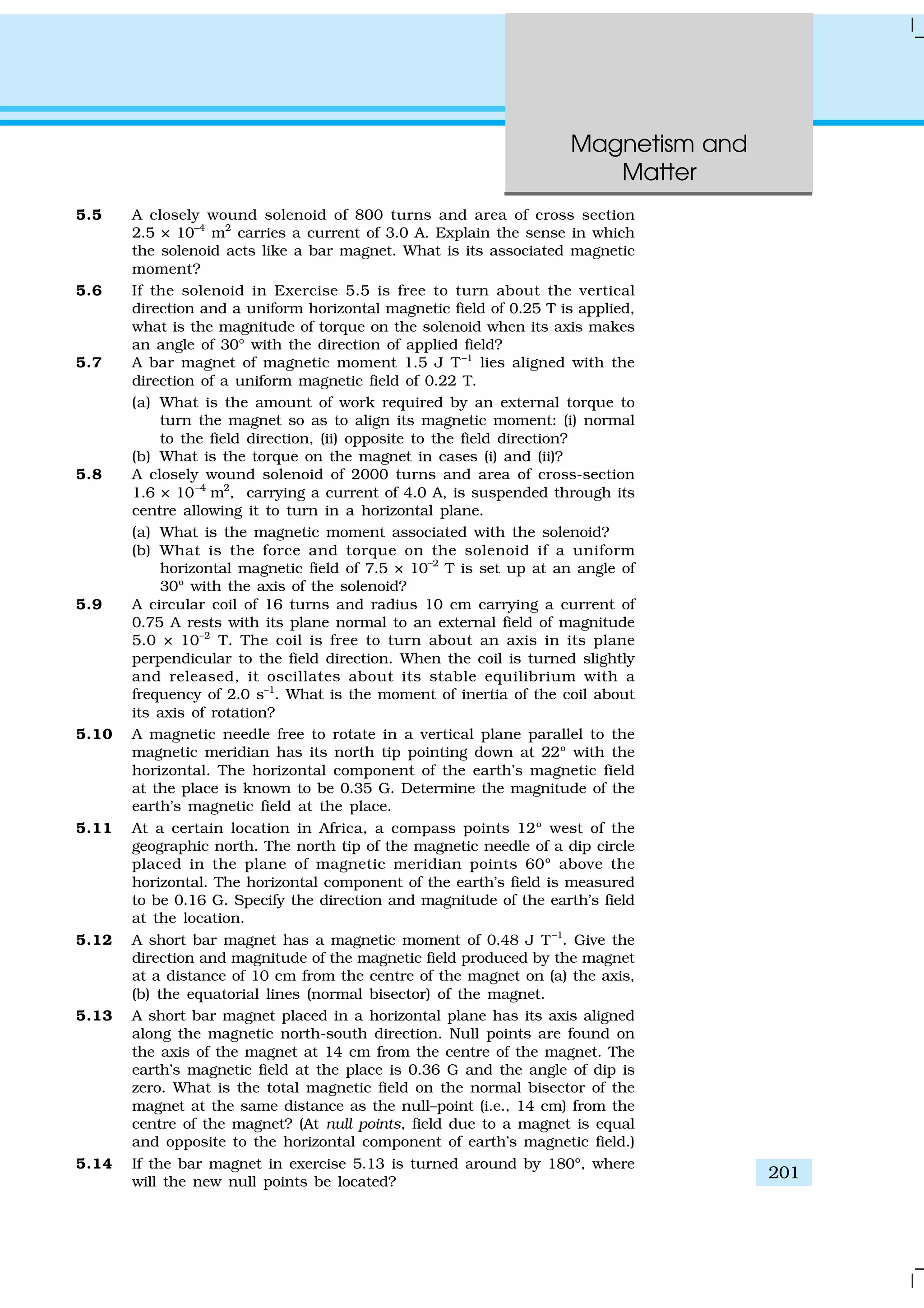
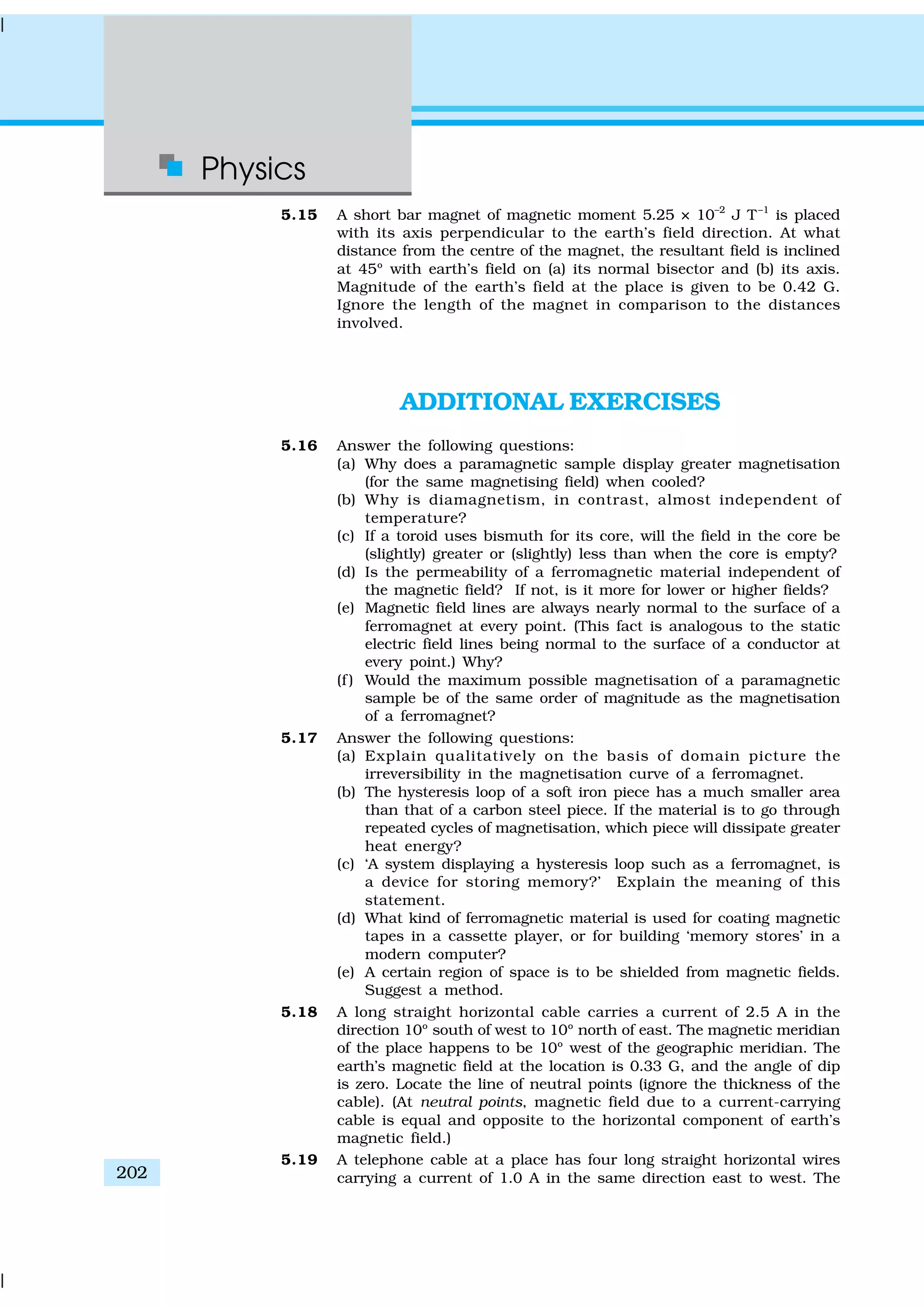
![Magnetism and
Matter
203
earth’s magnetic field at the place is 0.39 G, and the angle of dip is
35º. The magnetic declination is nearly zero. What are the resultant
magnetic fields at points 4.0 cm below the cable?
5.20 A compass needle free to turn in a horizontal plane is placed at the
centre of circular coil of 30 turns and radius 12 cm. The coil is in a
vertical plane making an angle of 45º with the magnetic meridian.
When the current in the coil is 0.35 A, the needle points west to
east.
(a) Determine the horizontal component of the earth’s magnetic field
at the location.
(b) The current in the coil is reversed, and the coil is rotated about
its vertical axis by an angle of 90º in the anticlockwise sense
looking from above. Predict the direction of the needle. Take the
magnetic declination at the places to be zero.
5.21 A magnetic dipole is under the influence of two magnetic fields. The
angle between the field directions is 60º, and one of the fields has a
magnitude of 1.2 × 10–2
T. If the dipole comes to stable equilibrium at
an angle of 15º with this field, what is the magnitude of the other
field?
5.22 A monoenergetic (18 keV) electron beam initially in the horizontal
direction is subjected to a horizontal magnetic field of 0.04 G normal
to the initial direction. Estimate the up or down deflection of the
beam over a distance of 30 cm (me
= 9.11 × 10–19
C). [Note: Data in
this exercise are so chosen that the answer will give you an idea of
the effect of earth’s magnetic field on the motion of the electron beam
from the electron gun to the screen in a TV set.]
5.23 A sample of paramagnetic salt contains 2.0 × 1024
atomic dipoles
each of dipole moment 1.5 × 10–23
J T–1
. The sample is placed under
a homogeneous magnetic field of 0.64 T, and cooled to a temperature
of 4.2 K. The degree of magnetic saturation achieved is equal to 15%.
What is the total dipole moment of the sample for a magnetic field of
0.98 T and a temperature of 2.8 K? (Assume Curie’s law)
5.24 A Rowland ring of mean radius 15 cm has 3500 turns of wire wound
on a ferromagnetic core of relative permeability 800. What is the
magnetic field B in the core for a magnetising current of 1.2 A?
5.25 The magnetic moment vectors µs
and µµl
associated with the intrinsic
spin angular momentum S and orbital angular momentum l,
respectively, of an electron are predicted by quantum theory (and
verified experimentally to a high accuracy) to be given by:
µs
= –(e/m) S,
µµl
= –(e/2m)l
Which of these relations is in accordance with the result expected
classically? Outline the derivation of the classical result.](https://image.slidesharecdn.com/ncert-class-12-physics-part-1-161112171109/75/Ncert-class-12-physics-part-1-207-2048.jpg)

![Electromagnetic
Induction
205
is not merely of theoretical or academic interest but also
of practical utility. Imagine a world where there is no
electricity – no electric lights, no trains, no telephones and
no personal computers. The pioneering experiments of
Faraday and Henry have led directly to the development
of modern day generators and transformers. Today’s
civilisation owes its progress to a great extent to the
discovery of electromagnetic induction.
6.2 THE EXPERIMENTS OF FARADAY AND
HENRY
The discovery and understanding of electromagnetic
induction are based on a long series of experiments carried
out by Faraday and Henry. We shall now describe some
of these experiments.
Experiment6.1
Figure 6.1 shows a coil C1
* connected to a galvanometer
G. When the North-pole of a bar magnet is pushed
towards the coil, the pointer in the galvanometer deflects,
indicating the presence of electric current in the coil. The
deflection lasts as long as the bar magnet is in motion.
The galvanometer does not show any deflection when the
magnet is held stationary. When the magnet is pulled
away from the coil, the galvanometer shows deflection in
the opposite direction, which indicates reversal of the
current’s direction. Moreover, when the South-pole of
the bar magnet is moved towards or away from the
coil, the deflections in the galvanometer are opposite
to that observed with the North-pole for similar
movements. Further, the deflection (and hence current)
is found to be larger when the magnet is pushed
towards or pulled away from the coil faster. Instead,
when the bar magnet is held fixed and the coil C1
is
moved towards or away from the magnet, the same
effects are observed. It shows that it is the relative
motion between the magnet and the coil that is
responsible for generation (induction) of electric
current in the coil.
Experiment6.2
In Fig. 6.2 the bar magnet is replaced by a second coil
C2
connected to a battery. The steady current in the
coil C2
produces a steady magnetic field. As coil C2
is
* Wherever the term ‘coil or ‘loop’ is used, it is assumed that they are made up of
conducting material and are prepared using wires which are coated with insulating
material.
FIGURE 6.1 When the bar magnet is
pushed towards the coil, the pointer in
the galvanometer G deflects.
Josheph Henry [1797 –
1878] American experimental
physicist professor at
Princeton University and first
director of the Smithsonian
Institution. He made important
improvements in electro-
magnets by winding coils of
insulated wire around iron
pole pieces and invented an
electromagnetic motor and a
new, efficient telegraph. He
discoverd self-induction and
investigated how currents in
one circuit induce currents in
another.
JOSEPHHENRY(1797–1878)](https://image.slidesharecdn.com/ncert-class-12-physics-part-1-161112171109/75/Ncert-class-12-physics-part-1-209-2048.jpg)
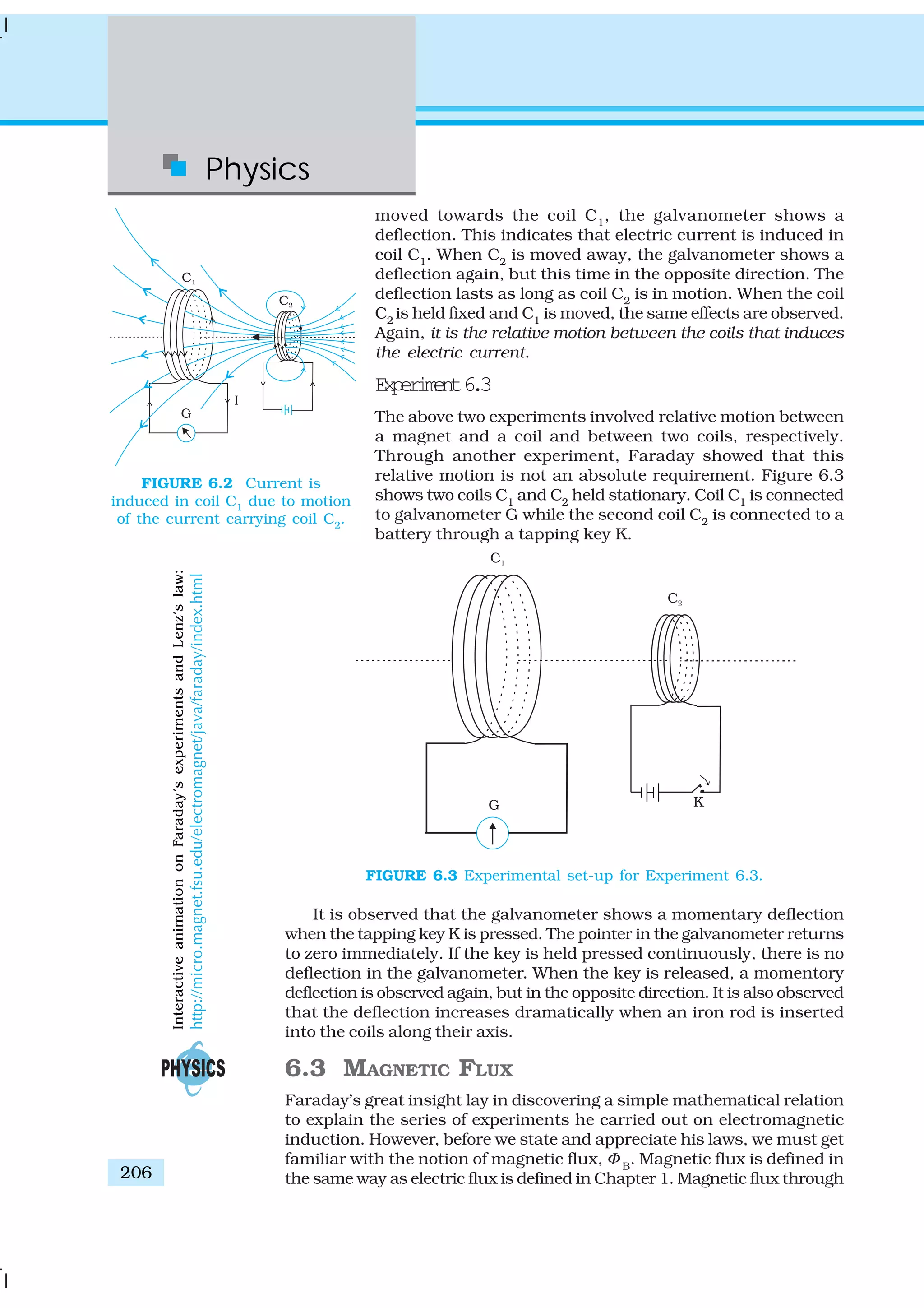
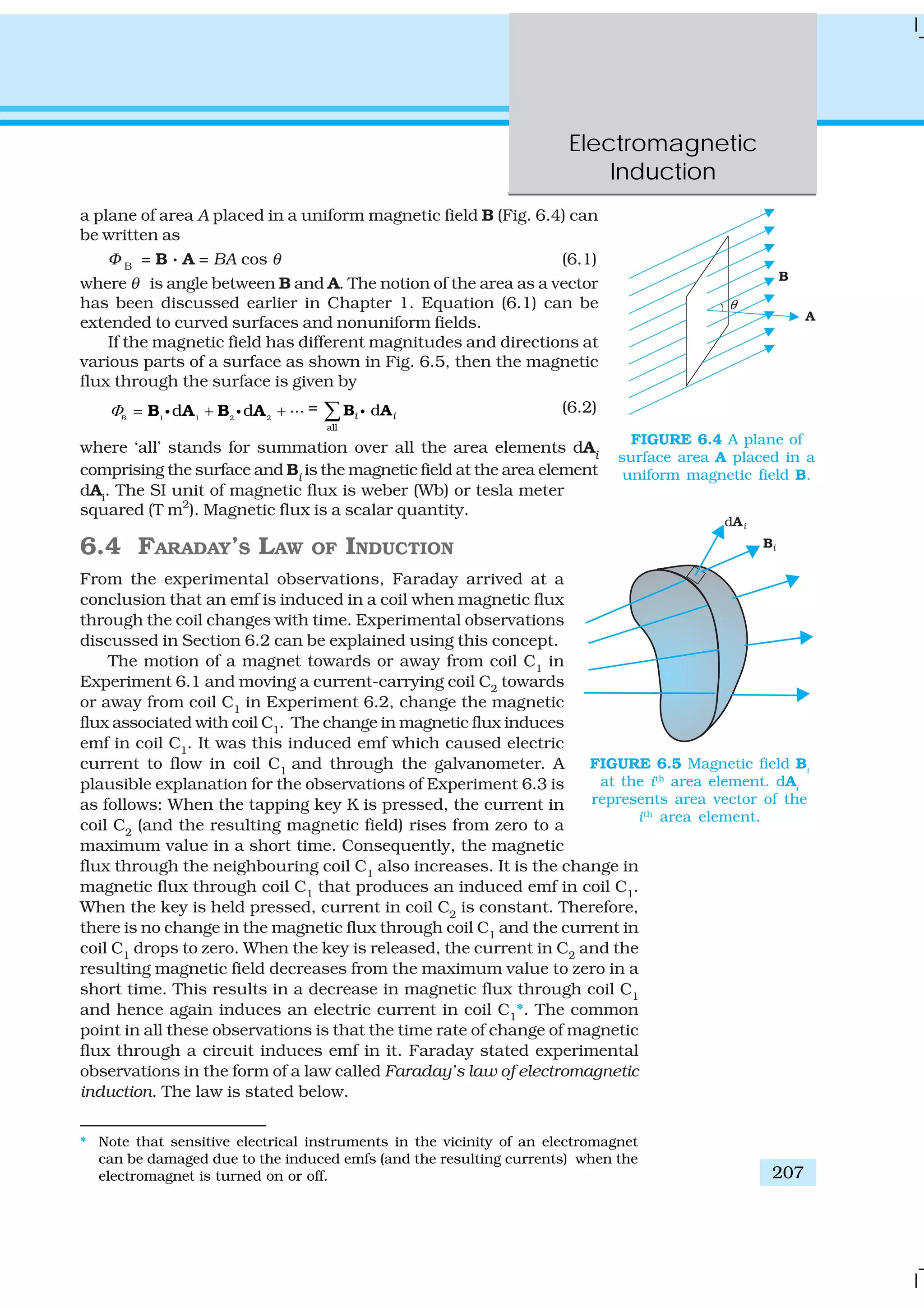
![Physics
208
EXAMPLE6.1
The magnitude of the induced emf in a circuit is equal
to the time rate of change of magnetic flux through the
circuit.
Mathematically, the induced emf is given by
d
–
d
B
t
Φ
ε = (6.3)
The negative sign indicates the direction of ε and hence
the direction of current in a closed loop. This will be
discussed in detail in the next section.
In the case of a closely wound coil of N turns, change
of flux associated with each turn, is the same. Therefore,
the expression for the total induced emf is given by
d
–
d
B
N
t
Φ
ε = (6.4)
The induced emf can be increased by increasing the
number of turns N of a closed coil.
From Eqs. (6.1) and (6.2), we see that the flux can be
varied by changing any one or more of the terms B, A and
θ. In Experiments 6.1 and 6.2 in Section 6.2, the flux is
changed by varying B. The flux can also be altered by
changing the shape of a coil (that is, by shrinking it or
stretching it) in a magnetic field, or rotating a coil in a
magnetic field such that the angle θ between B and A
changes. In these cases too, an emf is induced in the
respective coils.
Example 6.1 Consider Experiment 6.2. (a) What would you do to obtain
a large deflection of the galvanometer? (b) How would you demonstrate
the presence of an induced current in the absence of a galvanometer?
Solution
(a) To obtain a large deflection, one or more of the following steps can
be taken: (i) Use a rod made of soft iron inside the coil C2
, (ii) Connect
the coil to a powerful battery, and (iii) Move the arrangement rapidly
towards the test coil C1
.
(b) Replace the galvanometer by a small bulb, the kind one finds in a
small torch light. The relative motion between the two coils will cause
the bulb to glow and thus demonstrate the presence of an induced
current.
In experimental physics one must learn to innovate. Michael Faraday
who is ranked as one of the best experimentalists ever, was legendary
for his innovative skills.
Example 6.2 A square loop of side 10 cm and resistance 0.5 Ω is
placed vertically in the east-west plane. A uniform magnetic field of
0.10 T is set up across the plane in the north-east direction. The
magnetic field is decreased to zero in 0.70 s at a steady rate. Determine
the magnitudes of induced emf and current during this time-interval.
Michael Faraday [1791–
1867] Faraday made
numerous contributions to
science, viz., the discovery
of electromagnetic
induction, the laws of
electrolysis, benzene, and
the fact that the plane of
polarisation is rotated in an
electric field. He is also
credited with the invention
of the electric motor, the
electric generator and the
transformer. He is widely
regarded as the greatest
experimental scientist of
the nineteenth century.
MICHAELFARADAY(1791–1867)
EXAMPLE6.2](https://image.slidesharecdn.com/ncert-class-12-physics-part-1-161112171109/75/Ncert-class-12-physics-part-1-212-2048.jpg)
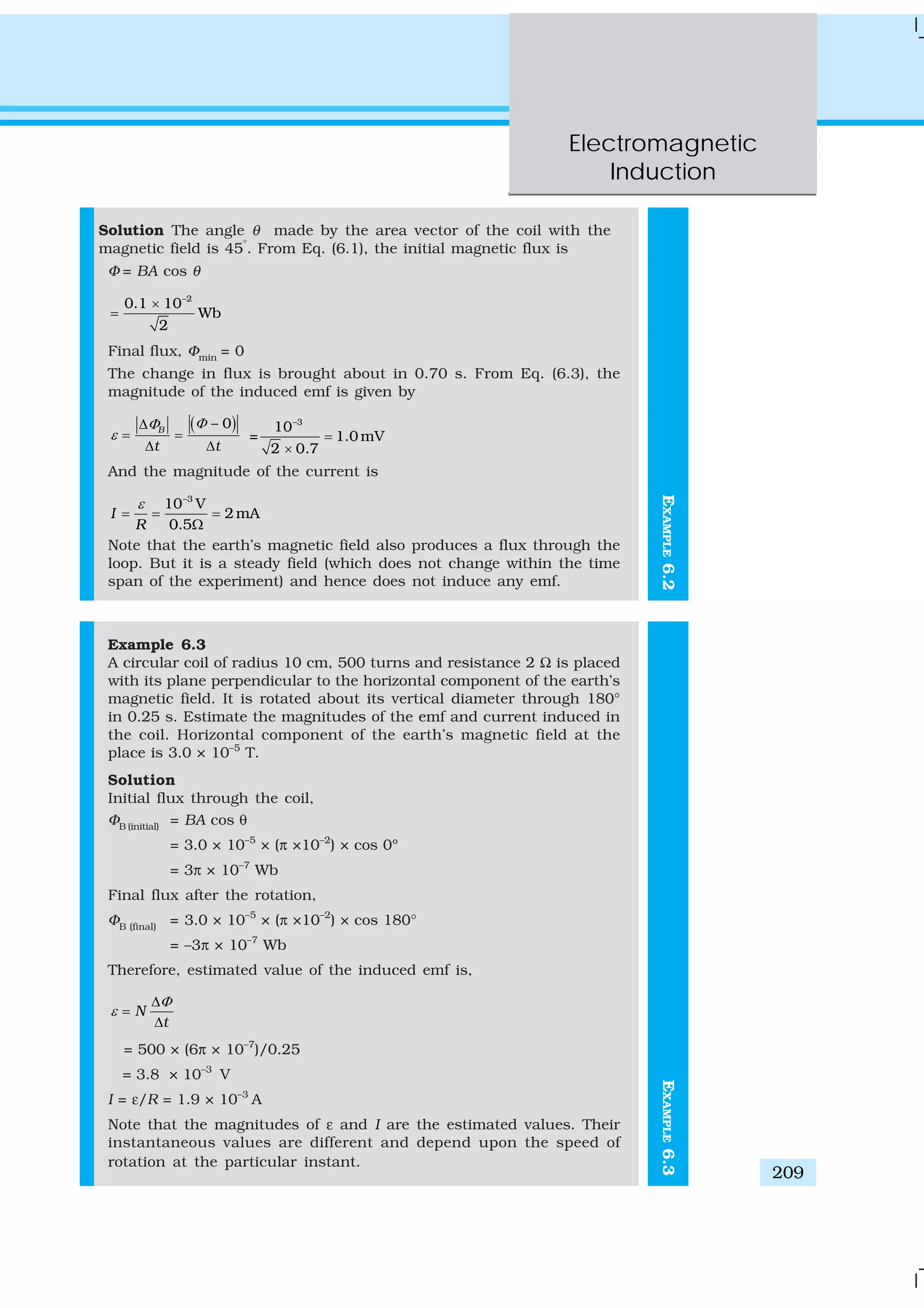
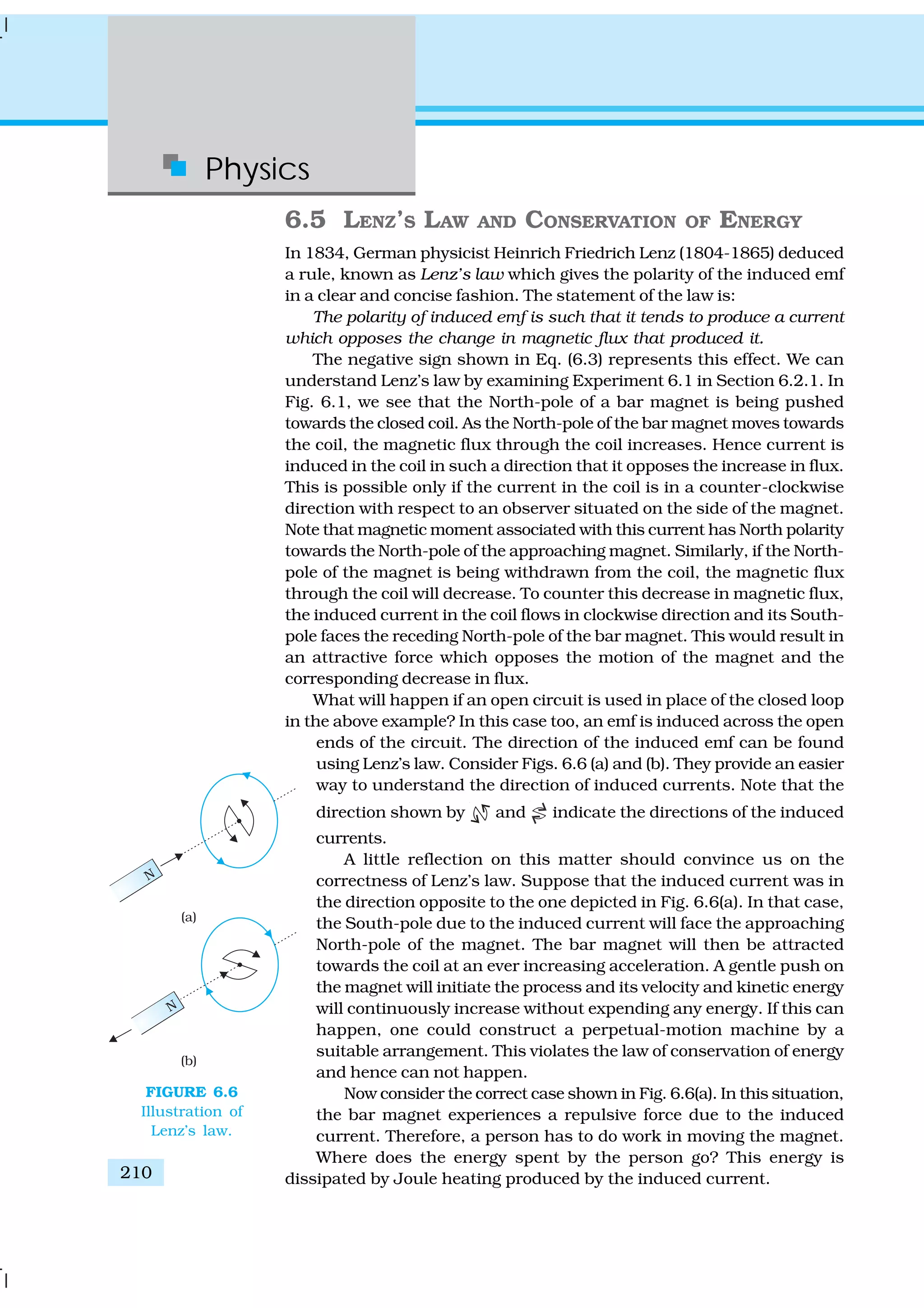
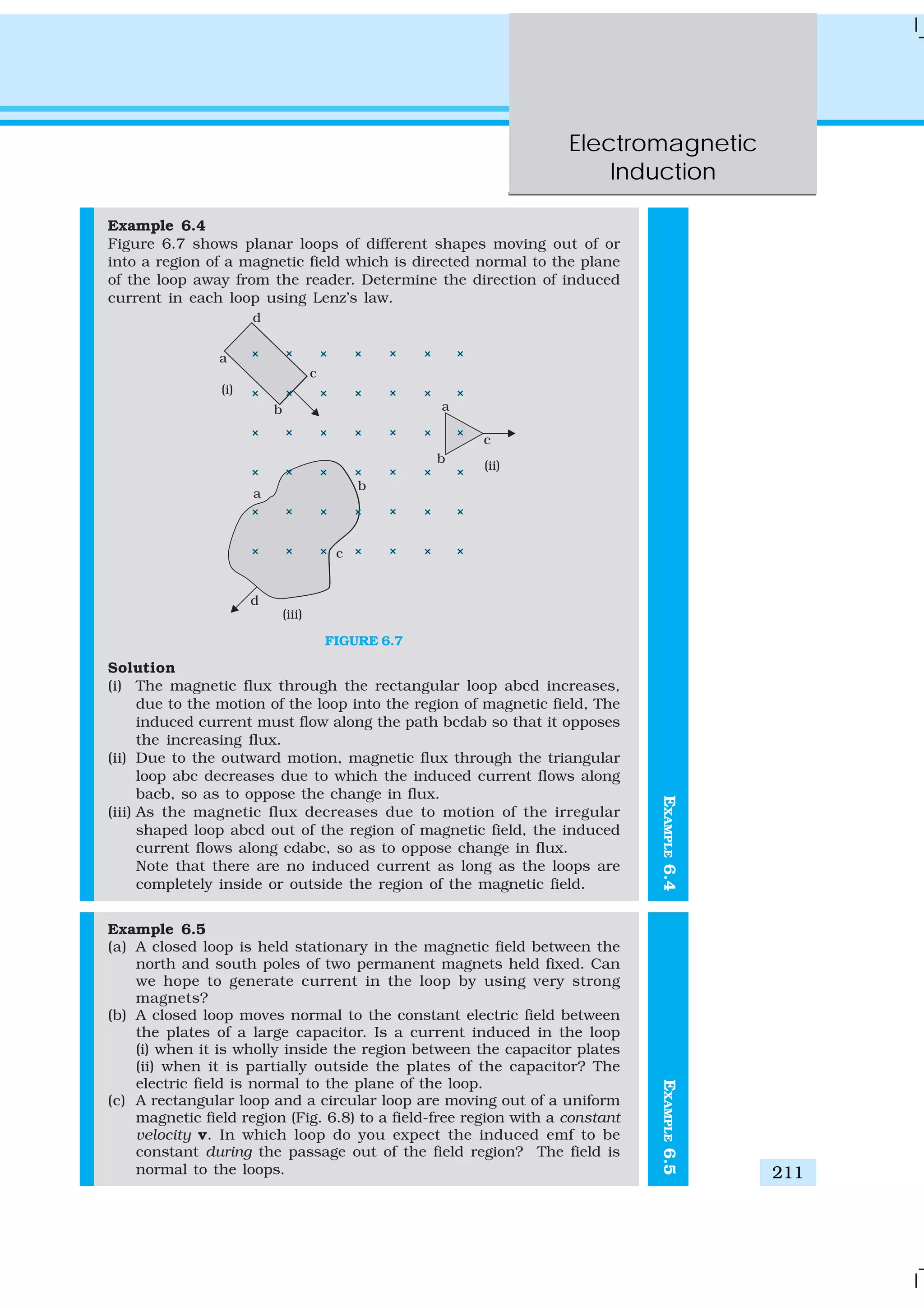
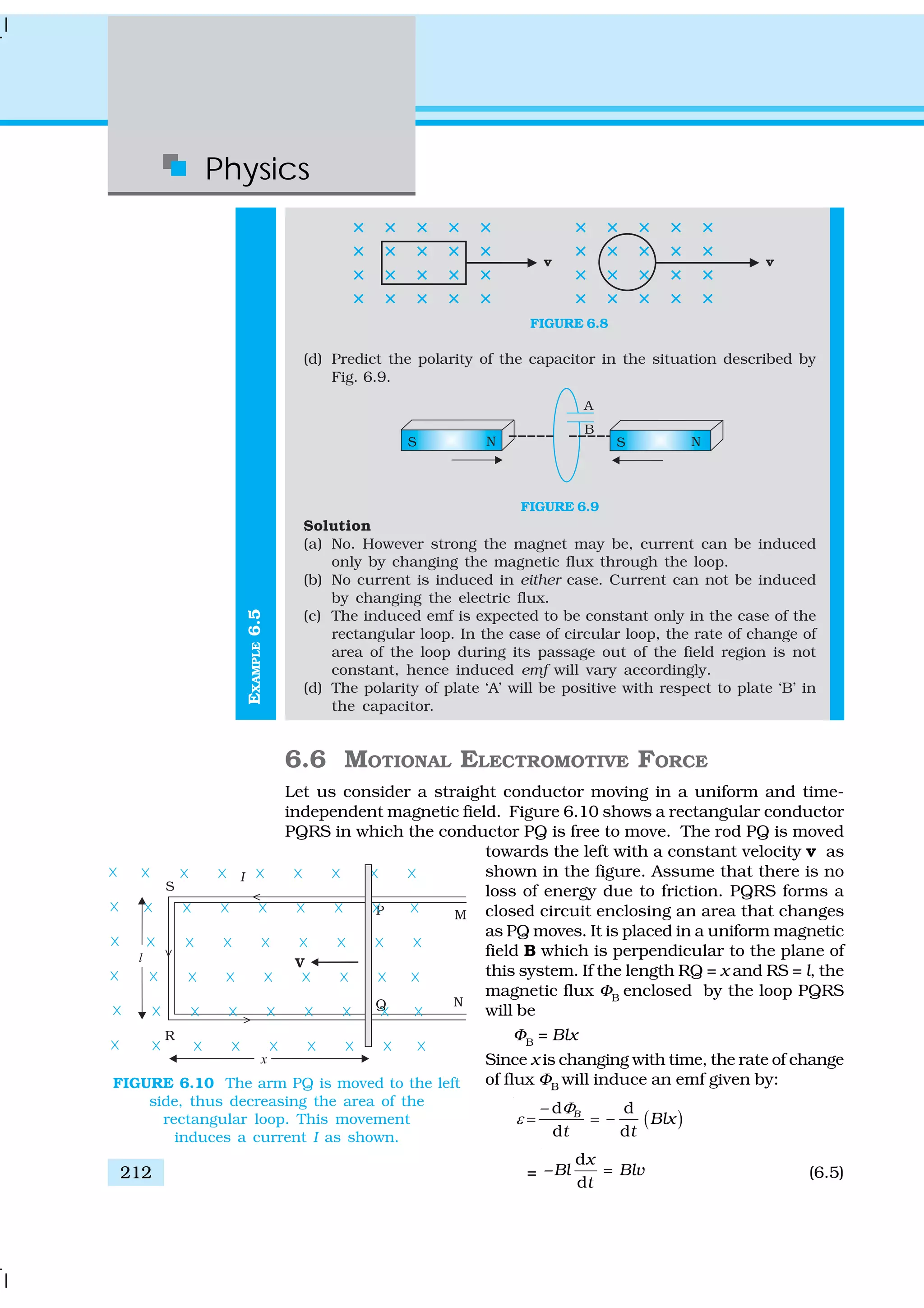
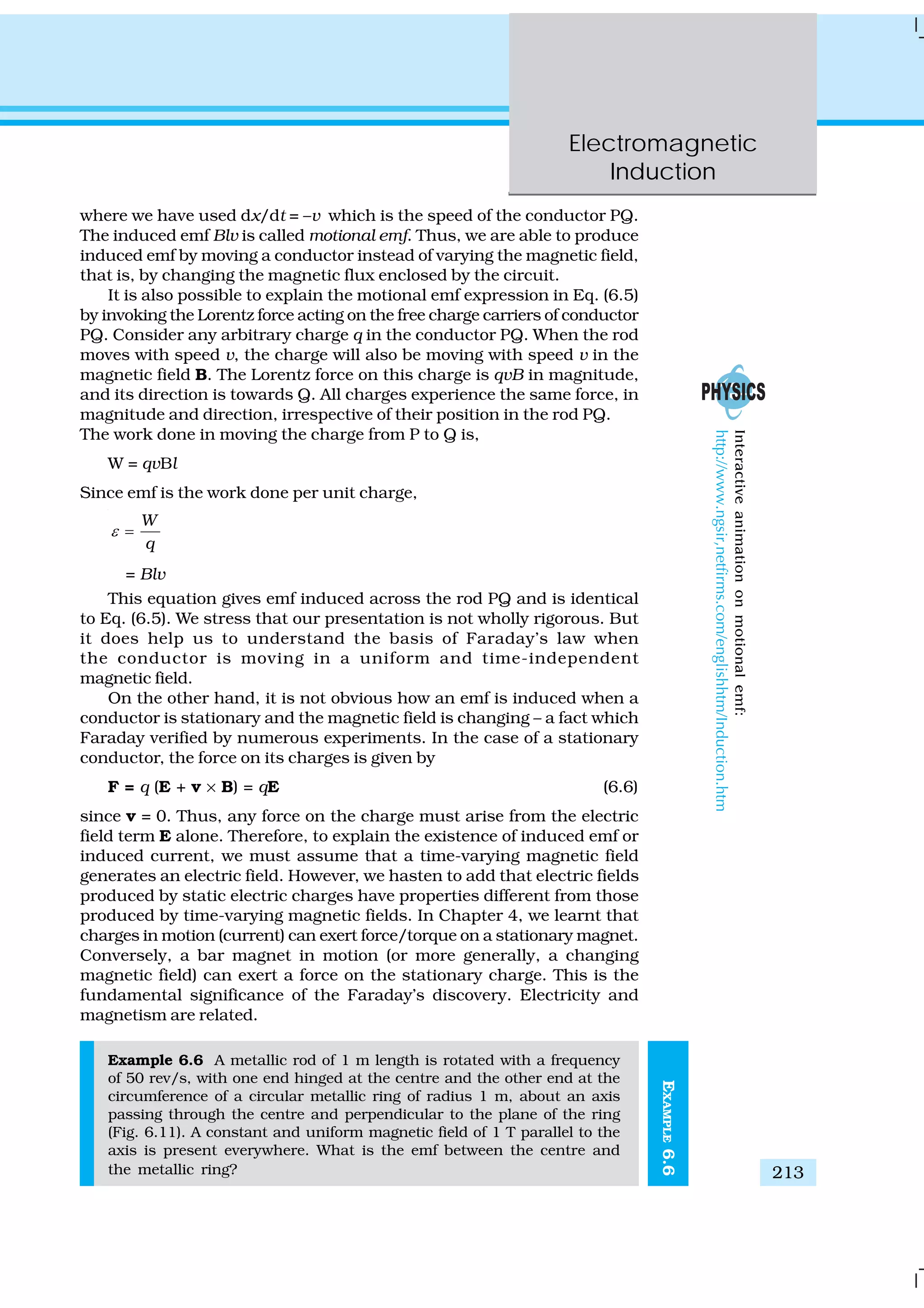
![Physics
214
EXAMPLE6.6
FIGURE 6.11
Solution
Method I
As the rod is rotated, free electrons in the rod move towards the outer
end due to Lorentz force and get distributed over the ring. Thus, the
resulting separation of charges produces an emf across the ends of
the rod. At a certain value of emf, there is no more flow of electrons
and a steady state is reached. Using Eq. (6.5), the magnitude of the
emf generated across a length dr of the rod as it moves at right angles
to the magnetic field is given by
d dBv rε = . Hence,
0
d d
R
Bv rε ε= =∫ ∫
2
0
d
2
R
B R
B r r
ω
ω= =∫
Note that we have used v = ω r. This gives
ε
21
1.0 2 50 (1 )
2
= × × π × ×
= 157 V
Method II
To calculate the emf, we can imagine a closed loop OPQ in which
point O and P are connected with a resistor R and OQ is the rotating
rod. The potential difference across the resistor is then equal to the
induced emf and equals B × (rate of change of area of loop). If θ is the
angle between the rod and the radius of the circle at P at time t, the
area of the sector OPQ is given by
2 21
2 2
R R
θ
θπ × =
π
where R is the radius of the circle. Hence, the induced emf is
ε =
2d 1
d 2
B R
t
θ
⎡ ⎤
× ⎢ ⎥⎣ ⎦
=
2
21 d
2 d 2
B R
BR
t
θ ω
=
[Note:
d
2
dt
θ
ω ν= = π ]
This expression is identical to the expression obtained by Method I
and we get the same value of ε.](https://image.slidesharecdn.com/ncert-class-12-physics-part-1-161112171109/75/Ncert-class-12-physics-part-1-218-2048.jpg)
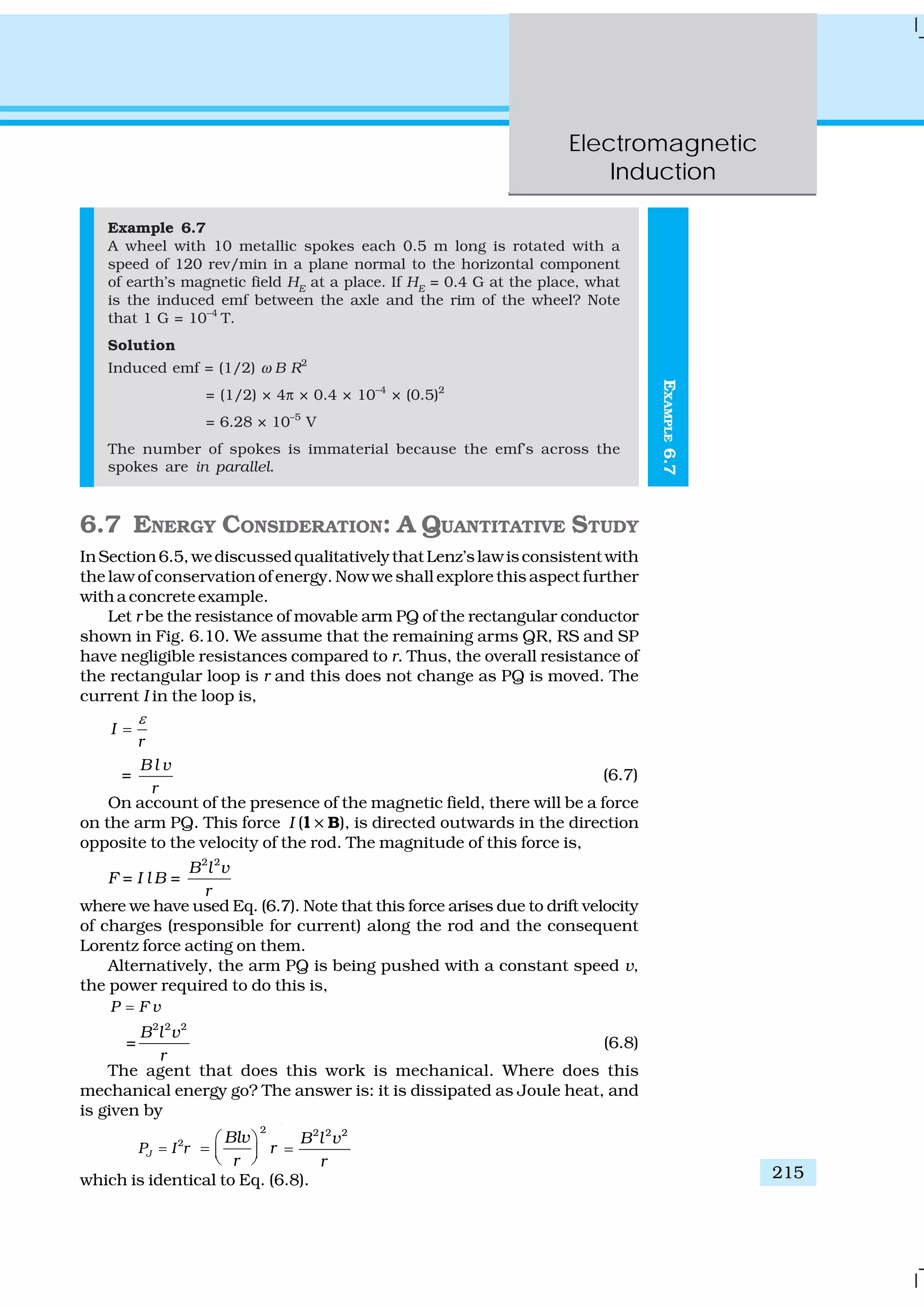
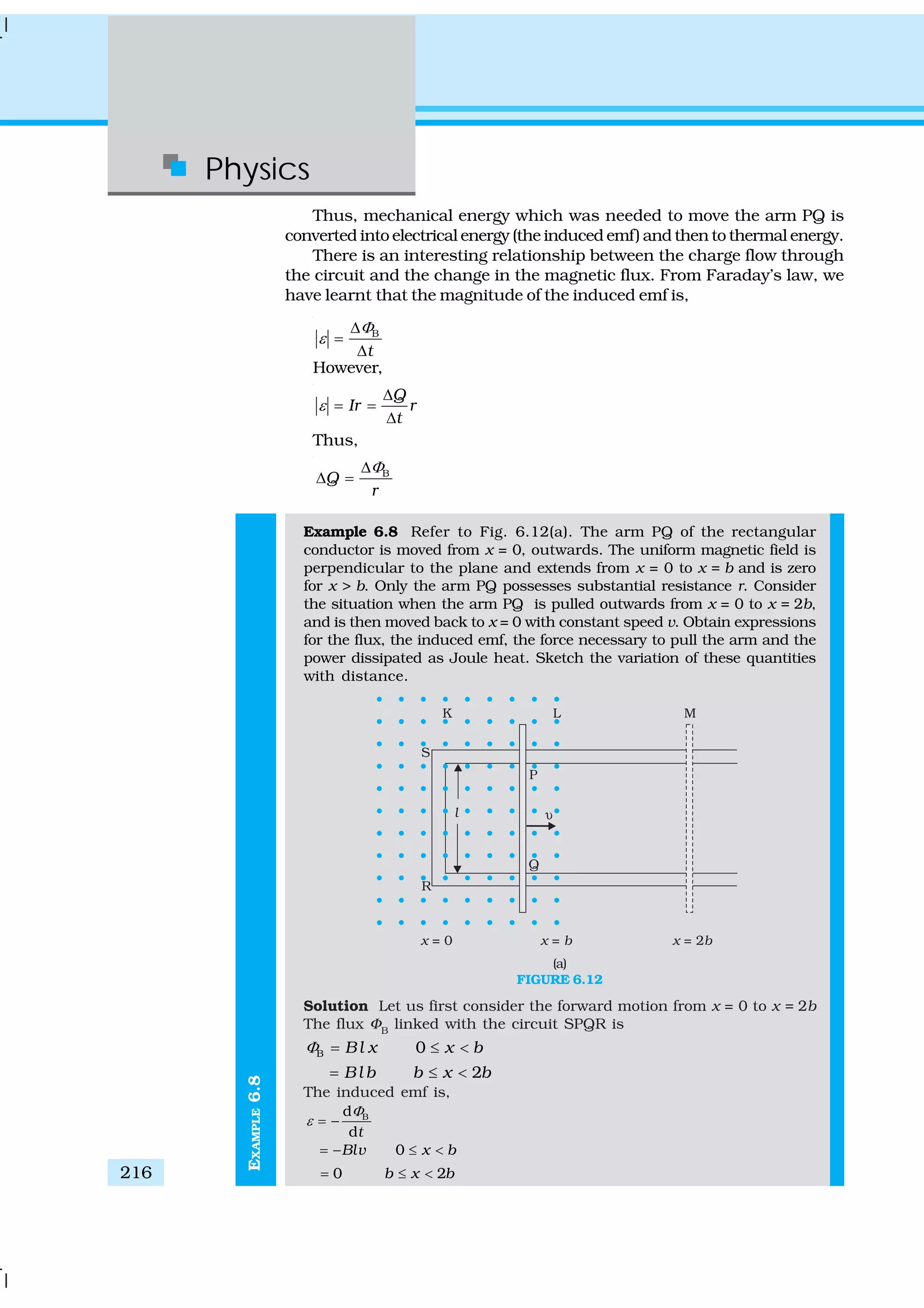
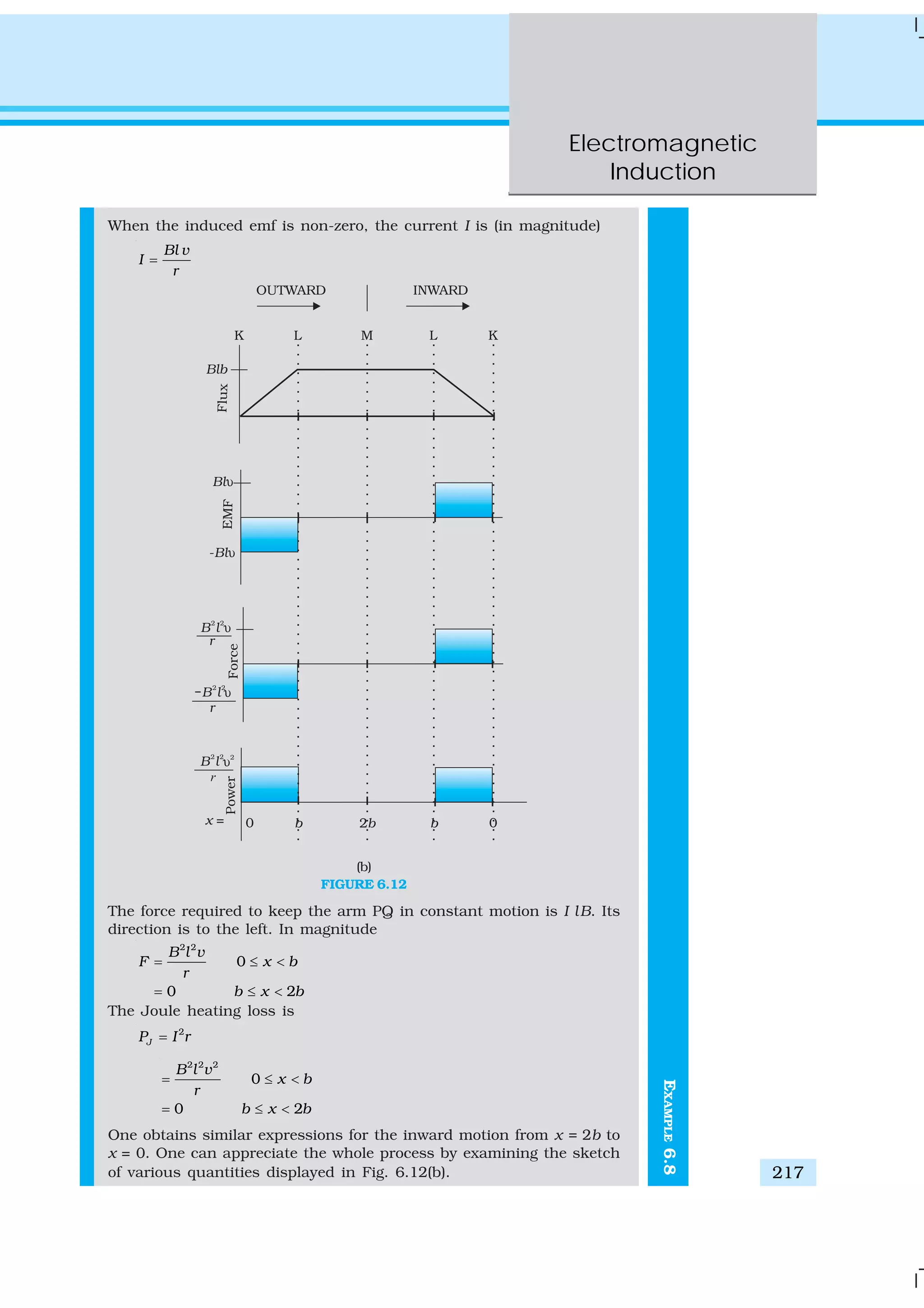
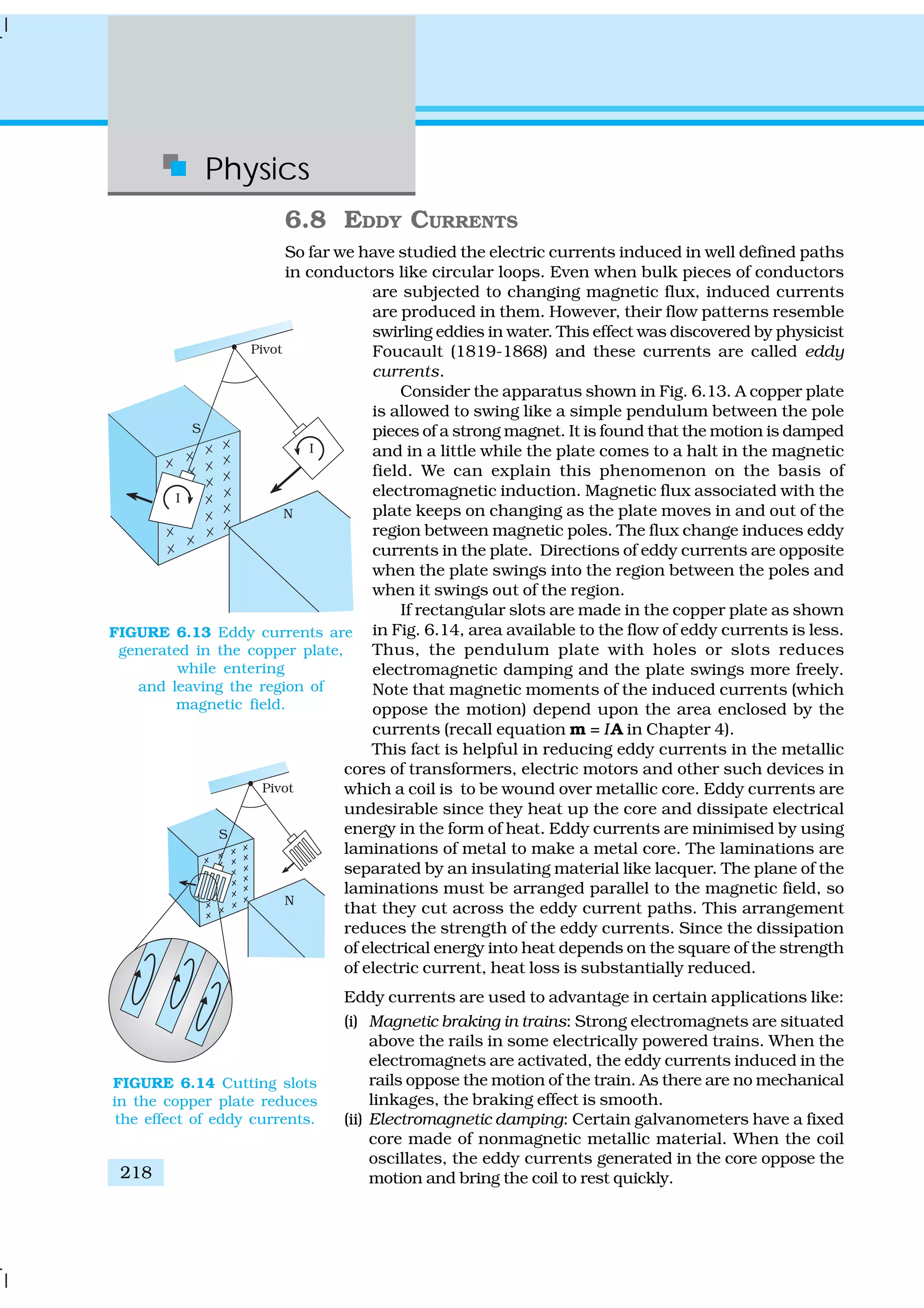
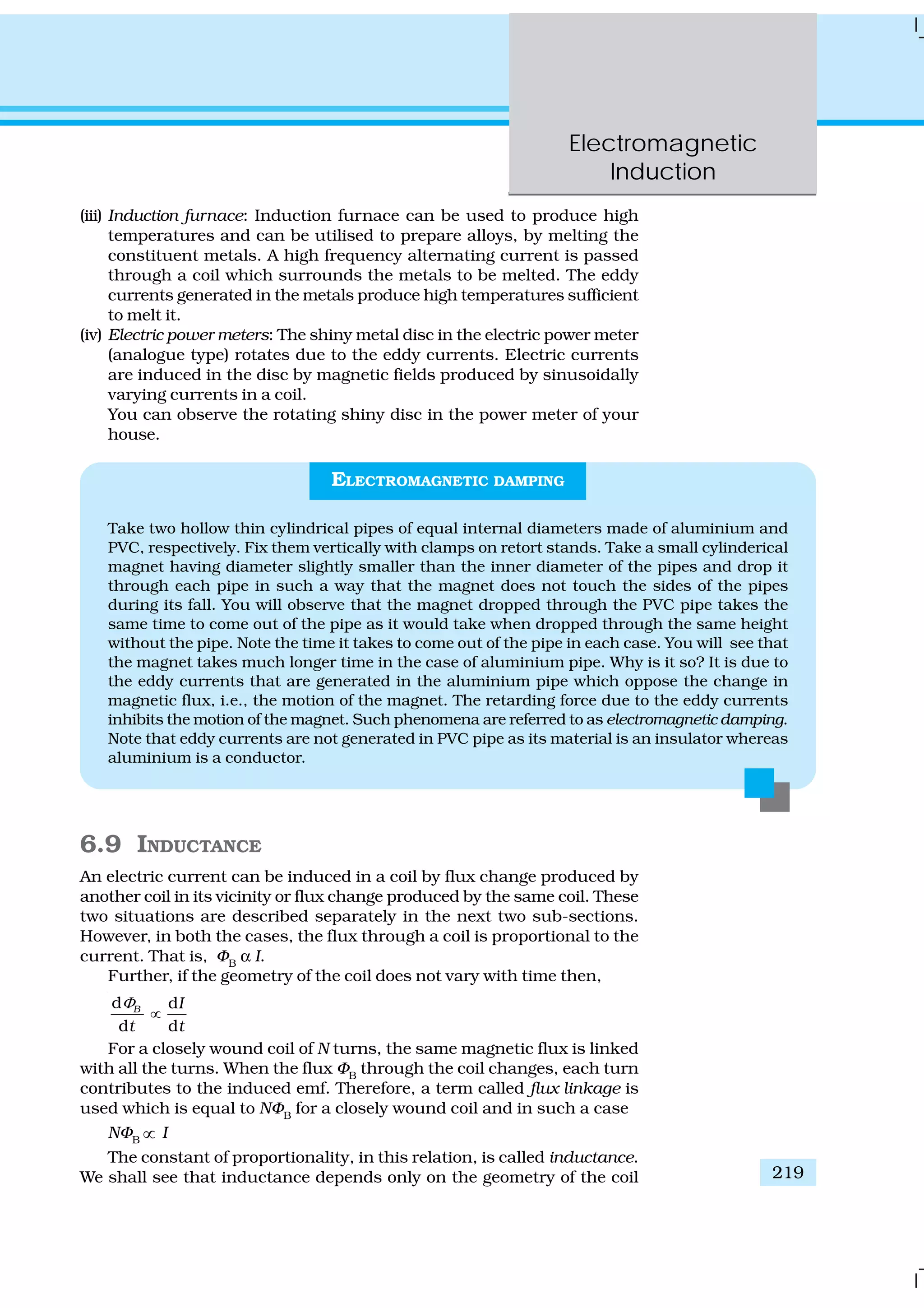
![Physics
220
and intrinsic material properties. This aspect is akin to capacitance which
for a parallel plate capacitor depends on the plate area and plate separation
(geometry) and the dielectric constant K of the intervening medium
(intrinsic material property).
Inductance is a scalar quantity. It has the dimensions of [M L2
T–2
A–2
]
given by the dimensions of flux divided by the dimensions of current. The
SI unit of inductance is henry and is denoted by H. It is named in honour
of Joseph Henry who discovered electromagnetic induction in USA,
independently of Faraday in England.
6.9.1 Mutual inductance
Consider Fig. 6.15 which shows two long co-axial solenoids each of length
l. We denote the radius of the inner solenoid S1
by r1
and the number of
turns per unit length by n1
. The corresponding quantities for the outer
solenoid S2
are r2
and n2
, respectively. Let N1
and N2
be the total number
of turns of coils S1
and S2
, respectively.
When a current I2
is set up through S2
, it in turn sets up a magnetic
flux through S1
. Let us denote it by Φ1
. The corresponding flux linkage
with solenoid S1
is
N1 1 12 2M IΦ = (6.9)
M12
is called the mutual inductance of solenoid S1
with respect to
solenoid S2
. It is also referred to as the coefficient of mutual induction.
For these simple co-axial solenoids it is possible to calculate M12
. The
magnetic field due to the current I2
in S2
is μ0
n2
I2
. The resulting flux linkage
with coil S1
is,
( ) ( ) ( )2
1 1 1 1 0 2 2N n l r n IΦ μ= π
2
0 1 2 1 2n n r l Iμ= π (6.10)
where n1
l is the total number of turns in solenoid S1
. Thus, from Eq. (6.9)
and Eq. (6.10),
M12
= μ0
n1
n2
πr 2
1
l (6.11)
Note that we neglected the edge effects and considered
the magnetic field μ0
n2
I2
to be uniform throughout the
length and width of the solenoid S2
. This is a good
approximation keeping in mind that the solenoid is long,
implying l >> r2
.
We now consider the reverse case. A current I1
is
passed through the solenoid S1
and the flux linkage with
coil S2
is,
N2
Φ2
= M21
I1
(6.12)
M21
is called the mutual inductance of solenoid S2
with
respect to solenoid S1
.
The flux due to the current I1
in S1
can be assumed to
be confined solely inside S1
since the solenoids are very
long. Thus, flux linkage with solenoid S2
is
( ) ( ) ( )2
2 2 2 1 0 1 1N n l r n IΦ μ= π
FIGURE 6.15 Two long co-axial
solenoids of same
length l.](https://image.slidesharecdn.com/ncert-class-12-physics-part-1-161112171109/75/Ncert-class-12-physics-part-1-224-2048.jpg)
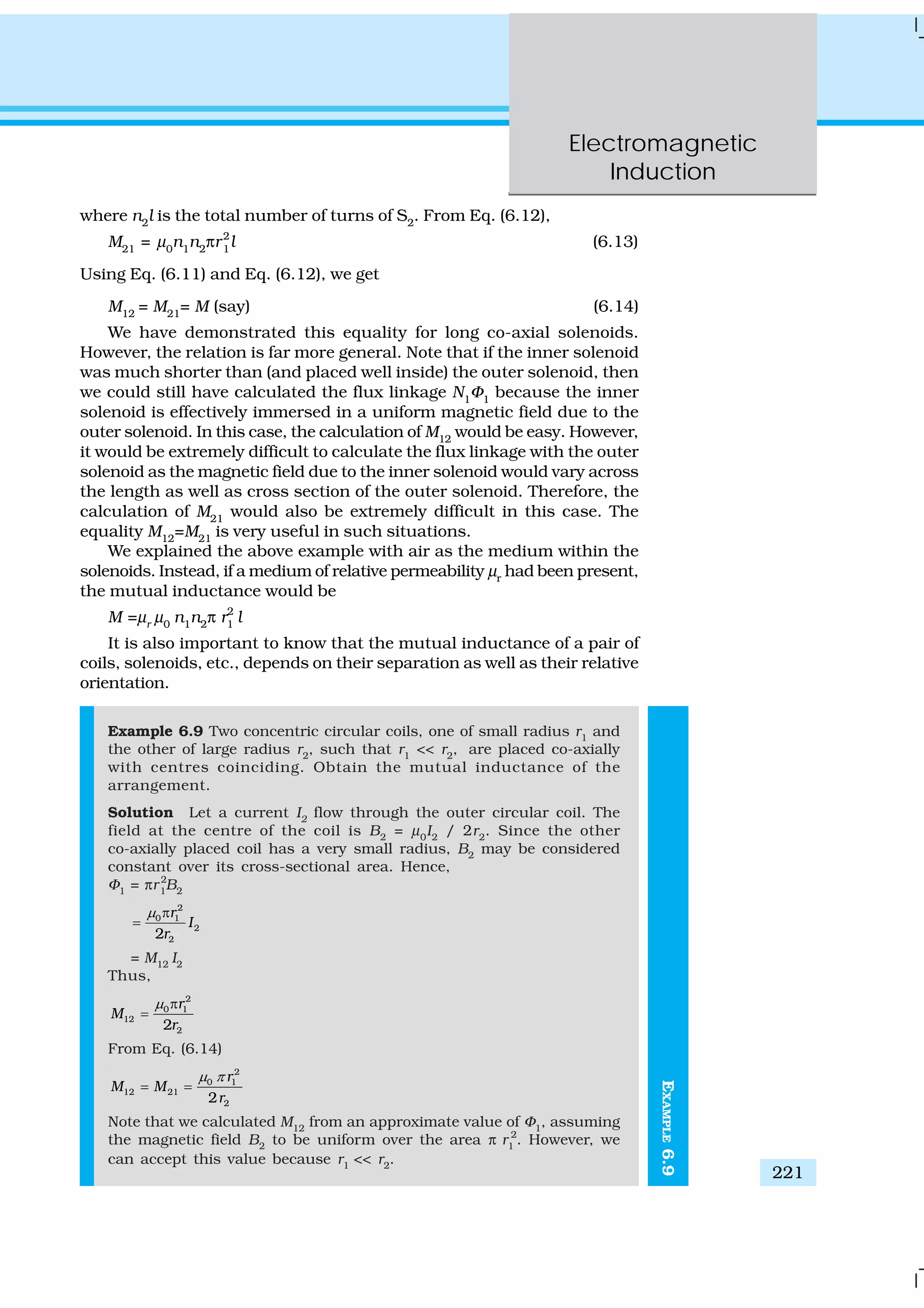
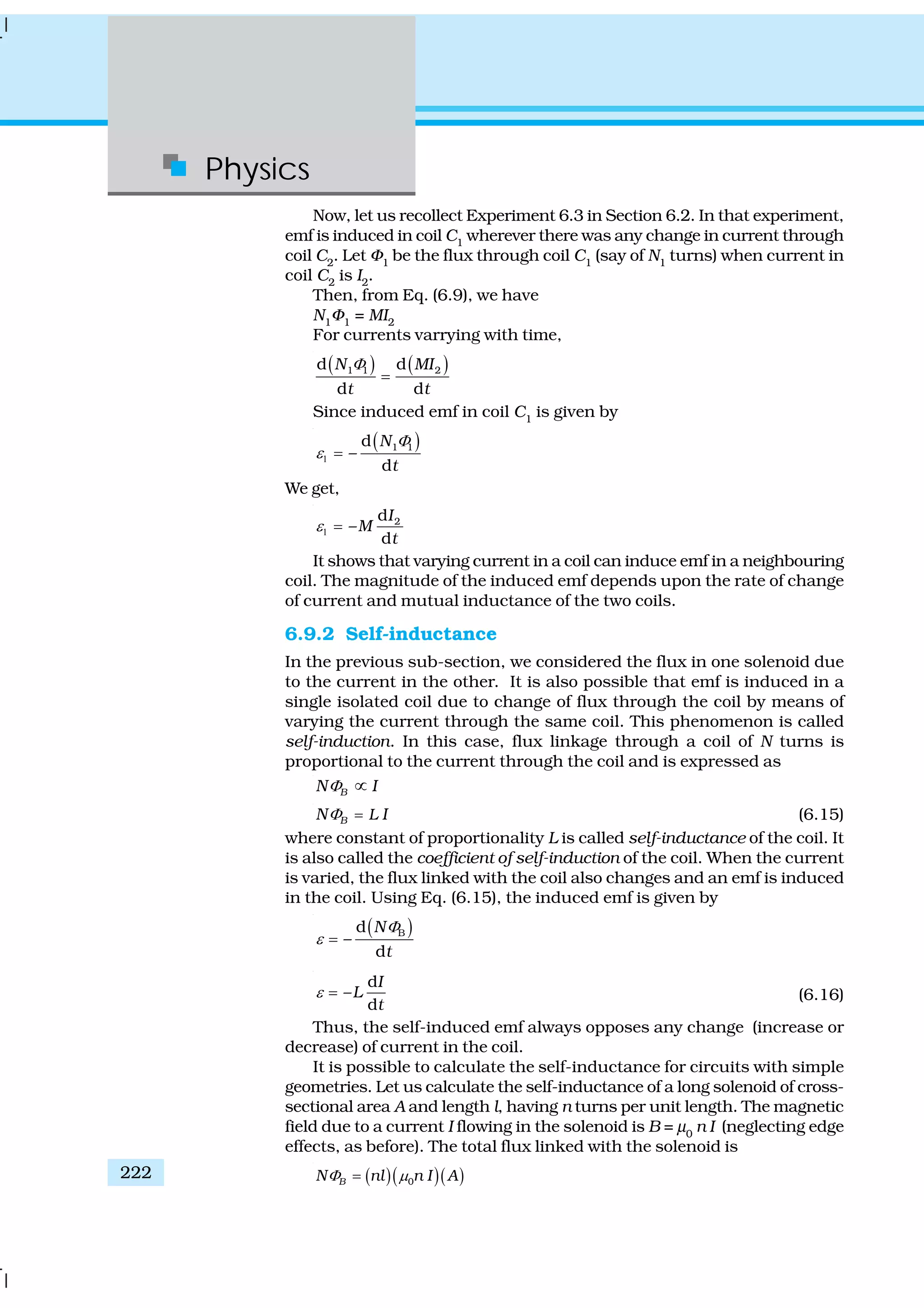
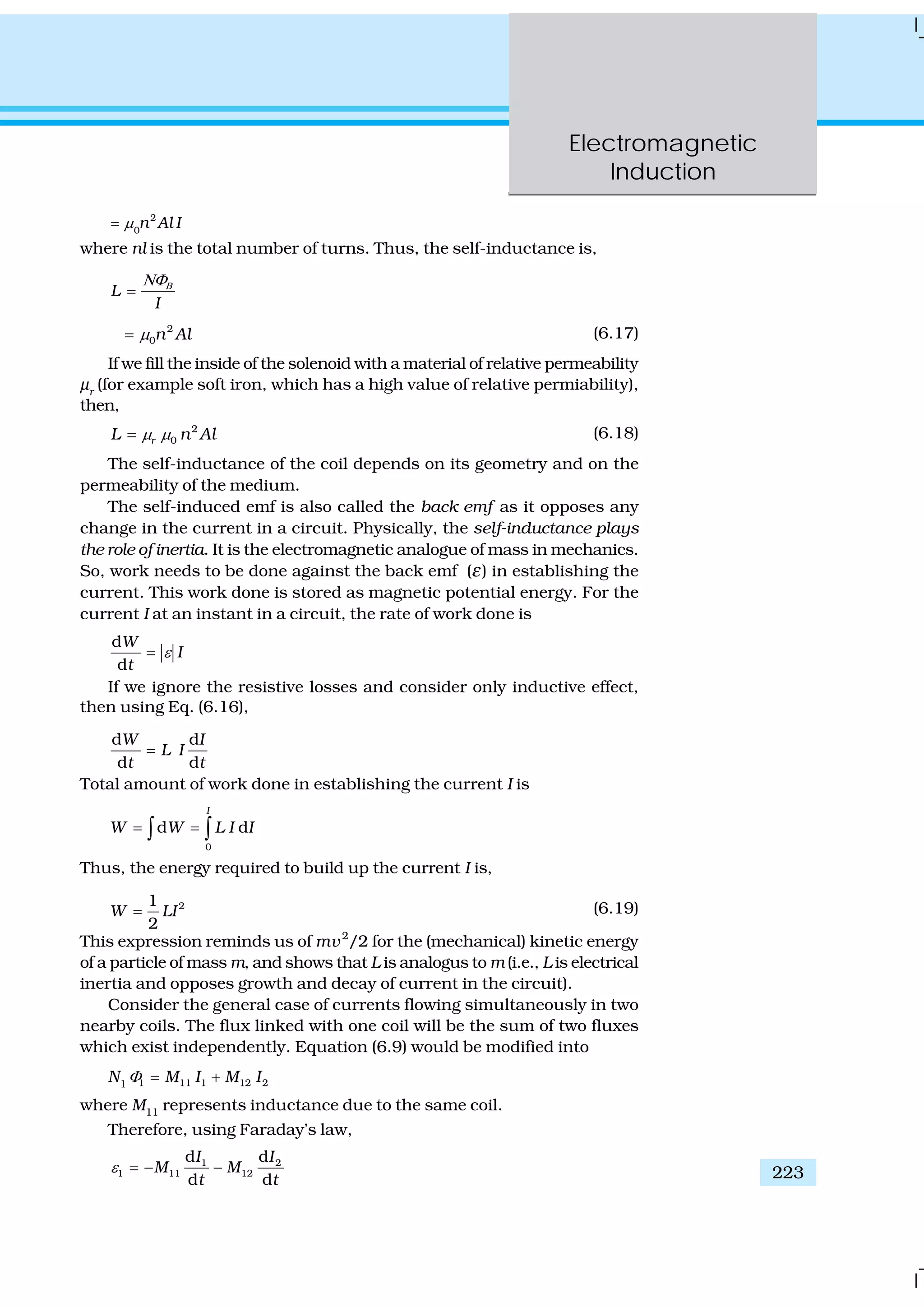
![Physics
224
EXAMPLE6.10
M11
is the self-inductance and is written as L1
. Therefore,
1 2
1 1 12
d d
d d
I I
L M
t t
ε = − −
Example 6.10 (a) Obtain the expression for the magnetic energy stored
in a solenoid in terms of magnetic field B, area A and length l of the
solenoid. (b) How does this magnetic energy compare with the
electrostatic energy stored in a capacitor?
Solution
(a) From Eq. (6.19), the magnetic energy is
21
2
BU LI=
( )
2
1
since ,for a solenoid
2
0
0
B
L B nI
n
μ
μ
⎛ ⎞
= =⎜ ⎟⎝ ⎠
2
2
0
0
1
( )
2
B
n Al
n
μ
μ
⎛ ⎞
= ⎜ ⎟⎝ ⎠
[from Eq. (6.17)]
2
0
1
2
B Al
μ
=
(b) The magnetic energy per unit volume is,
B
B
U
u
V
= (where V is volume that contains flux)
BU
Al
=
2
02
B
μ
= (6.20)
We have already obtained the relation for the electrostatic energy
stored per unit volume in a parallel plate capacitor (refer to Chapter 2,
Eq. 2.77),
2
0
1
2
u EΕ ε= (2.77)
In both the cases energy is proportional to the square of the field
strength. Equations (6.20) and (2.77) have been derived for special
cases: a solenoid and a parallel plate capacitor, respectively. But they
are general and valid for any region of space in which a magnetic field
or/and an electric field exist.
6.10 AC GENERATOR
The phenomenon of electromagnetic induction has been technologically
exploited in many ways. An exceptionally important application is the
generation of alternating currents (ac). The modern ac generator with a
typical output capacity of 100 MW is a highly evolved machine. In this
section, we shall describe the basic principles behind this machine. The
Yugoslav inventor Nicola Tesla is credited with the development of the
machine. As was pointed out in Section 6.3, one method to induce an emf
Interactiveanimationonacgenerator:
http://micro.magnet.fsu.edu/electromagnet~java/generator/ac.html](https://image.slidesharecdn.com/ncert-class-12-physics-part-1-161112171109/75/Ncert-class-12-physics-part-1-228-2048.jpg)
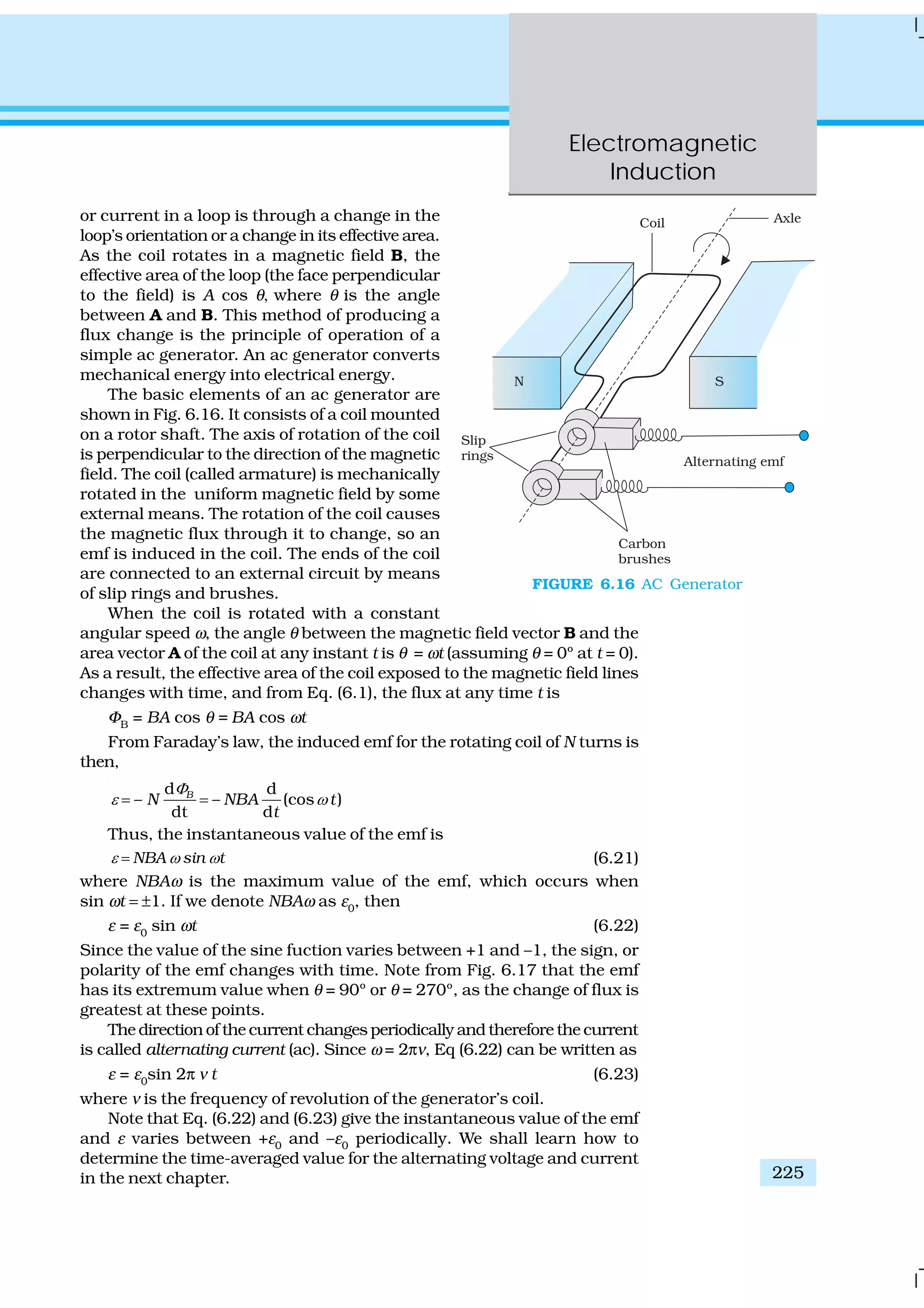
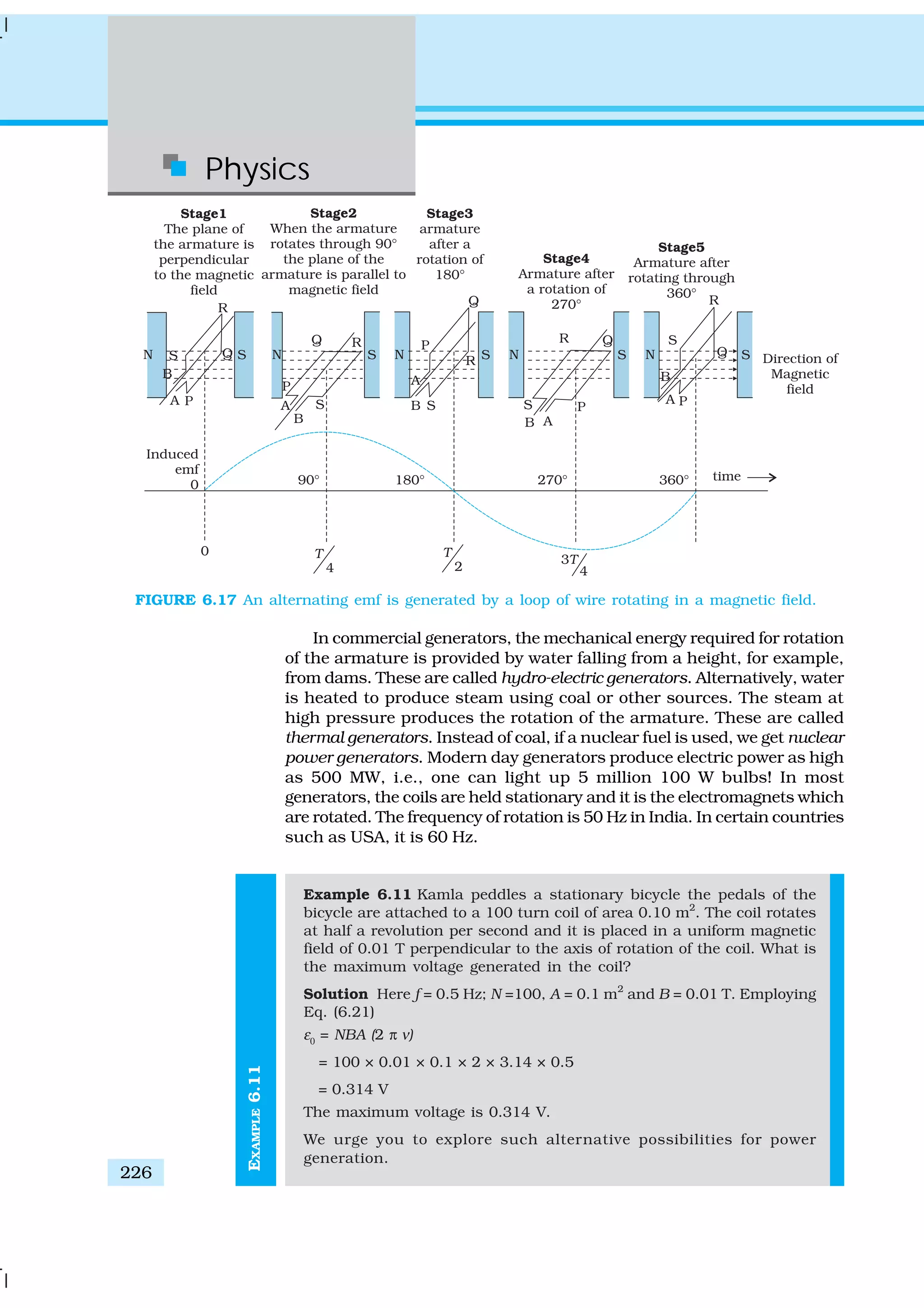
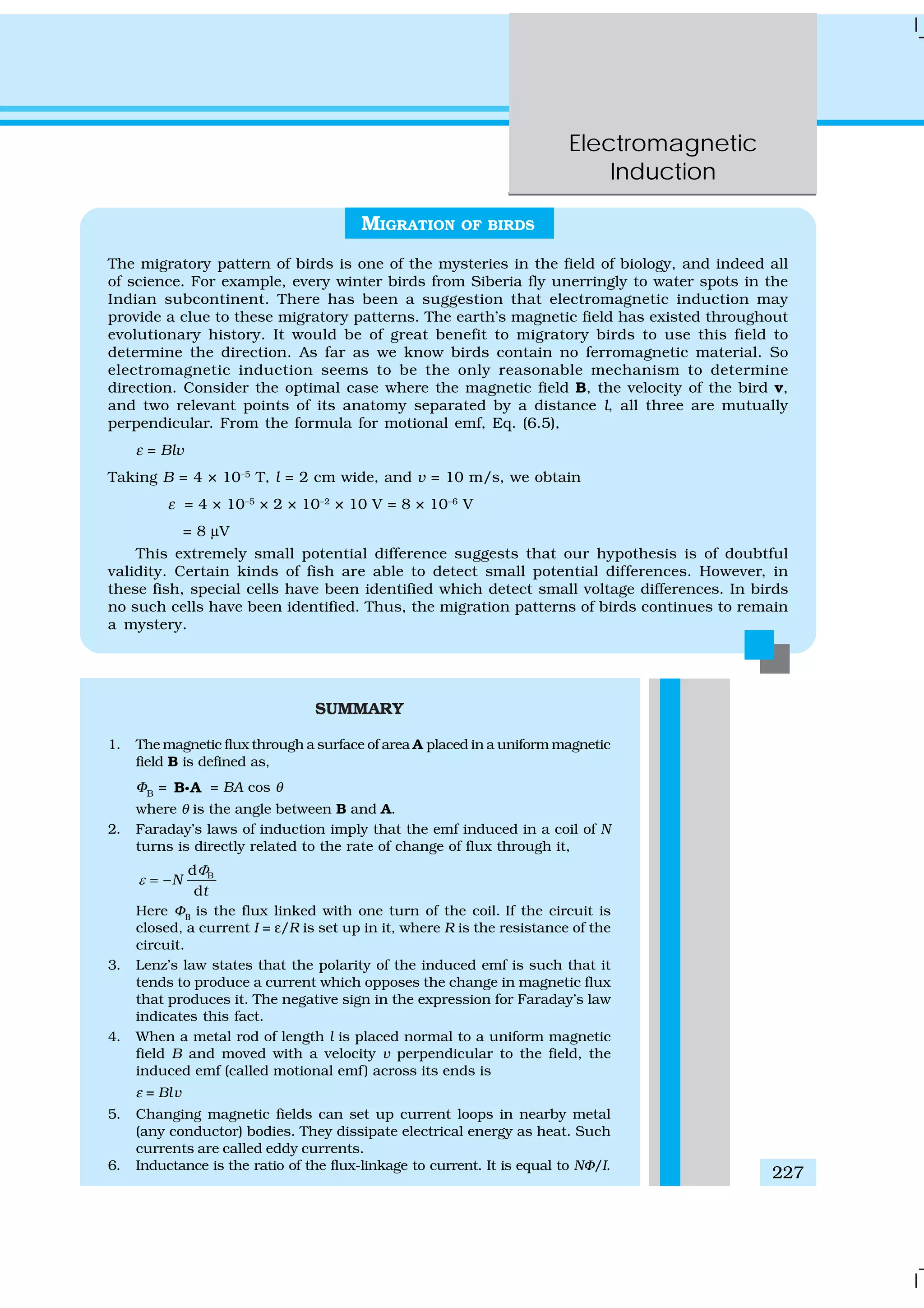
![Physics
228
POINTS TO PONDER
1. Electricity and magnetism are intimately related. In the early part of the
nineteenth century, the experiments of Oersted, Ampere and others
established that moving charges (currents) produce a magnetic field.
Somewhat later, around 1830, the experiments of Faraday and Henry
demonstrated that a moving magnet can induce electric current.
2. In a closed circuit, electric currents are induced so as to oppose the
changing magnetic flux. It is as per the law of conservation of energy.
However, in case of an open circuit, an emf is induced across its ends.
How is it related to the flux change?
3. The motional emf discussed in Section 6.5 can be argued independently
from Faraday’s law using the Lorentz force on moving charges. However,
Quantity Symbol Units Dimensions Equations
Magnetic Flux ΦB
Wb (weber) [M L2
T–2
A–1
] ΦB
= B Ai
EMF ε V (volt) [M L2
T–3
A–1
] ε = Bd( )/dN tΦ−
Mutual Inductance M H (henry) [M L2
T–2
A–2
] ε1
( )12 2d /dM I t= −
Self Inductance L H (henry) [M L2
T–2
A–2
] ( )d /dL I tε = −
7. A changing current in a coil (coil 2) can induce an emf in a nearby coil
(coil 1). This relation is given by,
2
1 12
d
d
I
M
t
ε = −
The quantity M12
is called mutual inductance of coil 1 with respect to
coil 2. One can similarly define M21
. There exists a general equality,
M12
= M21
8. When a current in a coil changes, it induces a back emf in the same
coil. The self-induced emf is given by,
d
d
I
L
t
ε = −
L is the self-inductance of the coil. It is a measure of the inertia of the
coil against the change of current through it.
9. The self-inductance of a long solenoid, the core of which consists of a
magnetic material of permeability μr
, is given by
L = μr
μ0
n2
Al
where A is the area of cross-section of the solenoid, l its length and n
the number of turns per unit length.
10. In an ac generator, mechanical energy is converted to electrical energy
by virtue of electromagnetic induction. If coil of N turn and area A is
rotated at ν revolutions per second in a uniform magnetic field B, then
the motional emf produced is
ε = NBA (2πν) sin (2πνt)
where we have assumed that at time t = 0 s, the coil is perpendicular to
the field.](https://image.slidesharecdn.com/ncert-class-12-physics-part-1-161112171109/75/Ncert-class-12-physics-part-1-232-2048.jpg)
![Electromagnetic
Induction
229
EXERCISES
6.1 Predict the direction of induced current in the situations described
by the following Figs. 6.18(a) to (f ).
even if the charges are stationary [and the q (v × B) term of the Lorentz
force is not operative], an emf is nevertheless induced in the presence of a
time-varying magnetic field. Thus, moving charges in static field and static
charges in a time-varying field seem to be symmetric situation for
Faraday’s law. This gives a tantalising hint on the relevance of the principle
of relativity for Faraday’s law.
4. The motion of a copper plate is damped when it is allowed to oscillate
between the magnetic pole-pieces. How is the damping force, produced by
the eddy currents?
FIGURE 6.18](https://image.slidesharecdn.com/ncert-class-12-physics-part-1-161112171109/75/Ncert-class-12-physics-part-1-233-2048.jpg)
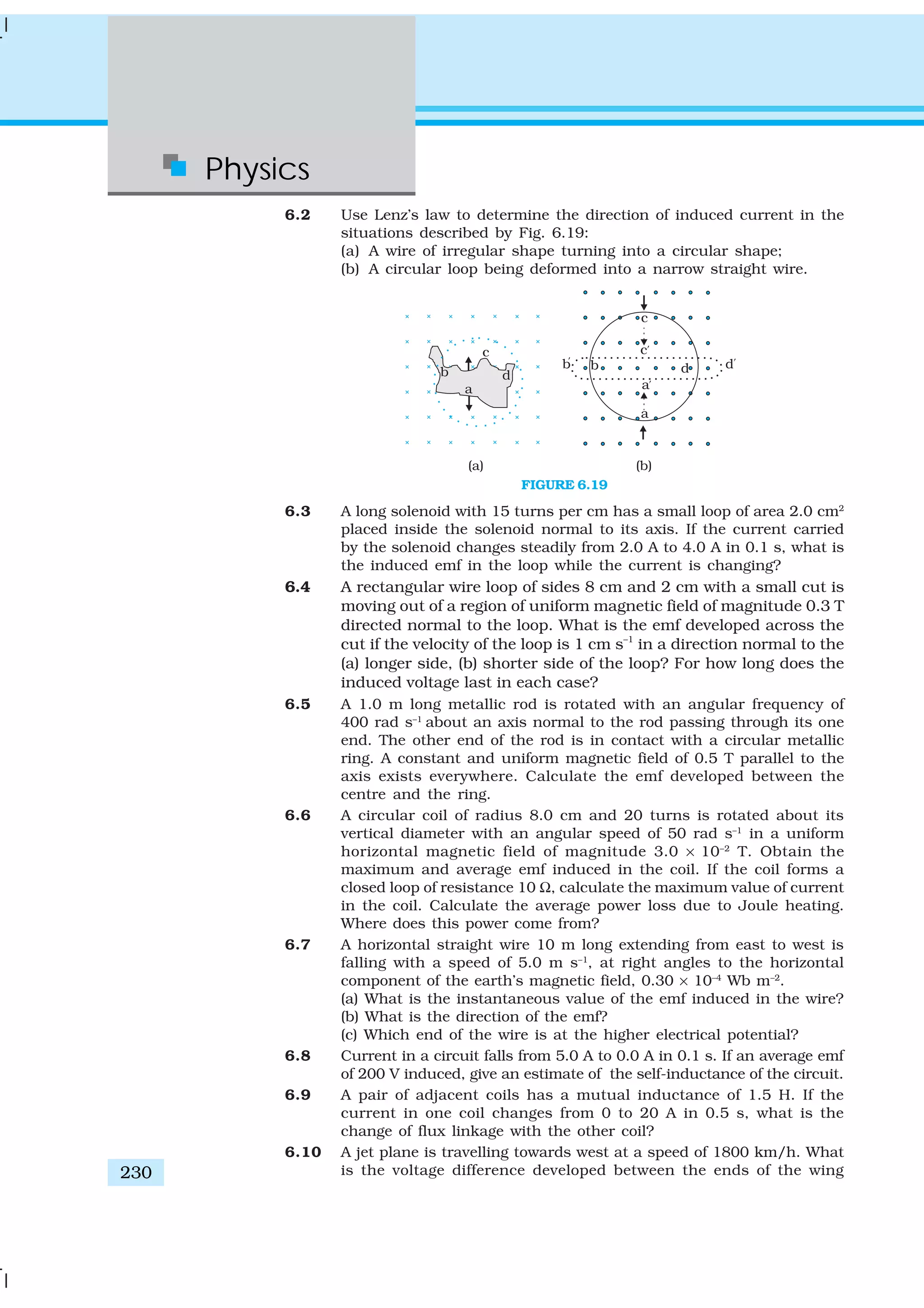

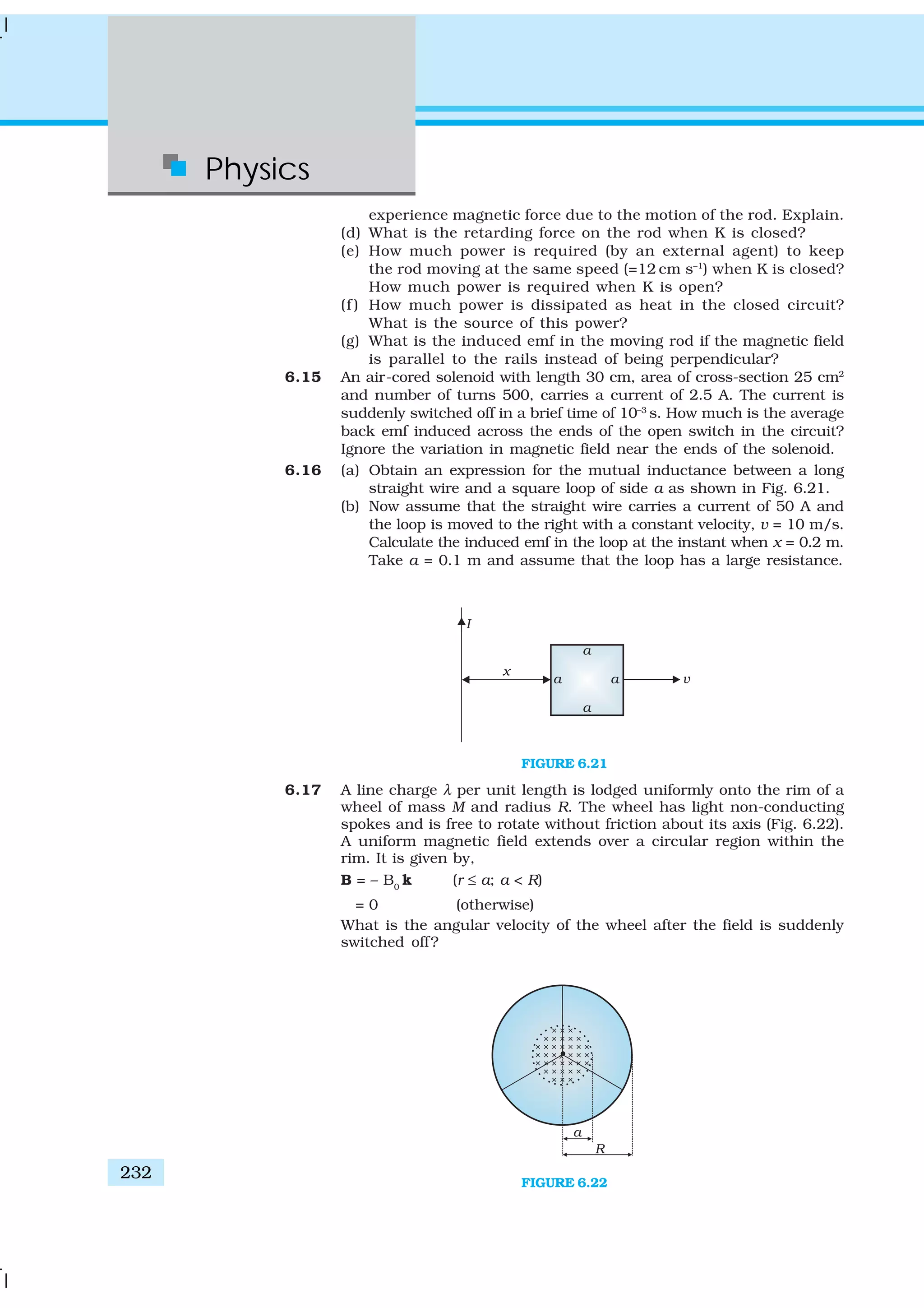
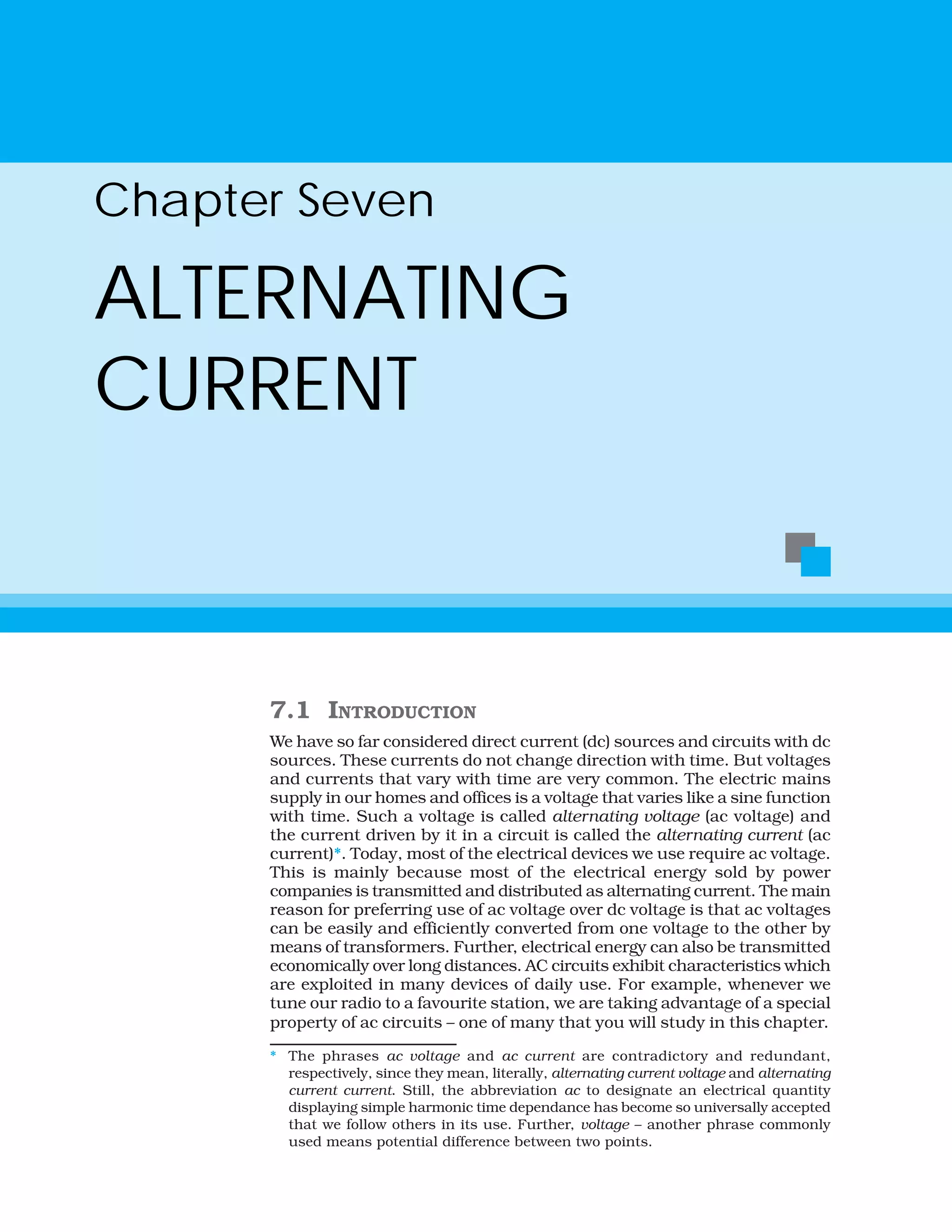
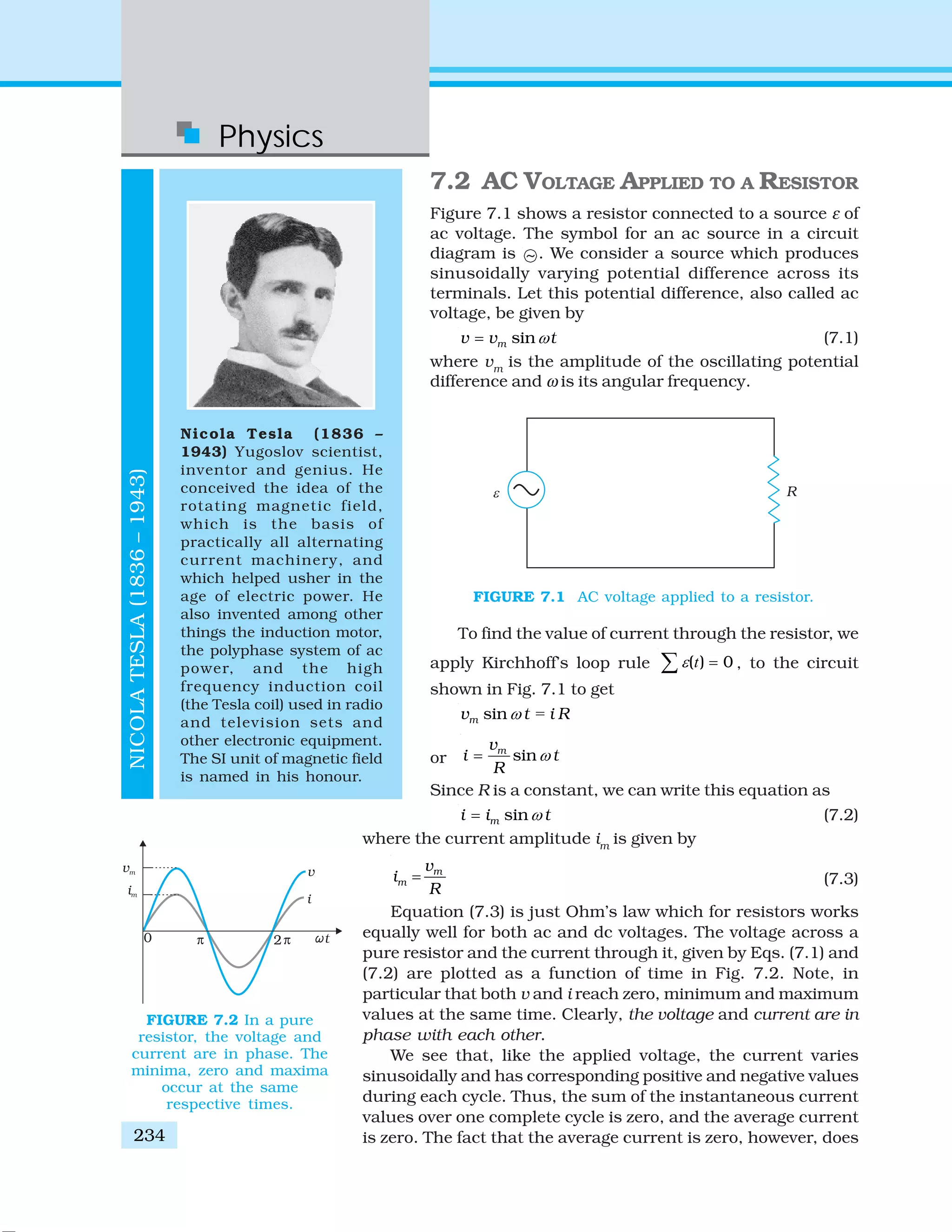
![Alternating Current
235
GEORGEWESTINGHOUSE(1846–1914)
George Westinghouse
(1846 – 1914) A leading
proponent of the use of
alternating current over
direct current. Thus,
he came into conflict
with Thomas Alva Edison,
an advocate of direct
current. Westinghouse
was convinced that the
technology of alternating
current was the key to
the electrical future.
He founded the famous
Company named after him
and enlisted the services
of Nicola Tesla and
other inventors in the
development of alternating
current motors and
apparatus for the
transmission of high
tension current, pioneering
in large scale lighting.
not mean that the average power consumed is zero and
that there is no dissipation of electrical energy. As you
know, Joule heating is given by i2
R and depends on i2
(which is always positive whether i is positive or negative)
and not on i. Thus, there is Joule heating and
dissipation of electrical energy when an
ac current passes through a resistor.
The instantaneous power dissipated in the resistor is
2 2 2
sinmp i R i R tω= = (7.4)
The average value of p over a cycle is*
2 2 2
sinmp i R i R tω= < > = < > [7.5(a)]
where the bar over a letter(here, p) denotes its average
value and <......> denotes taking average of the quantity
inside the bracket. Since, i2
m
and R are constants,
2 2
sinmp i R tω= < > [7.5(b)]
Using the trigonometric identity, sin2
ωt =
1/2 (1– cos 2ωt), we have < sin2
ωt > = (1/2) (1– < cos 2ωt >)
and since < cos2ωt > = 0**, we have,
2 1
sin
2
tω< > =
Thus,
21
2
mp i R= [7.5(c)]
To express ac power in the same form as dc power
(P = I2
R), a special value of current is defined and used.
It is called, root mean square (rms) or effective current
(Fig. 7.3) and is denoted by Irms
or I.
* The average value of a function F (t) over a period T is given by d
0
1
( ) ( )
T
F t F t t
T
= ∫
** [ ]
0 0
sin 21 1 1
cos2 cos2 sin 2 0 0
2 2
TT
t
t t dt T
T T T
ω
ω ω ω
ω ω
⎡ ⎤
< > = = = − =∫ ⎢ ⎥⎣ ⎦
FIGURE 7.3 The rms current I is related to the
peak current im
by I = / 2mi = 0.707 im
.](https://image.slidesharecdn.com/ncert-class-12-physics-part-1-161112171109/75/Ncert-class-12-physics-part-1-239-2048.jpg)
![Physics
236
It is defined by
2 21
2 2
m
m
i
I i i= = =
= 0.707 im
(7.6)
In terms of I, the average power, denoted by P is
2 21
2
m
pP i R I R= = = (7.7)
Similarly, we define the rms voltage or effective voltage by
V =
2
mv
= 0.707 vm
(7.8)
From Eq. (7.3), we have
vm
= im
R
or,
2 2
m mv i
R=
or, V = IR (7.9)
Equation (7.9) gives the relation between ac current and ac voltage
and is similar to that in the dc case. This shows the advantage of
introducing the concept of rms values. In terms of rms values, the equation
for power [Eq. (7.7)] and relation between current and voltage in ac circuits
are essentially the same as those for the dc case.
It is customary to measure and specify rms values for ac quantities. For
example, the household line voltage of 220 V is an rms value with a peak
voltage of
vm
= 2 V = (1.414)(220 V) = 311 V
In fact, the I or rms current is the equivalent dc current that would
produce the same average power loss as the alternating current. Equation
(7.7) can also be written as
P = V2
/ R = I V (since V = I R)
Example 7.1 A light bulb is rated at 100W for a 220 V supply. Find
(a) the resistance of the bulb; (b) the peak voltage of the source; and
(c) the rms current through the bulb.
Solution
(a) We are given P = 100 W and V = 220 V. The resistance of the
bulb is
( )
2
2
220 V
484
100 W
V
R
P
= = = Ω
(b) The peak voltage of the source is
V2 311m
v V= =
(c) Since, P = I V
100 W
0.450A
220 V
P
I
V
= = =
EXAMPLE7.1](https://image.slidesharecdn.com/ncert-class-12-physics-part-1-161112171109/75/Ncert-class-12-physics-part-1-240-2048.jpg)
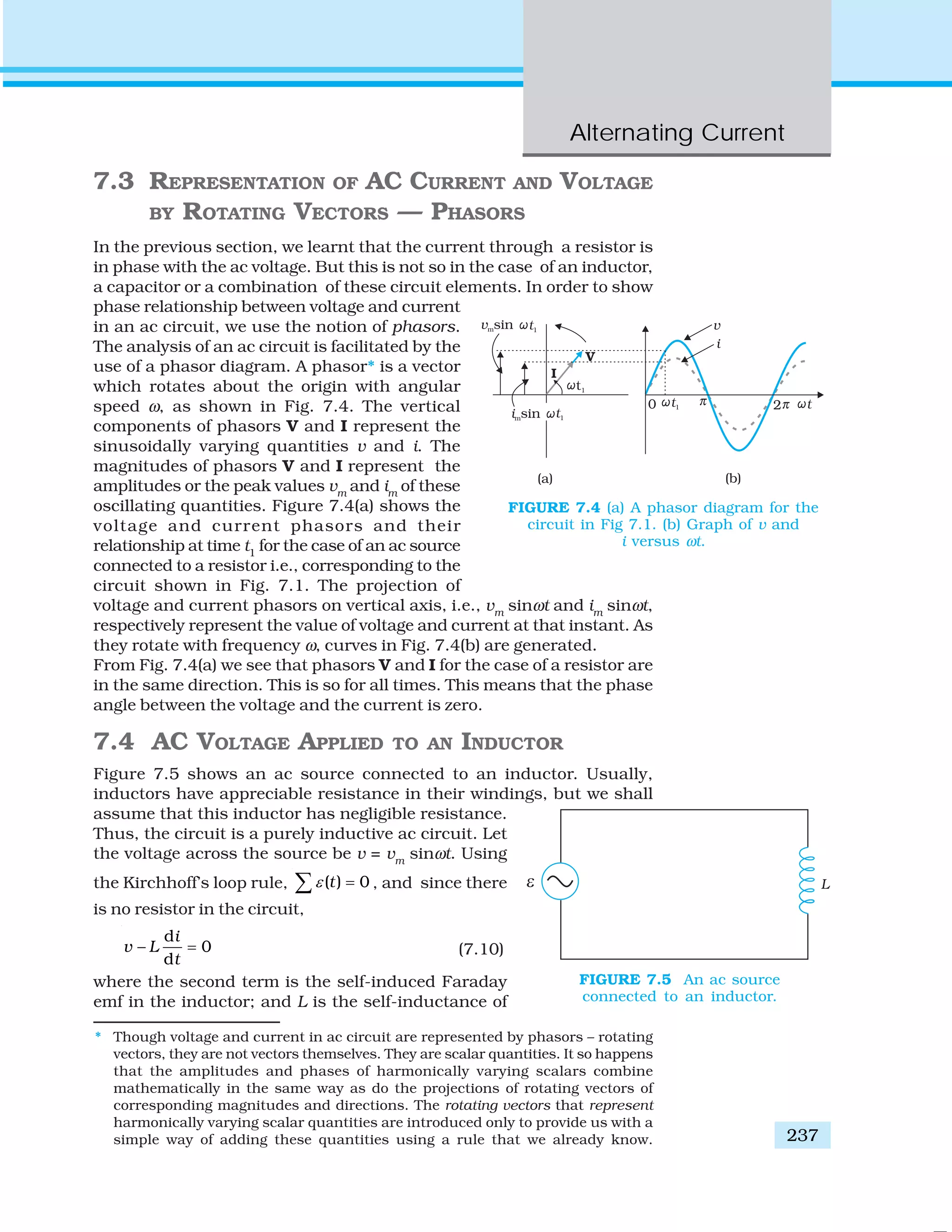
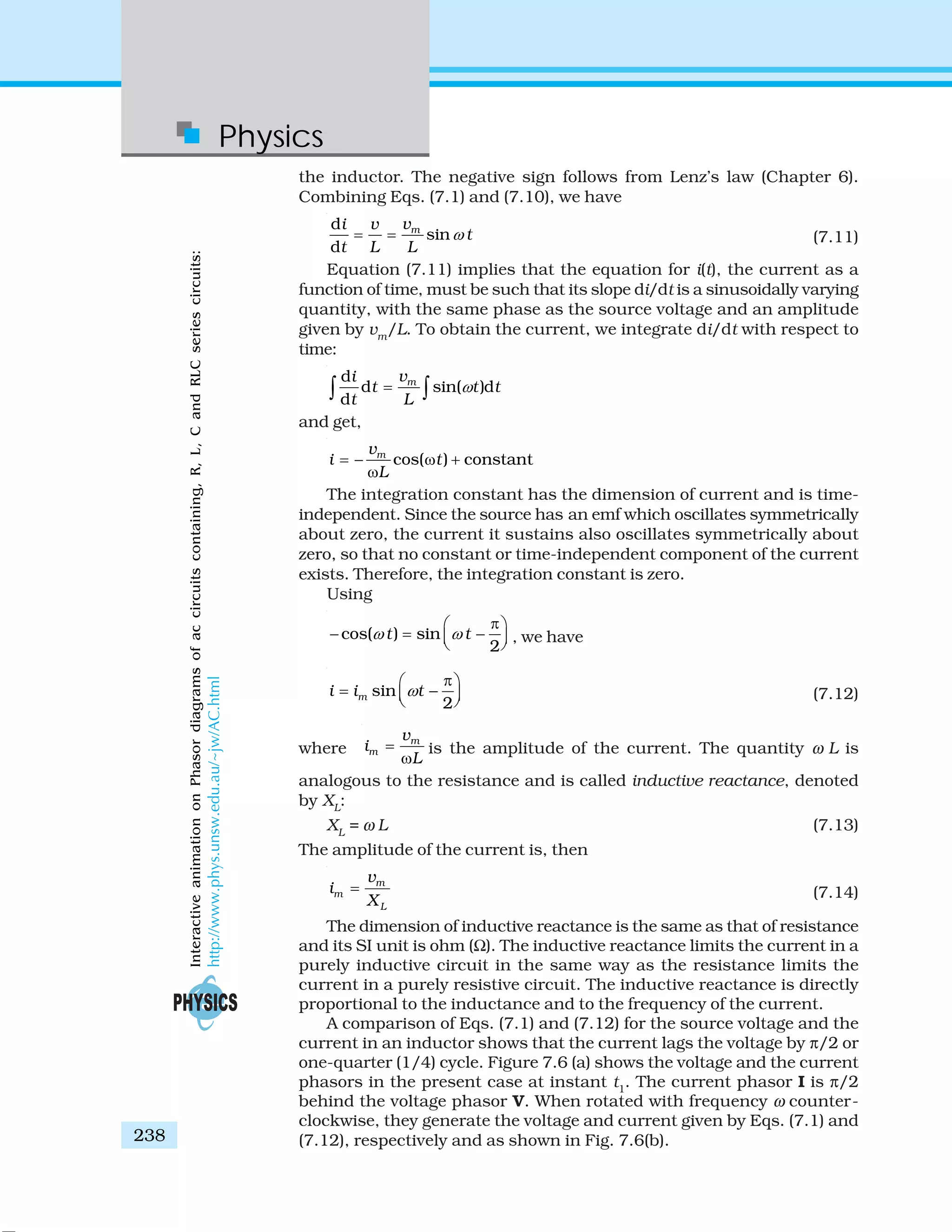
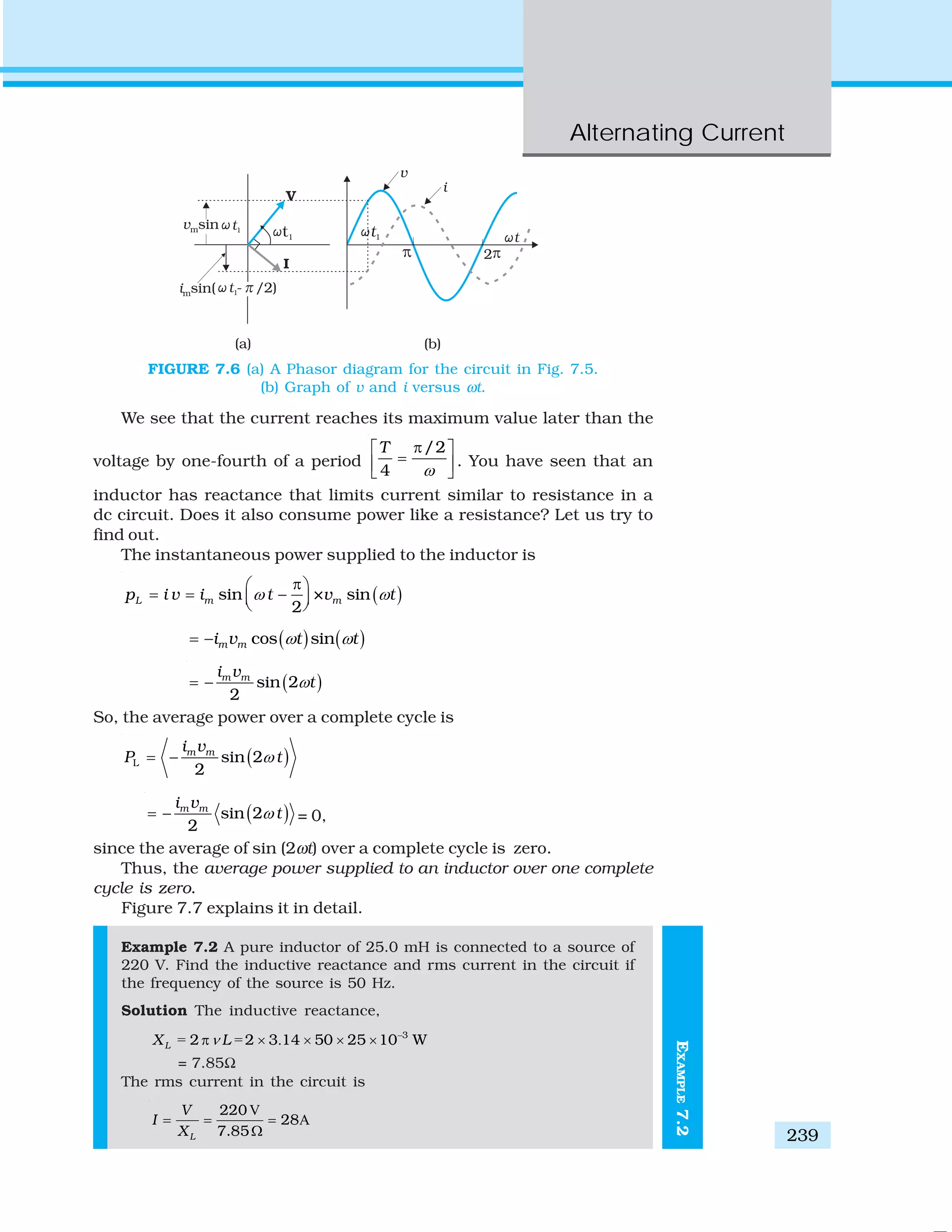
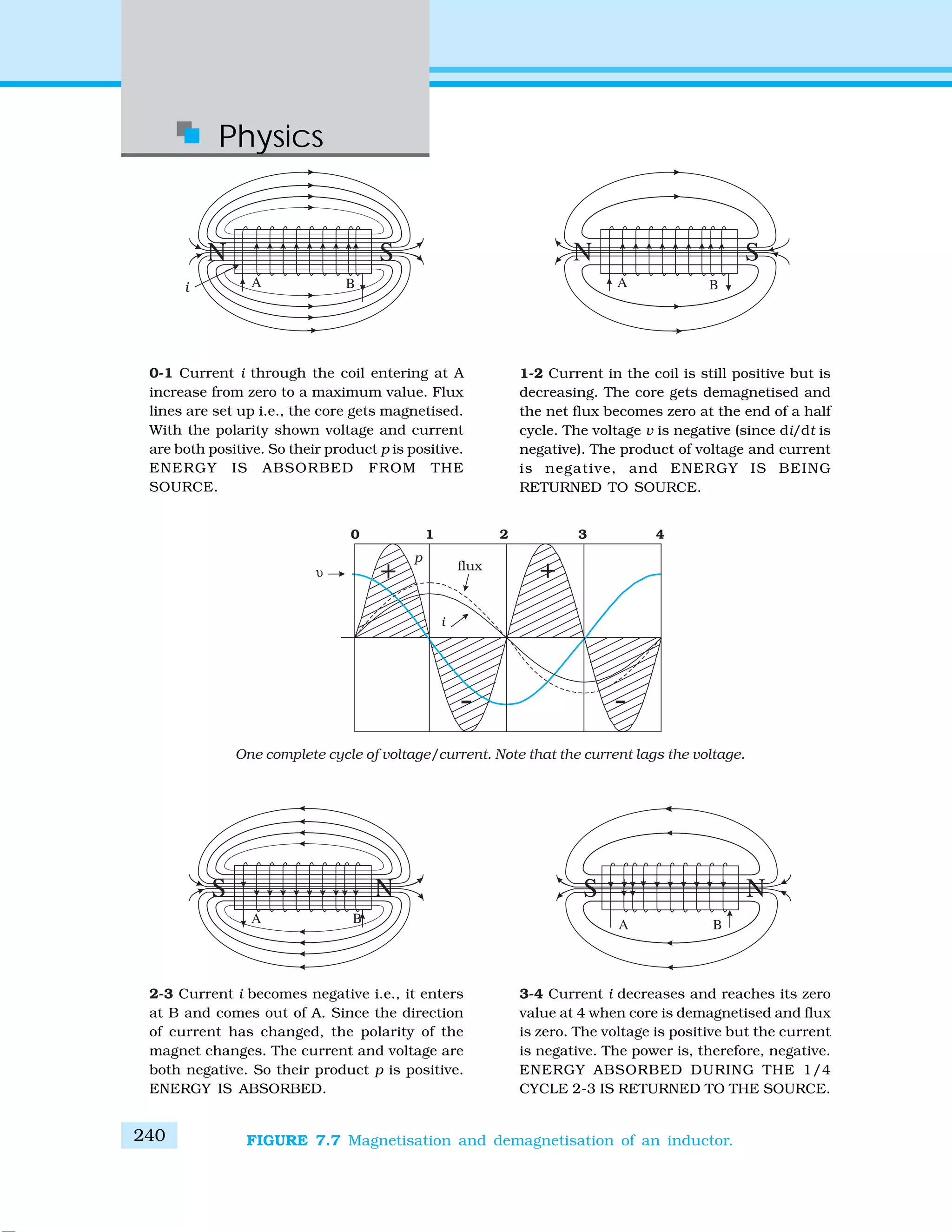
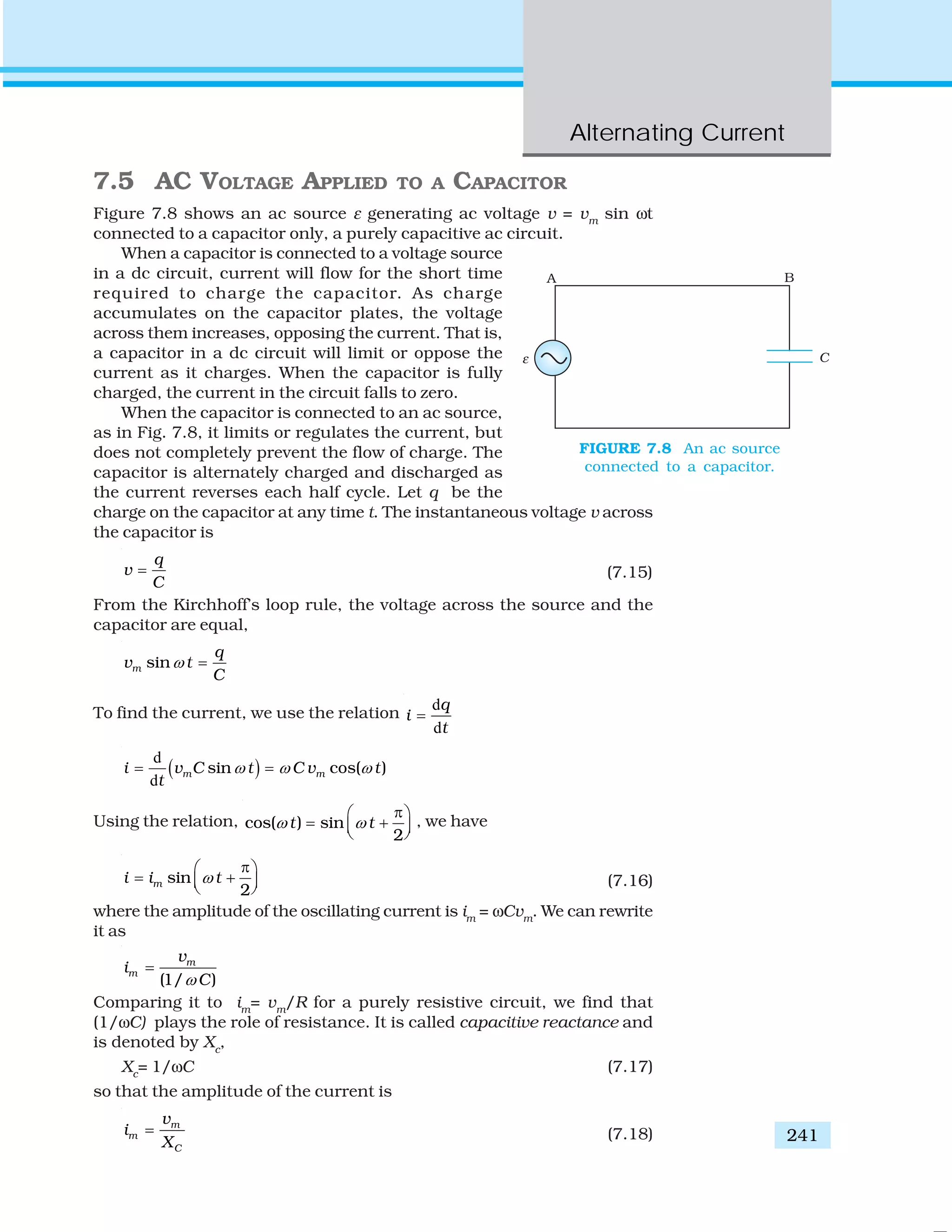
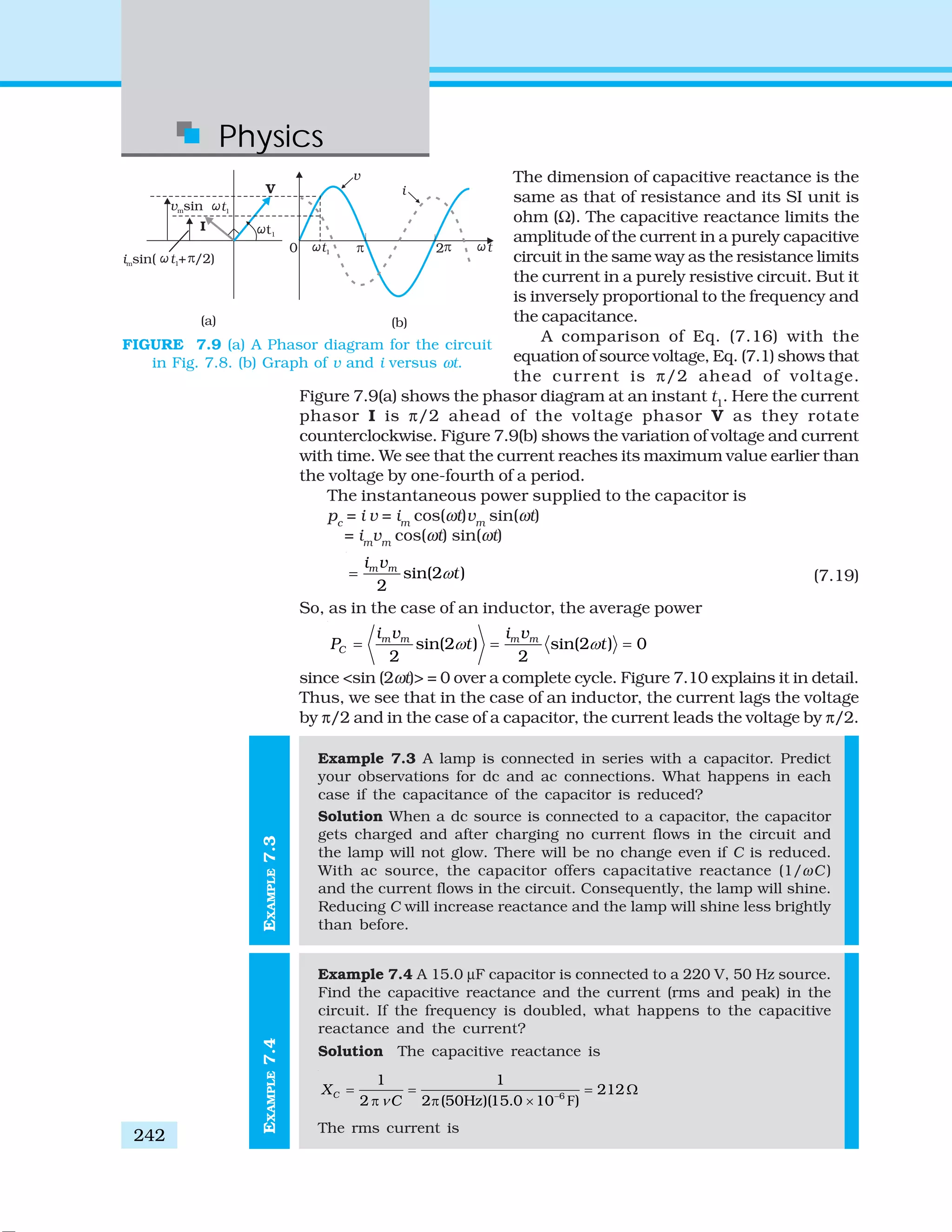
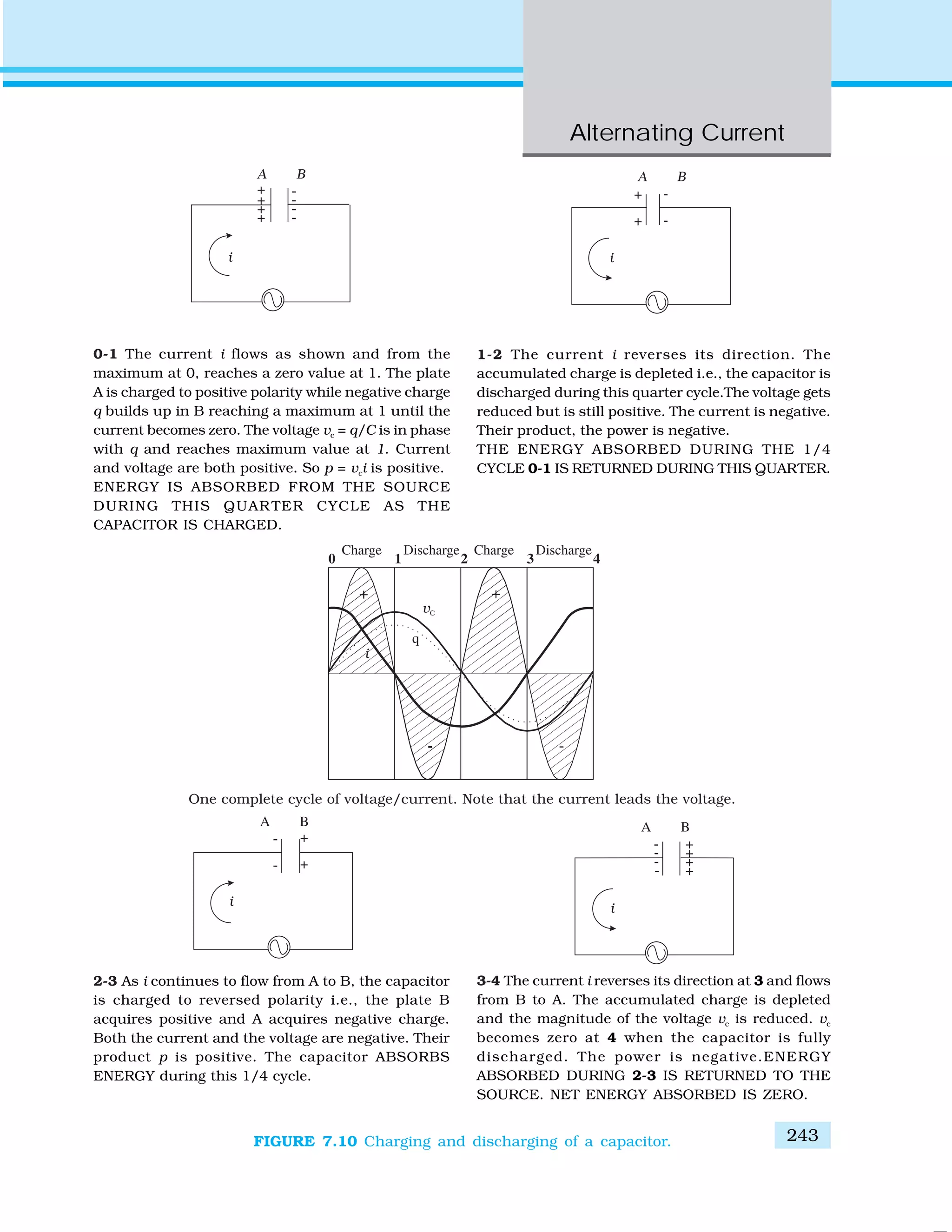
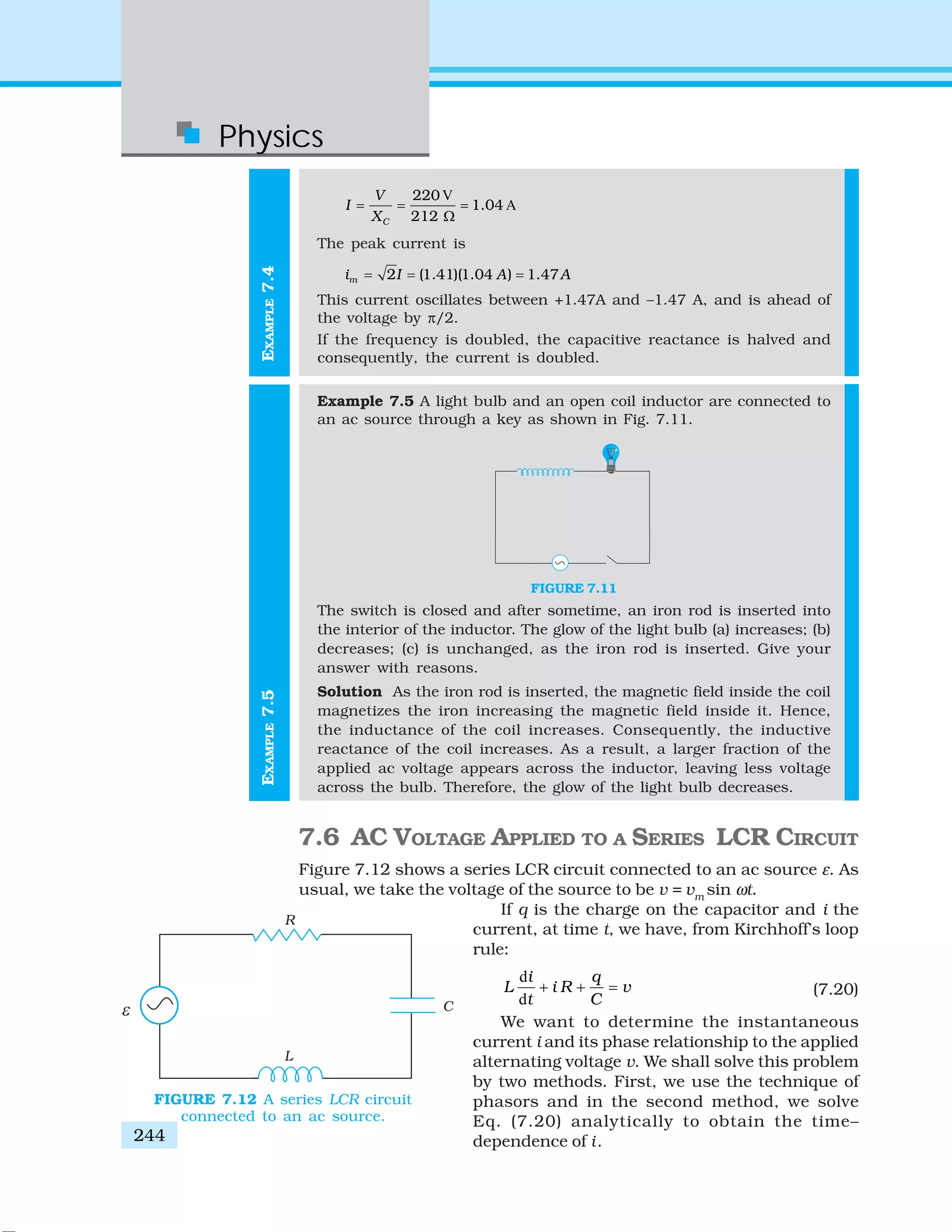
![Alternating Current
245
7.6.1 Phasor-diagram solution
From the circuit shown in Fig. 7.12, we see that the resistor, inductor
and capacitor are in series. Therefore, the ac current in each element is
the same at any time, having the same amplitude and phase. Let it be
i = im
sin(ωt+φ) (7.21)
where φ is the phase difference between the voltage across the source and
the current in the circuit. On the basis of what we have learnt in the previous
sections, we shall construct a phasor diagram for the present case.
Let I be the phasor representing the current in the circuit as given by
Eq. (7.21). Further, let VL
, VR
, VC
, and V represent the voltage across the
inductor, resistor, capacitor and the source, respectively. From previous
section, we know that VR
is parallel to I, VC
is π/2
behind I and VL
is π/2 ahead of I. VL
, VR
, VC
and I
are shown in Fig. 7.13(a) with apppropriate phase-
relations.
The length of these phasors or the amplitude
of VR
, VC
and VL
are:
vRm
= im
R, vCm
= im
XC
, vLm
= im
XL
(7.22)
The voltage Equation (7.20) for the circuit can
be written as
vL
+ vR
+ vC
= v (7.23)
The phasor relation whose vertical component
gives the above equation is
VL
+ VR
+ VC
= V (7.24)
This relation is represented in Fig. 7.13(b). Since
VC
and VL
are always along the same line and in
opposite directions, they can be combined into a single phasor (VC
+ VL
)
which has a magnitude ⏐vCm
– vLm
⏐. Since V is represented as the
hypotenuse of a right-traingle whose sides are VR
and (VC
+ VL
), the
pythagorean theorem gives:
( )22 2
m Rm Cm Lmv v v v= + −
Substituting the values of vRm
, vCm
, and vLm
from Eq. (7.22) into the above
equation, we have
2 2 2
( ) ( )m m m C m Lv i R i X i X= + −
2 2 2
( )m C Li R X X⎡ ⎤= + −⎣ ⎦
or, 2 2
( )
m
m
C L
v
i
R X X
=
+ −
[7.25(a)]
By analogy to the resistance in a circuit, we introduce the impedance Z
in an ac circuit:
m
m
v
i
Z
= [7.25(b)]
where 2 2
( )C LZ R X X= + − (7.26)
FIGURE 7.13 (a) Relation between the
phasors VL
, VR
, VC
, and I, (b) Relation
between the phasors VL
, VR
, and (VL
+ VC
)
for the circuit in Fig. 7.11.](https://image.slidesharecdn.com/ncert-class-12-physics-part-1-161112171109/75/Ncert-class-12-physics-part-1-249-2048.jpg)
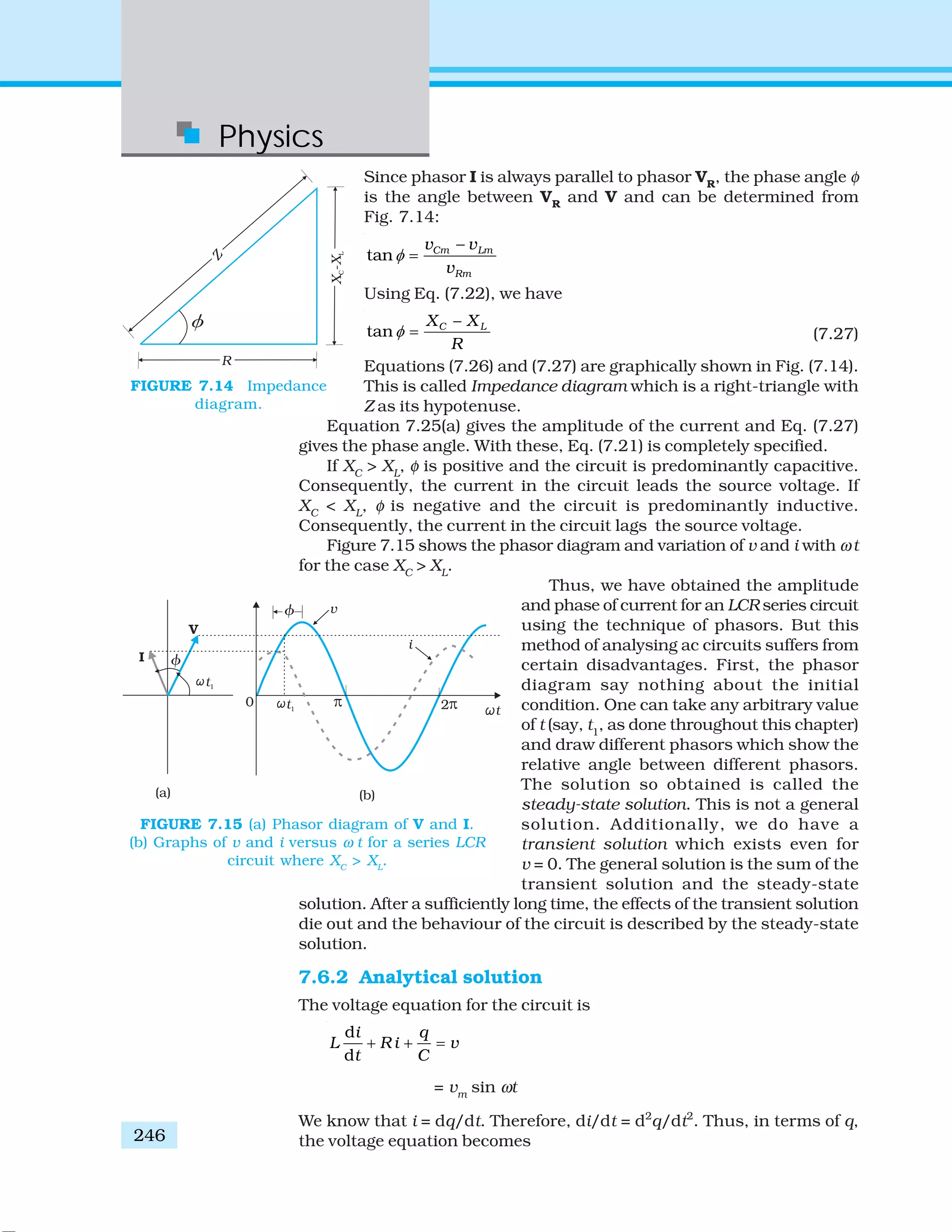
![Alternating Current
247
2
2
d d
sin
dd
m
q q q
L R v t
t Ct
ω+ + = (7.28)
This is like the equation for a forced, damped oscillator, [see Eq. {14.37(b)}
in Class XI Physics Textbook]. Let us assume a solution
q = qm
sin (ω t + θ) [7.29(a)]
so that
d
cos( )
d
m
q
q t
t
ω ω θ= + [7.29(b)]
and
2
2
2
d
sin( )
d
m
q
q t
t
ω ω θ= − + [7.29(c)]
Substituting these values in Eq. (7.28), we get
[ ]cos( ) ( )sin( )m C Lq R t X X tω ω θ ω θ+ + − + = sinmv tω (7.30)
where we have used the relation Xc
= 1/ωC, XL
= ω L. Multiplying and
dividing Eq. (7.30) by ( )22
c LZ R X X= + − , we have
( )
cos( ) sin( )C L
m
X XR
q Z t t
Z Z
ω ω θ ω θ
−⎡ ⎤
+ + +⎢ ⎥
⎣ ⎦
sinmv tω= (7.31)
Now, let cos
R
Z
φ=
and
( )
sinC LX X
Z
φ
−
=
so that
1
tan C LX X
R
φ − −
= (7.32)
Substituting this in Eq. (7.31) and simplifying, we get:
cos( ) sinm mq Z t v tω ω θ φ ω+ − = (7.33)
Comparing the two sides of this equation, we see that
m m mv q Z i Zω= =
where
m mi q ω= [7.33(a)]
and
2
θ φ
π
− = − or
2
θ φ
π
= − + [7.33(b)]
Therefore, the current in the circuit is
d
d
cos( )m
q
i q t
t
ω ω θ= = +
= im
cos(ωt + θ)
or i = im
sin(ωt + φ) (7.34)
where 2 2
( )
m m
m
C L
v v
i
Z R X X
= =
+ −
[7.34(a)]
and
1
tan C LX X
R
φ − −
=](https://image.slidesharecdn.com/ncert-class-12-physics-part-1-161112171109/75/Ncert-class-12-physics-part-1-251-2048.jpg)
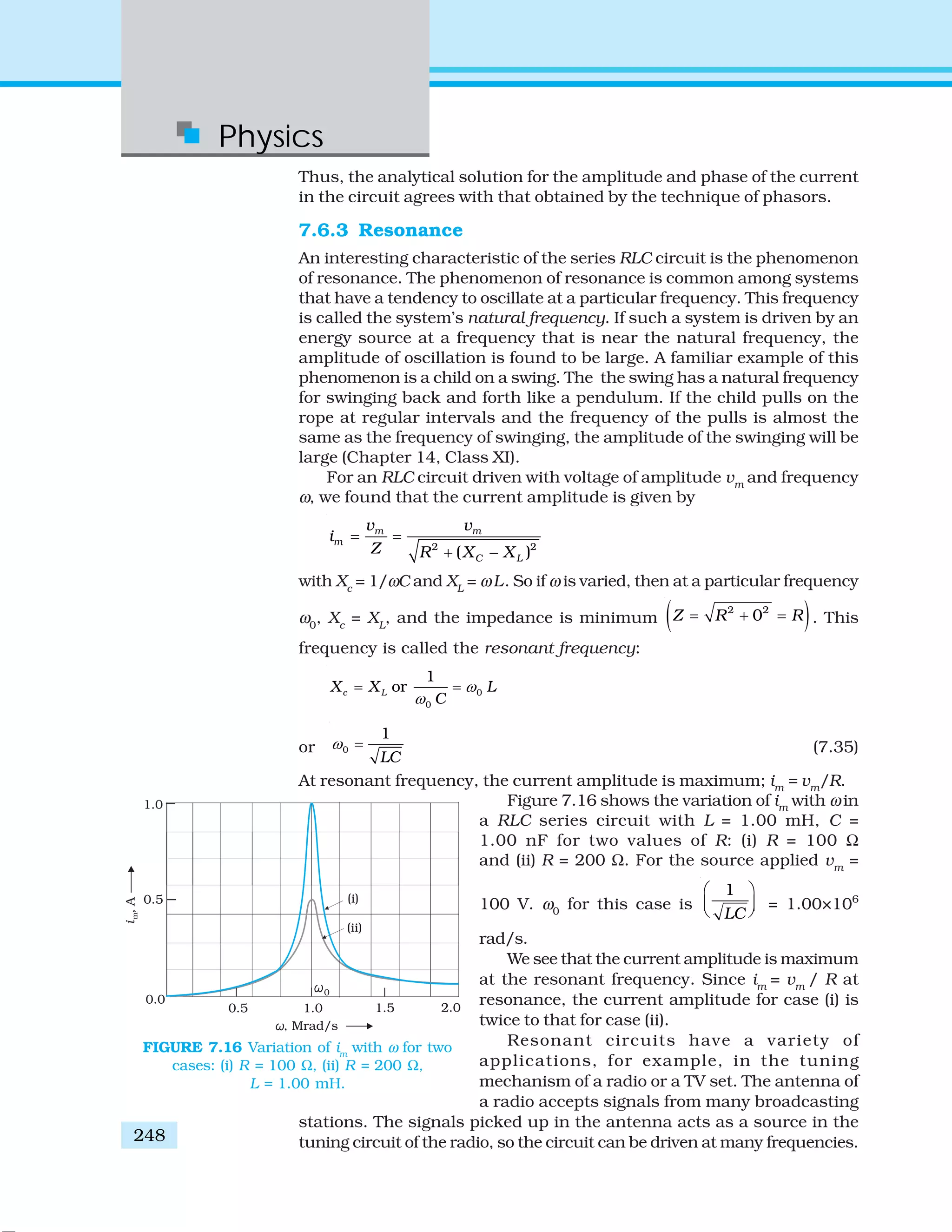
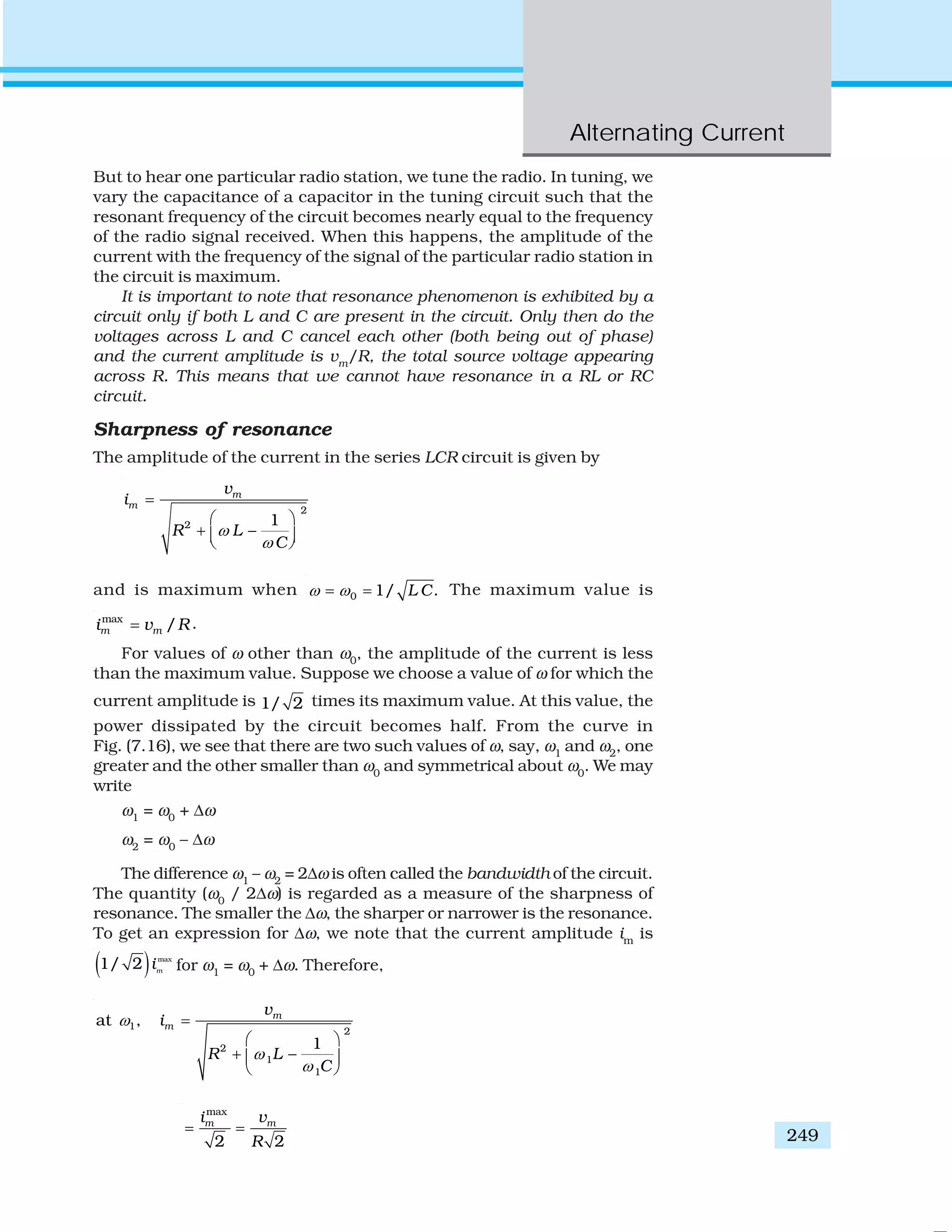
![Physics
250
or
2
2
1
1
1
2R L R
C
ω
ω
⎛ ⎞
+ − =⎜ ⎟⎝ ⎠
or
2
2 2
1
1
1
2R L R
C
ω
ω
⎛ ⎞
+ − =⎜ ⎟⎝ ⎠
1
1
1
L R
C
ω
ω
− =
which may be written as,
0
0
1
( )
( )
L R
C
ω ω
ω ω
+ Δ − =
+ Δ
0
0
0
0
1
1
1
L R
C
ω
ω
ω ω
ω
ω
⎛ ⎞Δ
+ − =⎜ ⎟ ⎛ ⎞⎝ ⎠ Δ
+⎜ ⎟⎝ ⎠
Using 2
0
1
L C
ω = in the second term on the left hand side, we get
0
0
0
0
1
1
L
L R
ωω
ω
ω ω
ω
⎛ ⎞Δ
+ − =⎜ ⎟ ⎛ ⎞⎝ ⎠ Δ
+⎜ ⎟⎝ ⎠
We can approximate
1
0
1
ω
ω
−
⎛ ⎞Δ
+⎜ ⎟⎝ ⎠
as
0
1
ω
ω
⎛ ⎞Δ
−⎜ ⎟⎝ ⎠
since
0
ω
ω
Δ
<<1. Therefore,
0 0
0 0
1 1L L R
ω ω
ω ω
ω ω
⎛ ⎞ ⎛ ⎞Δ Δ
+ − − =⎜ ⎟ ⎜ ⎟⎝ ⎠ ⎝ ⎠
or 0
0
2
L R
ω
ω
ω
Δ
=
2
R
L
ωΔ = [7.36(a)]
The sharpness of resonance is given by,
0 0
2
L
R
ω ω
ω
=
Δ
[7.36(b)]
The ratio
0L
R
ω
is also called the quality factor, Q of the circuit.
0L
Q
R
ω
= [7.36(c)]
From Eqs. [7.36 (b)] and [7.36 (c)], we see that 0
2
Q
ω
ωΔ = . So, larger the](https://image.slidesharecdn.com/ncert-class-12-physics-part-1-161112171109/75/Ncert-class-12-physics-part-1-254-2048.jpg)
![Alternating Current
251
EXAMPLE7.6
value of Q, the smaller is the value of 2Δω or the bandwidth and sharper
is the resonance. Using 2
0 1/L Cω = , Eq. [7.36(c)] can be equivalently
expressed as Q = 1/ω0
CR.
We see from Fig. 7.15, that if the resonance is less sharp, not only is
the maximum current less, the circuit is close to resonance for a larger
range Δω of frequencies and the tuning of the circuit will not be good. So,
less sharp the resonance, less is the selectivity of the circuit or vice versa.
From Eq. (7.36), we see that if quality factor is large, i.e., R is low or L is
large, the circuit is more selective.
Example 7.6 A resistor of 200 Ω and a capacitor of 15.0 μF are
connected in series to a 220 V, 50 Hz ac source. (a) Calculate the
current in the circuit; (b) Calculate the voltage (rms) across the
resistor and the capacitor. Is the algebraic sum of these voltages
more than the source voltage? If yes, resolve the paradox.
Solution
Given
F 6
200 , 15.0 15.0 10 FR C −
= Ω = μ = ×
220 V, 50HzV ν= =
(a) In order to calculate the current, we need the impedance of the
circuit. It is
2 2 2 2
(2 )CZ R X R Cπ ν −
= + = +
F2 6 2
(200 ) (2 3.14 50 10 )− −
= Ω + × × ×
2 2
(200 ) (212 )= Ω + Ω
291.5= Ω
Therefore, the current in the circuit is
V220
0.755 A
291.5
V
I
Z
= = =
Ω
(b) Since the current is the same throughout the circuit, we have
(0.755 A)(200 ) 151VRV I R= = Ω =
(0.755 A)(212.3 ) 160.3 VC CV I X= = Ω =
The algebraic sum of the two voltages, VR
and VC
is 311.3 V which is
more than the source voltage of 220 V. How to resolve this paradox?
As you have learnt in the text, the two voltages are not in the same
phase. Therefore, they cannot be added like ordinary numbers. The
two voltages are out of phase by ninety degrees. Therefore, the total
of these voltages must be obtained using the Pythagorean theorem:
2 2
R C R CV V V+ = +
= 220 V
Thus, if the phase difference between two voltages is properly taken
into account, the total voltage across the resistor and the capacitor is
equal to the voltage of the source.](https://image.slidesharecdn.com/ncert-class-12-physics-part-1-161112171109/75/Ncert-class-12-physics-part-1-255-2048.jpg)
![Physics
252
EXAMPLE7.7
7.7 POWER IN AC CIRCUIT: THE POWER FACTOR
We have seen that a voltage v = vm
sinωt applied to a series RLC circuit
drives a current in the circuit given by i = im
sin(ωt + φ) where
m
m
v
i
Z
= and 1
tan C LX X
R
φ − −⎛ ⎞
= ⎜ ⎟⎝ ⎠
Therefore, the instantaneous power p supplied by the source is
( ) [ ]sin sin( )m mp v i v t i tω ω φ= = × +
[ ]cos cos(2 )
2
m mv i
tφ ω φ= − + (7.37)
The average power over a cycle is given by the average of the two terms in
R.H.S. of Eq. (7.37). It is only the second term which is time-dependent.
Its average is zero (the positive half of the cosine cancels the negative
half). Therefore,
cos
2
m mv i
P φ= cos
2 2
m mv i
φ=
cosV I φ= [7.38(a)]
This can also be written as,
2
cosP I Z φ= [7.38(b)]
So, the average power dissipated depends not only on the voltage and
current but also on the cosine of the phase angle φ between them. The
quantity cosφ is called the power factor. Let us discuss the following
cases:
Case (i) Resistive circuit: If the circuit contains only pure R, it is called
resistive. In that case φ = 0, cos φ =1.Thereis maximum power dissipation.
Case (ii) Purely inductive or capacitive circuit: If the circuit contains
only an inductor or capacitor, we know that the phase difference between
voltage and current is π/2. Therefore, cos φ = 0, and no power is dissipated
even though a current is flowing in the circuit. This current is sometimes
referred to as wattless current.
Case (iii) LCR series circuit: In an LCR series circuit, power dissipated is
given by Eq. (7.38) where φ = tan–1
(Xc
– XL
)/ R. So, φ may be non-zero in
a RL or RC or RCL circuit. Even in such cases, power is dissipated only in
the resistor.
Case (iv) Power dissipated at resonance in LCR circuit: At resonance
Xc
– XL
= 0, and φ = 0. Therefore, cosφ = 1 and P = I2
Z = I2
R. That is,
maximum power is dissipated in a circuit (through R) at resonance.
Example7.7 (a) For circuits used for transporting electric power, a
low power factor implies large power loss in transmission. Explain.
(b) Power factor can often be improved by the use of a capacitor of
appropriate capacitance in the circuit. Explain.](https://image.slidesharecdn.com/ncert-class-12-physics-part-1-161112171109/75/Ncert-class-12-physics-part-1-256-2048.jpg)
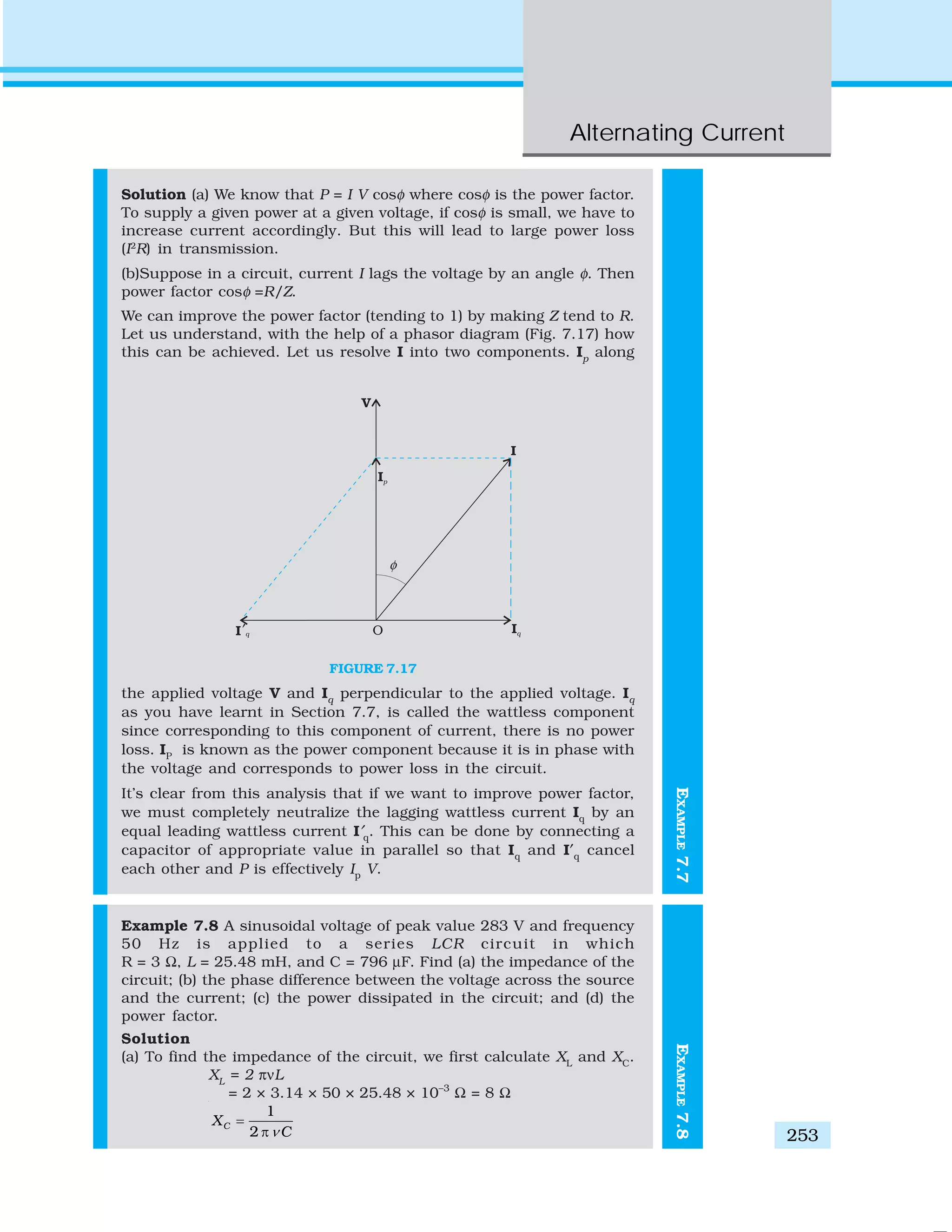
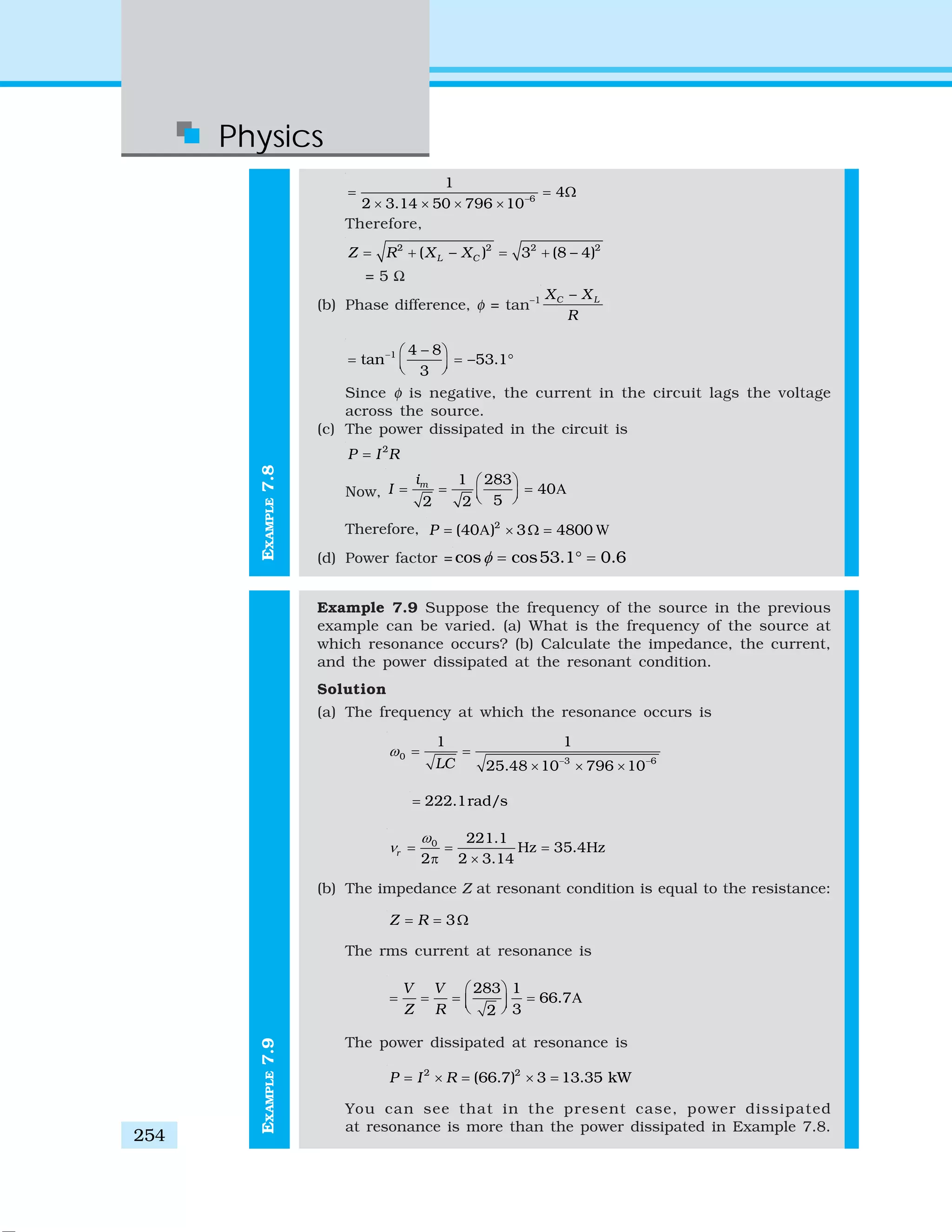

![Physics
256
0cos( )mq q tω= (7.43)
The current
d
d
q
i
t
⎛ ⎞
= −⎜ ⎟⎝ ⎠
is given by
0sin( )mi i tω= (7.44)
where 0m mi qω=
Let us now try to visualise how this oscillation takes place in the
circuit.
Figure 7.19(a) shows a capacitor with initial charge qm
connected to
an ideal inductor. The electrical energy stored in the charged capacitor is
2
1
2
m
E
q
U
C
= . Since, there is no current in the circuit, energy in the inductor
is zero. Thus, the total energy of LC circuit is,
2
1
2
m
E
q
U U
C
= =
FIGURE 7.19 The oscillations in an LC circuit are analogous to the oscillation of a
block at the end of a spring. The figure depicts one-half of a cycle.
At t = 0, the switch is closed and the capacitor starts to discharge
[Fig. 7.19(b)]. As the current increases, it sets up a magnetic field in the
inductor and thereby, some energy gets stored in the inductor in the
form of magnetic energy: UB
= (1/2) Li2
. As the current reaches its
maximum value im
, (at t = T/4) as in Fig. 7.19(c), all the energy is stored
in the magnetic field: UB
= (1/2) Li2
m
. You can easily check that the
maximum electrical energy equals the maximum magnetic energy. The
capacitor now has no charge and hence no energy. The current now
starts charging the capacitor, as in Fig. 7.19(d). This process continues
till the capacitor is fully charged (at t = T/2) [Fig. 7.19(e)]. But it is charged
with a polarity opposite to its initial state in Fig. 7.19(a). The whole process
just described will now repeat itself till the system reverts to its original
state. Thus, the energy in the system oscillates between the capacitor
and the inductor.](https://image.slidesharecdn.com/ncert-class-12-physics-part-1-161112171109/75/Ncert-class-12-physics-part-1-260-2048.jpg)
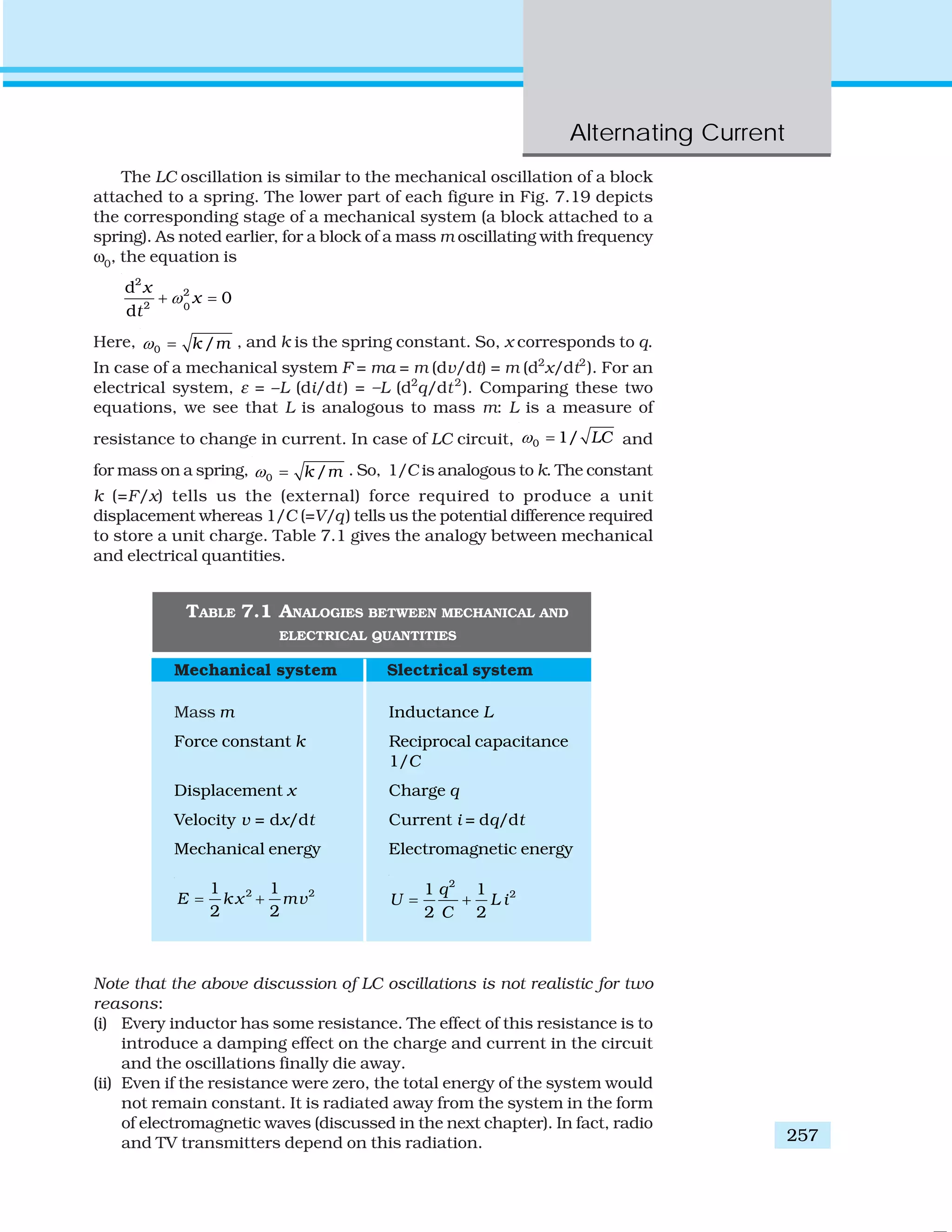
![Physics
258
TWO DIFFERENT PHENOMENA, SAME MATHEMATICAL TREATMENT
You may like to compare the treatment of a forced damped oscillator discussed in Section
14.10 of Class XI physics textbook, with that of an LCR circuit when an ac voltage is
applied in it. We have already remarked that Eq. [14.37(b)] of Class XI Textbook is exactly
similar to Eq. (7.28) here, although they use different symbols and parameters. Let us
therefore list the equivalence between different quantities in the two situations:
Forced oscillations Driven LCR circuit
cos d
2d x dxm b kx F
2 dtdt
tω+ + =
2
2
d d
sin
dd
m
q q q
L R v t
t Ct
ω+ + =
Displacement, x Charge on capacitor, q
Time, t Time, t
Mass, m Self inductance, L
Damping constant, b Resistance, R
Spring constant, k Inverse capacitance, 1/C
Driving frequency, ωd
Driving frequency, ω
Natural frequency of oscillations, ω Natural frequency of LCR circuit, ω0
Amplitude of forced oscillations, A Maximum charge stored, qm
Amplitude of driving force, F0
Amplitude of applied voltage, vm
You must note that since x corresponds to q, the amplitude A (maximum displacement)
will correspond to the maximum charge stored, qm
. Equation [14.39 (a)] of Class XI gives
the amplitude of oscillations in terms of other parameters, which we reproduce here for
convenience:
{ }
0
1/22 2 2 2 2 2
( )d d
F
A
m bω ω ω
=
− +
Replace each parameter in the above equation by the corresponding electrical
quantity, and see what happens. Eliminate L, C, ω , and ω
0
, using XL
= ωL, XC
= 1/ωC, and
ω0
2
= 1/LC. When you use Eqs. (7.33) and (7.34), you will see that there is a
perfect match.
You will come across numerous such situations in physics where diverse physical
phenomena are represented by the same mathematical equation. If you have dealt with
one of them, and you come across another situation, you may simply replace the
corresponding quantities and interpret the result in the new context. We suggest that
you may try to find more such parallel situations from different areas of physics. One
must, of course, be aware of the differences too.](https://image.slidesharecdn.com/ncert-class-12-physics-part-1-161112171109/75/Ncert-class-12-physics-part-1-262-2048.jpg)
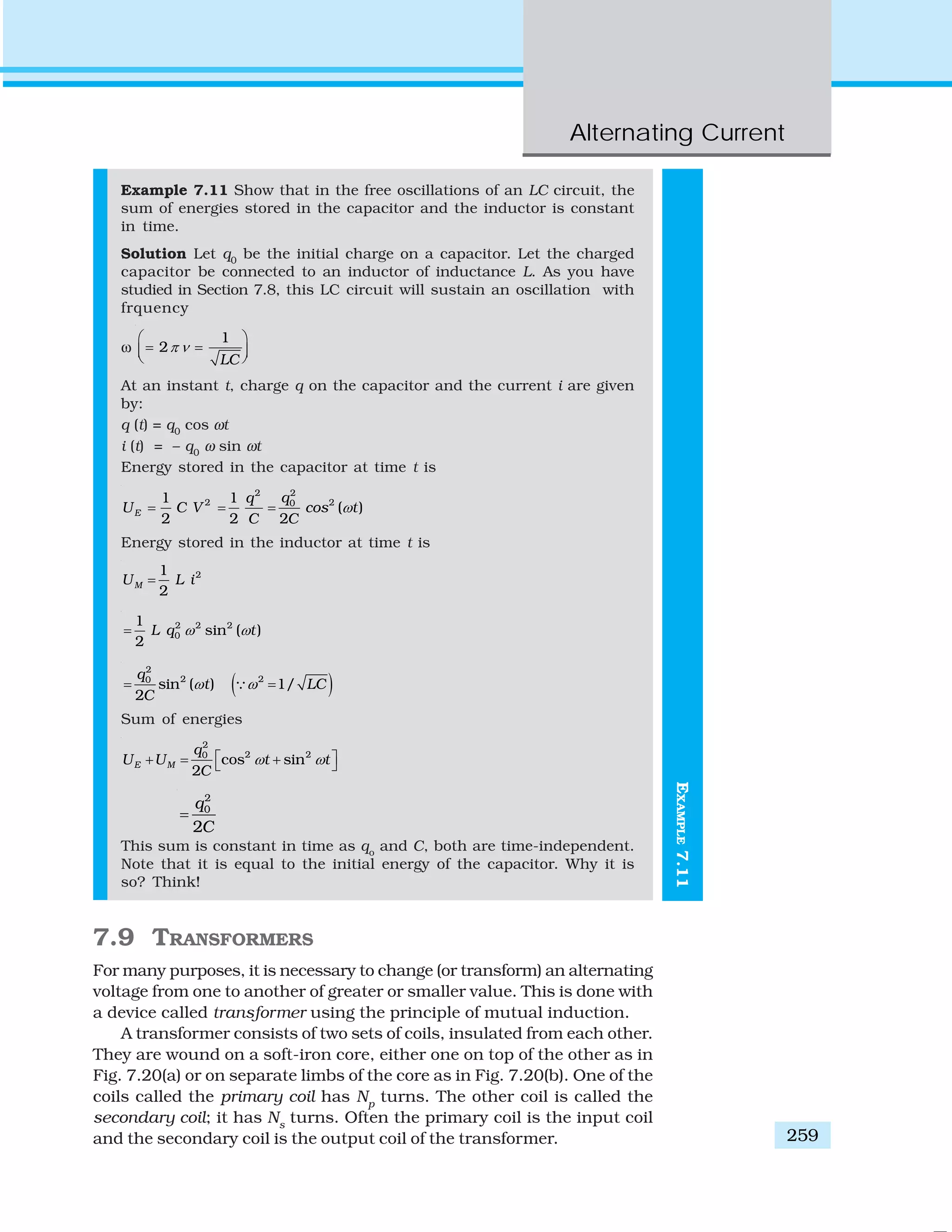
![Physics
260
When an alternating voltage is applied to the primary, the resulting
current produces an alternating magnetic flux which links the secondary
and induces an emf in it. The value of this emf depends on the number of
turns in the secondary. We consider an ideal transformer in which the
primary has negligible resistance and all the flux in the core links both
primary and secondary windings. Let φ be the flux in each turn in the
core at time t due to current in the primary when a voltage vp
is applied
to it.
Then the induced emf or voltage εs
, in the secondary with Ns
turns is
d
d
s sN
t
φ
ε = − (7.45)
The alternating flux φ also induces an emf, called back emf in the
primary. This is
d
d
p pN
t
φ
ε = − (7.46)
But εp
= vp
. If this were not so, the primary current would be infinite
since the primary has zero resistance(as assumed). If the secondary is
an open circuit or the current taken from it is small, then to a good
approximation
εs
= vs
where vs
is the voltage across the secondary. Therefore, Eqs. (7.45) and
(7.46) can be written as
s s
d
v N
d t
φ
= − [7.45(a)]
p p
d
v N
d t
φ
= − [7.46(a)]
From Eqs. [7.45 (a)] and [7.45 (a)], we have
s s
p p
v N
v N
= (7.47)
FIGURE 7.20 Two arrangements for winding of primary and secondary coil in a transformer:
(a) two coils on top of each other, (b) two coils on separate limbs of the core.](https://image.slidesharecdn.com/ncert-class-12-physics-part-1-161112171109/75/Ncert-class-12-physics-part-1-264-2048.jpg)


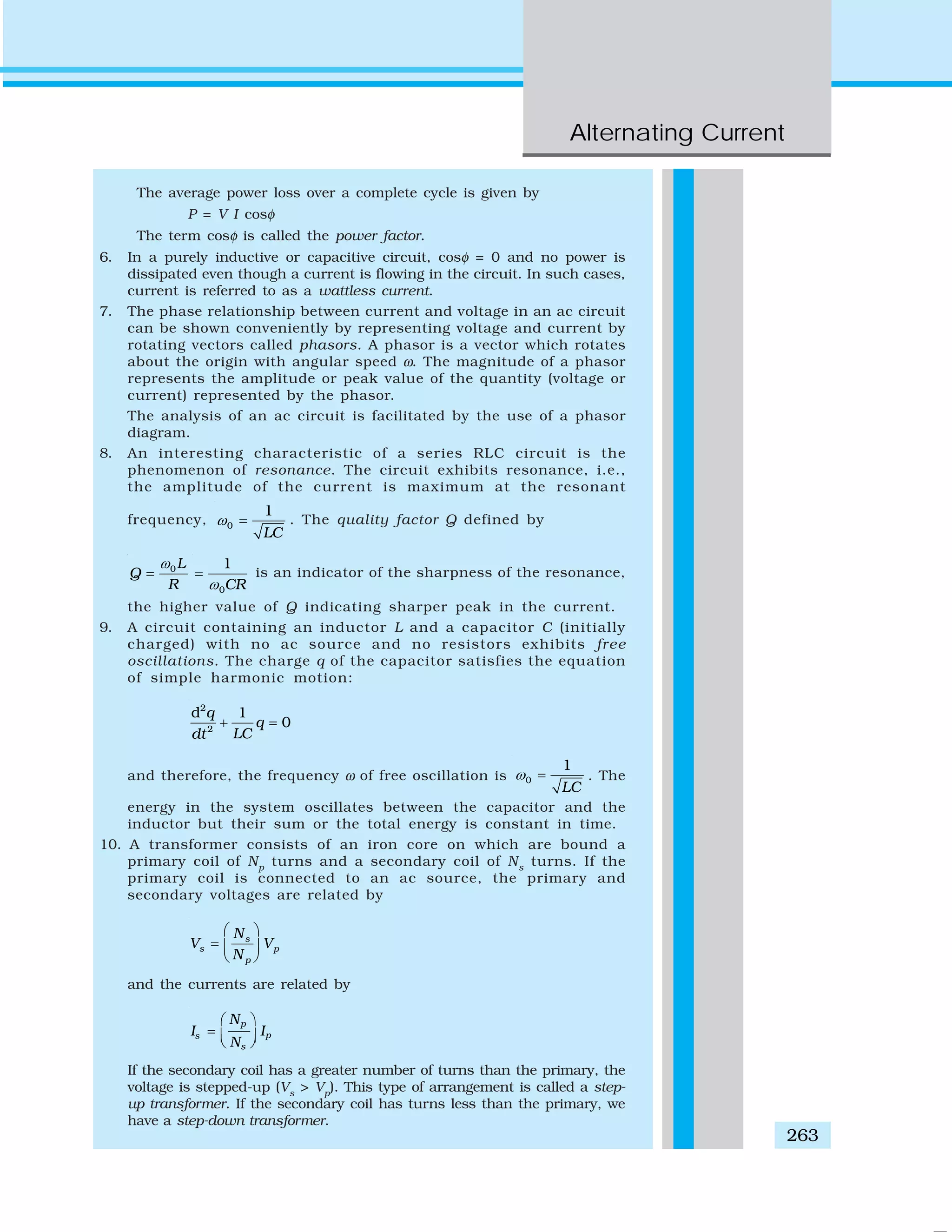
![Physics
264
Physical quantity Symbol Dimensions Unit Remarks
rms voltage V [M L2
T–3
A–1
] V V =
2
mv
, vm
is the
amplitude of the ac voltage.
rms current I [ A] A I =
2
mi
, im
is the amplitude of
the ac current.
Reactance:
Inductive XL
[M L
2
T
–3
A
–2
] Ω XL
= ω L
Capacitive XC
[M L
2
T
–3
A
–2
] Ω XC
= 1/ω C
Impedance Z [M L2
T–3
A–2
] Ω Depends on elements
present in the circuit.
Resonant ωr
or ω0
[T
–1
] Hz ω0
LC
1
= for a
frequency
series RLC circuit
Quality factor Q Dimensionless 0
0
1L
Q
R C R
ω
ω
= = for a series
RLC circuit.
Power factor Dimensionless = cosφ, φ is the phase
difference between voltage
applied and current in
the circuit.
POINTS TO PONDER
1. When a value is given for ac voltage or current, it is ordinarily the rms
value. The voltage across the terminals of an outlet in your room is
normally 240 V. This refers to the rms value of the voltage. The amplitude
of this voltage is
V2 2(240) 340mv V= = =
2. The power rating of an element used in ac circuits refers to its average
power rating.
3. The power consumed in an circuit is never negative.
4. Both alternating current and direct current are measured in amperes.
But how is the ampere defined for an alternating current? It cannot be
derived from the mutual attraction of two parallel wires carrying ac
currents, as the dc ampere is derived. An ac current changes direction](https://image.slidesharecdn.com/ncert-class-12-physics-part-1-161112171109/75/Ncert-class-12-physics-part-1-268-2048.jpg)
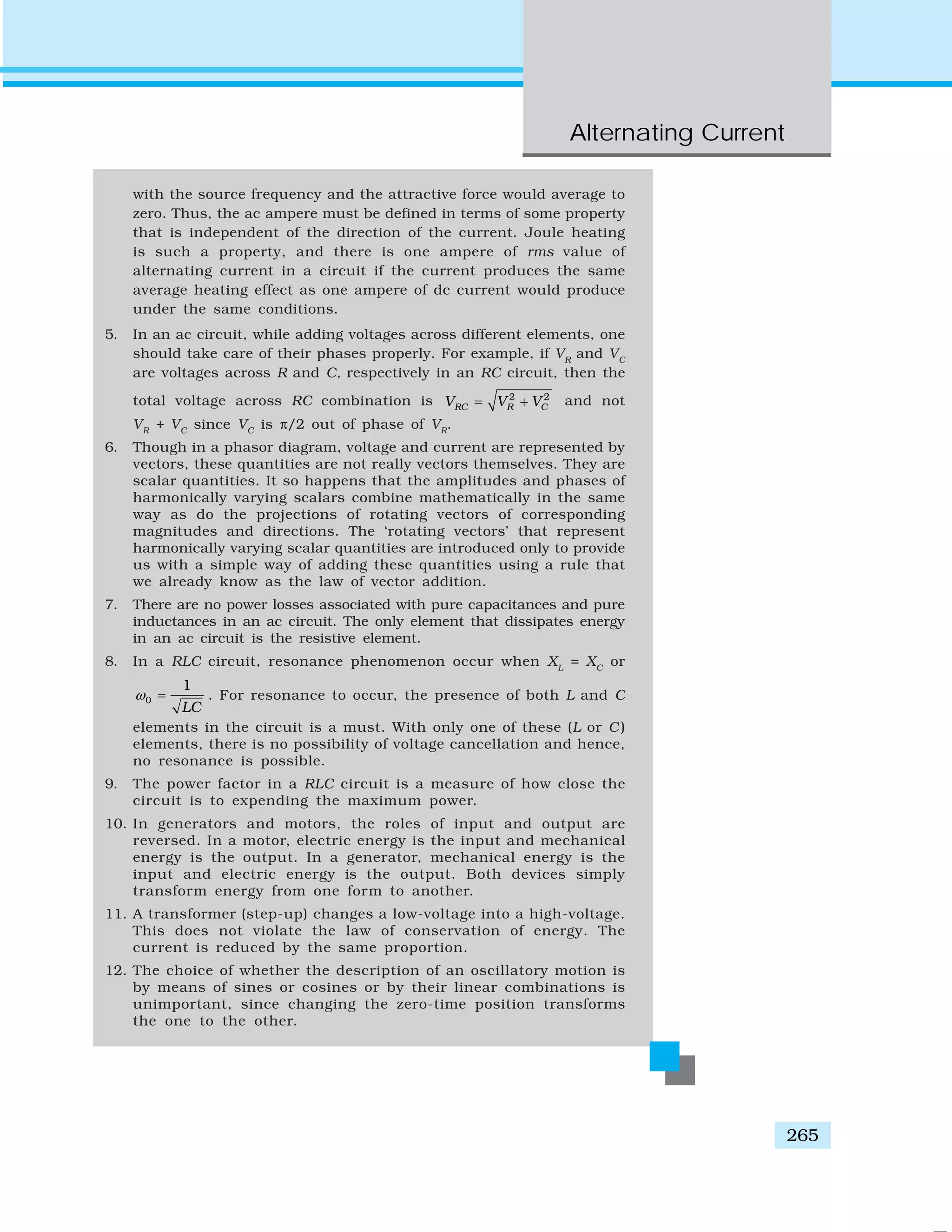
![Physics
266
EXERCISES
7.1 A 100 Ω resistor is connected to a 220 V, 50 Hz ac supply.
(a) What is the rms value of current in the circuit?
(b) What is the net power consumed over a full cycle?
7.2 (a) The peak voltage of an ac supply is 300 V. What is the rms voltage?
(b) The rms value of current in an ac circuit is 10 A. What is the
peak current?
7.3 A 44 mH inductor is connected to 220 V, 50 Hz ac supply. Determine
the rms value of the current in the circuit.
7.4 A 60 μF capacitor is connected to a 110 V, 60 Hz ac supply. Determine
the rms value of the current in the circuit.
7.5 In Exercises 7.3 and 7.4, what is the net power absorbed by each
circuit over a complete cycle. Explain your answer.
7.6 Obtain the resonant frequency ωr
of a series LCR circuit with
L = 2.0H, C = 32 μF and R = 10 Ω. What is the Q-value of this circuit?
7.7 A charged 30 μF capacitor is connected to a 27 mH inductor. What is
the angular frequency of free oscillations of the circuit?
7.8 Suppose the initial charge on the capacitor in Exercise 7.7 is 6 mC.
What is the total energy stored in the circuit initially? What is the
total energy at later time?
7.9 A series LCR circuit with R = 20 Ω, L = 1.5 H and C = 35 μF is connected
to a variable-frequency 200 V ac supply. When the frequency of the
supply equals the natural frequency of the circuit, what is the average
power transferred to the circuit in one complete cycle?
7.10 A radio can tune over the frequency range of a portion of MW
broadcast band: (800 kHz to 1200 kHz). If its LC circuit has an effective
inductance of 200 μH, what must be the range of its variable
capacitor?
[Hint: For tuning, the natural frequency i.e., the frequency of free
oscillations of the LC circuit should be equal to the frequency of the
radiowave.]
7.11 Figure 7.21 shows a series LCR circuit connected to a variable
frequency 230 V source. L = 5.0 H, C = 80μF, R = 40 Ω.
(a) Determine the source frequency which drives the circuit in
resonance.
(b) Obtain the impedance of the circuit and the amplitude of current
at the resonating frequency.
(c) Determine the rms potential drops across the three elements of
the circuit. Show that the potential drop across the LC
combination is zero at the resonating frequency.
FIGURE 7.21](https://image.slidesharecdn.com/ncert-class-12-physics-part-1-161112171109/75/Ncert-class-12-physics-part-1-270-2048.jpg)
![Alternating Current
267
ADDITIONAL EXERCISES
7.12 An LC circuit contains a 20 mH inductor and a 50 μF capacitor with
an initial charge of 10 mC. The resistance of the circuit is negligible.
Let the instant the circuit is closed be t = 0.
(a) What is the total energy stored initially? Is it conserved during
LC oscillations?
(b) What is the natural frequency of the circuit?
(c) At what time is the energy stored
(i) completely electrical (i.e., stored in the capacitor)? (ii) completely
magnetic (i.e., stored in the inductor)?
(d) At what times is the total energy shared equally between the
inductor and the capacitor?
(e) If a resistor is inserted in the circuit, how much energy is
eventually dissipated as heat?
7.13 A coil of inductance 0.50 H and resistance 100 Ω is connected to a
240 V, 50 Hz ac supply.
(a) What is the maximum current in the coil?
(b) What is the time lag between the voltage maximum and the
current maximum?
7.14 Obtain the answers (a) to (b) in Exercise 7.13 if the circuit is
connected to a high frequency supply (240 V, 10 kHz). Hence, explain
the statement that at very high frequency, an inductor in a circuit
nearly amounts to an open circuit. How does an inductor behave in
a dc circuit after the steady state?
7.15 A 100 μF capacitor in series with a 40 Ω resistance is connected to a
110 V, 60 Hz supply.
(a) What is the maximum current in the circuit?
(b) What is the time lag between the current maximum and the
voltage maximum?
7.16 Obtain the answers to (a) and (b) in Exercise 7.15 if the circuit is
connected to a 110 V, 12 kHz supply? Hence, explain the statement
that a capacitor is a conductor at very high frequencies. Compare this
behaviour with that of a capacitor in a dc circuit after the steady state.
7.17 Keeping the source frequency equal to the resonating frequency of
the series LCR circuit, if the three elements, L, C and R are arranged
in parallel, show that the total current in the parallel LCR circuit is
minimum at this frequency. Obtain the current rms value in each
branch of the circuit for the elements and source specified in
Exercise 7.11 for this frequency.
7.18 A circuit containing a 80 mH inductor and a 60 μF capacitor in series
is connected to a 230 V, 50 Hz supply. The resistance of the circuit is
negligible.
(a) Obtain the current amplitude and rms values.
(b) Obtain the rms values of potential drops across each element.
(c) What is the average power transferred to the inductor?
(d) What is the average power transferred to the capacitor?
(e) What is the total average power absorbed by the circuit? [‘Average’
implies ‘averaged over one cycle’.]
7.19 Suppose the circuit in Exercise 7.18 has a resistance of 15 Ω. Obtain
the average power transferred to each element of the circuit, and
the total power absorbed.](https://image.slidesharecdn.com/ncert-class-12-physics-part-1-161112171109/75/Ncert-class-12-physics-part-1-271-2048.jpg)

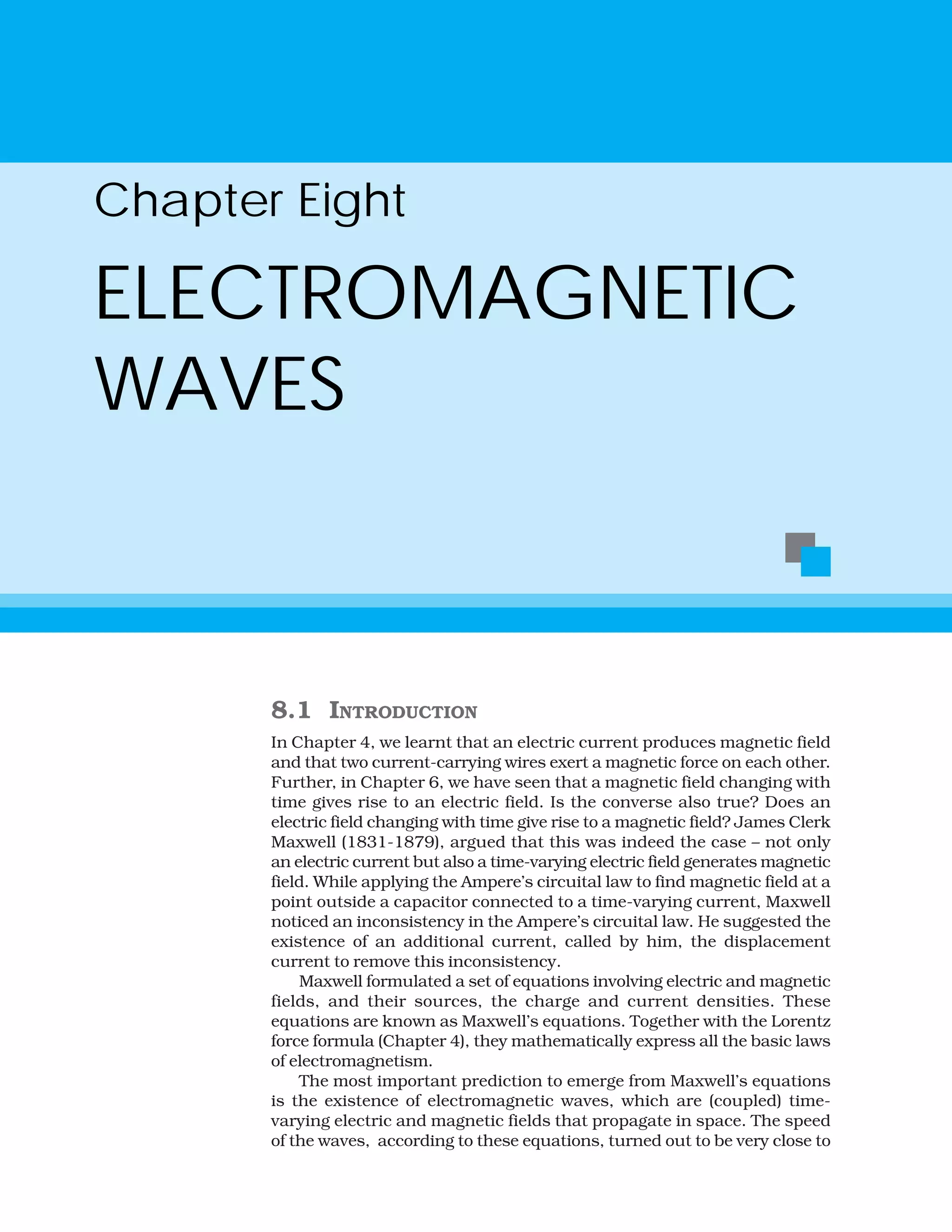
![Physics
270
the speed of light( 3 ×108
m/s), obtained from optical
measurements. This led to the remarkable conclusion
that light is an electromagnetic wave. Maxwell’s work
thus unified the domain of electricity, magnetism and
light. Hertz, in 1885, experimentally demonstrated the
existence of electromagnetic waves. Its technological use
by Marconi and others led in due course to the
revolution in communication that we are witnessing
today.
In this chapter, we first discuss the need for
displacement current and its consequences. Then we
present a descriptive account of electromagnetic waves.
The broad spectrum of electromagnetic waves,
stretching from γ rays (wavelength ~10–12
m) to long
radio waves (wavelength ~106
m) is described. How the
electromagnetic waves are sent and received for
communication is discussed in Chapter 15.
8.2 DISPLACEMENT CURRENT
We have seen in Chapter 4 that an electrical current
produces a magnetic field around it. Maxwell showed
that for logical consistency, a changing electric field must
also produce a magnetic field. This effect is of great
importance because it explains the existence of radio
waves, gamma rays and visible light, as well as all other
forms of electromagnetic waves.
To see how a changing electric field gives rise to
a magnetic field, let us consider the process of
charging of a capacitor and apply Ampere’s circuital
law given by (Chapter 4)
“B.dl = μ0
i (t) (8.1)
to find magnetic field at a point outside the capacitor.
Figure 8.1(a) shows a parallel plate capacitor C which
is a part of circuit through which a time-dependent
current i (t) flows . Let us find the magnetic field at a
point such as P, in a region outside the parallel plate
capacitor. For this, we consider a plane circular loop of
radius r whose plane is perpendicular to the direction
of the current-carrying wire, and which is centred
symmetrically with respect to the wire [Fig. 8.1(a)]. From
symmetry, the magnetic field is directed along the
circumference of the circular loop and is the same in
magnitude at all points on the loop so that if B is the
magnitude of the field, the left side of Eq. (8.1) is B (2π r).
So we have
B (2πr) = μ0
i (t) (8 .2)
JAMESCLERKMAXWELL(1831–1879)
James Clerk Maxwell
(1831 – 1879) Born in
Edinburgh, Scotland,
was among the greatest
physicists of the
nineteenth century. He
derived the thermal
velocity distribution of
molecules in a gas and
was among the first to
obtain reliable
estimates of molecular
parameters from
measurable quantities
like viscosity, etc.
Maxwell’s greatest
acheivement was the
unification of the laws of
electricity and
magnetism (discovered
by Coulomb, Oersted,
Ampere and Faraday)
into a consistent set of
equations now called
Maxwell’s equations.
From these he arrived at
the most important
conclusion that light is
an electromagnetic
wave. Interestingly,
Maxwell did not agree
with the idea (strongly
suggested by the
Faraday’s laws of
electrolysis) that
electricity was
particulate in nature.](https://image.slidesharecdn.com/ncert-class-12-physics-part-1-161112171109/75/Ncert-class-12-physics-part-1-274-2048.jpg)
![Electromagnetic
Waves
271
Now, consider a different surface, which has the same boundary. This
is a pot like surface [Fig. 8.1(b)] which nowhere touches the current, but
has its bottom between the capacitor plates; its mouth is the circular
loop mentioned above. Another such surface is shaped like a tiffin box
(without the lid) [Fig. 8.1(c)]. On applying Ampere’s circuital law to such
surfaces with the same perimeter, we find that the left hand side of
Eq. (8.1) has not changed but the right hand side is zero and not μ0
i,
since no current passes through the surface of Fig. 8.1(b) and (c). So we
have a contradiction; calculated one way, there is a magnetic field at a
point P; calculated another way, the magnetic field at P is zero.
Since the contradiction arises from our use of Ampere’s circuital law,
this law must be missing something. The missing term must be such
that one gets the same magnetic field at point P, no matter what surface
is used.
We can actually guess the missing term by looking carefully at
Fig. 8.1(c). Is there anything passing through the surface S between the
plates of the capacitor? Yes, of course, the electric field! If the plates of the
capacitor have an area A, and a total charge Q, the magnitude of the
electric field E between the plates is (Q/A)/ε0
(see Eq. 2.41). The field is
perpendicular to the surface S of Fig. 8.1(c). It has the same magnitude
over the area A of the capacitor plates, and vanishes outside it. So what
is the electric flux ΦE
through the surface S ? Using Gauss’s law, it is
E
0 0
1
= =
Q Q
A A
A
Φ
ε ε
=E (8.3)
Now if the charge Q on the capacitor plates changes with time, there is a
current i = (dQ/dt), so that using Eq. (8.3), we have
0 0
d d 1 d
d d d
E Q Q
t t t
Φ
ε ε
⎛ ⎞
= =⎜ ⎟⎝ ⎠
This implies that for consistency,
0
d
d
E
t
Φ
ε
⎛ ⎞
⎜ ⎟⎝ ⎠
= i (8.4)
This is the missing term in Ampere’s circuital law. If we generalise
this law by adding to the total current carried by conductors through
the surface, another term which is ε0
times the rate of change of electric
flux through the same surface, the total has the same value of current i
for all surfaces. If this is done, there is no contradiction in the value of B
obtained anywhere using the generalised Ampere’s law. B at the point P
is non-zero no matter which surface is used for calculating it. B at a
point P outside the plates [Fig. 8.1(a)] is the same as at a point M just
inside, as it should be. The current carried by conductors due to flow of
charges is called conduction current. The current, given by Eq. (8.4), is a
new term, and is due to changing electric field (or electric displacement,
an old term still used sometimes). It is, therefore, called displacement
current or Maxwell’s displacement current. Figure 8.2 shows the electric
and magnetic fields inside the parallel plate capacitor discussed above.
The generalisation made by Maxwell then is the following. The source
of a magnetic field is not just the conduction electric current due to flowing
FIGURE 8.1 A
parallel plate
capacitor C, as part of
a circuit through
which a time
dependent current
i (t) flows, (a) a loop of
radius r, to determine
magnetic field at a
point P on the loop;
(b) a pot-shaped
surface passing
through the interior
between the capacitor
plates with the loop
shown in (a) as its
rim; (c) a tiffin-
shaped surface with
the circular loop as
its rim and a flat
circular bottom S
between the capacitor
plates. The arrows
show uniform electric
field between the
capacitor plates.](https://image.slidesharecdn.com/ncert-class-12-physics-part-1-161112171109/75/Ncert-class-12-physics-part-1-275-2048.jpg)
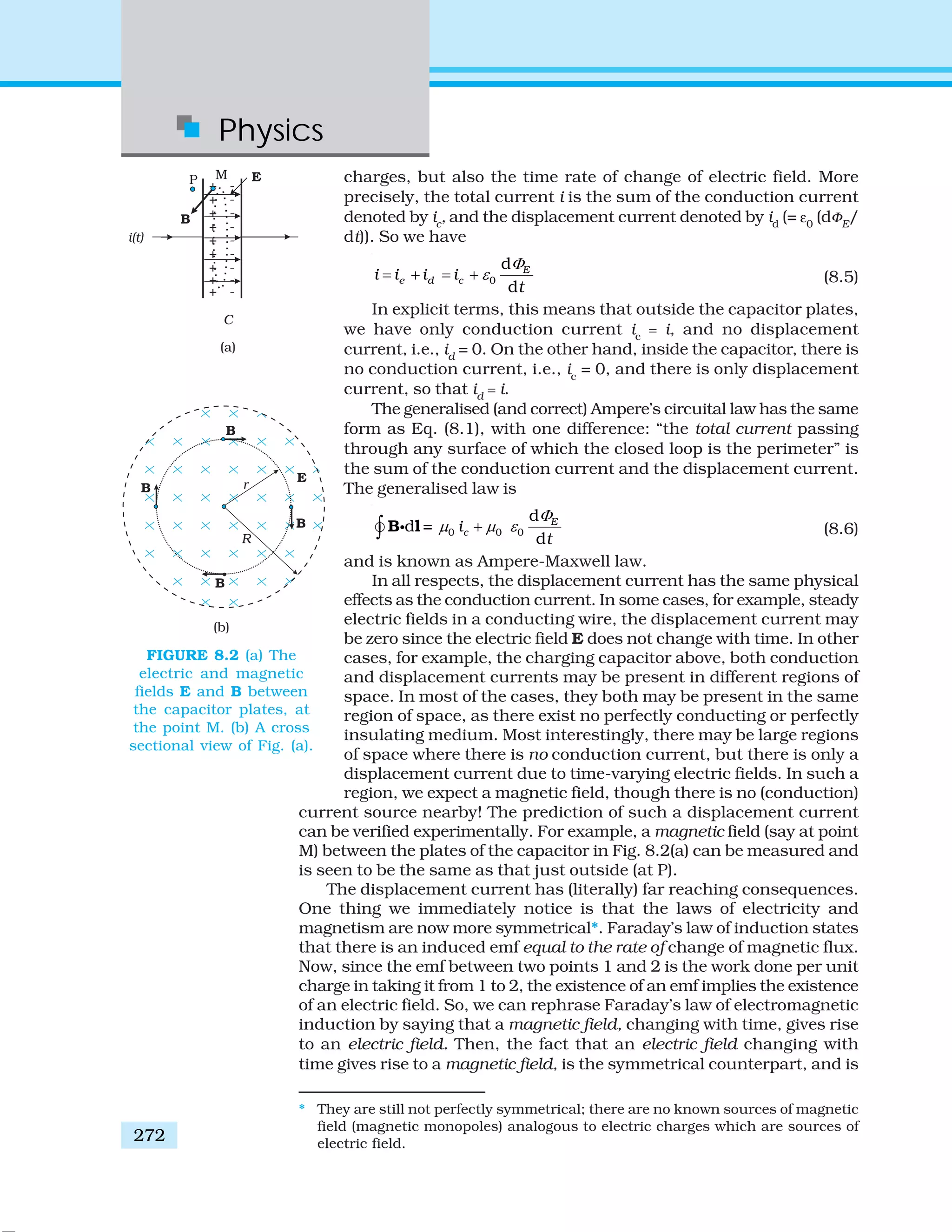
![Electromagnetic
Waves
273
EXAMPLE8.1
a consequence of the displacement current being a source of a magnetic
field. Thus, time- dependent electric and magnetic fields give rise to each
other! Faraday’s law of electromagnetic induction and Ampere-Maxwell
law give a quantitative expression of this statement, with the current
being the total current, as in Eq. (8.5). One very important consequence
of this symmetry is the existence of electromagnetic waves, which we
discuss qualitatively in the next section.
MAXWELL’S EQUATIONS
1. 0d = /Q ε∫ E Ai (Gauss’s Law for electricity)
2. d =0∫ B Ai (Gauss’s Law for magnetism)
3.
B–d
d =
dt
Φ
∫ E li (Faraday’s Law)
4. 0 0 0
d
d =
d
E
ci
t
Φ
μ μ ε+∫ B li (Ampere – Maxwell Law)
Example 8.1 A parallel plate capacitor with circular plates of radius
1 m has a capacitance of 1 nF. At t = 0, it is connected for charging in
series with a resistor R = 1 MΩ across a 2V battery (Fig. 8.3). Calculate
the magnetic field at a point P, halfway between the centre and the
periphery of the plates, after t = 10–3
s. (The charge on the capacitor
at time t is q (t) = CV [1 – exp (–t/τ)], where the time constant τ is
equal to CR.)
FIGURE 8.3
Solution The time constant of the CR circuit is τ = CR = 10–3
s. Then,
we have
q(t) = CV [1 – exp (–t/τ)]
= 2 × 10–9
[1– exp (–t/10–3
)]
The electric field in between the plates at time t is
( )
0 0
q t q
E
Aε ε
= =
π
; A = π (1)2
m2
= area of the plates.
Consider now a circular loop of radius (1/2) m parallel to the plates
passing through P. The magnetic field B at all points on the loop is](https://image.slidesharecdn.com/ncert-class-12-physics-part-1-161112171109/75/Ncert-class-12-physics-part-1-277-2048.jpg)
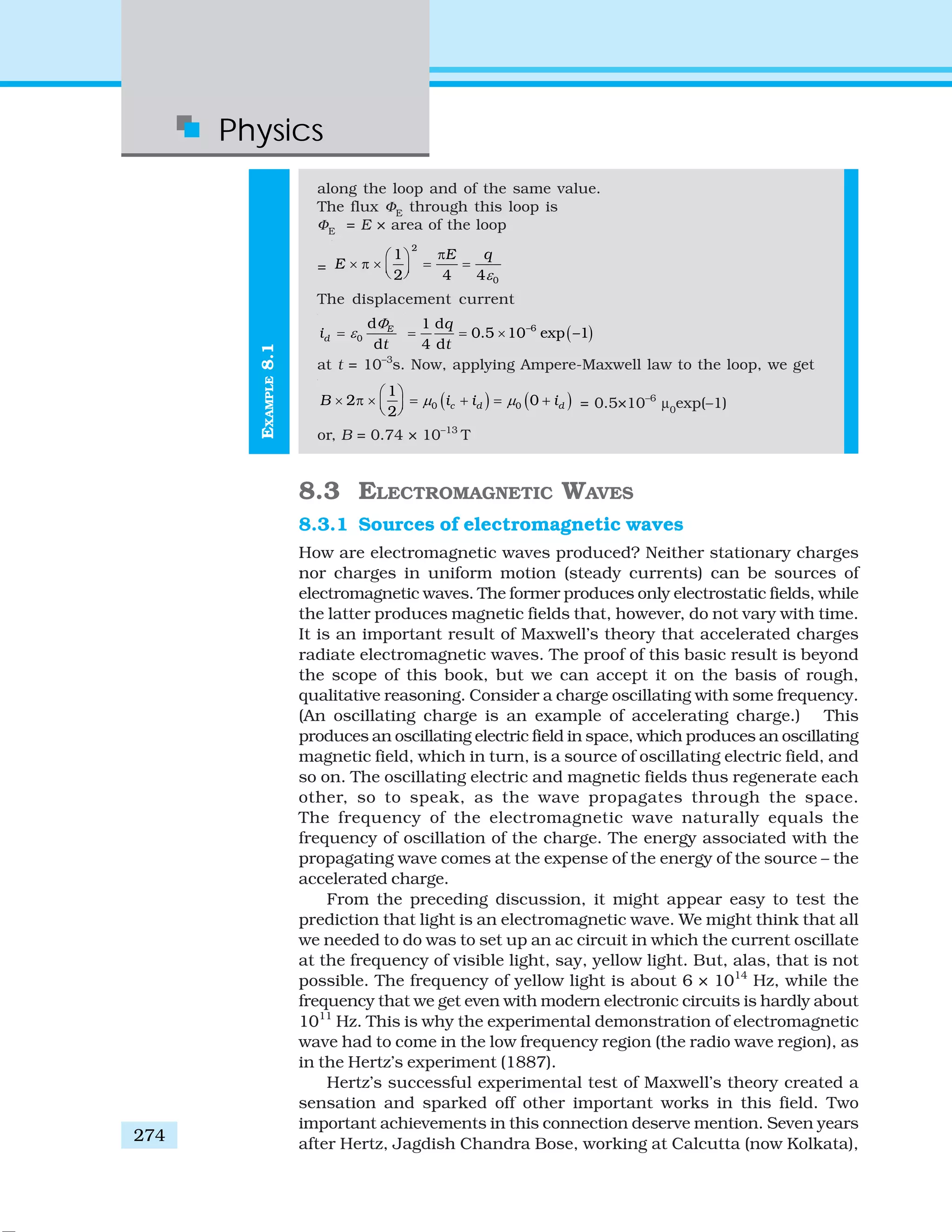
![Electromagnetic
Waves
275
succeeded in producing and observing electromagnetic
waves of much shorter wavelength (25 mm to 5 mm).
His experiment, like that of Hertz’s, was confined to the
laboratory.
At around the same time, Guglielmo Marconi in Italy
followed Hertz’s work and succeeded in transmitting
electromagnetic waves over distances of many kilometres.
Marconi’s experiment marks the beginning of the field of
communication using electromagnetic waves.
8.3.2 Nature of electromagnetic waves
It can be shown from Maxwell’s equations that electric
and magnetic fields in an electromagnetic wave are
perpendicular to each other, and to the direction of
propagation. It appears reasonable, say from our
discussion of the displacement current. Consider
Fig. 8.2. The electric field inside the plates of the capacitor
is directed perpendicular to the plates. The magnetic
field this gives rise to via the displacement current is
along the perimeter of a circle parallel to the capacitor
plates. So B and E are perpendicular in this case. This
is a general feature.
In Fig. 8.4, we show a typical example of a plane
electromagnetic wave propagating along the z direction
(the fields are shown as a function of the z coordinate,
at a given time t). The electric field Ex
is along the x-axis,
and varies sinusoidally with z, at a given time. The
magnetic field By
is along the y-axis, and again varies
sinusoidally with z. The electric and magnetic fields Ex
and By
are perpendicular to each other, and to the
direction z of propagation. We can write Ex
and By
as
follows:
Ex
= E0
sin (kz–ωt) [8.7(a)]
By
= B0
sin (kz–ωt) [8.7(b)]
Here k is related to the wave length λ of the wave by the
usual equation
2
k
λ
π
= (8.8)
and ω is the angular frequency. k
is the magnitude of the wave
vector (or propagation vector) k
and its direction describes the
direction of propagation of the
wave. The speed of propagation
of the wave is (ω/k ). Using
Eqs. [8.7(a) and (b)] for Ex
and By
and Maxwell’s equations, one
finds that
Heinrich Rudolf Hertz
(1857 – 1894) German
physicist who was the
first to broadcast and
receive radio waves. He
produced electro-
magnetic waves, sent
them through space, and
measured their wave-
length and speed. He
showed that the nature
of their vibration,
reflection and refraction
was the same as that of
light and heat waves,
establishing their
identity for the first time.
He also pioneered
research on discharge of
electricity through gases,
and discovered the
photoelectric effect.
HEINRICHRUDOLFHERTZ(1857–1894)
FIGURE 8.4 A linearly polarised electromagnetic wave,
propagating in the z-direction with the oscillating electric field E
along the x-direction and the oscillating magnetic field B along
the y-direction.](https://image.slidesharecdn.com/ncert-class-12-physics-part-1-161112171109/75/Ncert-class-12-physics-part-1-279-2048.jpg)
![Physics
276
ω = ck, where, c = 1/ 0 0μ ε [8.9(a)]
The relation ω = ck is the standard one for waves (see for example,
Section 15.4 of class XI Physics textbook). This relation is often written
in terms of frequency, ν (=ω/2π) and wavelength, λ (=2π/k) as
2
2 c
π
ν
λ
⎛ ⎞
π = ⎜ ⎟⎝ ⎠ or
νλ = c [8.9(b)]
It is also seen from Maxwell’s equations that the magnitude of the
electric and the magnetic fields in an electromagnetic wave are related as
B0
= (E0
/c) (8.10)
We here make remarks on some features of electromagnetic waves.
They are self-sustaining oscillations of electric and magnetic fields in free
space, or vacuum. They differ from all the other waves we have studied
so far, in respect that no material medium is involved in the vibrations of
the electric and magnetic fields. Sound waves in air are longitudinal waves
of compression and rarefaction. Transverse waves on the surface of water
consist of water moving up and down as the wave spreads horizontally
and radially onwards. Transverse elastic (sound) waves can also propagate
in a solid, which is rigid and that resists shear. Scientists in the nineteenth
century were so much used to this mechanical picture that they thought
that there must be some medium pervading all space and all matter,
which responds to electric and magnetic fields just as any elastic medium
does. They called this medium ether. They were so convinced of the reality
of this medium, that there is even a novel called The Poison Belt by Sir
Arthur Conan Doyle (the creator of the famous detective Sherlock Holmes)
where the solar system is supposed to pass through a poisonous region
of ether! We now accept that no such physical medium is needed. The
famous experiment of Michelson and Morley in 1887 demolished
conclusively the hypothesis of ether. Electric and magnetic fields,
oscillating in space and time, can sustain each other in vacuum.
But what if a material medium is actually there? We know that light,
an electromagnetic wave, does propagate through glass, for example. We
have seen earlier that the total electric and magnetic fields inside a
medium are described in terms of a permittivity ε and a magnetic
permeability μ (these describe the factors by which the total fields differ
from the external fields). These replace ε0
and μ0
in the description to
electric and magnetic fields in Maxwell’s equations with the result that in
a material medium of permittivity ε and magnetic permeability μ, the
velocity of light becomes,
1
v
με
= (8.11)
Thus, the velocity of light depends on electric and magnetic properties of
the medium. We shall see in the next chapter that the refractive index of
one medium with respect to the other is equal to the ratio of velocities of
light in the two media.
The velocity of electromagnetic waves in free space or vacuum is an
important fundamental constant. It has been shown by experiments on
electromagnetic waves of different wavelengths that this velocity is the
Simulatepropagationofelectromagneticwaves
(i)http://www.amanogawa.com/waves.html
(ii)http://www.phys.hawaii.edu/~teb/java/ntnujava/emWave/emWave.html](https://image.slidesharecdn.com/ncert-class-12-physics-part-1-161112171109/75/Ncert-class-12-physics-part-1-280-2048.jpg)
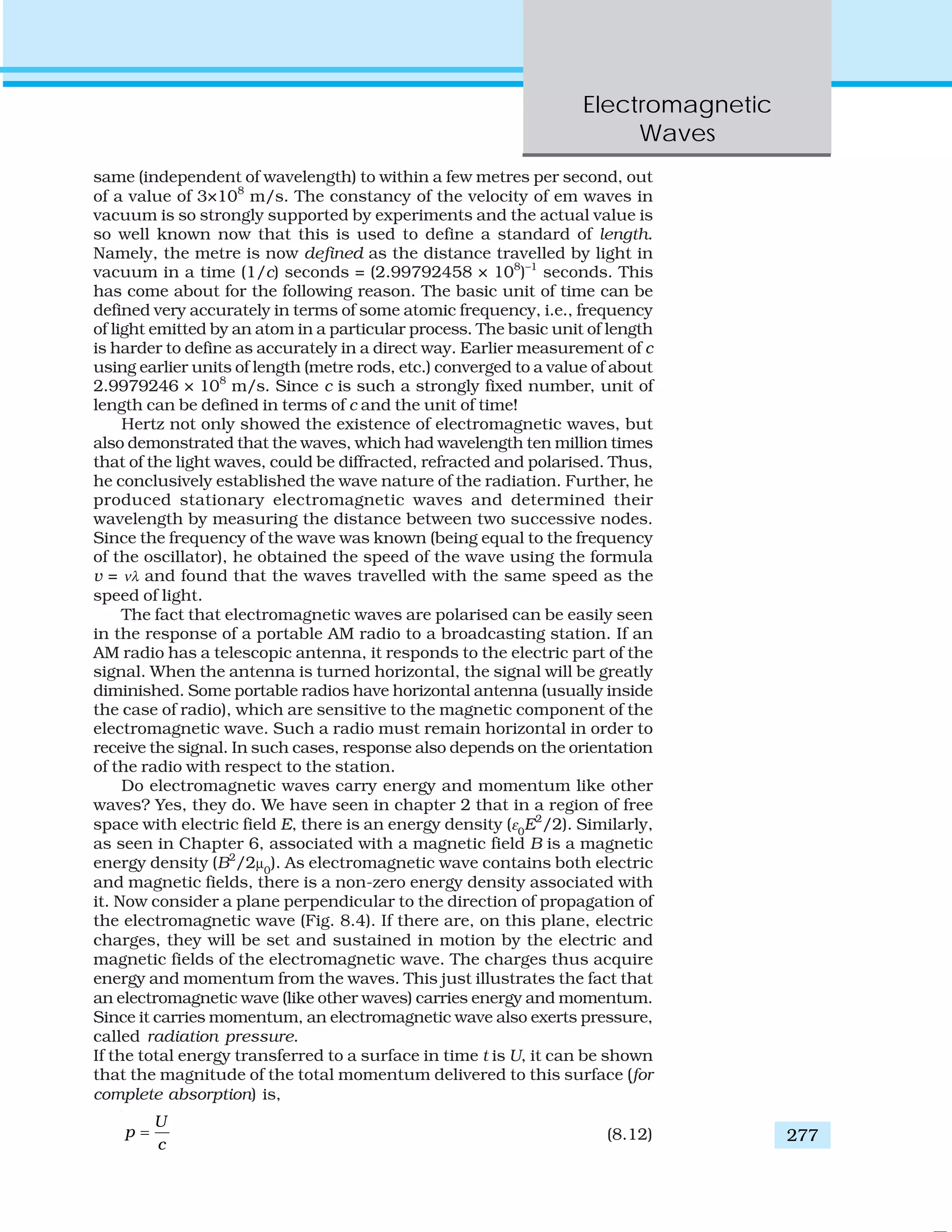
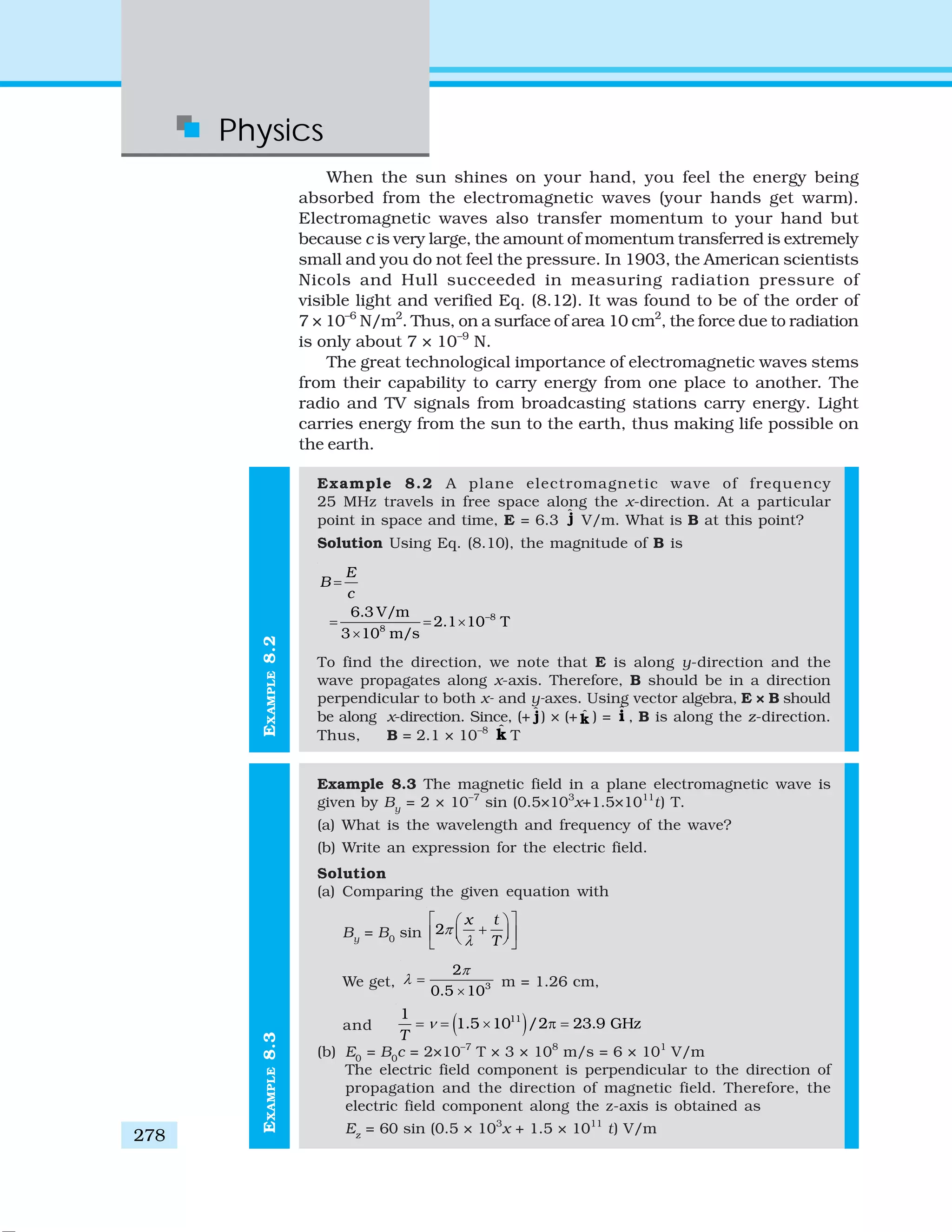
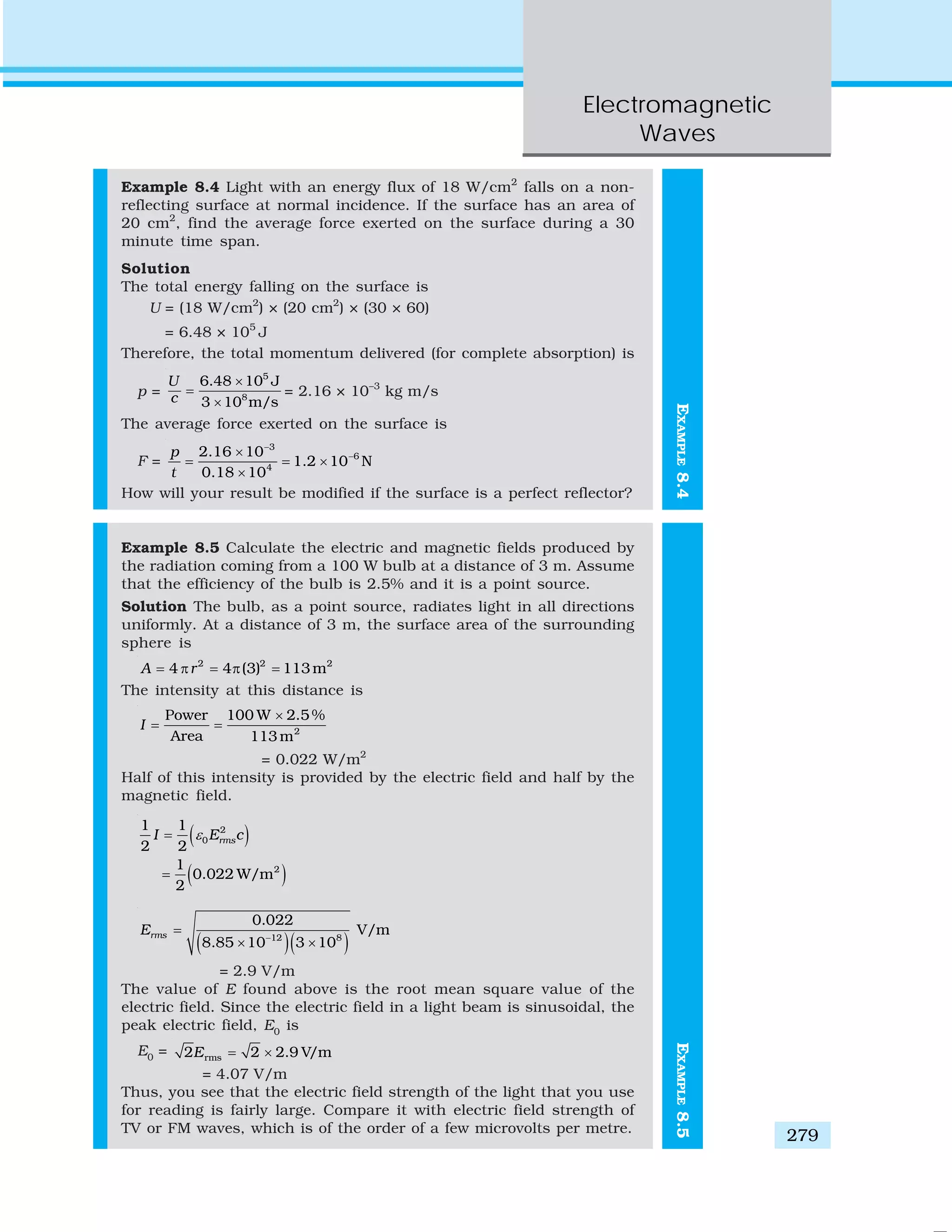

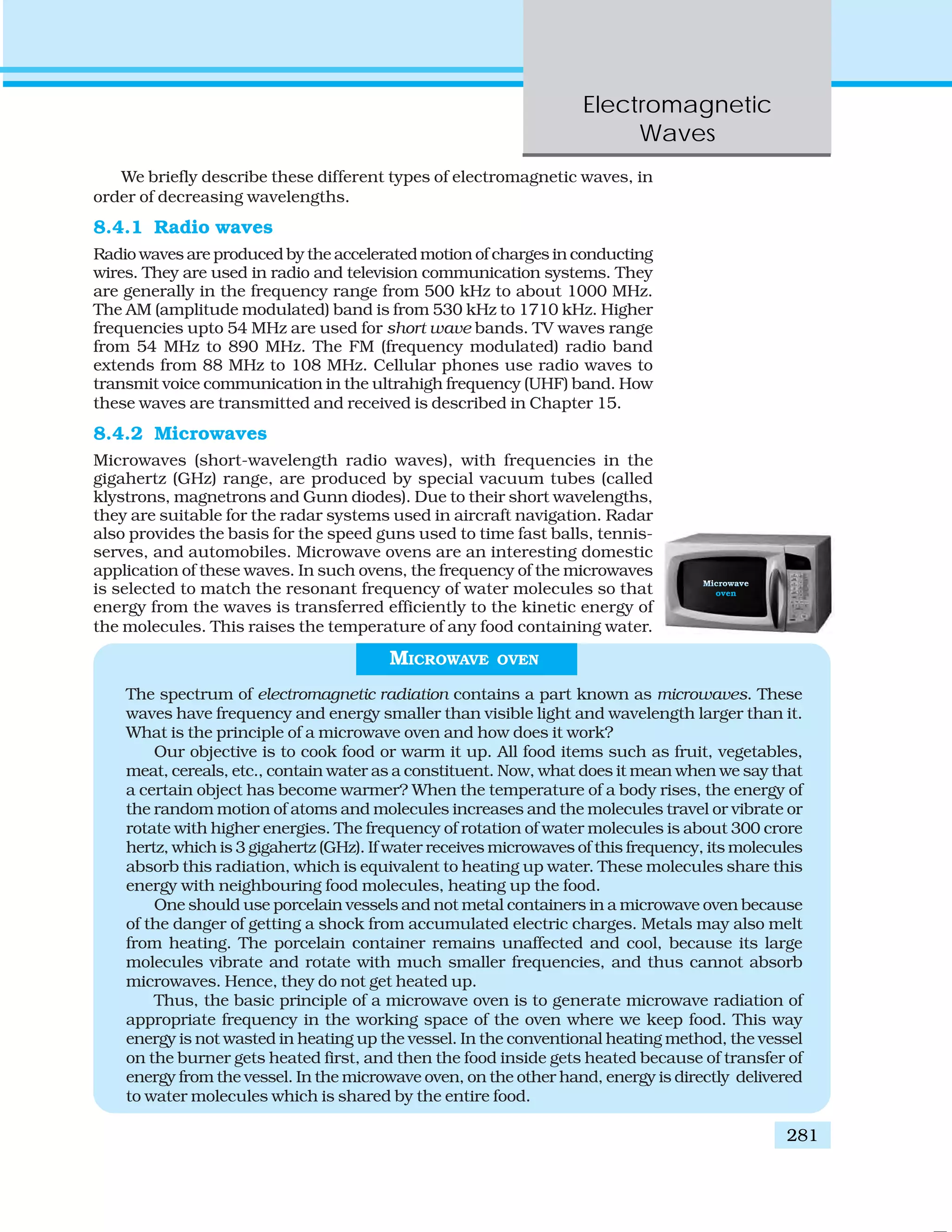
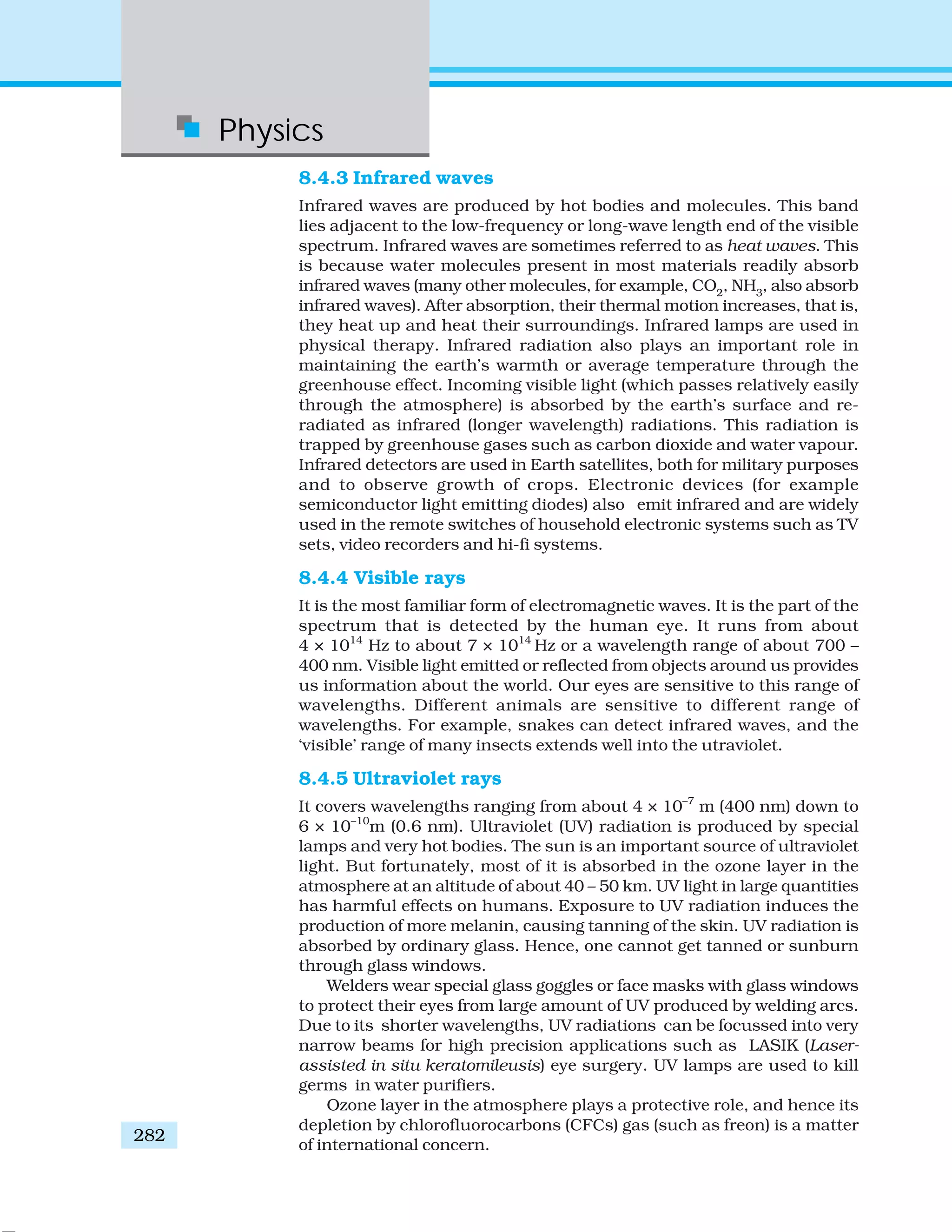
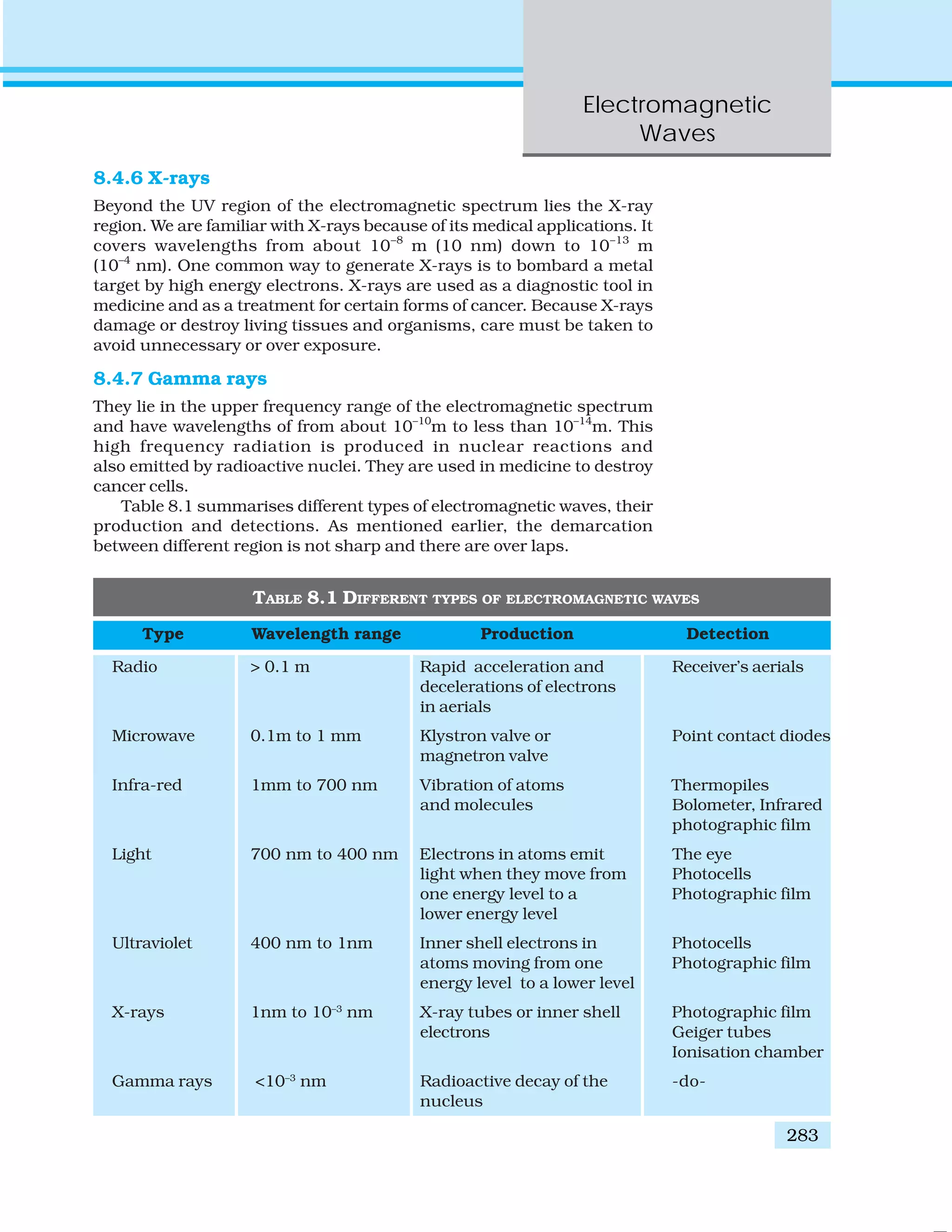
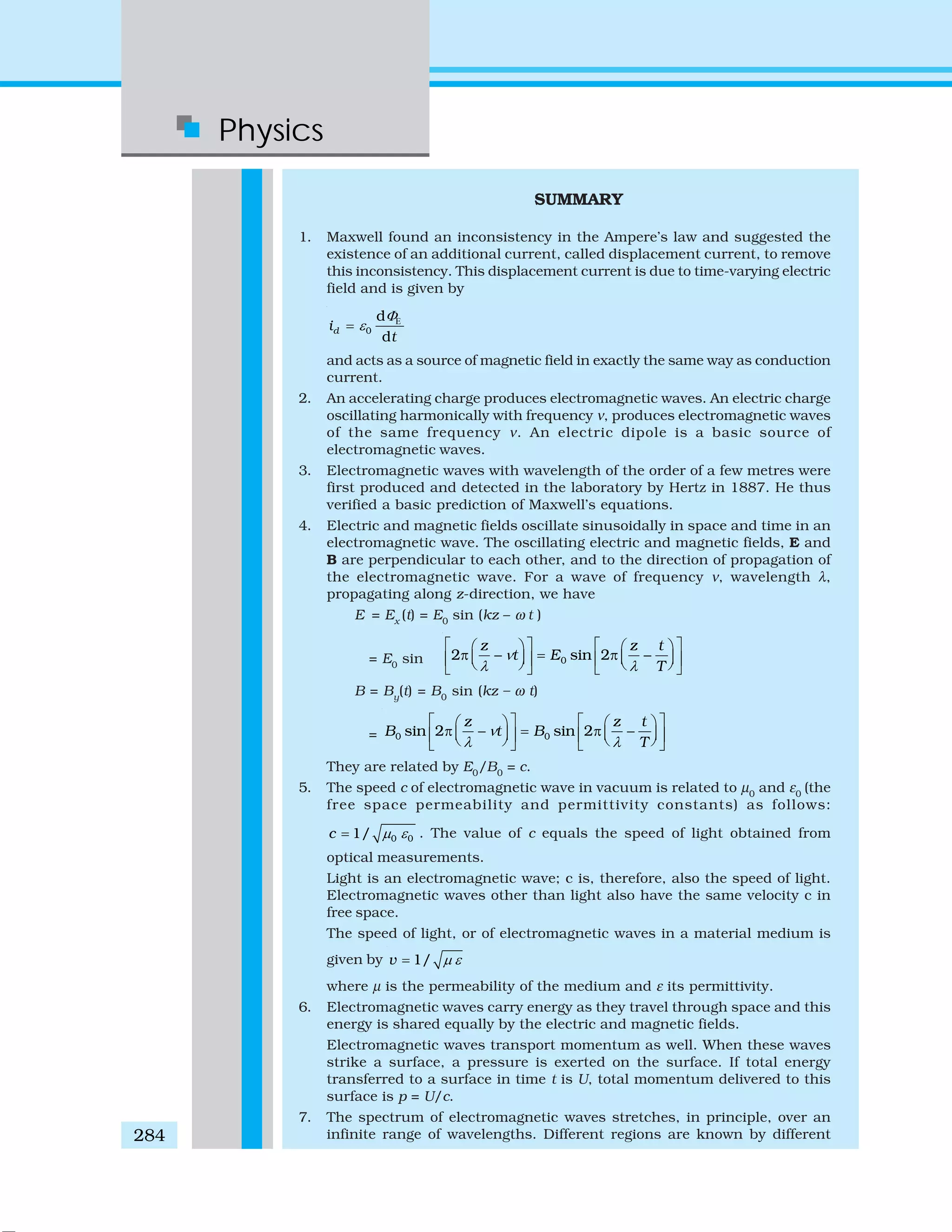
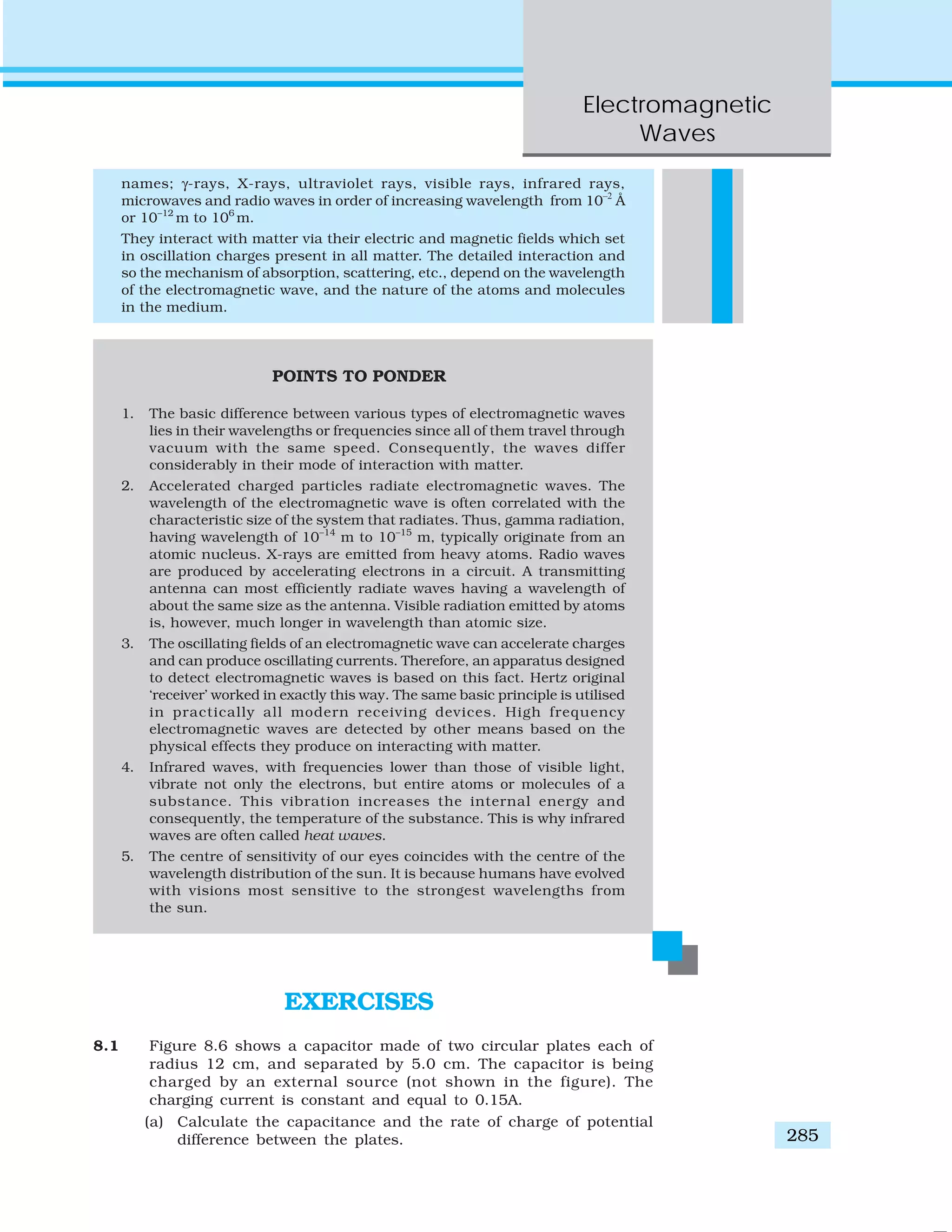
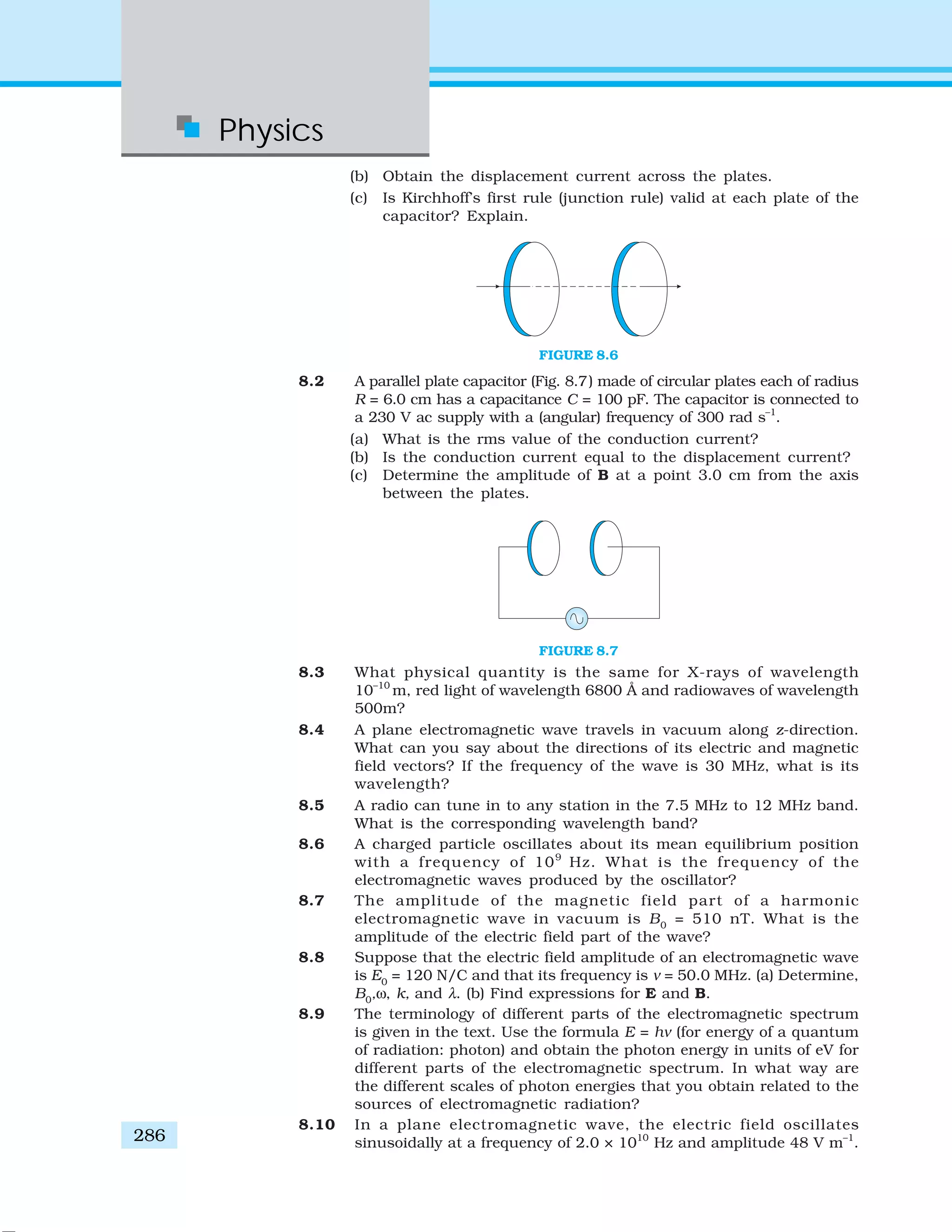
![Electromagnetic
Waves
287
(a) What is the wavelength of the wave?
(b) What is the amplitude of the oscillating magnetic field?
(c) Show that the average energy density of the E field equals the
average energy density of the B field. [c = 3 × 108
m s–1
.]
ADDITIONAL EXERCISES
8.11 Suppose that the electric field part of an electromagnetic wave in
vacuum is E = {(3.1 N/C) cos [(1.8 rad/m) y + (5.4 × 106
rad/s)t]} ˆi .
(a) What is the direction of propagation?
(b) What is the wavelength λ ?
(c) What is the frequency ν ?
(d) What is the amplitude of the magnetic field part of the wave?
(e) Write an expression for the magnetic field part of the wave.
8.12 About 5% of the power of a 100 W light bulb is converted to visible
radiation. What is the average intensity of visible radiation
(a) at a distance of 1m from the bulb?
(b) at a distance of 10 m?
Assume that the radiation is emitted isotropically and neglect
reflection.
8.13 Use the formula λm
T = 0.29 cm K to obtain the characteristic
temperature ranges for different parts of the electromagnetic
spectrum. What do the numbers that you obtain tell you?
8.14 Given below are some famous numbers associated with
electromagnetic radiations in different contexts in physics. State
the part of the electromagnetic spectrum to which each belongs.
(a) 21 cm (wavelength emitted by atomic hydrogen in interstellar
space).
(b) 1057 MHz (frequency of radiation arising from two close energy
levels in hydrogen; known as Lamb shift).
(c) 2.7 K [temperature associated with the isotropic radiation filling
all space-thought to be a relic of the ‘big-bang’ origin of the
universe].
(d) 5890 Å - 5896 Å [double lines of sodium]
(e) 14.4 keV [energy of a particular transition in 57
Fe nucleus
associated with a famous high resolution spectroscopic method
(Mössbauer spectroscopy)].
8.15 Answer the following questions:
(a) Long distance radio broadcasts use short-wave bands. Why?
(b) It is necessary to use satellites for long distance TV transmission.
Why?
(c) Optical and radiotelescopes are built on the ground but X-ray
astronomy is possible only from satellites orbiting the earth.
Why?
(d) The small ozone layer on top of the stratosphere is crucial for
human survival. Why?
(e) If the earth did not have an atmosphere, would its average
surface temperature be higher or lower than what it is now?
(f ) Some scientists have predicted that a global nuclear war on the
earth would be followed by a severe ‘nuclear winter’ with a
devastating effect on life on earth. What might be the basis of
this prediction?](https://image.slidesharecdn.com/ncert-class-12-physics-part-1-161112171109/75/Ncert-class-12-physics-part-1-291-2048.jpg)